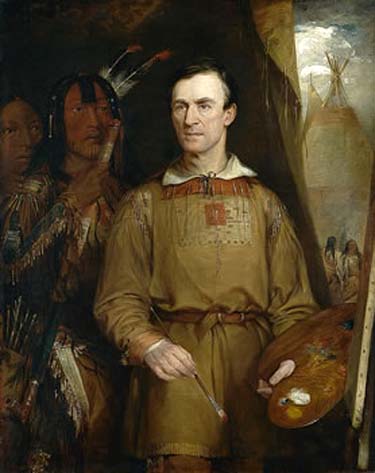
American Painter
1796 - 1872

George Catlin by William Fisk: 1849
William Fisk's portrait conveys Catlin's ideal image of his achievements. Catlin sat for this painting in London when, at the age of fifty-three, he was in the business phase of his career- staging art exhibitions and Indian performances. Nevertheless, Catlin is seen with palette and brush before a canvas- an artist at heart. Suited in buckskin, Catlin had absorbed frontier and Indian culture, even as he tried to capture those Indians fading into background shadows- a device that conveys Catlin's notions of their cultural losses. Most impressive perhaps is Catlin's intense gaze into the distance, revealing his animating vision, conviction, and persistence.
Quoted From: Campfire Stories with George Catlin
George Catlin was an American painter, author and traveler who specialized in portraits of Native Americans in the Old West.
Catlin was born in Wilkes-Barre, Pennsylvania. As a child growing up in Pennsylvania, Catlin spent many hours hunting, fishing, and looking for American Indian artifacts. His fascination with Native Americans was kindled by his mother, who told him stories of the Western Frontier and how she was captured by a tribe when she was a young girl. Years later, a group of Native Americans came through Philadelphia dressed in their colorful costumes and made quite an impression on Catlin. Following a brief career as a lawyer, he produced two major collections of paintings of American Indians and published a series of books chronicling his travels among the native peoples of North, Central and South America. Claiming his interest in America's 'vanishing race' was sparked by a visiting American Indian delegation in Philadelphia, he set out to record the appearance and customs of America's native people.

Saint Louis from the River: 1832
Catlin began his journey in 1830 when he accompanied General William Clark on a diplomatic mission up the Mississippi River into Native American territory. Saint Louis became Catlin's base of operations for five trips he took between 1830 and 1836, eventually visiting fifty tribes. Two years later he ascended the Missouri River to Fort Union, where he spent several weeks among indigenous people still relatively untouched by European civilization. He visited eighteen tribes, including the Pawnee, Omaha, and Ponca in the south and the Mandan, Hidatsa, Cheyenne, Crow, Assiniboine, and Blackfeet to the north. There, at the edge of the frontier, he produced the most vivid and penetrating portraits of his career. Later trips along the Arkansas, Red and Mississippi rivers as well as visits to Florida and the Great Lakes resulted in over 500 paintings and a substantial collection of artifacts.
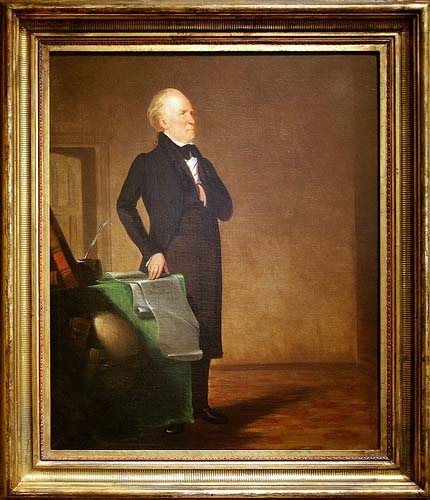
William Clark by George Catlin
When Catlin returned east in 1838, he assembled these paintings and numerous artifacts into his Indian Gallery and began delivering public lectures which drew on his personal recollections of life among the American Indians. Catlin traveled with his Indian Gallery to major cities such as Pittsburgh, Cincinnati, and New York. He hung his paintings 'salon style'-side by side and one above another-to great effect. Visitors identified each painting by the number on the frame as listed in Catlin's catalogue. Soon afterwards he began a lifelong effort to sell his collection to the U.S. government. The touring Indian Gallery did not attract the paying public Catlin needed to stay financially sound, and Congress rejected his initial petition to purchase the works, so in 1839 Catlin took his collection across the Atlantic for a tour of European capitals.
Catlin the showman and entrepreneur initially attracted crowds to his Indian Gallery in London, Brussels, and Paris. The French critic Charles Baudelaire remarked on Catlin's paintings, "M. Catlin has captured the proud, free character and noble expression of these splendid fellows in a masterly way."
Catlin's dream was to sell his Indian Gallery to the U.S. government so that his life's work would be preserved intact. His continued attempts to persuade various officials in Washington, D.C. failed. He was forced to sell the original Indian Gallery, now 607 paintings, due to personal debts in 1852. Industrialist Joseph Harrison took possession of the paintings and artifacts, which he stored in a factory in Philadelphia, as security. Catlin spent the last 20 years of his life trying to re-create his collection. This second collection of paintings is known as the 'Cartoon Collection' since the works are based on the outlines he drew of the works from the 1830's.

Collection of George Catlin paintings. These are from what he called his "Cartoon Collection",
duplicates made of previous paintings that had been sold to pay debts.
In 1841 Catlin published Manners, Customs, and Condition of the North American Indians, in two volumes, with about 300 engravings. Three years later he published 25 plates, entitled Catlin's North American Indian Portfolio, and, in 1848, Eight Years' Travels and Residence in Europe. From 1852 to 1857 he traveled through South and Central America and later returned for further exploration in the Far West. The record of these later years is contained in Last Rambles among the Indians of the Rocky Mountains and the Andes (1868) and My Life among the Indians (ed. by N. G. Humphreys, 1909). In 1872, Catlin traveled to Washington, D.C. at the invitation of Joseph Henry, the first secretary of the Smithsonian. Until his death later that year in Jersey City, New Jersey, Catlin worked in a studio in the Smithsonian 'Castle'. Harrison's widow donated the original Indian Gallery-more than 500 works-to the Smithsonian in 1879.

Smithsonian Castle
The nearly complete surviving set of Catlin's first Indian Gallery painted in the 1830's is now part of the Smithsonian American Art Museum's collection. Some 700 sketches are in the American Museum of Natural History, New York City.
The accuracy of some of Catlin's observations has been questioned. He claimed to be the first white man to see the Minnesota pipestone quarries, and pipestone was named catlinite. Catlin exaggerated various features of the site, and his boastful account of his visit aroused his critics, who disputed his claim of being the first white man to investigate the quarry. Previous recorded white visitors include the Groselliers and Radisson, Father Louis Hennepin, Baron LaHonton and others. Lewis and Clark noted the pipestone quarry in their journals in 1805. Fur trader Philander Prescott had written another account of the area in 1831.
Many historians and descendants believe George Catlin had two families; his acknowledged family on the east coast of the United States, but also a family farther west, started with a Native American woman.
Two other artists of the Old West related to George Catlin by family bloodlines are Frederic Remington and Earl W. Bascom.
Quoted From: George Catlin - Wikipedia
Additional Sources:
Art Renewal Center: Museum Artist Information for George Catlin
Museum Syndicate: Art by George Catlin
Selected Works by George Catlin
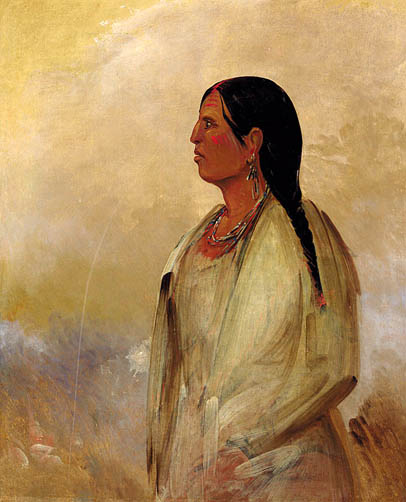
A Choctaw Woman: 1834
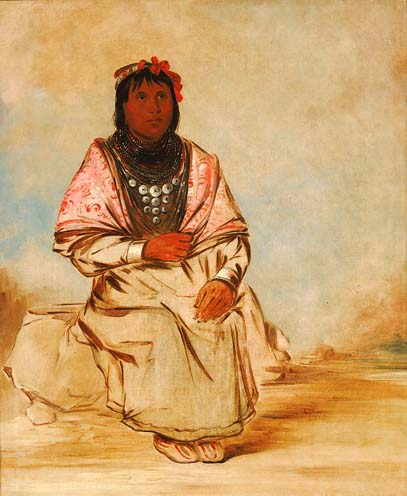
A Seminole Woman: 1838
George Catlin arrived at Fort Moultrie, in Charleston, South Carolina, on January 17, 1838. He painted more than ten portraits of Seminole and Yuchi Indians, including this Seminole woman, in the short time he spent at the fort. (Truettner, The Natural Man Observed, 1979)
Quoted From: Luce Foundation Center for American Art
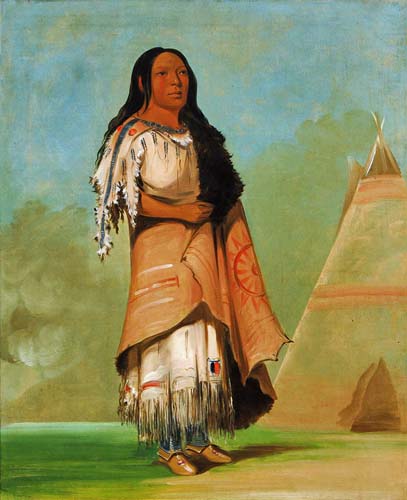
Ah'-kay-ee-pix-en
Woman Who Strikes Many: 1832
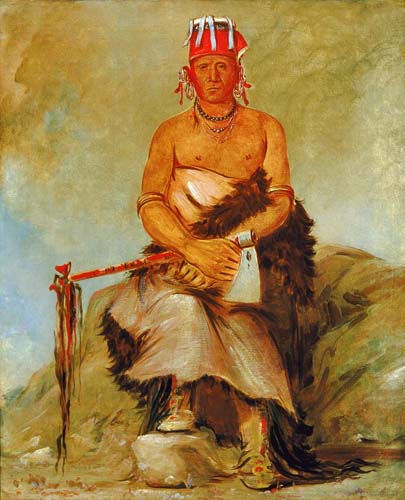
A-h'sha-la-coots-ah
Chief of the Republican Pawnee: 1832
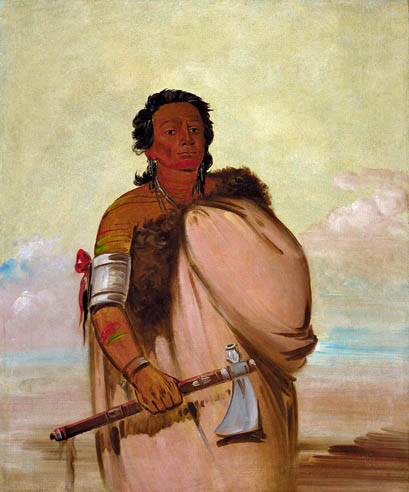
Ah'-sho-cole,
Rotten Foot, a Noted Warrior: 1834
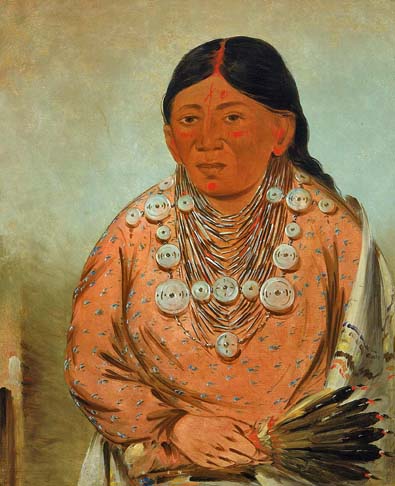
A-h'tee-wat-o-mee-a Woman: 1830
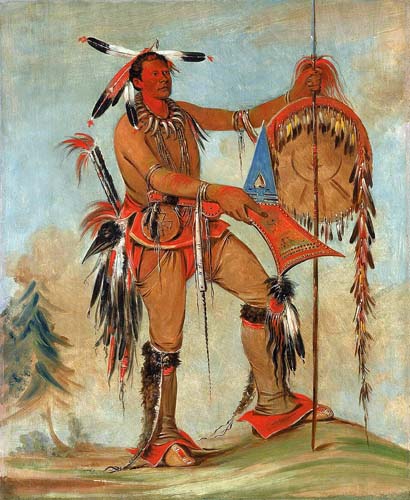
Ah-móu-a, The Whale,
One of Kee-o-kuk's Principal Braves: 1845
Catlin describes the subject as "holding a handsome war-club in his hand" (1848 catalogue, p. 9).
Painted at the Sauk and Fox village in 1835. The Whale's display of costume accessories and weapons rivals that of Keokuk. The subject, holding the same war club, appears again in cartoon 13, with his wife.
Quoted From: The Catlin Collection
Another Biography of George Catlin from About.com
George Catlin Painted American Indians in the Early 1800's
Artist and Writer Documented Indian Life Across North America
By Robert McNamara

Niagara Falls: 1827
The American artist George Catlin became fascinated with Indians in the early 1800's and traveled extensively throughout North America so he could document them on canvas. In his paintings and writings Catlin portrayed Indian life in great detail.
"Catlin's Indian Gallery," an exhibit which opened in New York City in 1837, was an early opportunity for people living in an eastern city to appreciate the lives of the Indians still living on the western frontier. It was, in a sense, the first "western."
Catlin is also credited with first proposing the idea of National Parks. Catlin's proposal came decades before the US government would create the first National Park.
Early Life of George Catlin
George Catlin was born in Wilkes-Barre, Pennsylvania on July 26, 1796. His mother and grandmother had been held hostage during an Indian uprising in Pennsylvania known as the Wyoming Valley Massacre some 20 years earlier, and Catlin would have heard many stories about Indians as a child. He spent much of his childhood wandering in the woods and searching for Indian artifacts.
As a young man Catlin trained to be a lawyer, and he briefly practiced law in Wilkes-Barre. But he developed a passion for painting. By 1821, at the age of 25, Catlin was living in Philadelphia and trying to pursue a career as a portrait painter.
While in Philadelphia Catlin enjoyed visiting the museum administered by Charles Willson Peale, which contained numerous items related to Indians and also to the expedition of Lewis and Clark. When a delegation of western Indians visited Philadelphia, Catlin painted them and decided to learn all he could of their history.
In the late 1820's Catlin painted portraits, including one of New York Governor DeWitt Clinton. At one point Clinton gave him a commission to create lithographs of scenes from the newly opened Erie Canal, for a commemorative booklet.
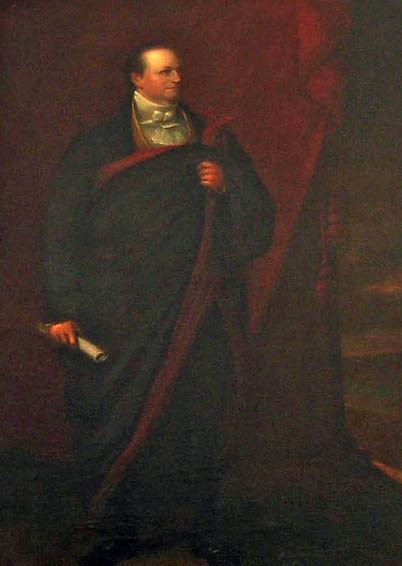
Dewitt Clinton
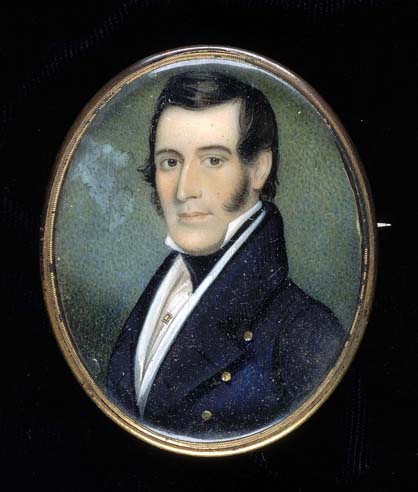
Captain Henry P. Fleischman: 1825
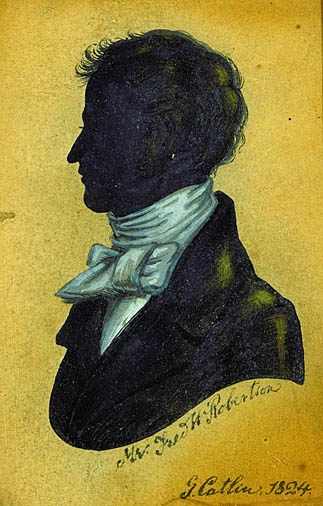
Mr. Fred H. Robertson: 1824
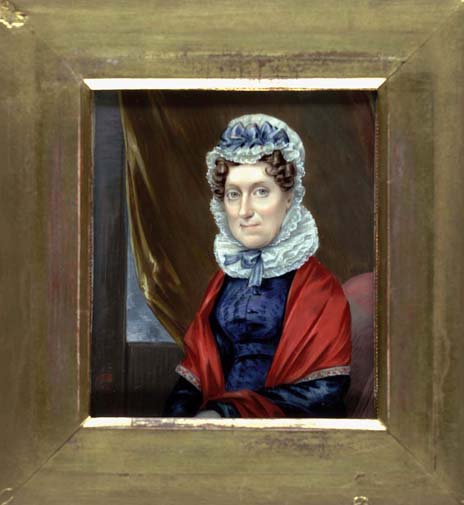
Mrs. Putnam Catlin: 1825
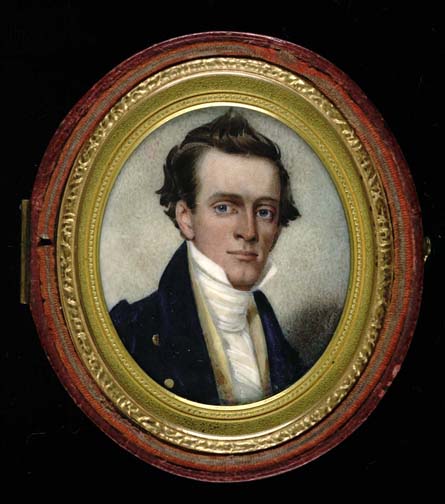
Portrait of a Gentleman: 1830
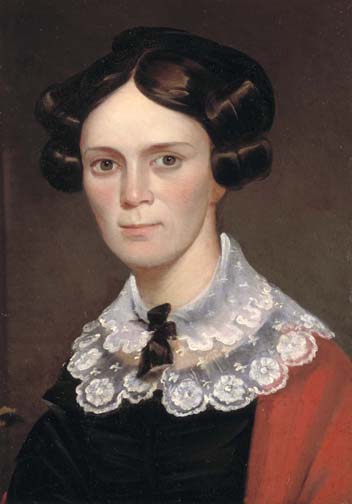
Portrait of a Woman: 1825
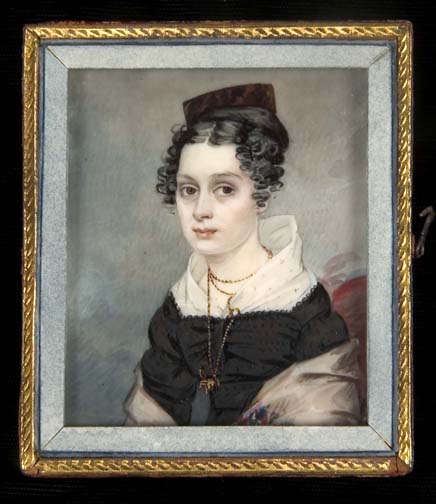
Portrait of Mary Catlin: 1827
In 1828 Catlin married Clara Gregory, who was from a prosperous family of merchants in Albany, New York. Despite his happy marriage, Catlin desired to venture off and see the west.
_1828.jpg)
Mrs George Catlin
(Clara Bartlett Gregory): 1828
In the first of many daring decisions, George Catlin left a law career and moved to Philadelphia in 1821 to earn his living as an artist. There he became an accomplished miniature painter. He moved again in 1827 to New York City, where he began painting portraits and met the woman who would become his wife. This depiction of Clara Gregory Catlin was executed the same year they were married, 1828.
Quoted From: Campfire Stories with George Catlin
George Catlin Travels In the Western United States
In 1830, Catlin realized his ambition to visit the west, and arrived in Saint Louis, which was then the edge of the American frontier. He met William Clark, who, a quarter-century earlier, had led the famed Lewis and Clark Expedition to the Pacific Ocean and back.
Clark held an official position as the superintendent of Indian affairs. He was impressed by Catlin's desire to document Indian life, and provided him with passes so he could visit Indian reservations.
The aging explorer shared with Catlin an extremely valuable piece of knowledge, Clark's map of the west. It was, at the time, the most detailed map of North America west of the Mississippi.
Throughout the 1830's Catlin traveled extensively, often living among the Indians. In 1832 he began to paint the Sioux, who were at first highly suspicious of his ability to record detailed images on paper. However, one of the chiefs declared that Catlin's 'medicine' was good, and he was allowed to paint the tribe extensively.
Catlin often painted portraits of individual Indians, but he also depicted daily life, recording scenes of rituals and even sports. In one painting Catlin depicts himself and an Indian guide wearing the pelts of wolves while crawling in the prairie grass to closely observe a herd of buffalo.
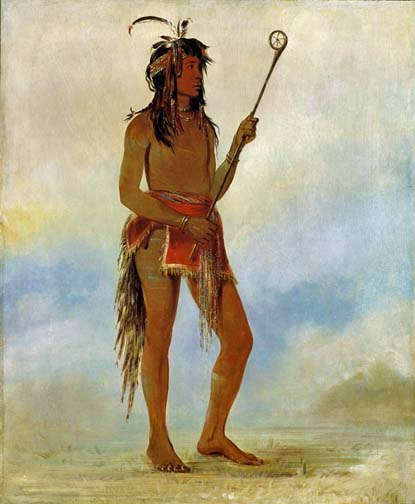
An-nó-je-nahge,
He Who Stands on Both Sides, a Distinguished Ball Player: 1835
"The two most distinguished ballplayers in the Sioux tribe. (acc. nos. 1985.66.74 and 1985.66.75) … Both of these young men stood to me for their portraits, in the dresses precisely in which they are painted; with their ball-sticks in their hands, and in the attitudes of the play. We have had several very spirited plays here within the past few days; and each of these young men came from the ball-play ground to my painting-room, in the dress in which they had just struggled in the play" (Letters and Notes, vol. 2, p. 134, pls. 235, 236).
Painted at Fort Snelling in 1835. The structure and movement of the two figures represent some improvement over the Osage series (see White Hair, the Younger, a Band Chief, Handsome Bird, and Little Chief.
Both subjects appear again in plate 21 of Catlin's North American Indian Portfolio, first published in 1844, and in carton 82 (National Gallery of Art, 2085). The cartoon is based on a watercolor (pl. 50) in the Gilcrease Souvenir album.
Quoted From: The Catlin Collection
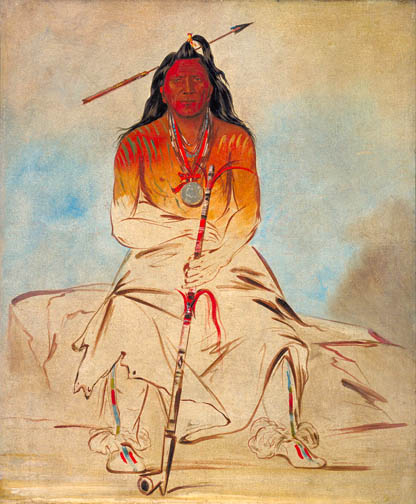
Ah-shaw-wah-rooks-te,
Medicine Horse, a Grand Pawnee Brave: 1832
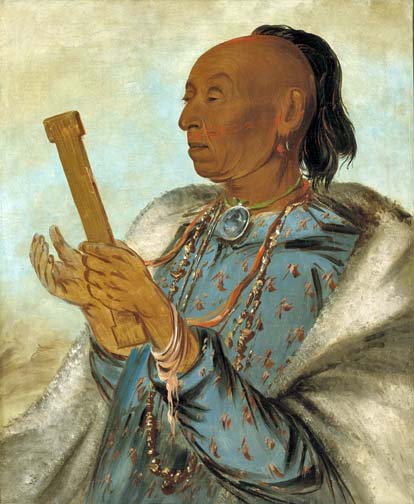
Ah-tón-we-tuck,
Cock Turkey-Repeating His Prayer: 1830
Described by Catlin as "another Kickapoo of some distinction, and a disciple of the Prophet; in the attitude of prayer also, which he is reading off from characters cut upon a stick that he holds in his hands" (Letters and Notes, vol. 2).
Probably painted at Fort Leavenworth in 1830. The portrait of Cock Turkey is either one of Catlin's best efforts at the fort that year, or it was mostly finished at a later date. The motif of the prayer stick, repeated in other Potawatomi and Kickapoo portraits, would probably indicate a date of 1830, but the hands are so skillfully articulated that one wonders why those of the Prophet came off so badly. The head is modeled with broad, flowing strokes that gracefully define the skull structure and facial features, a technique not often used by the artist before 1832, and the decorative tufts on the dress of the subject have been painted with astonishing speed and facility.
Cock Turkey's costume in the Gilcrease watercolor lacks many of the details that enliven the Smithsonian portrait. He appears again, full length, in cartoon 72.
Quoted From: The Catlin Collection
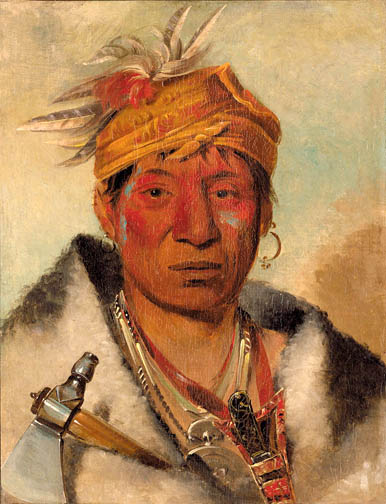
Ah-yaw-ne-tak-oar-ron,
a Warrior: 1831
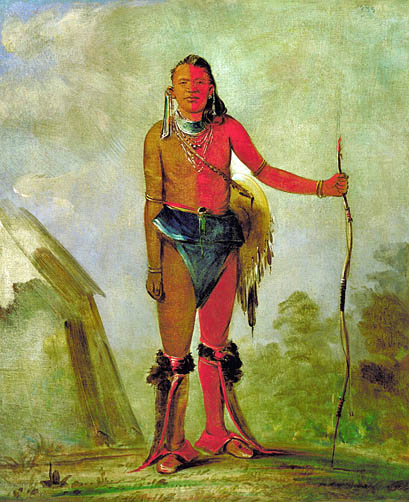
Aih-no-wa,
The Fire, a Fox Medicine Man: 1835
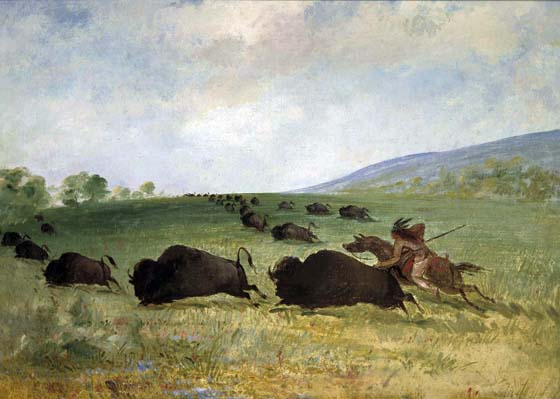
An Osage Indian Lancing a Buffalo: 1847
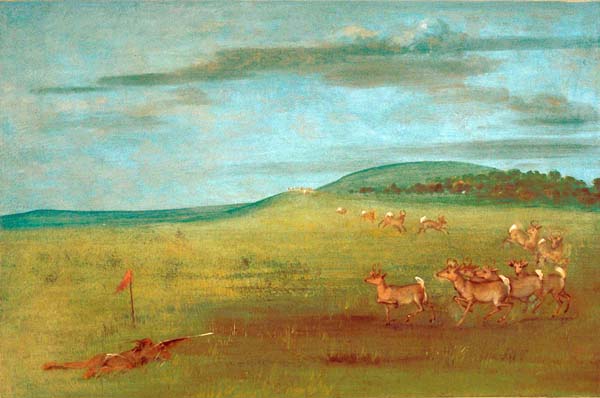
Antelope Shooting,
Decoyed Up: 1832
Catlin described antelope as another variety of game already wary of a possible hunter. "The antelope of this country, I believe to be different from all other known varieties, and forms one of the most pleasing, living ornaments to this western world. They are seen in some places in great numbers sporting and playing about the hills and dales; and often, in flocks of fifty or a hundred, will follow the boat of the descending voyageur, or the travelling caravan, for hours together; keeping off at a safe distance, on the right or left, galloping up and down the hills, snuffing their noses and stamping their feet; as if they were endeavoring to remind the traveler of the wicked trespass he was making on their own hallowed ground" (Letters and Notes, Letter No. 10).
Quoted From: Campfire Stories with George Catlin
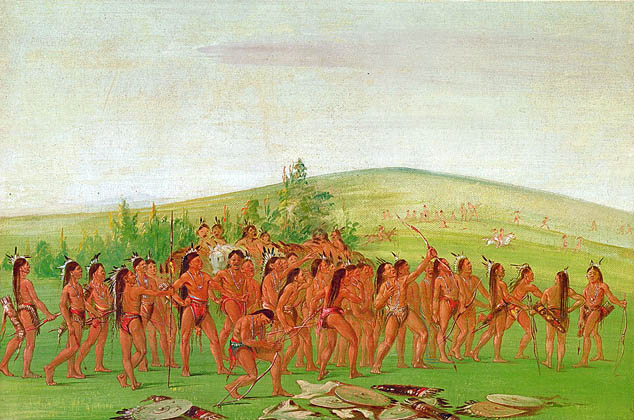
Archery of the Mandan: 1836
"I have seen a fair exhibition of their archery this day, in a favorite amusement which they call the 'game of the arrow,' where the young men who are the most distinguished in this exercise, assemble on the prairie at a little distance from the village, and having paid, each one, his 'entrance-fee,' such as a shield, a robe, a pipe, or other article, step forward in turn, shooting their arrows into the air, endeavoring to see who can get the greatest number flying in the air at one time, thrown from the same bow" (Letters and Notes, vol. 1).
Probably sketched in 1832 at the Mandan village, but the style of the painting is closer to the dance scenes. Catlin has turned the game into a major anatomy demonstration. The frieze of contestants, all looking like young Apollos, is the most carefully arranged and balanced group to be found in any of the artist's paintings.
The scene is repeated in plate 24 of Catlin's North American Indian Portfolio, first published in 1844, and in cartoon 174, with a less formal arrangement of figures.
Quoted From: The Catlin Collection

Arikara Village of Earth, Covered Lodges,
1600 Miles above Saint Louis: 1832
"Plate 80 gives a view of the Ricaree village, which is beautifully situated on the west bank of the river, 200 miles below the Mandans; and built very much in the same manner; being constituted of 150 earth-covered lodges, which are in part surrounded by an imperfect and open barrier of pickets set firmly in the ground, and ten or twelve feet in height.
"This village is built upon an open prairie, and the gracefully undulating hills that rise in the distance behind it are everywhere covered with a verdant green turf, without a tree or a bush anywhere to be seen. This view was taken from the deck of the steamer when I was on my way up the river" (Letters and Notes, vol. 1, p. 204, pl. 80).
Painted in 1832 on Catlin's Missouri River voyage.
Quoted From: The Catlin Collection
George Catlin Exhibits "Catlin's Indian Gallery"
In 1837 Catlin opened a gallery of his paintings in New York City, billing it as "Catlin's Indian Gallery." It could be considered the first "Wild West" show, as it revealed the exotic life of the Indians of the west to city dwellers.
Catlin wanted his exhibit to be taken seriously as historic documentation of Indian life, and he endeavored to sell his collected paintings to the US Congress. One of his great hopes was that his paintings would be the centerpiece of a national museum devoted to Indian life.
The Congress was not interested in purchasing Catlin's paintings, and when he exhibited them in other eastern cities they were not as popular as they had been in New York. Frustrated, Catlin left for England, where he found success showing his paintings in London.
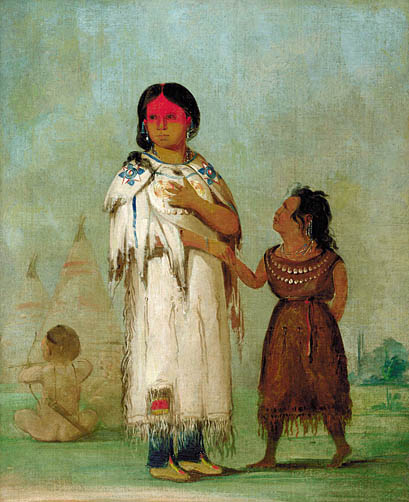
Assiniboin Woman and Child: 1832
"The women of this tribe are often comely, and sometimes pretty; in plate 34, will be seen a fair illustration of the dresses of the women and children, which are usually made of the skins of the mountain-goat, and ornamented with porcupine's quills and rows of elk's teeth" (Letters and Notes, vol. 1, p. 57, pl. 34).
Painted at Fort Union in 1832. Although number 159 is a notable exception, Catlin's small children often look like shrunken adults. The Field Museum and Smithsonian portraits are alike, except for the seated child and skin lodges in the background of the latter. That same background is repeated in plate 34 of Letters and Notes.
Quoted From: The Catlin Collection
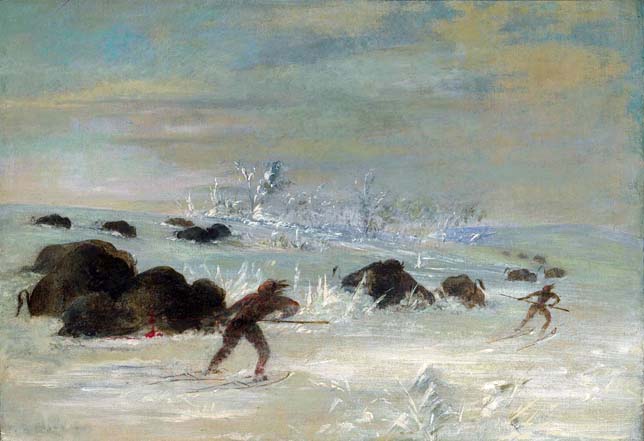
Assiniboine Indians Pursuing Buffalo on Snowshoes: 1847
Painted in Paris 1846-1848. Catlin must have produced over 100 pictures between 1846 and early 1848. Those intended for Louis Philippe were finished with great care (see no. 449), but others are little more than hasty sketches he painted to round out his collection for European audiences. Even at high speed, however, Catlin had a surprisingly delicate and sure touch, giving to his figures the animated presence of actors on a miniature stage. The setting is not the Great Plains or the Upper Missouri, but a land of fantastic foliage and bright pastel tones shaped by the artist's beguiling and fanciful memory.
Quoted From: The Catlin Collection
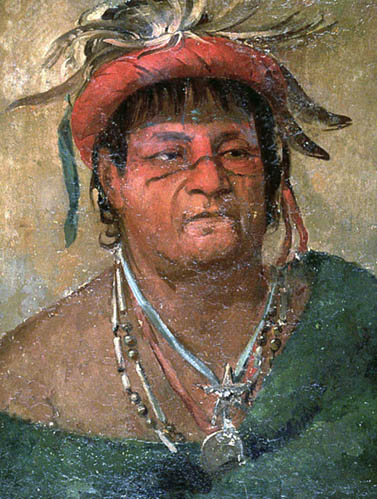
Auh-ka-nah-paw-wah,
Earth Standing, an Old and Valiant Warrior: 1831
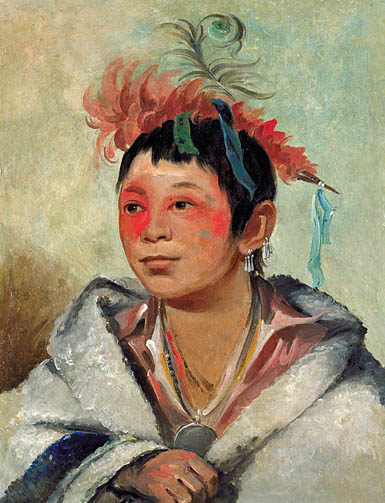
Au-nah-kwet-to-hau-pay-o,
One Sitting in the Clouds, a Boy: 1831

Au-nim-muck-kwa-um,
Tempest Bird: 1845
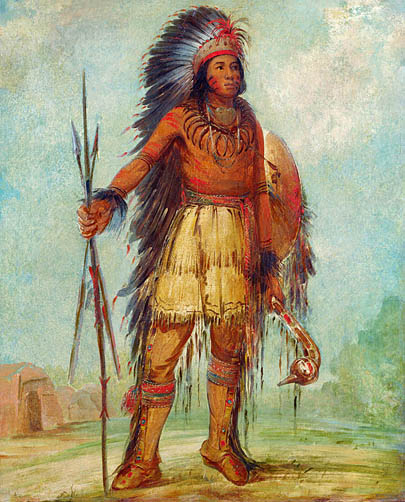
A-wun-ne-wa-be,
Bird of Thunder: 1845
Painted in Paris in 1845. Catlin lists another portrait of Bird of Thunder among those commissioned by Louis Philippe in 1845 and the subject appears again in cartoon 61 (National Gallery of Art).
Quoted From: The Catlin Collection
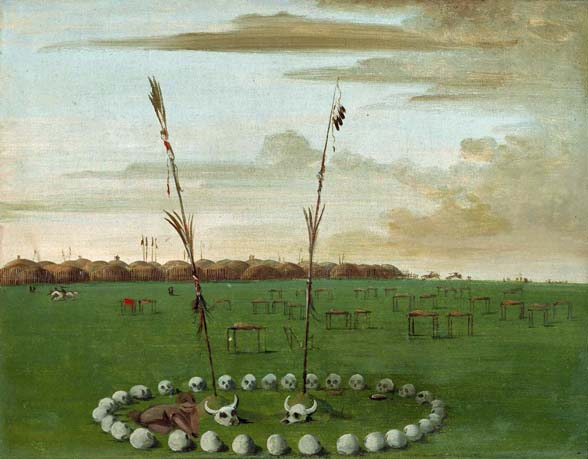
Back View of Mandan Village,
Showing the Cemetery: 1832
"These people never bury the dead, but place the bodies on slight scaffolds just above the reach of human hands, and out of the way of wolves and dogs; and they are there left to mould and decay. This cemetery, or place of deposit for the dead, is just back of the village, on a level prairie; and with all its appearances, history, forms, ceremonies, is one of the strangest and most interesting objects to be described in the vicinity of this peculiar race.…"
"When the scaffolds on which the bodies rest, decay and fall to the ground, the nearest relations having buried the rest of the bones, take the skulls, which are perfectly bleached and purified, and place them in circles of an hundred or more on the prairie-placed at equal distances apart (some eight or nine inches from each other), with the faces all looking to the center; where they are religiously protected and preserved in their precise positions from year to year.…"
"There are several of these 'Golgothas' or circles of twenty or thirty feet in diameter, and in the centre of each ring or circle is a little mound of three feet high, on which uniformly rest two buffalo skulls (a male and female); and in the centre of the little mound is erected a 'medicine pole,' about twenty feet high, supporting many curious articles of mystery and superstition, which they suppose have the power of guarding and protecting this sacred arrangement" (Letters and Notes, vol. 1).
Sketched and perhaps painted at the Mandan village in 1832. A drawing of several scaffolds and a circle of skulls appears in the SI sketchbook. Catlin's description of the cemetery represents a curious blend of anthropological and romantic interests.
Quoted From: The Catlin Collection

Ball Players: Date Unknown
Catlin's Classic Book on Indian Life
In 1841 Catlin published, in London, a book titled Letters and Notes on the Manners, Customs, and Conditions of the North American Indians. The book, more than 800 pages in two volumes, contained a vast wealth of material gathered during Catlin's travels among the Indians. The book went through a number of editions.
At one point in the book Catlin detailed how the enormous herds of buffalo on the western plains were being destroyed because robes made of their fur had become so popular in eastern cities.
Perceptively noting what today we would recognize as an ecological disaster, Catlin made a startling proposal. He suggested that the government should set aside enormous tracts of western lands to preserve them in their natural state.
George Catlin can thus be credited with first suggesting the creation of National Parks.
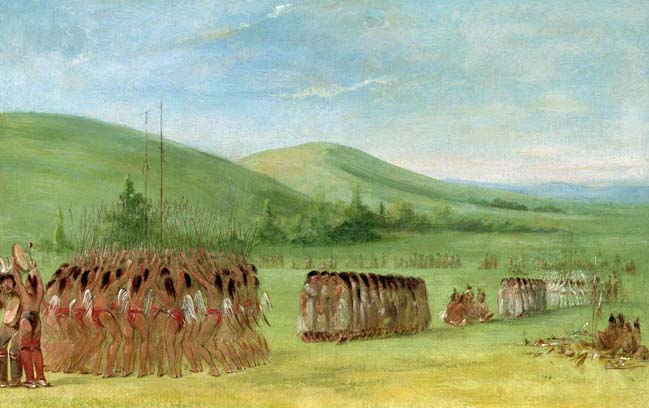
Ball-play Dance, Choctaw: 1834
"The ground having been all prepared and preliminaries of the game all settled, and the betting all made, and the goods all 'staked' night came on … a procession of lighted flambeaux was seen coming from each encampment, to the ground where the players assembled around their respective byes; and at the beat of the drums and chants of the women, each party of players commenced the 'ball-play dance.' Each party danced for a quarter of an hour around their respective byes, in their ball-play dress; rattling their ball-sticks together in the most violent manner, and all singing as loud as they could raise their voices; while the women of each party, who had their goods at stake, formed into two rows on the line between the two parties of players, and danced also, in an uniform step, and all their voices joined in chants to the Great Spirit; in which they were soliciting his favor in deciding the game to their advantage; and also encouraging the players to exert every power they possessed, in the struggle that was to ensue. In the mean time, four old medicine-men, who were to have the starting of the ball, and who were to be judges of the play, were seated at the point where the ball was to be started; and busily smoking to the Great Spirit for their success in judging rightly, and impartially, between the parties in so important an affair" (Letters and Notes, vol. 2, p. 125, pl. 224).
Sketched near Fort Gibson in 1834. Catlin produced a lively rhythm in the ball-play scenes by repeating the pose of figures engaged in a similar action.
The subject is repeated in plate 22 of Catlin's North American Indian Portfolio, first published in 1844, and in cartoon 175. The Schweitzer copy lacks Catlin's animated touch.
Quoted From: The Catlin Collection
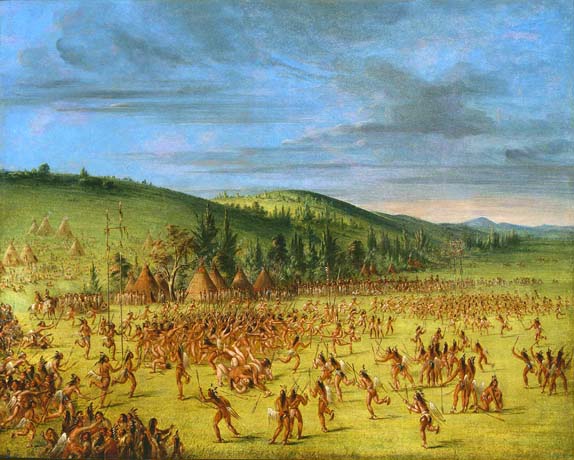
Ball-play of the Choctaw,
Ball Up: 1848
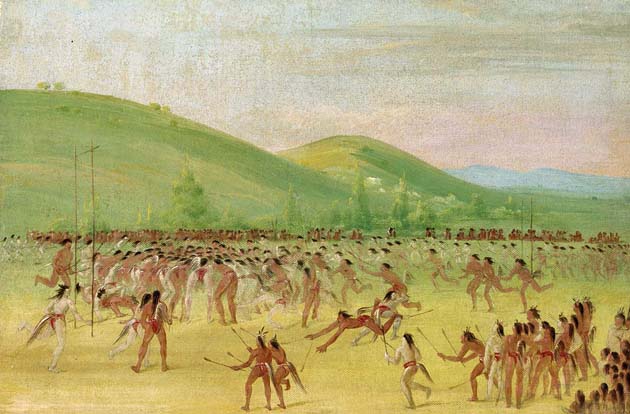
Ball-play of the Choctaw,
Ball Down: 1834
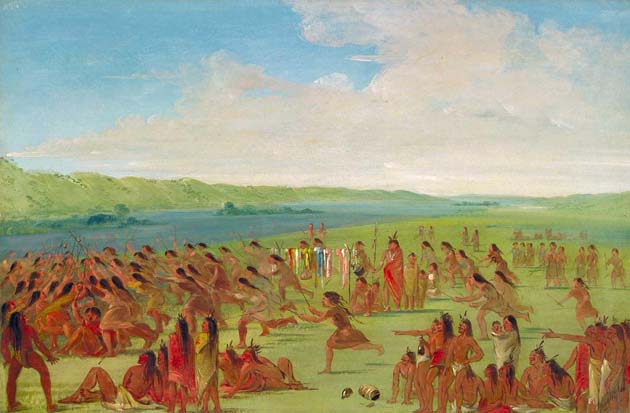
Ball-play of the Women,
Prairie du Chien: 1835
"In the ball-play of the women, they have two balls attached to the ends of a string, about a foot and half long; and each woman has a short stick in each hand, on which she catches the string with the two balls, and throws them, endeavoring to force them over the goal of her own party. The men are more than half drunk, when they feel liberal enough to indulge the women in such an amusement; and take infinite pleasure in rolling about on the ground and laughing to excess, while the women are tumbling about in all attitudes, and scuffling for the ball" (Letters and Notes, vol. 2, p. 146, pl. 252).
Sketched at Prairie du Chien in 1835. The subject is repeated in cartoon 177.
Seth Eastman recorded a similar scene while stationed at Fort Snelling.
Quoted From: The Catlin Collection
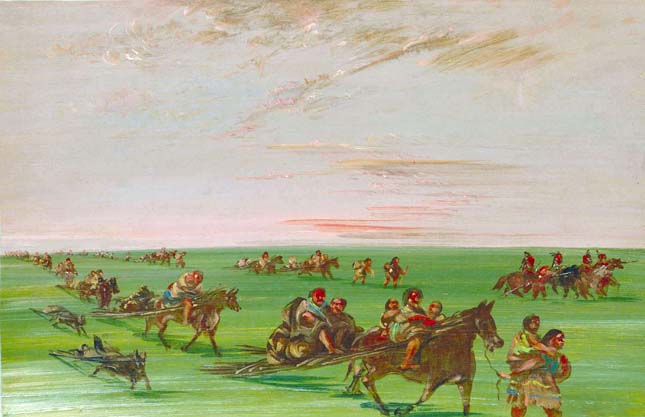
Band of Sioux Moving Camp: 1838
"For this strange cavalcade, preparation is made in the following manner: the poles of a lodge are divided into two bunches, and the little ends of each bunch fastened upon the shoulder or withers of a horse, leaving the butt ends to drag behind on the ground on either side. Just behind the horse, a brace or pole is tied across, which keeps the poles in their respective places; and then upon that and the poles behind the horse, is placed the lodge or tent, which is rolled up, and also numerous other articles of household and domestic furniture, and on the top of all, two, three, and even (sometimes) four our women and children! Each one of these horses has a conductress, who sometimes walks before and leads it, with a tremendous pack upon her own back; and at others she sits astride of its back, with a child, perhaps, at her breast, and another astride of the horse's back behind her, clinging to her waist with one arm, while it affectionately embraces a sneaking dog-pup in the other."
"In this way five or six hundred wigwams, with all their furniture, may be seen drawn out for miles, creeping over the grass-covered plains of this country; and three times that number of men, on good horses, strolling along in front or on the flank and every cur who is large enough, and not too cunning to be enslaved, is encumbered with a car or sled on which he patiently drags his load (Letters and Notes, vol. I).
Drawings of a horse and dog dragging poles supporting baggage are in the SI sketchbook (1832), but the painting is not included in the 1837 catalogue. The cursory technique is similar to other examples from the late 1830's.
Quoted From: The Catlin Collection
George Catlin's Later Life
Catlin returned to the United States, and again tried to get the Congress to buy his paintings. He was unsuccessful. He was swindled in some land investments and was in financial distress. He decided to return to Europe.
In Paris, Catlin managed to settle his debts by selling the bulk of his collection of paintings to an American businessman, who stored them in a locomotive factory in Philadelphia. Catlin's wife died in Paris, and Catlin himself moved on to Brussels, where he would live until returning to America in 1870.
Catlin died in Jersey City, New Jersey in late 1872. His obituary in the New York Times lauded him for his work documenting Indian life, and criticized the Congress for not buying his collection of paintings.
The collection of Catlin paintings stored in the factory in Philadelphia was eventually acquired by the Smithsonian Institution, where it resides today. Other Catlin works are in museums around the United States and Europe.
George Catlin's Indian Gallery/American Art
Remaining Selected Works of George Catlin's Collection
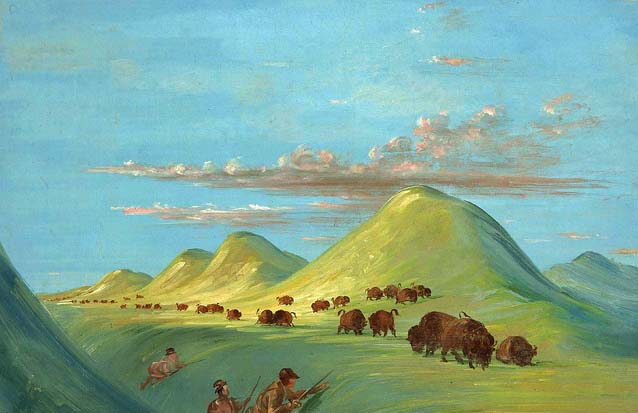
Batiste, Bogard, and I
Approaching Buffalo on the Missouri: 1838
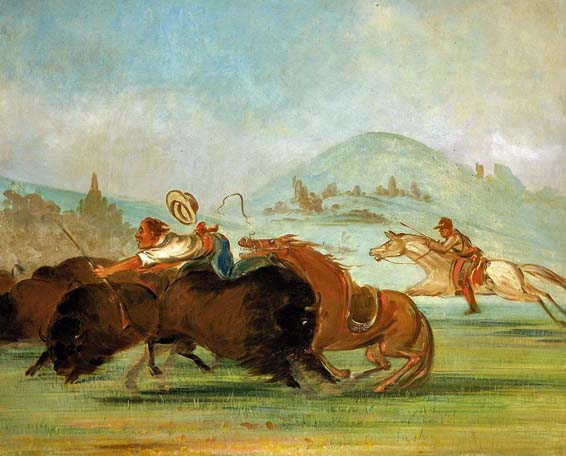
Batiste and I Running Buffalo,
Mouth of the Yellowstone: 1832
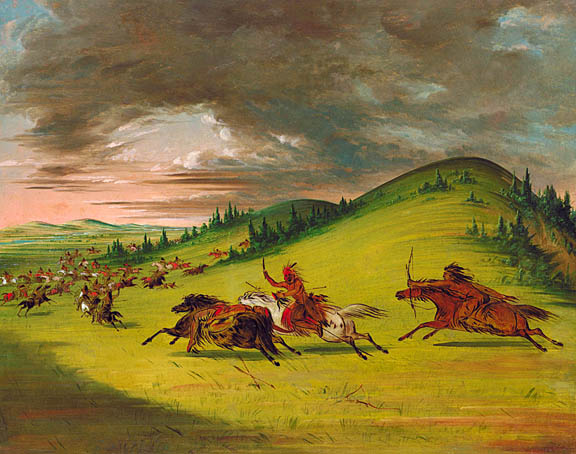
Battle Between Sioux and Sac and Fox: 1847
"The Sioux chief killed and scalped on his horse's back. An historical fact" (1848 catalogue, p. 50).
Painted in Paris 1846-1848. The style is similar to the series commissioned by Louis Philippe, but the subject does not appear on the Travels in Europe list.
A simplified version of the scene is repeated as cartoon 273.
Quoted From: The Catlin Collection
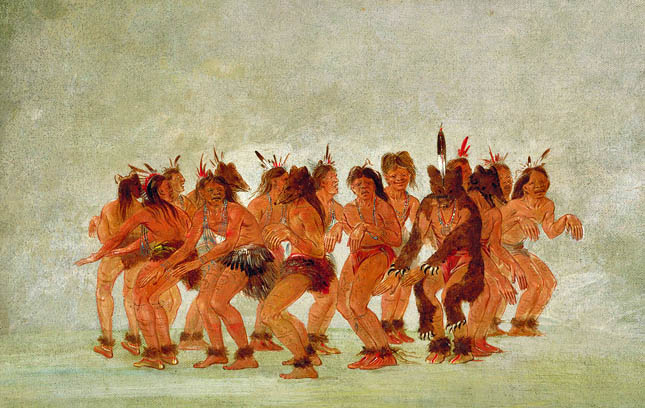
Bear Dance,
Preparing for a Bear Hunt: 1836
"The Sioux, like all the others of these western tribes, are fond of bear's meat, and must have good stores of the 'bear's-grease' laid in, to oil their long and glossy locks, as well as the surface of their bodies. And they all like the fine pleasure of a bear hunt, and also a participation in the bear dance, which is given several days in succession, previous to their starting out, and in which they all join in a song to the Bear Spirit; which they think holds somewhere an invisible existence, and must be consulted and conciliated before they can enter upon their excursion with any prospect of success. For this grotesque and amusing scene, one of the chief medicine-men, placed over his body the entire skin of a bear, with a war-eagle's quill on his head, taking the lead in the dance, and looking through the skin which formed a masque that hung over his face. Many others in the dance wore masques on their faces, made of the skin from the bear's head; and all, with the motions of their hands, closely imitated the movements of that animal; some representing its motion in running, and others the peculiar attitude and hanging of the paws, when it is sitting upon its hind feet, and looking out for the approach of an enemy" (Letters and Notes, vol. I).
Sketched near Fort Pierre in 1832. In the Gilcrease version, the dance takes place in a Sioux village, with members of the tribe looking on and skin lodges in the background. Although the subject does not appear on the Travels in Europe list, this version closely resembles other Paintings commissioned by Louis Philippe. The Smithsonian original matches plate 102 in Letters and Notes.
Quoted From: The Catlin Collection
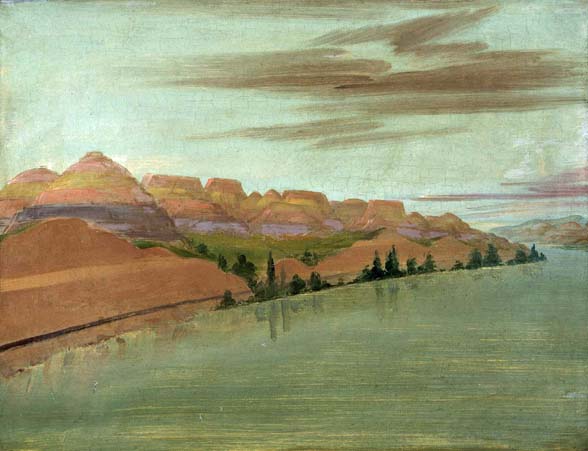
Beautiful Clay Bluffs,
1900 Miles above Saint Louis: 1832
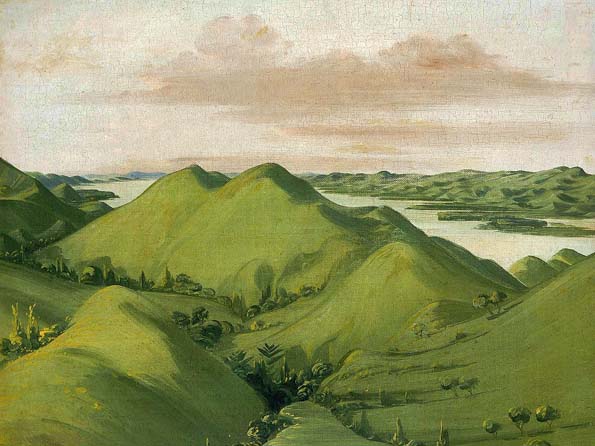
Beautiful Grassy Bluffs,
110 Miles above Saint Louis: 1832
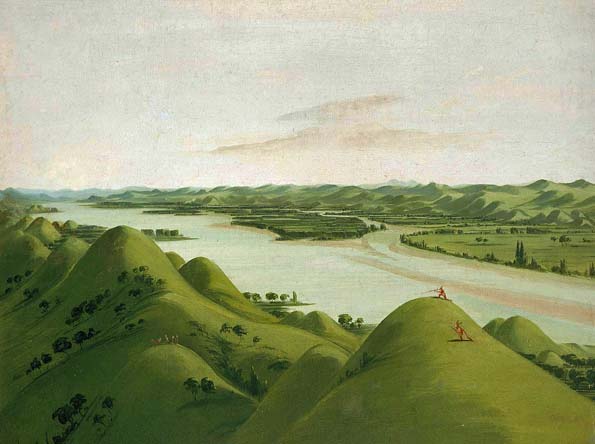
Beautiful Prairie Bluffs above the Poncas,
1050 Miles Above Saint Louis: 1832
"The summit level of the great prairies stretching off to the west and the east from the river, to an almost boundless extent, is from two to three hundred feet above the level of the river; which has formed a bed or valley for its course, varying in width from two to twenty miles. This channel or valley has been evidently produced by the force of the current, which has gradually excavated, in its floods and gorges, this immense space, and sent its debris into the ocean. By the continual overflowing of the river, its deposits have been lodged and left with a horizontal surface, spreading the deepest and richest alluvium over the surface of its meadows on either side; through which the river winds its serpentine course, alternately running from one bluff to the other, which present themselves to its shores in all the most picturesque and beautiful shapes and colors imaginable-some with their green sides gracefully slope down in the most lovely groups to the water's edge" (Letters and Notes, vol. I).
Painted in 1832 on the Missouri River voyage. Catlin's geological interests often determined his selection of subject matter. Matthews says the conformation of the hills is characteristic of that stretch of the river.
The Gilcrease version lacks the number and variety of hills in the Smithsonian original. The latter matches plate 5 in Letters and Notes. The scene is repeated in cartoon 246.
Quoted From: The Catlin Collection
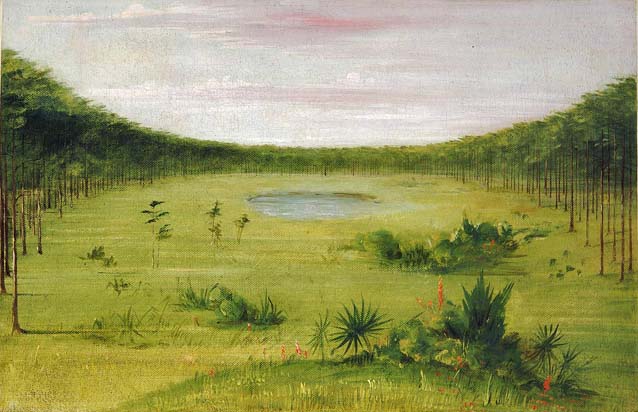
Beautiful Savannah in the Pine Woods of Florida: 1834

Beggar's Dance,
Mouth of Teton River: 1836
"This spirited dance was given, not by a set of beggars but by the first and most independent young men in the tribe, beautifully dressed, (i.e., not dressed at all, except with their breech clouts or kelts, made of eagles' and ravens' quills) with their lances, and pipes, and rattles in their hands, and a medicine-man beating the drum, and joining in the song at the highest key of his voice. In this dance every one sings as loud as he can halloo; uniting his voice with the others, in an appeal to the Great Spirit, to open the hearts of the bystanders to give to the poor, and not to themselves; assuring them that the Great Spirit will be kind to those who are kind to the helpless and poor" (Letters and Notes, vol. I).
Sketched near Fort Pierre in 1832. The scene is repeated in a cartoon incorrectly labeled Chief's Dance-Sioux in the National Gallery catalogue.
Quoted From: The Catlin Collection
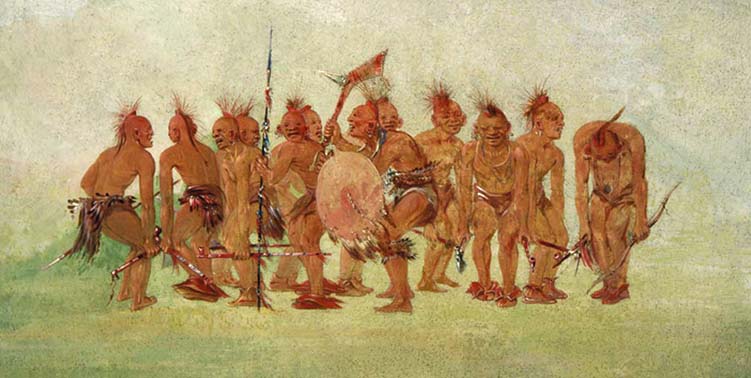
Begging Dance,
Sauk and Fox: 1836
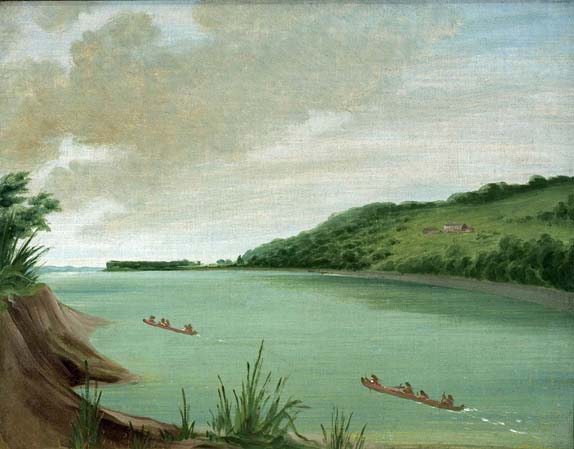
Belle Vue, Indian Agency of Major Dougherty,
870 Miles above Saint Louis: 1832
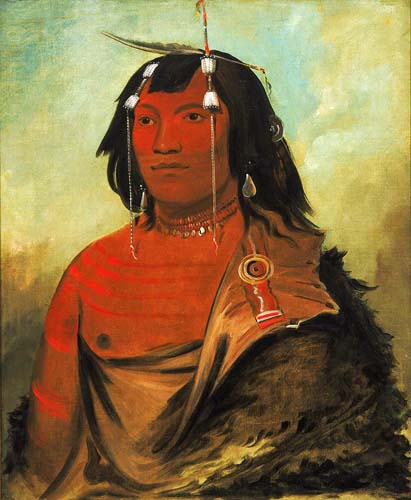
Bi-eets-ee-cure,
Very Sweet Man: 1832
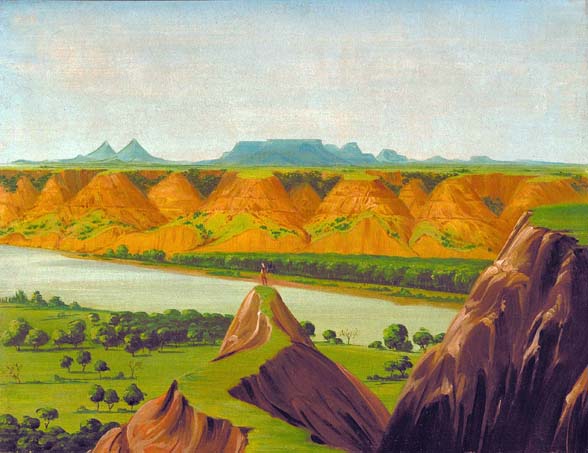
Big Bend on the Upper Missouri,
1900 Miles above Saint Louis: 1832
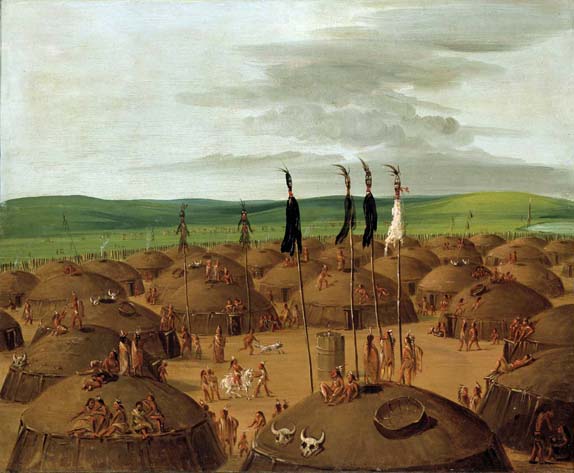
Bird's eye View of the Mandan Village,
1800 Miles above Saint Louis: 1838
"I have this morning, perched myself upon the top of one of the earth-covered lodges … and having the whole village beneath and about me, with its sachems-its warriors-its dogs-and its horses in motion-its medicines (or mysteries) and scalp-poles waving over my head-its piquets-its green fields and prairies, and river in full view, with the din and bustle of the thrilling panorama that is about me. I shall be able, I hope, to give some sketches more to the life than I could have done from any effort of recollection."
"The groups of lodges around me present a very curious and pleasing appearance, resembling in shape (more nearly than anything else I can compare them to) so many potash-kettles inverted. On the tops of these are to be seen groups standing and reclining, whose wild and picturesque appearance it would be difficult to describe. Stern warriors, like statues, standing in dignified groups, wrapped in their painted robes, with their heads decked and plumed with quills of the war-eagle. … In another direction, the wooing lover. … On other lodges, and beyond these, groups are engaged in games of the 'moccasin,' or the 'platter.' Some are to be seen manufacturing robes and dresses, and others, fatigued with amusements or occupations, have stretched their limbs to enjoy the luxury of sleep, while basking in the sun."
Catlin continues the description of the village over several pages of Letters and Notes (vol. 1) noting, in addition, the drum-like shrine in the center of the open area, the medicine lodge, the paraphernalia and trophies of Indian life, and the scaffolds of the Mandan cemetery in the distance.
The subject is not included in the 1837 catalogue, but does appear in the Egyptian Hall catalogue of January 1840, indicating that it was painted in the interval. Audubon thought Catlin had represented the earth lodges as too regular in size and shape; otherwise, the scene appears to be a unique and vivid account of Mandan village life. The painting is unusually detailed for the late 1830's, and apparently unrelated to a brief drawing of Mandan lodges in the SI sketchbook. The scene is repeated in cartoon 129.
Quoted From: The Catlin Collection

Blackbird's Grave, a Back View,
Prairies Enameled with Flowers: 1832
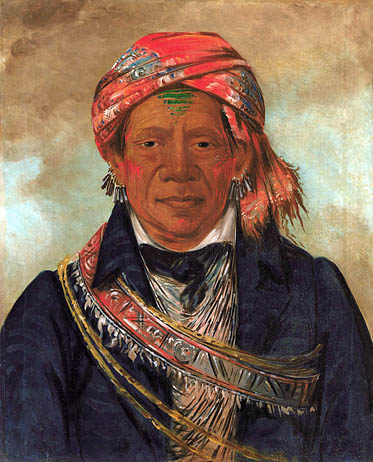
Bód-a-sin,
Chief of the Tribe: 1830
Probably painted at Fort Leavenworth in 1830. The broad, open brushwork has much in common with the technique of the Potawatomi and Kickapoo portraits.
Bód-a-sin appears again in cartoon 63, with his wife and another Delaware chief.
Quoted From: The Catlin Collection
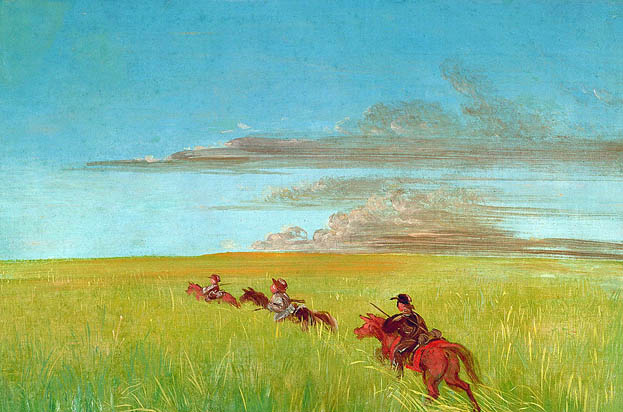
Bogard, Batiste, and I,
Traveling through a Missouri Bottom: 1838
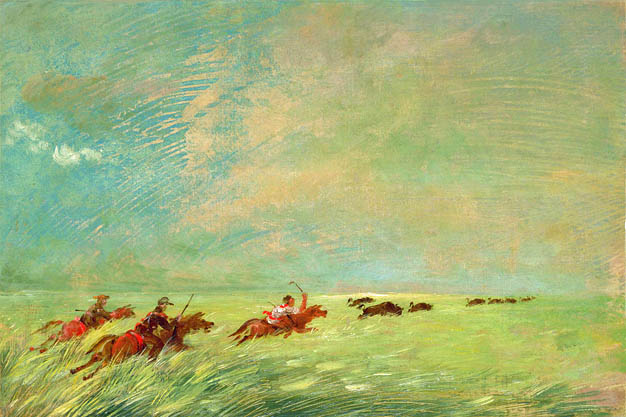
Bogard, Batiste, and I
Chasing Buffalo in High Grass on a Missouri Bottom: 1838
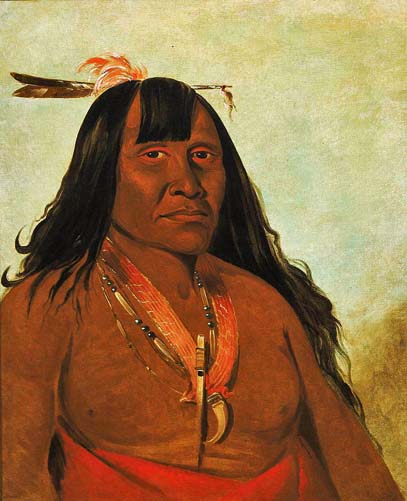
Bón-són-gee,
New Fire, a Band Chief: 1834
Catlin calls New Fire "a very good man" and describes the ornaments hanging on his breast as a boar's tusk and a war whistle (Letters and Notes, vol. 2).
Painted at the Comanche village in 1834. The subject's broadly brushed features have much in common with number 62 and several Comanche portraits.
In the Gilcrease watercolor, New Fire is shown three-quarter length, seated in a landscape. He appears again, full length, in cartoon 69.
Quoted From: The Catlin Collection
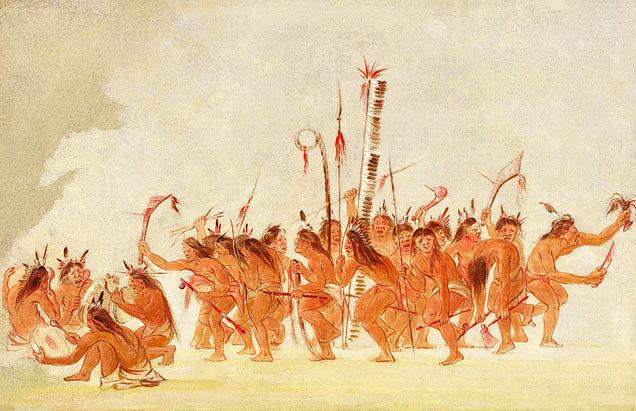
Braves Dance, Ojibwa: 1836
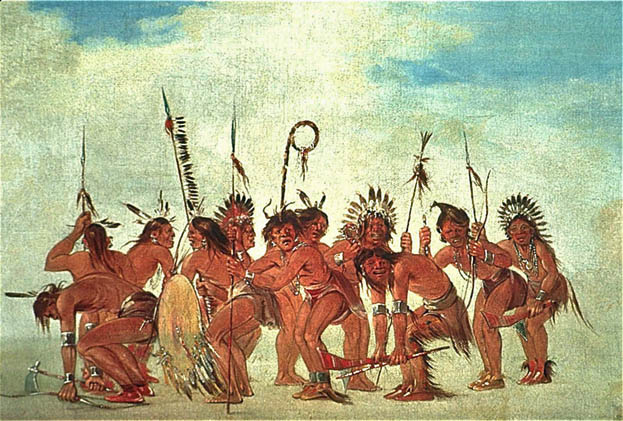
Braves' Dance at Fort Snelling: 1836
The Brave's Dance is peculiarly beautiful, and exciting to the feelings in the highest degree.
At intervals they stop, and one of them steps into the ring, and vociferates as loud as possible, with the most significant gesticulations, the feats of bravery which he has performed during his life-he boasts of the scalps he has taken-of the enemies he has vanquished, and at the same time carries his body through all the motions and gestures, which have been used during these scenes when they were transacted. At the end of his boasting, all assent to the truth of his story, and give in their approbation by the guttural 'waugh!' and the dance again commences. At the next interval, another makes his boasts, and another, and another, and so on" (Letters and Notes, vol. 2, pp. 130-36).
Sketched at Fort Snelling in 1835. The scene is repeated as a War Dance in plate 29 of Catlin's North American Indian Portfolio, first published in 1844.
Quoted From: The Catlin Collection
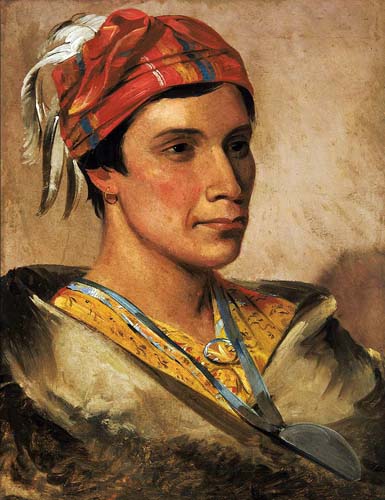
Bread, Chief of the Tribe: 1831
"He is a shrewd and talented man, well educated-speaking good English-is handsome, and a polite and gentlemanly man in his deportment" (Letters and Notes, vol. II). Catlin also describes Bread as "half-blood" (1848 catalogue, p. 29).
Probably painted in Washington in early 1831, as the size and style of the portrait so closely match the Seneca and Menominee series. Moreover, Bread's name appears on a treaty signed in Washington January 20, 1831, to determine the removal of certain New York tribes to land west of Green Bay, where Catlin locates the chief in the 1837 catalogue.
The artist apparently devoted some time to painting Bread, as the portrait is one of the most perceptive and carefully finished of the period. The subject also appears, full length, in cartoon 62, with his sister and a Tuscarora missionary.
Quoted From: The Catlin Collection
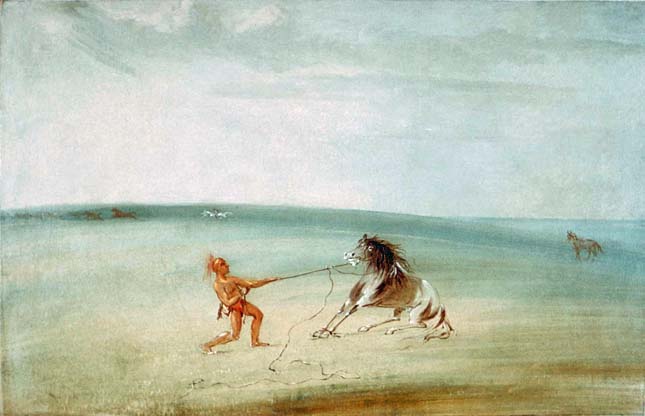
Breaking Down the Wild Horse: 1834
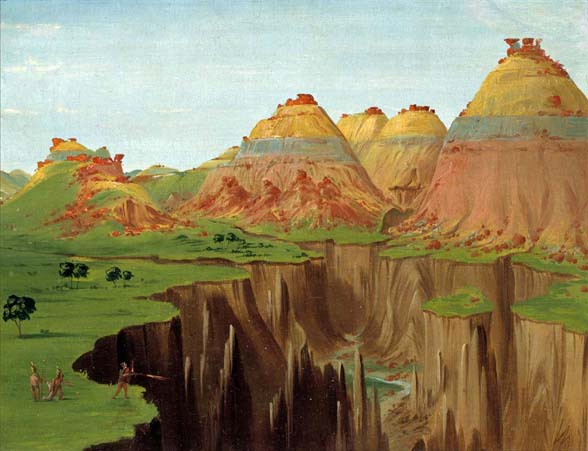
Brick Kilns, Clay Bluffs
1900 Miles above Saint Louis: 1832
As he traveled up the Missouri River, Catlin encountered novel land forms, never seen east of the Mississippi. Among these were the "Brick Kilns", visible from miles away because of their striking red color. They had been named by trappers, who had first seen these clay banks, which the river eroded into a series of tall, fantastically shaped, colorfully striated bluffs. Catlin was an amateur geologist, and when he found a layer of red pumice on top of the formations, decided they were volcanic in origin.
"By the action of water, or other power, the country seems to have been graded away; leaving occasionally a solitary mound or bluff, rising in a conical form to the height of two or three hundred feet, generally pointed or rounded at the top, and in some places grouped together in great numbers . . . the sides of these conical bluffs (which are composed of strata of different colored clays), are continually washing down by the effect of the rains and melting of the frost; and the superincumbent masses of pumice and basalt are crumbling off, and falling down to their bases; and from thence, in vast quantities, by the force of the gorges of water which are often cutting their channels between them-carried into the river, which is close by" (Letters and Notes, Letter No. 10).
Awed by the visual beauty before him, Catlin cannot suppress his scientific curiosity about how it evolved.
Quoted From: Campfire Stories with George Catlin
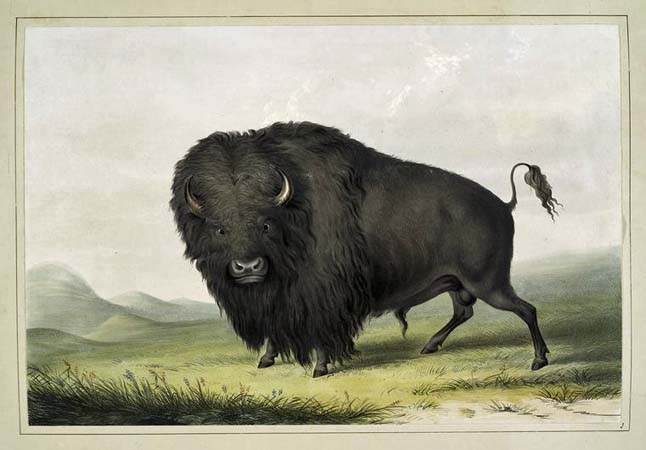
Buffalo Bull Grazing: 1845
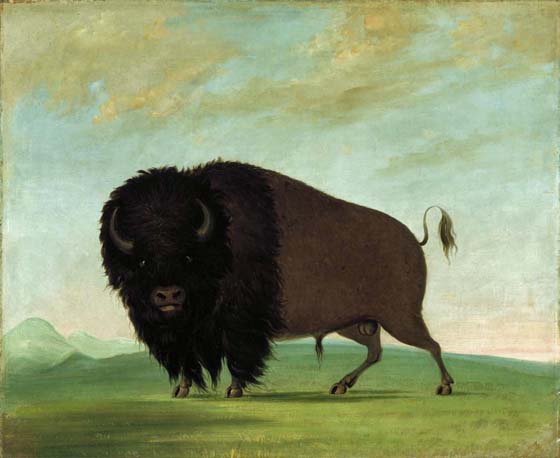
Buffalo Bull, Grazing on the Prairie: 1832
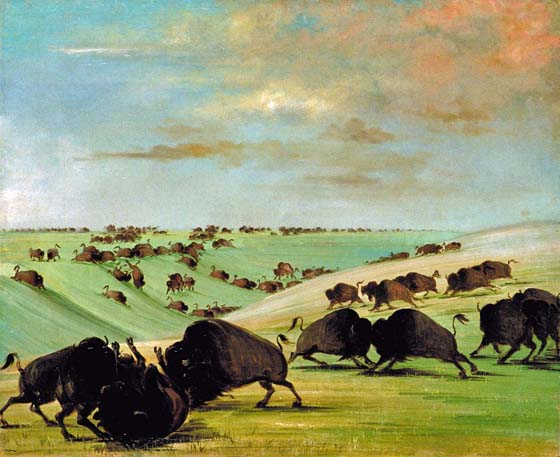
Buffalo Bulls Fighting in Running Season,
Upper Missouri: 1837
Catlin recounted that the "buffalo graze in immense and almost incredible numbers at times, and roam about and over vast tracts of country, from East to West, and from West to East, as often as from North to South" with the seasons, following the sweetest and most abundant grass. The Plains tribes, dependent on them for food, shelter, tools, and every other necessity of existence, migrated with them.
Quoted From: Campfire Stories with George Catlin
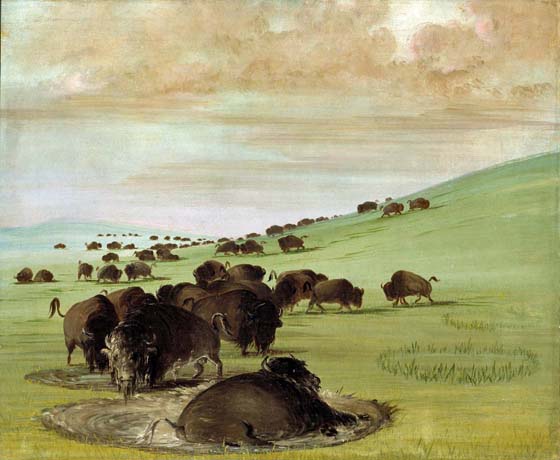
Buffalo Bulls in a Wallow: 1837
Catlin certainly enjoyed hunting with the Indians, and described his own exploits in bringing down buffalo with gusto and graphic detail. He observed, with equally minute attention, that the buffalo provided everything the Plains Indian needed: "There are, by a fair calculation, more than 300,000 Indians, who are now subsisted on the flesh of the buffaloes, and by those animals supplied with all the luxuries of life. The great variety of uses to which they convert the body and other parts of that animal, are almost incredible to the person who has not actually dwelt among these people, and closely studied their modes and customs. Every part of their flesh is converted into food, in one shape or another, and on it they entirely subsist. The robes of the animals are worn by the Indians instead of blankets-their skins when tanned, are used as coverings for their lodges, and for their beds; undressed, they are used for constructing canoes-for saddles, for bridles-lariats, lassos, and thongs. The horns are shaped into ladles and spoons-the brains are used for dressing the skins -their bones are used for saddle trees - for war clubs, and scrapers for graining the robes-and others are broken up for the marrow-fat which is contained in them. Their sinews are used for strings and backs to their bows-for thread to string their beads and sew their dresses. The feet of the animals are boiled, with their hoofs, for the glue they contain, for fastening their arrow points, and many other uses. The hair from the head and shoulders, which is long, is twisted and braided into halters, and the tail is used for a fly brush. In this wise do these people convert and use the various parts of this useful animal, and with all these luxuries of life about them, and their numerous games, they are happy (God bless them) in the ignorance of the disastrous fate that awaits them" (Letters and Notes, Letter No. 31).
Catlin came to believe that the buffalo would be wiped out, which raised another question in his mind: "When the buffaloes shall have disappeared in his country, which will be within eight or ten years, I would ask, who is to supply [the Indian] with the necessaries of life then? and I would ask, further, (and leave the question to be answered ten years hence), when the skin shall have been stripped from the back of the last animal, who is to resist the ravages of 300,000 starving savages; and in their trains, 1,500,000 wolves, whom direst necessity will have driven from their desolate and game-less plains, to seek for the means of subsistence along our exposed frontier? God has everywhere supplied man in a State of Nature, with the necessaries of life, and before we destroy the game of his country, or teach him new desires, he has no wants that are not satisfied" (Letters and Notes, Letter No. 31). The end was not exactly as Catlin predicted, but he was nearly correct about the fate of the buffalo. Modern experts estimate that the buffalo herds in the 1830's were between forty and sixty million head; it is almost inconceivable that within fifty years, that number would be reduced to less than five thousand.
Quoted From: Campfire Stories with George Catlin
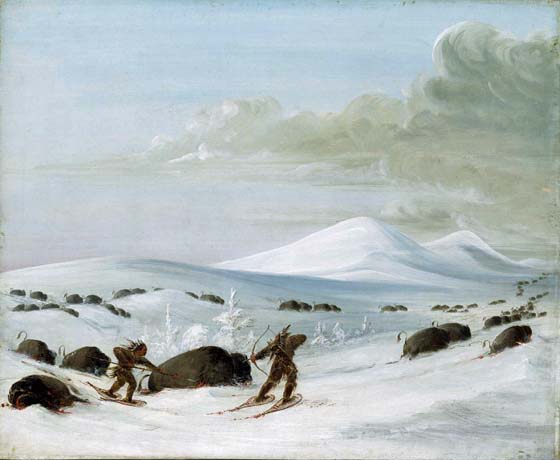
Buffalo Chase in Snowdrifts,
Indians Pursuing on Snowshoes: 1832

Buffalo Chase in Winter,
Indians on Snowshoes: 1832
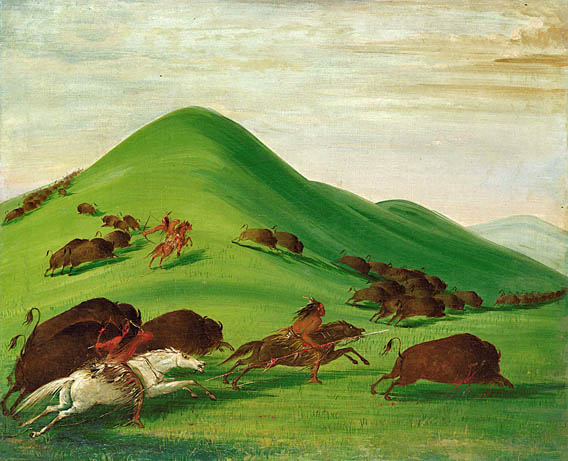
Buffalo Chase over Prairie Bluffs: 1832
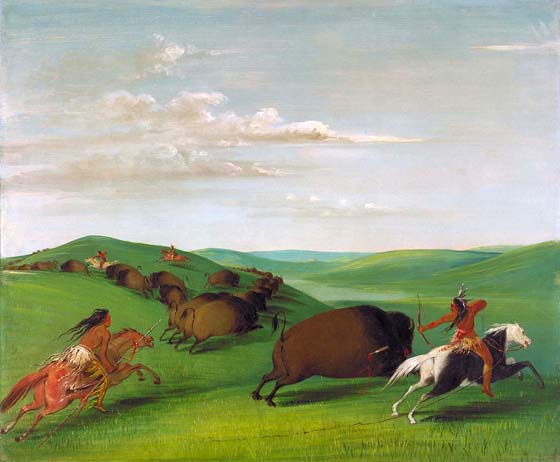
Buffalo Chase with Bows and Lances: 1832
When Catlin went West in the 1830's, he encountered peoples still living on their homelands. He was thrilled to see their freedom and praised their grace and beauty. "No man's imagination, with all the aids of description that can be given to it, can ever picture the beauty and wildness of scenes that may be daily witnessed in this romantic country; of hundreds of these graceful youths, without a care to wrinkle, or a fear to disturb the full expression of pleasure and enjoyment that beams upon their faces - their long black hair mingling with their horses' tails, floating in the wind, while they are flying over the carpeted prairie, and dealing death with their spears and arrows, to a band of infuriated buffaloes; or their splendid procession in a war parade, arrayed in all their gorgeous colors and trappings, moving with most exquisite grace and manly beauty, added to that bold defiance which man carries on his front, who acknowledges no superior on earth, and who is amenable to no laws except the laws of God and honor."
Source: Letters and Notes, No. 2.
Quoted From: Campfire Stories with George Catlin
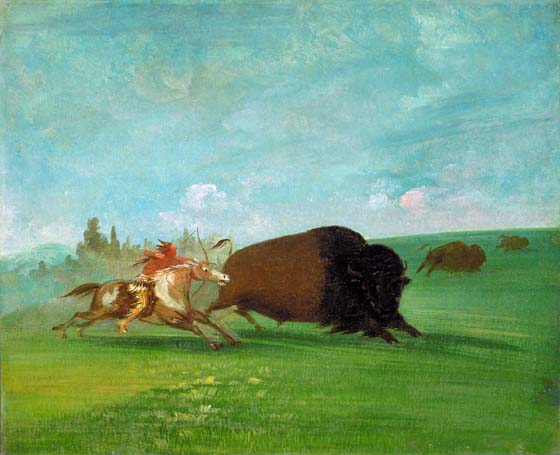
Buffalo Chase, a Single Death: 1832
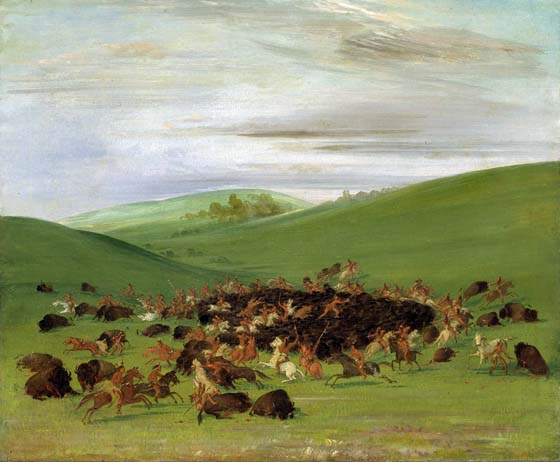
Buffalo Chase, Surrounded by the Hidatsa: 1832
We soon descried at a distance, a fine herd of buffaloes grazing, when a halt and a council were ordered and the mode of attack was agreed upon. I had armed myself with my pencil and my sketchbook only, and consequently took my position generally in the rear, where I could see and appreciate every maneuver.
The plan of attack, which in this country is familiarly called a 'surround,' was explicitly agreed upon, and the hunters who were all mounted on their 'buffalo horses' and armed with bows and arrows or long lances, divided into two columns, taking opposite directions, and drew themselves gradually around the herd at a mile or more distance from them; thus forming a circle of horsemen at equal distances apart, who gradually closed in upon them with a moderate pace, at a signal given. The unsuspecting herd at length 'got the wind' of the approaching enemy and fled in a mass in the greatest confusion. … I had rode up in the rear and occupied an elevated position at a few rods distance, from which I could … survey from my horse's back, the nature and the progress of the grand meleé … a cloud of dust was soon raised, which in parts obscured the throng where the hunters were galloping their horses around and driving the whizzing arrows or their long lances to the hearts of these noble animals; which in many instances, becoming infuriated with deadly wounds in their sides, erected their shaggy manes over their blood-shot eyes and furiously plunged forwards at the sides of their assailants' horses, sometimes goring them to death at a lunge, and putting their dismounted riders to flight for their lives; sometimes their dense crowd was opened, and the blinded horsemen, too intent on their prey amidst the cloud of dust, were hemmed and wedged in amidst the crowding beasts, over whose backs they were obliged to leap for security, leaving their horses to the fate that might await them" (Letters and Notes, vol. 1, pp. 199-200, pl. 79).
Quoted From: The Catlin Collection
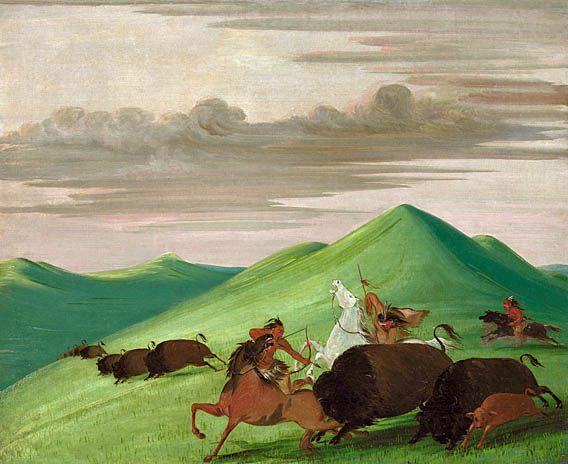
Buffalo Chase, Bull Protecting a Cow and Calf: 1832

Buffalo Chase, Bulls Making Battle with Men and Horses: 1832

Buffalo Chase, Mouth of the Yellowstone: 1832
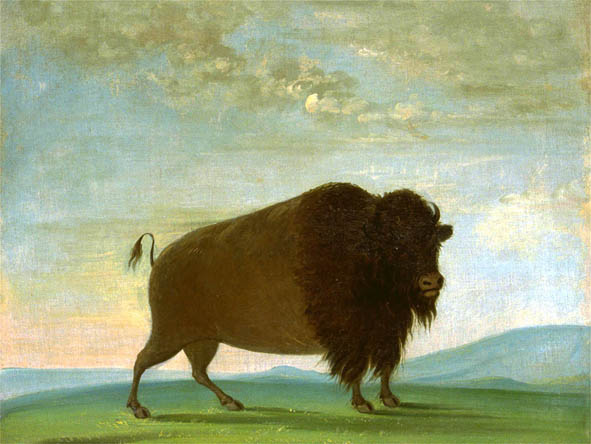
Buffalo Cow Grazing on the Prairie: 1832
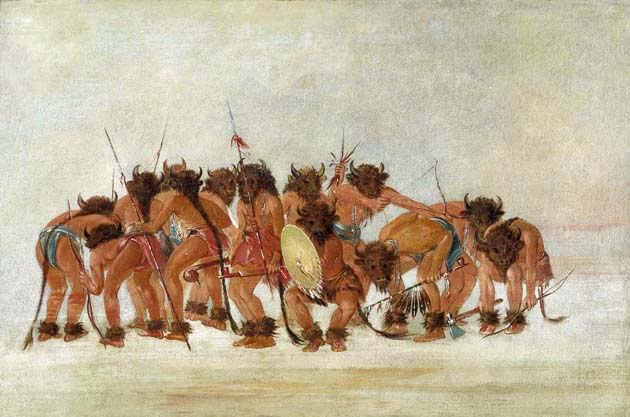
Buffalo Dance, Mandan: 1836
"The (buffalo) mask is put over the head, and generally has a strip of the skin hanging to it, of the whole length of the animal, with the tail attached to it, which, passing down over the back of the dancer, is dragging on the ground. When one becomes fatigued of the exercise, he signifies it by bending quite forward, and sinking his body towards the ground; when another draws a bow upon him and hits him with a blunt arrow, and he falls like a buffalo-is seized by the bye-standers, who drag him out of the ring by the heels, brandishing their knives about him; and having gone through the motions of skinning and cutting him up, they let him off, and his place is at once supplied by another, who dances into the ring with his mask on; and by this taking of places, the scene is easily kept up night and day, until the desired effect has been produced, that of 'making buffalo come' " (Letters and Notes, vol. I).
Sketched in 1832 at the Mandan village. The scene is repeated in plate 8 of Catlin's North American Indian Portfolio, first published in 1844; in plate 70 of the Gilcrease Souvenir album; and in cartoon 171.
Quoted From: The Catlin Collection
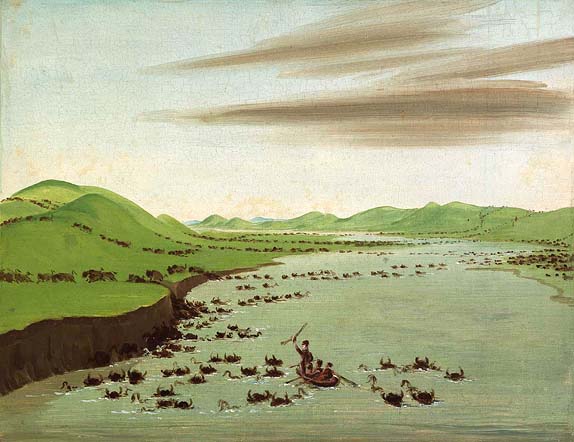
Buffalo Herds Crossing the Upper Missouri: 1832
The prairie ecosystem supported flocks of birds, extensive prairie dog towns, and vast herds of game, including elk, antelope, deer, and especially buffalo. Over and over, Catlin describes the size of the herds and the strength and power of the beasts themselves. "Near the mouth of White River, we met the most immense herd crossing the Missouri River-and from an imprudence got our boat into imminent danger among them, from which we were highly delighted to make our escape. It was in the midst of the 'running season', and we had heard the 'roaring' (as it is called) of the herd, when we were several miles from them. When we came in sight, we were actually terrified at the immense numbers that were streaming down the green hills on one side of the river, and galloping up and over the bluffs on the other. The river was filled, and in parts blackened, with their heads and horns, as they were swimming about . . . furiously hooking and climbing on to each other. I rose in my canoe, and by my gestures and hallooing, kept them from coming in contact with us, until we were out of their reach." (Letters and Notes, Letter No. 32)
Quoted From: Campfire Stories with George Catlin
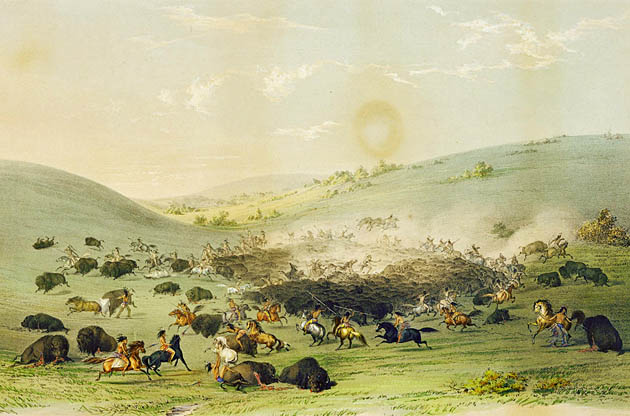
Buffalo Hunt Surround no 9: Date Unknown

Buffalo Hunt under the Wolf-Skin Mask: 1832
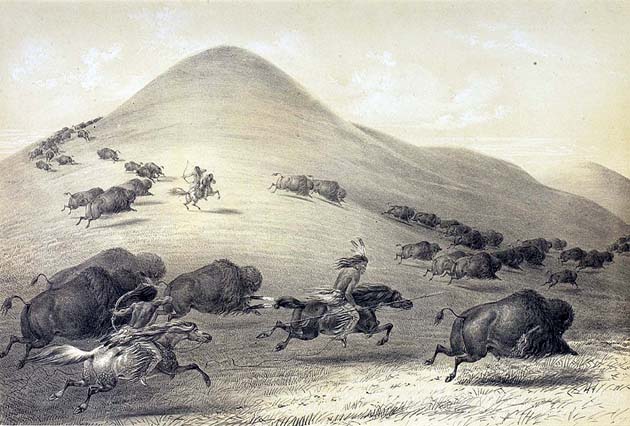
Buffalo Hunt, Chase no 6: Date Unknown
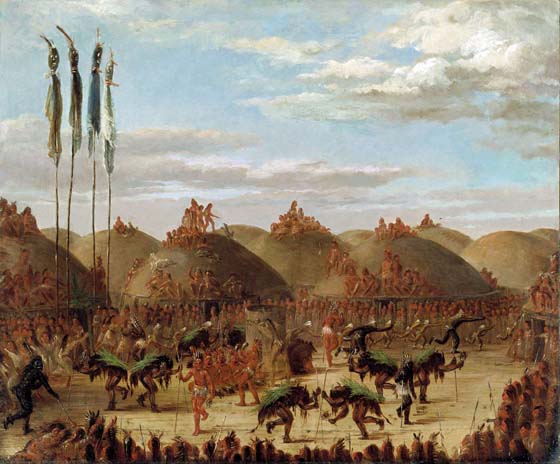
Bull Dance, Mandan O-kee-pa Ceremony: 1832
"During the first three days of this solemn conclave," Catlin continues, "there were many very curious forms and amusements enacted in the open area in the middle of the village, and in front of the medicine-lodge, by other members of the community, one of which formed a material part or link of these strange ceremonials. This very curious and exceedingly grotesque part of their performance, which they denominated … the bull-dance, of which I have before spoken, as one of the avowed objects for which they held this annual féte; and to the strictest observance of which they attribute the coming of buffaloes to supply them with food during the season-is repeated four times during the first day, and sixteen times on the fourth day; and always around the curb, or 'big canoe' (the drum-like shrine in the center of the open area)."
"This subject I have selected for my second picture, and the principal actors in it were eight men, with the entire skins of buffaloes thrown over their backs, with the horns and hoofs and tails remaining on; their bodies in a horizontal position, enabling them to imitate the actions of the buffalo, while they were looking out of its eyes as through a mask."
"The bodies of these men were chiefly naked and all painted in the most extraordinary manner, with the nicest adherence to exact similarity; their limbs, bodies and faces, being in every part covered, either with black, red, or white paint. Each one of these strange characters had also a lock of buffalo's hair tied around his ankles-in his right hand a rattle, and a slender white rod or staff, six feet long, in the other; and carried on his back, a bunch of green willow boughs about the usual size of a bundle of straw. These eight men, being divided into four pairs, took their positions on the four different sides of the curb or big canoe, representing thereby the four cardinal points; and between each group of them, with the back turned to the big canoe, was another figure, engaged in the same dance, keeping step with them, with a similar staff or wand in one hand and a rattle in the other, and (being four in number) answering again to the four cardinal points. The bodies of these four young men were chiefly naked, with no other dress upon them than a beautiful kelt (or quartz-quaw), around the waist, made of eagles quills and ermine, and very splendid headdresses made of the same materials. Two of these figures were painted entirely black with pounded charcoal and grease, whom they called the 'firmament or night,' and the numerous white spots which were dotted all over their bodies, they called 'stars.' The other two were painted from head to foot as red as vermilion could make them; these they said represented the day, and the white streaks which were painted up and down over their bodies, were 'ghosts which the morning rays were chasing away' " (Letters and Notes, vol. I).
Quoted From: The Catlin Collection
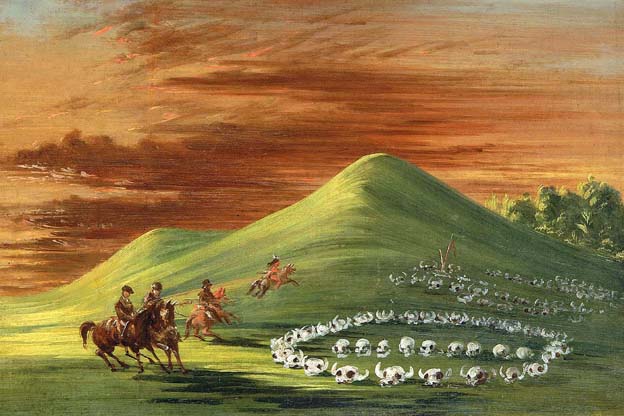
Butte de Mort, Sioux Burial Ground,
Upper Missouri: 1838
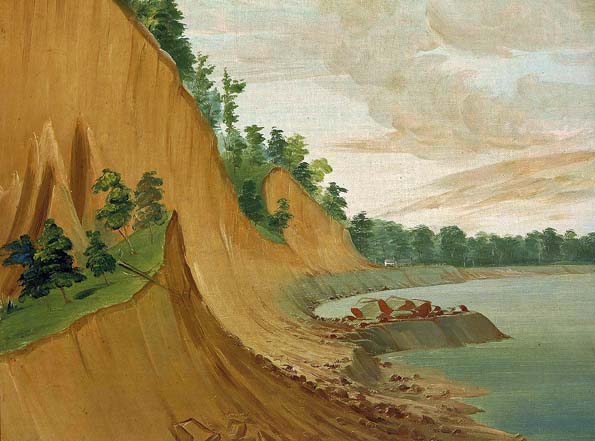
Cabane's Trading House, 930 Miles above Saint Louis: 1832

Caddo Indians Chasing Buffalo, Cross Timbers, Texas: 1847
Painted in Paris 1846-1848. The Cross Timbers area extends into southern Oklahoma, where Catlin saw many such chases. Cartoon 360 is a similar or related view.
Quoted From: The Catlin Collection

Cah-be-mub-bee,
He Who Sits Everywhere, a Brave: 1845
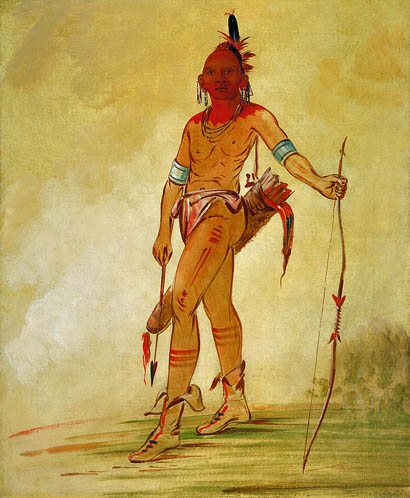
Cah-he-ga-shín-ga,
Little Chief: 1834
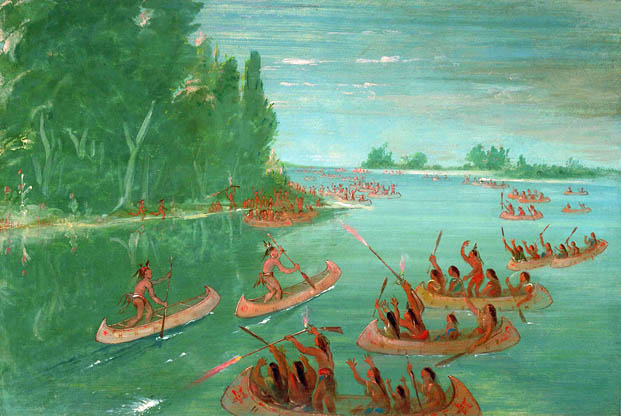
Canoe Race Near Sault Ste. Marie: 1836
"In plate 267 is seen one of their favorite amusements at this place, which I was lucky enough to witness a few miles below the Sault, when high betting had been made, and a great concourse of Indians had assembled to witness an Indian regatta or canoe race, which went off with great excitement, firing of guns, yelping. The Indians in this vicinity are all Chippewa, and their canoes all made of birch bark, and chiefly of one model; they are exceedingly light, as I have before described, and propelled with wonderful velocity" (Letters and Notes, vol. II).
Sketched on Catlin's journey to the Pipestone Quarry in 1836. The scene is repeated in cartoon 335.
Quoted From: The Catlin Collection
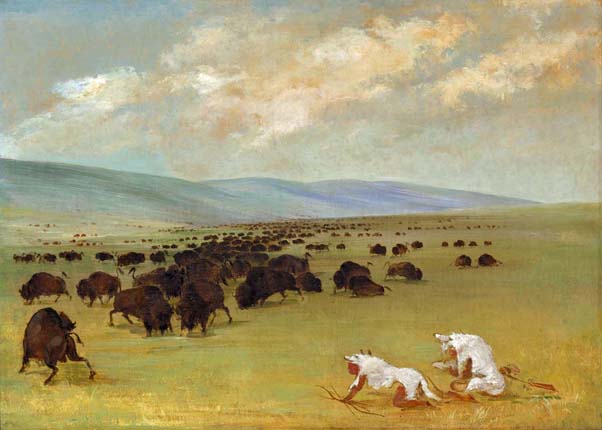
Catlin and His Indian Guide
Approaching Buffalo under White Wolf Skins: 1847
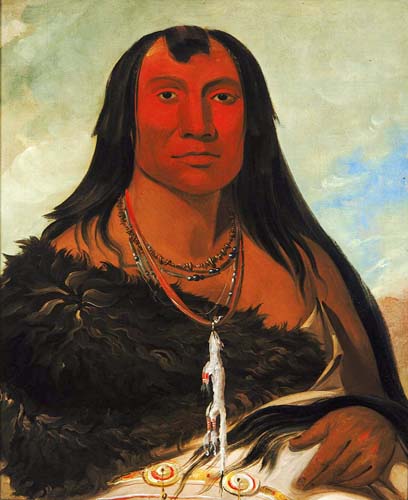
Chah-ee-chopes,
Four Wolves, a Chief in Mourning: 1832
"The grandson also of this sachem, a boy of six years of age, and too young as yet to have acquired a name, has stood forth like a tried warrior; and I have painted him at full length, with his bow and quiver slung, and his robe made of a raccoon skin. The history of this child is somewhat curious and interesting; his father is dead, and in case of the death of the chief … he becomes hereditary chief of the tribe. This boy has been twice stolen away by the Crows by ingenious stratagems, and twice re-captured by the Blackfeet, at considerable sacrifice of life, and at present he is lodged with Mr. M'Kenzie, for safekeeping and protection, until he shall arrive at the proper age to take the office to which he is to succeed" (Letters and Notes, vol. 1, p. 30, pl. 12).
Painted at Fort Union in 1832. The true proportions of such a diminutive figure were still beyond Catlin's reach, but the appealing roundness of the little boy effectively conveys his age. The face and figure in the Gilcrease portrait are only a stylized approximation of the original.
Quoted From: The Catlin Collection
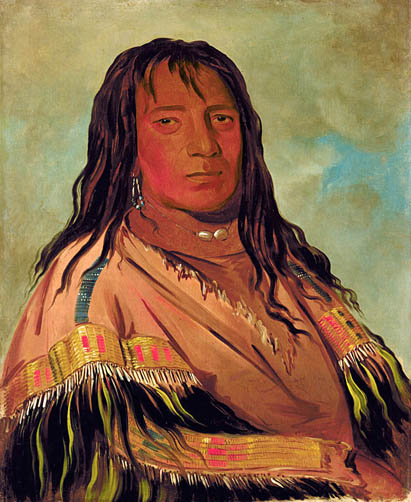
Cha-tee-wah-nee-che, No Heart,
Chief of the Wah-ne-watch-to-nee-nah Band: 1832
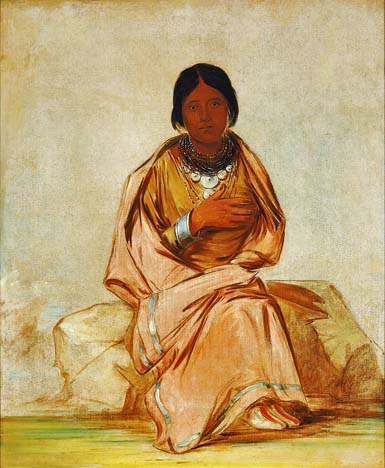
Chee-a-ex-e-co,
Daughter of Deer without a Heart: 1838
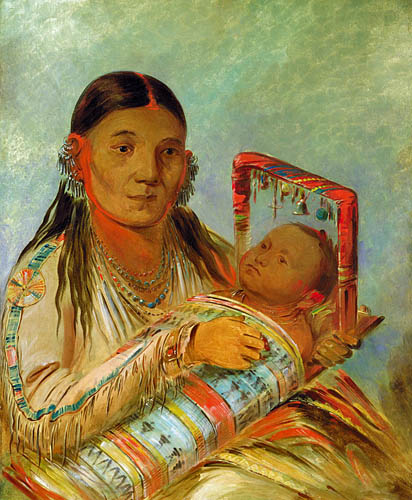
Chee-ah-ka-tchee,
Wife of Not-to-way: 1835
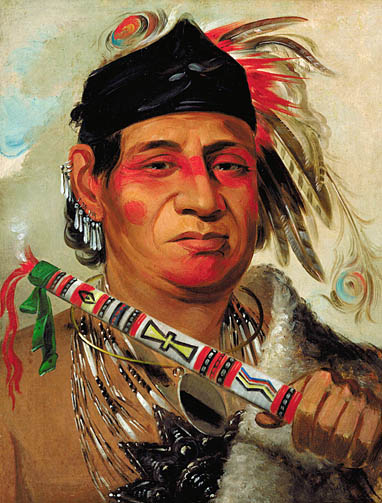
Chee-me-nah-na-quet,
Great Cloud, son of Grizzly Bear: 1831
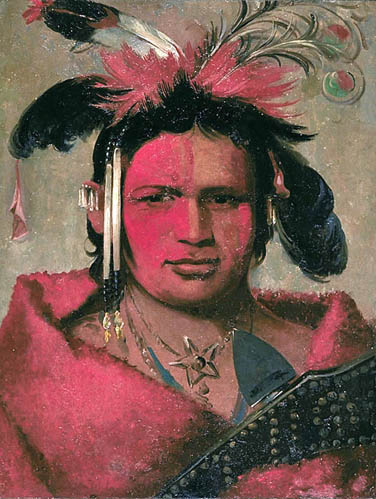
Chee-me-nah-na-quet,
Great Cloud, son of Grizzly Bear: 1831
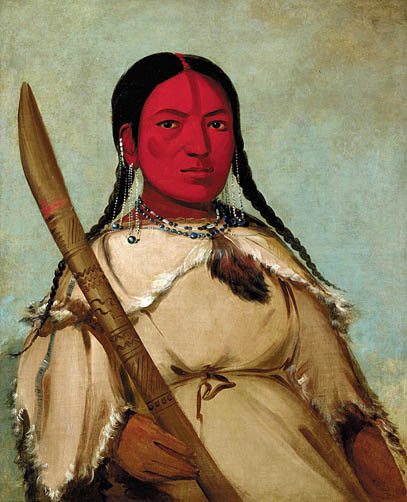
Chin-cha-pee,
Fire Bug That Creeps, Wife of Pigeon's Egg Head: 1832
"A fine looking squaw, in a handsome dress of the mountain-sheep skin, holding in her hand a stick curiously carved, with which every woman in this country is supplied; for the purpose of digging up the … prairie turnip" (Letters and Notes, vol. 1, p. 56, pl. 29).
Painted at Fort Union in 1832. The subject appears again, full length, in cartoon 75, with her husband.
Quoted From: The Catlin Collection
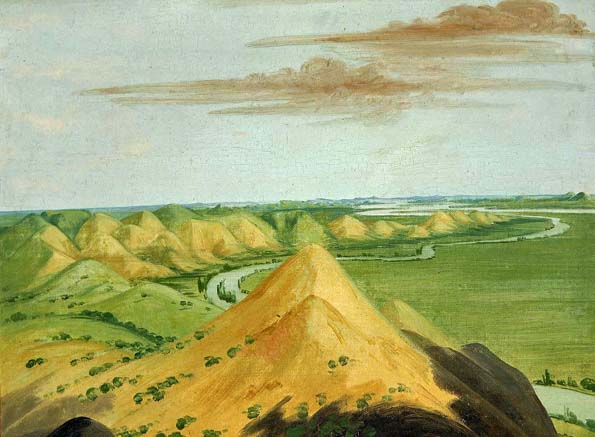
Clay Bluffs, Twenty Miles above the Mandans: 1832
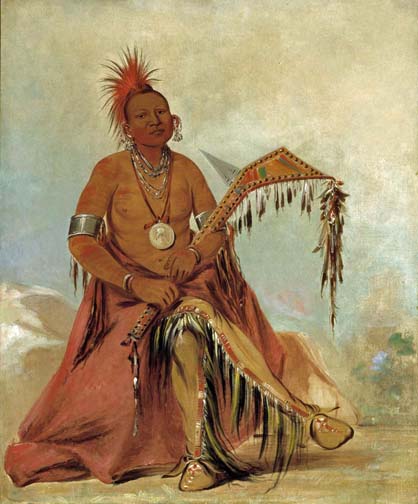
Cler-mont, First Chief of the Tribe: 1834
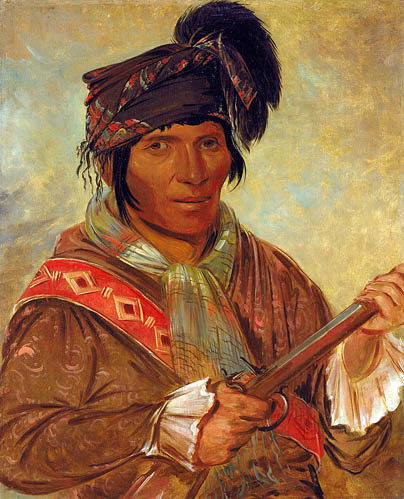
Co-ee-ha-jo,
a Chief: 1838
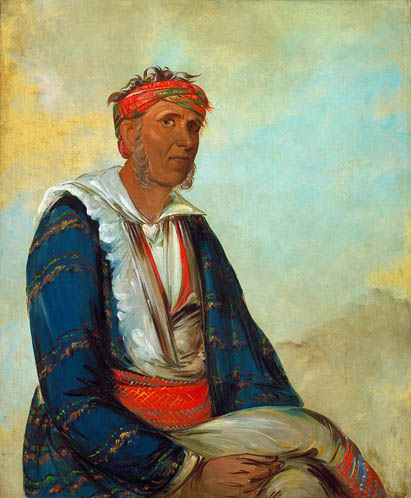
Cól-lee, a Band Chief: 1834
"An aged and dignified chief. … This man … as well as a very great proportion of the Cherokee population, has a mixture of red and white blood in his veins, of which, in this instance, the first seems decidedly to predominate" (Letters and Notes, vol. 2, p. 119, pl. 217).
Painted at Fort Gibson in 1834. Catlin refers to the subject as Jol-lee in Letters and Notes.
The oil portrait has been modeled with a vivacity and assurance that almost equals number 284, but the Gilcrease watercolor, for once, also looks much like a life study (fig. 146). The subject is half-length in the latter, and a chair back is visible behind his right shoulder. The Smithsonian portrait more closely resembles plate 217 in Letters and Notes.
Cól-lee appears again, full length, in cartoon 71.
Quoted From: The Catlin Collection
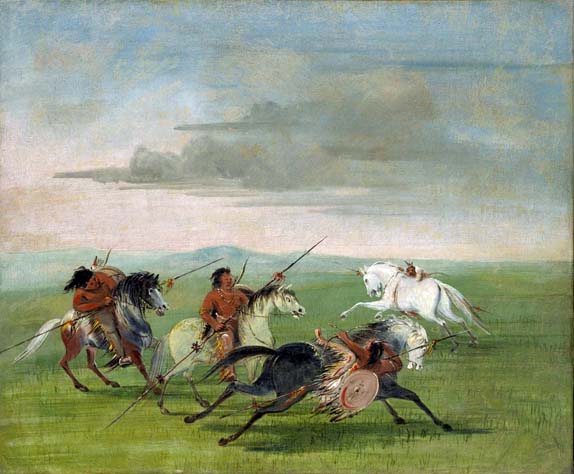
Comanche Feats of Horsemanship: 1834
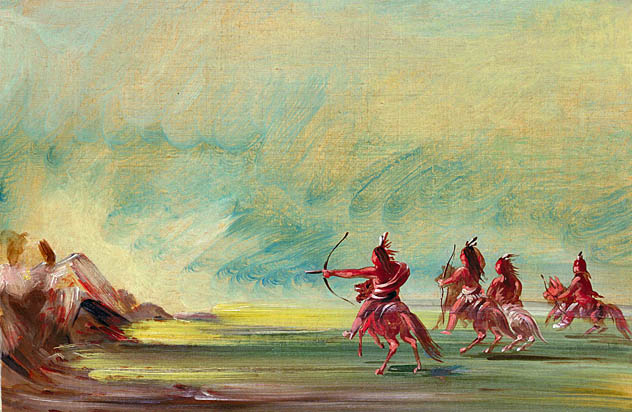
Comanche Giving Arrows to the Medicine Rock: 1838
"A curious superstition of the Comanche: going to war, they have no faith in their success, unless they pass a celebrated painted rock, where they appease the spirit of war (who resides there), by riding by it at full gallop, and sacrificing their best arrow by throwing it against the side of the ledge" (1848 catalogue, pp. 40-44).
The painting is not included in the 1837 catalogue, and the brushwork is the same as in number 471, indicating a similar date of execution. Catlin used a wide range of techniques in the late 1830's, depending on the subject and the time he wished to devote to an individual painting.
Quoted From: The Catlin Collection
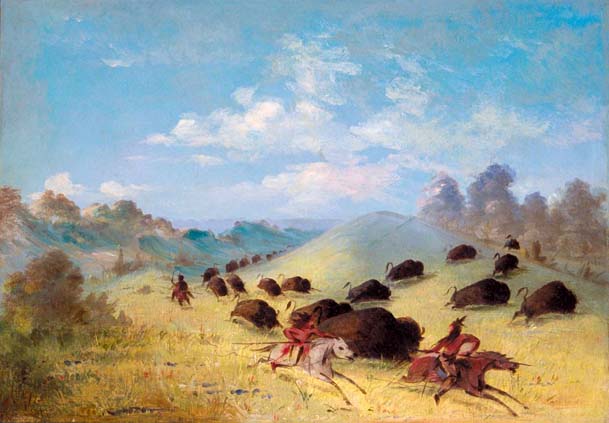
Comanche Indians Chasing Buffalo with Lances and Bows: 1846
Catlin enjoyed and documented buffalo hunts with various tribes, describing methods such as the exhilarating but dangerous chase on horseback, the surround, and the ambush, in which hunters crept among the unsuspecting herds disguised under the skin of a white wolf for a close and easy shot. While many Indians still used the ambush in the 1830's, the acquisition of the horse shaped both hunting methods and the larger Plains culture. Not only could they hunt with less danger to themselves and greater hope of success, they were able to keep and transport far larger volumes of possessions. Catlin noted that contact with white traders and settlers created 'artificial' needs, which were satisfied by trading buffalo robes for whiskey and other goods. He remarked that "the Sioux are a bold and desperate set of horsemen, and great hunters; and in the heart of their country is one of the most extensive assortments of goods, of whiskey, and other saleable commodities, as well as a party of the most indefatigable men, who are constantly calling for every robe that can be stripped from the buffalos' backs" (Letters and Notes, Letter No. 31). Already in Catlin's time, Plains Indians were killing bison in increasing numbers (and taking extra wives to prepare the hides) to take advantage of new trading opportunities.
Quoted From: Campfire Stories with George Catlin
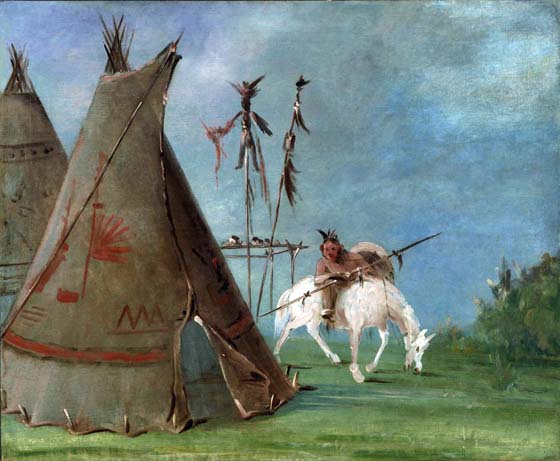
Comanche Lodge of Buffalo Skins: 1834
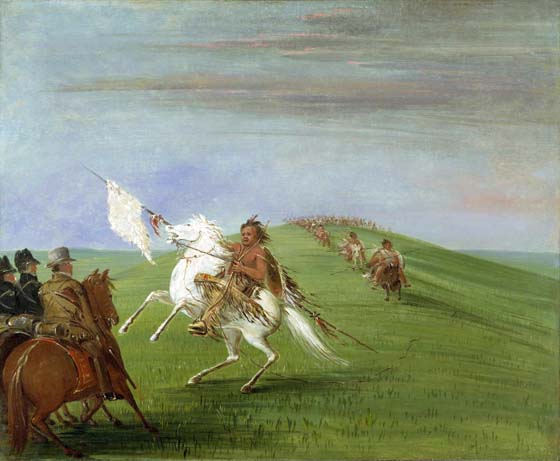
Comanche Meeting the Dragoons: 1834
"Colonel Dodge ordered the command to halt, while he rode forward with a few of his staff, and an ensign carrying a white flag. I joined this advance, and the Indians stood their ground until we had come within half a mile of them, and could distinctly observe all their numbers and movements. We then came to a halt, and the white flag was sent a little in advance, and waved as a signal for them to approach; at which one of their party galloped out in advance of the war-party, on a milk white horse, carrying a piece of white buffalo skin on the point of his long lance in reply to our flag.
"This moment was the commencement of one of the most thrilling and beautiful scenes I ever witnessed. All eyes, both from his own party and ours, were fixed upon the maneuvers of this gallant little fellow, and he well knew it.
"The distance between the two parties was perhaps half a mile, and that a beautiful and gently sloping prairie; over which he was for the space of a quarter of an hour, reining and spurring his maddened horse, and gradually approaching us by tacking to the right and the left, like a vessel beating against the wind. He at length came prancing and leaping along till he met the flag of the regiment, when he leaned his spear for a moment against it, looking the bearer full in the face, when he wheeled his horse, and dashed up to Colonel Dodge with his extended hand, which was instantly grasped and shaken. We all had him by the hand in a moment, and the rest of the party seeing him received in this friendly manner, instead of being sacrificed, as they undoubtedly expected, started under 'full whip' in a direct line toward us" (Letters and Notes, vol. 2, pp. 50-56, pl. 157).
Sketched on the dragoon expedition in 1834. Catlin often communicated the visual impact of such events more effectively in his written descriptions than in his paintings.
Quoted From: The Catlin Collection

Comanche Moving Camp, Dog Fight Enroute: 1834
Catlin wrote that the Indians would move their camp six or eight times in a summer to follow the buffalo herds. He admired the efficiency of their methods, as he depicted a routine that had been in place for generations. "The poles of a lodge are divided into two bunches, and the little ends of each bunch fastened upon the shoulder or withers of a horse, leaving the butt ends to drag behind on the ground on either side. Just behind the horse, a brace or pole is tied across, which keeps the poles in their respective places; and then upon that and the poles behind the horse, is placed the lodge or tent, which is rolled up, and also numerous other articles of household and domestic furniture, and on the top of all, two, three, and even (sometimes) four our women and children! Each one of these horses has a conductress, who sometimes walks before and leads it, with a tremendous pack upon her own back" (Letters and Notes, Letter No. 7).
Catlin often described the Indians' affectionate family relationships and admirable qualities such as nobility or humor. "Each horse drags his load, and each dog, i.e. each dog that will do it (and there are many that will not), also dragging his wallet on a couple of poles; and each squaw with her load, and all together cherishing their pugnacious feelings, which often bring them into general conflict, commencing usually among the dogs, and sure to result in fisticuffs of the women; while the men, riding leisurely on the right or the left, take infinite pleasure in overlooking these desperate conflicts, at which they are sure to have a laugh, and in which, as sure never to lend a hand" (Letters and Notes, Letter No. 42). The horse plays an important role in this scene; his ability to pull larger burdens meant that the migration could be accomplished with larger teepee and less human labor.
Quoted From: Campfire Stories with George Catlin
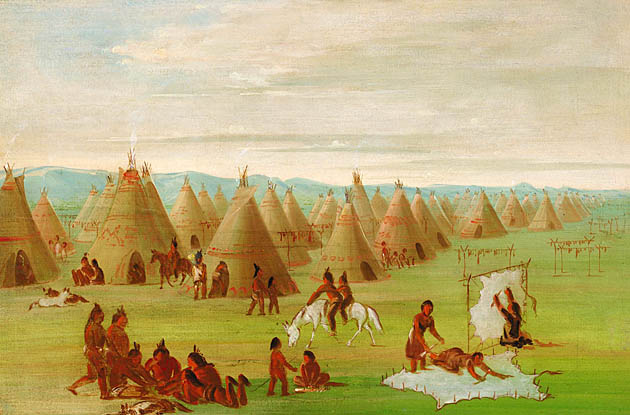
Comanche Village, Women Dressing Robes and Drying Meat: 1834
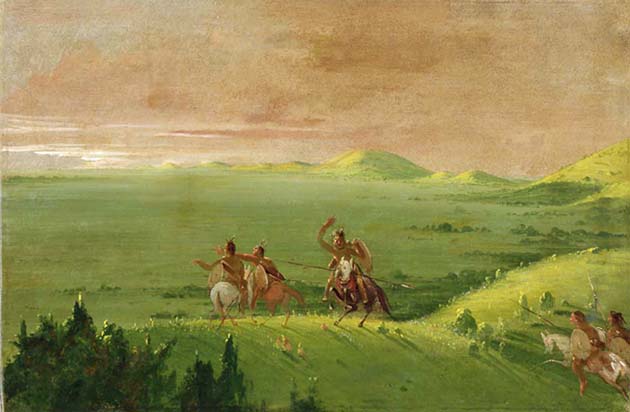
Comanche War Party, Chief Discovering the
Enemy and Urging his Men at Sunrise: 1834
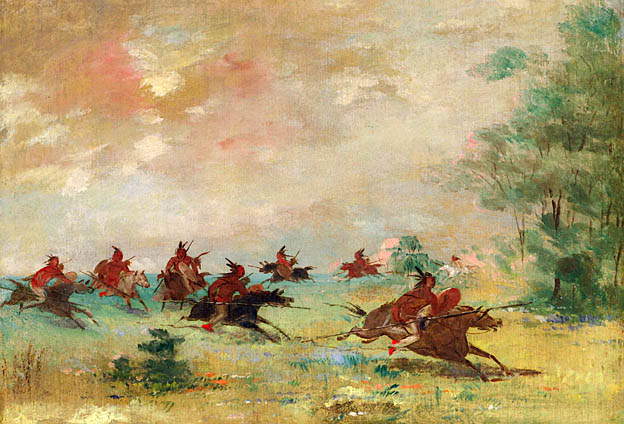
Comanche War Party, Mounted on Wild Horses: 1835
Probably painted in Catlin's studio between 1835 and 1837. The sketchy figures are unlike other examples from the dragoon expedition, and the foliage is similar to number 495.
The scene is repeated in cartoon 286, with the riders in a somewhat different formation.
Quoted From: The Catlin Collection

Comanche War Party on the March, Fully Equipped: 1847
Painted in Paris 1846-1848. In spite of Catlin's haste, the technique and palette are astonishingly delicate.
The scene is repeated in cartoon 300 (Collection of Mr. and Mrs. Paul Mellon), with the line of warriors moving in the opposite direction.
Quoted From: The Catlin Collection
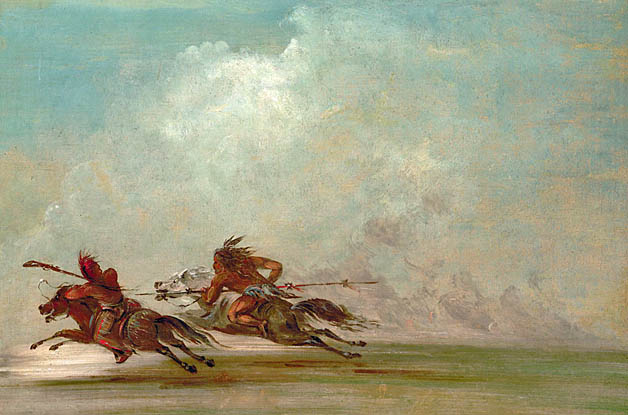
Comanche Warrior Lancing an Osage,
at Full Speed: 1838
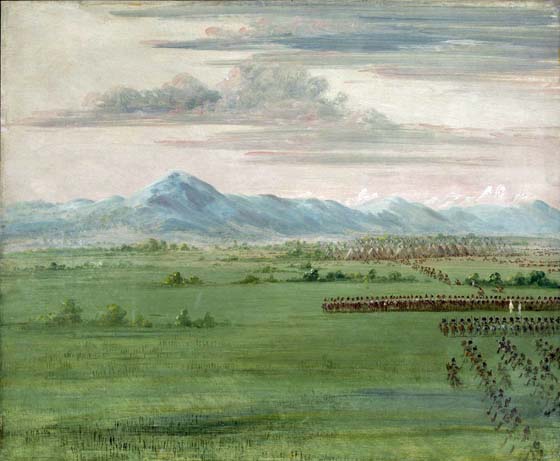
Comanche Warriors, with White Flag,
Receiving the Dragoons: 1834
"In the midst of this lovely valley, we could just discern among the scattering shrubbery that lined the banks of the watercourses, the tops of the Comanche wigwams, and the smoke curling above them. The valley, for a mile distant about the village, seemed speckled with horses and mules that were grazing in it. The chiefs of the war-party requested the regiment to halt, until they could ride in, and inform their people who were coming. We then dismounted for an hour or so; when we could see them busily running and catching their horses; and at length, several hundreds of their braves and warriors came out at full speed to welcome us, and forming in a line in front of us, as we were again mounted, presented a formidable and pleasing appearance. As they wheeled their horses, they very rapidly formed in a line, and 'dressed' like well-disciplined cavalry. The regiment was drawn up in three columns, with a line formed in front, by Colonel Dodge and his staff, in which rank my friend Chadwick and I were also paraded; when we had a fine view of the whole maneuver, which was picturesque and thrilling in the extreme" (Letters and Notes, vol. 2, p. 61, pl. 163).
Sketched in 1834 at the Comanche village. Note the dashes of pigment used to indicate the formations of dragoons and Comanche.
Catlin probably reserved his few healthy hours at the village for portraits. Landscapes of such detail must have been painted after his return to St. Louis and the East.
Quoted From: The Catlin Collection

Coo-coo-coo, The Owl,
an Aged Chief: 1836
Described by Catlin as "a very aged and emaciated chief, whom I painted at Green Bay, in Fort Howard. He had been a distinguished man, but now in his dotage, being more than 100 years old-and a great pet of the surgeon and officers of the post" (Letters and Notes, vol. II).
Painted in 1836 when Catlin stopped at Green Bay on his way to the Pipestone Quarry. Donaldson's date is incorrect. Like the Eastern Sioux and Ojibwa portraits of 1830-1836, in the Menominee series have standard dimensions, and the subjects are shown in quiet, relaxed attitudes. The careful draftsmanship of this painting is less typical of the series than the hasty contours of the numbers that follow.
The Gilcrease and Smithsonian portraits are almost identical, but the face in the latter, as befits the original, is handled with greater conviction. The Owl also appears in cartoon 18, with two young men of the tribe.
Quoted From: The Catlin Collection
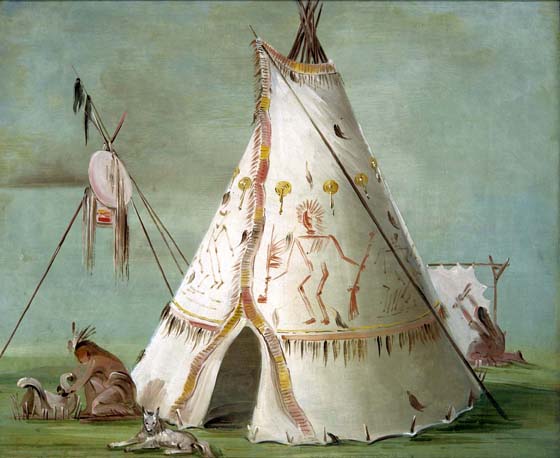
Crow Lodge of Twenty-Five Buffalo Skins: 1832
"The Crows, of all the tribes in this region … make the most beautiful lodge … they of ten times dress the skins of which they are composed almost as white as linen, and beautifully garnish them with porcupine quills, and paint and ornament them in such a variety of ways, as renders them exceedingly picturesque and agreeable to the eye. I have procured a very beautiful one of this description, highly-ornamented, and fringed with scalp-locks, and sufficiently large for forty men to dine under. The poles which support it are about thirty in number, of pine, and all cut in the Rocky Mountains, having been some hundred years, perhaps, in use. This tent, when erected, is about twenty-five feet high, and has a very pleasing effect" (Letters and Notes, vol. 1, pp. 40-44, pl. 20).
Sketched, or perhaps painted, at Fort Union in 1832. No figures appear in the Gilcrease version, and the designs on the lodge are different. The Smithsonian original matches plate 20 in Letters and Notes, and the scene is repeated in cartoon 349.
Quoted From: The Catlin Collection
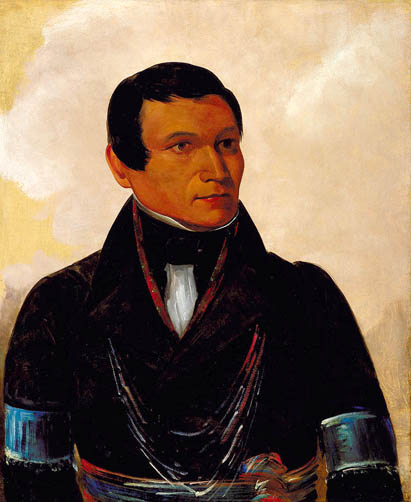
Cú-sick,
Son of the Chief: 1838
Described by Catlin as "a very talented man-has been educated for the pulpit in some one of our public institutions, and is now a Baptist preacher, and I am told a very eloquent speaker" (Letters and Notes, vol. II).
The portrait is not included in the 1837 catalogue, but does appear in the Egyptian Hall catalogue of January 1840, indicating that it may have been painted in the interval. judging from Cú-sick's dress and manner, Catlin did not necessarily encounter him on the Tuscarora reservation near Buffalo, as Donaldson and others have suggested. Cú-sick's features are modeled with a fine, light touch that one sees in Catlin's portraits of white men of the late 1830's.
The subject has no arm bands, necklaces, or sash in plate 202 of Letters and Notes. He appears again, full length, in cartoon 62.
Quoted From: The Catlin Collection
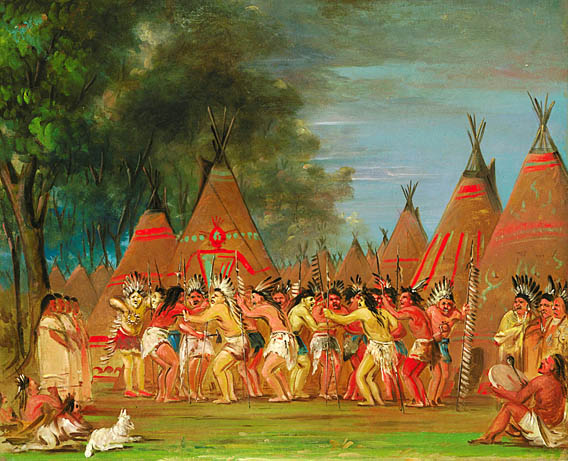
Dance of the Chiefs,
Mouth of the Teton River: 1832
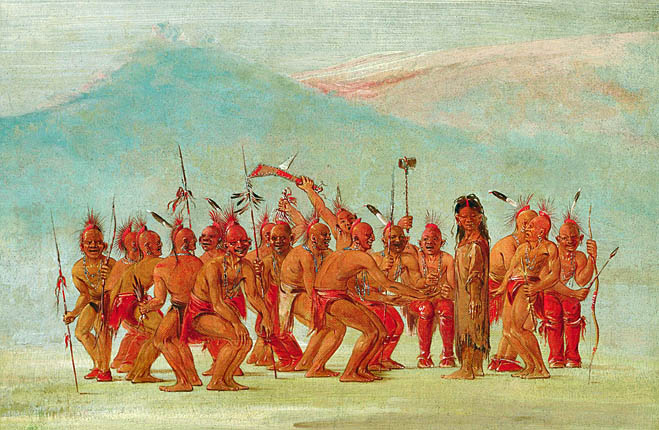
Dance to the Berdash: 1836
"Dance to the Berdashe is a very funny and amusing scene, which happens once a year or more often, as they choose, when a feast is given to the 'Berdashe,' as he is called in French … who is a man dressed in woman's clothes, as he is known to be all his life, and for extraordinary privileges which he is known to possess, he is driven to the most servile and degrading duties, which he is not allowed to escape; and he being the only one of the tribe submitting to this disgraceful degradation, is looked upon as medicine and sacred, and a feast is given to him annually" (Letters and Notes, vol. II).
Sketched at the Sauk and Fox village in 1835. The scene is repeated in cartoon 162.
Quoted From: The Catlin Collection
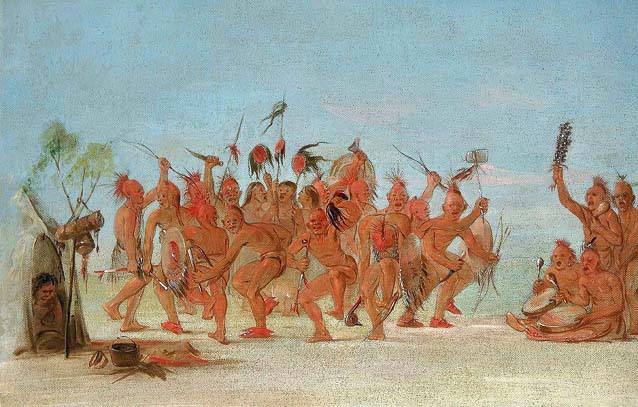
Dance to the Medicine Bag of the Brave: 1836
"This is a custom well worth recording, for the beautiful moral which is contained in it. In this plate is represented a party of Sac warriors who have returned victorious from battle, with scalps they have taken from their enemies, but having lost one of their party, they appear and dance in front of his wigwam, fifteen days in succession, about an hour on each day, when the widow hangs his medicine-bag on a green bush which she erects before her door, under which she sits and cries, while the warriors dance and brandish the scalps they have taken, and at the same time recount the deeds of bravery of their deceased comrade in arms, while they are throwing presents to the widow to heal her grief and afford her the means of a living" (Letters and Notes, vol. II).
Sketched at the Sauk and Fox village in 1835. The scene is repeated in cartoon 160.
Quoted From: The Catlin Collection
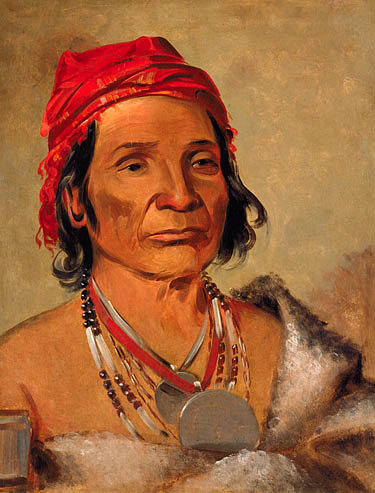
Deep Lake, an Old Chief: 1831
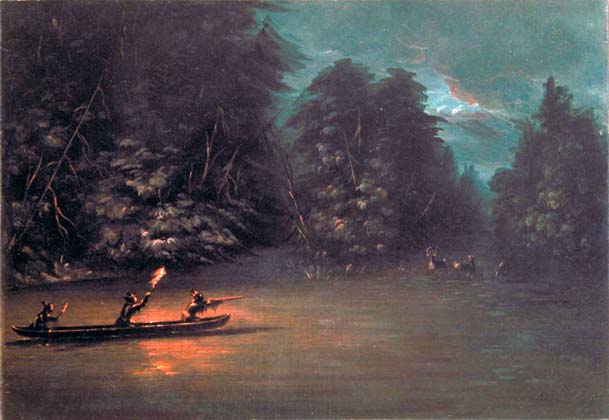
Deer Hunting by Torchlight in Bark Canoes: 1847

Discovery Dance,
Sac and Fox: 1836
"The Discovery Dance has been given here, among various others, and pleased the bystanders very much; it was exceedingly droll and picturesque, and acted out with a great deal of pantomimic effect-without music, or any other noise than the patting of their feet, which all came simultaneously on the ground, in perfect time, while they were dancing forward two or four at a time, in a skulking posture, overlooking the country, and professing to announce the approach of animals or enemies which they have discovered, by giving the signals back to the leader of the dance" (Letters and Notes, vol. II).
Sketched at the Sauk and Fox village in 1835. The scene is repeated in cartoon 167.
Quoted From: The Catlin Collection
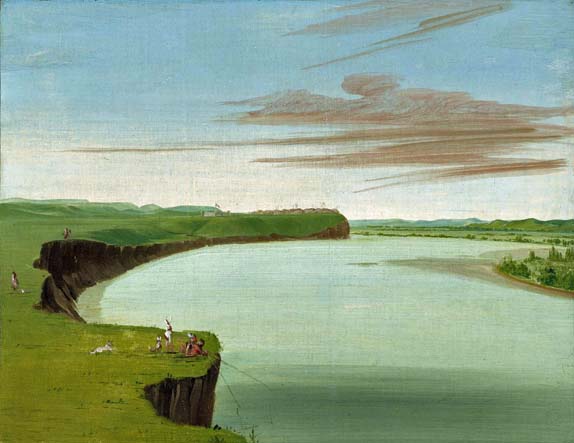
Distant View of the Mandan Village: 1832
"This tribe is at present located on the west bank of the Missouri, about 1800 miles above Saint Louis, and 200 below the Mouth of Yellow Stone river. … The site of the lower (or principal) town … is one of the most beautiful and pleasing that can be seen in the world, and even more beautiful than imagination could ever create. In the very midst of an extensive valley (embraced within a thousand graceful swells and parapets or mounds of interminable green, changing to blue, as they vanish in distance) … on an extensive plain … without tree or bush … are to be seen rising from the ground, and towards the heavens, domes-(not 'of gold,' but) of dirt-and the thousand spears (not 'spires') and scalp-poles, of the semi-subterraneous village of the hospitable and gentlemanly Mandans" (Letters and Notes, vol. I).
Fort Clark, the American Fur Company outpost, is at the left of the village.
Painted in 1832 on Catlin's Missouri River voyage. The landscape details are remarkably close to Karl Bodmer's watercolor of the Mandan village in the winter of 1830-34.
Cartoon 130 is a later edition of the Smithsonian painting, and cartoon 131 (Collection of Mr. and Mrs. Paul Mellon) is a related view.
Quoted From: The Catlin Collection
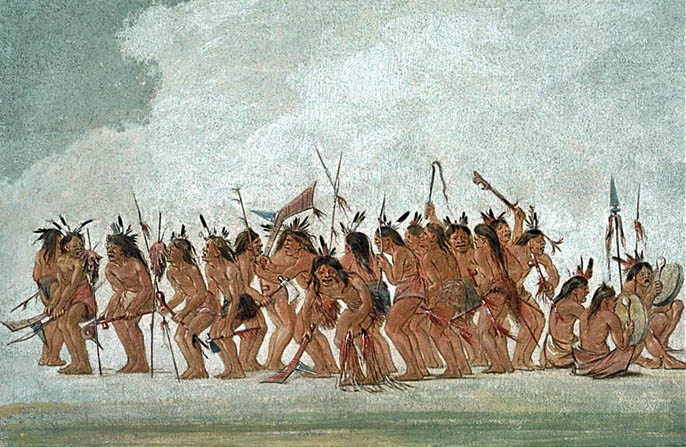
Dog Dance at Fort Snelling: 1836
Considerable preparation was made for the occasion, and the Indians informed me, that if they could get a couple of dogs that were of no use about the garrison, they would give us their favorite, the 'dog dance'. The two dogs were soon produced by the officers, and in presence of the whole assemblage of spectators, they butchered them and placed their two hearts and livers entire and uncooked, on a couple of crotches about as high as a man's face. These were then cut into strips, about an inch in width, and left hanging in this condition, with the blood and smoke upon them. A spirited dance then ensued; and, in a confused manner, every one sung forth his own deeds of bravery in ejaculatory gutturals, which were almost deafening; and they danced up, two at a time to the stakes, and after spitting several times upon the liver and hearts, caught a piece in their mouths, bit it off and swallowed it. This was all done without losing the step (which was in time to their music), or interrupting the times of their voices" (Letters and Notes, vol. 2, pp. 130-37, pl. 237).
Sketched at Fort Snelling in 1835. Most figures in Catlin's dance groups assume a similar half-crouching position that is repeated at various angles and with different gestures, as the dancers move around a loosely defined circle. The individual figures often have a fixed or static appearance, but the repetition of similar poses does generate a lively rhythm in the groups that becomes a substitute for motion. A corresponding effect may be observed in Catlin's hunting and sporting scenes.
Individual figures and ritual details are described in the dance scenes with a thinly painted, linear clarity unusual for the artist at this period. The technique is much the same throughout the series, indicating a date of execution after 1835, when Catlin saw the dances at Fort Snelling and the Sauk and Fox village. The cartoons that he began painting in the 1850s are of a somewhat similar style.
The Dog Dance is repeated in cartoon 170. Seth Eastman sketched the same dance while stationed at Fort Snelling several years later.
Quoted From: The Catlin Collection
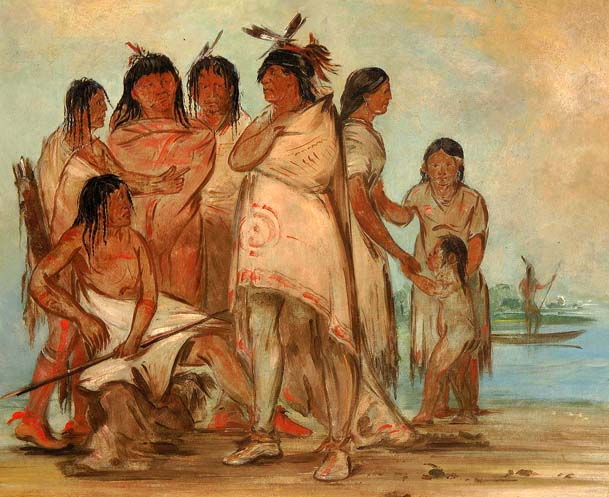
Du-cór-re-a,
Chief of the Tribe, and His Family: 1830
Probably painted at Prairie du Chien in 1830, as the size and style are noticeably different from the earlier Winnebago portraits. The chief died in 1834 so Catlin could not have seen him on one of his later visits to the Upper Mississippi.
This hastily sketched group may have been one of Catlin's first attempts at Indian portraiture in the West. Later that summer he apparently worked in the neighborhood of Fort Leavenworth, with more encouraging results.
Quoted From: The Catlin Collection
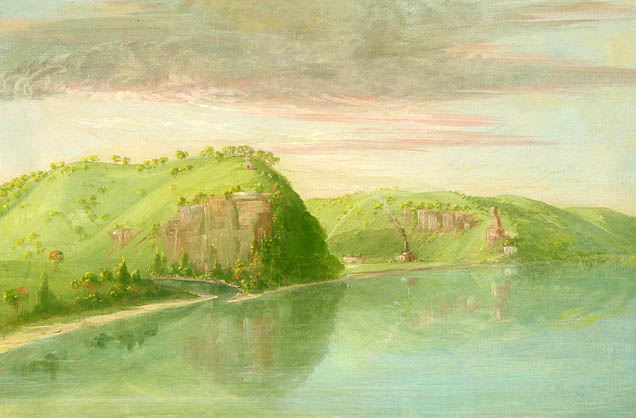
Dubuque's Grave,
Upper Mississippi: 1835

Duhk-gits-o-o-see,
Red Bear, a Distinguished Warrior: 1832

Dying Buffalo Bull in a Snowdrift: 1838
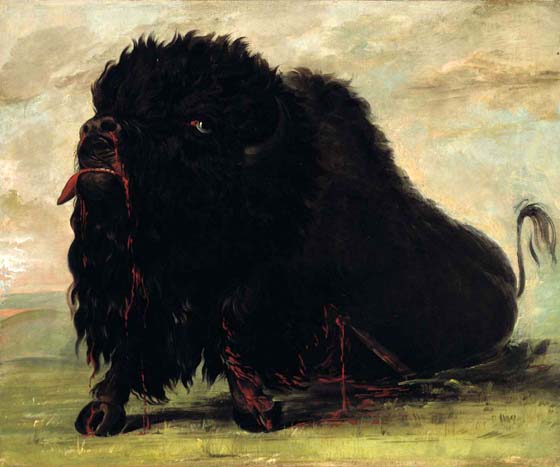
Dying Buffalo,
Shot with an Arrow: 1832

Eagle Dance, Choctaw: 1836
"The Eagle Dance, a very pretty scene … [was] got up by their young men, in honor of that bird, for which they seem to have a religious regard. This picturesque dance was given by twelve or sixteen men, whose bodies were chiefly naked and painted white, with white clay, and each one holding in his hand the tail of the eagle, while his head was also decorated with an eagle's quill. Spears were stuck in the ground, around which the dance was performed by four men at a time, who had simultaneously, at the beat of the drum, jumped up from the ground where they. had all sat in rows of four, one row immediately behind the other, and ready to take the place of the first four when they left the ground fatigued.…
"In this dance, the steps or rather jumps, were different from anything I had ever witnessed before, as the dancers were squat down, with their bodies almost to the ground, in a severe and most difficult posture, as will have been seen in the drawing" (Letters and Notes, vol. 2, pp. 120-27, pl. 227).
Sketched near Fort Gibson in 1834. The scene is repeated in cartoon 161.
In the Smithsonian Catlin collection is a Sauk and Fox or Iowa dance scene in which each Indian holds an eagle feather and wears another in his headdress. Their bodies are not painted white, however, nor is the position and arrangement of the dancers at all similar to number (this scene).
The subject was probably taken from the Eagle Dance performed by the Iowa troupe in London in 1844, and Catlin then filled in an appropriate background. Presumably the painting was destined for Louis Philippe, as an Eagle Dance appears on the list of fifteen paintings that the king commissioned from Catlin in 1845. Although the size of these is given as 30 by 36 inches, the frames may have been included in the dimensions. Even the present size is noticeably larger than the average dance or hunting scene in the 1848 catalogue, and the elaborate detail of the painting, which is much like the execution of the LaSalle series, would indicate that Catlin made a considerable effort to please the king. Except for a version of number 428, no Catlin paintings remain in the French national collections. This may mean that the group of fifteen were retrieved by the artist, along with the LaSalle series, after Louis was deposed in February 1848.
Quoted From: The Catlin Collection
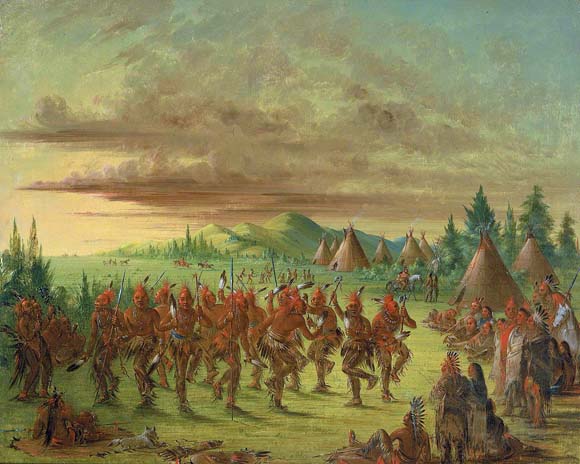
Eagle Dance: 1845

E'e-a-chin-che-a,
Red Thunder, Son of Black Moccasin: 1832
"The son of Black Moccasin … who is reputed one of the most desperate warriors of his tribe, I have also painted at full length, in his war-dress, with his bow in his hand, his quiver slung, and his shield upon his arm. In this plight, sans headdress, sans robe, and sans everything that might be an useless encumbrance-with the body chiefly naked, and profusely bedaubed with red and black paint, so as to form an almost perfect disguise, the Indian warriors invariably sally forth to war" (Letters and Notes, vol. 1, p. 187, pl. 73).
Painted at the Hidatsa village in 1832. The Gilcrease portrait is only three-quarter length, and Red Thunder's figure is weakly drawn. He appears again in cartoon 35, which is based on a watercolor (pl. 38) in the Gilcrease Souvenir album.
Quoted From: The Catlin Collection
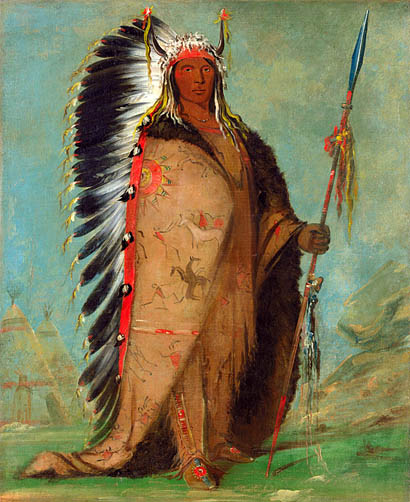
Ee-ah-sa-pa,
Black Rock, a Two Kettle Chief: 1832
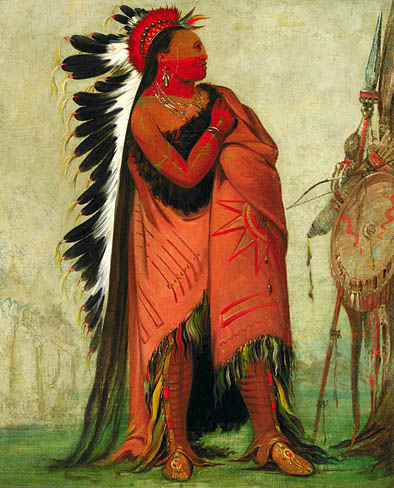
Ee-hee-a-duck-cee-a,
He Who Ties His Hair Before: 1832
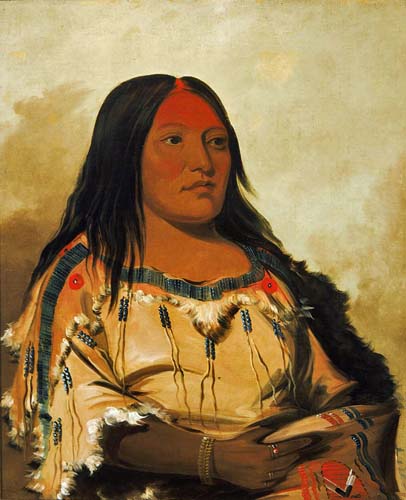
Eeh-nís-kim,
Crystal Stone, Wife of the Chief: 1832
"I have also placed upon my canvass (Crystal Stone); her countenance is rather pleasing, which is an uncommon thing among the Blackfeet her dress is made of skins, and being the youngest of a bevy of six or eight, and the last one taken under his (the chief's) guardianship, was smiled upon with great satisfaction" (Letters and Notes, vol. 1, p. 30, pl. 13).
Painted at Fort Union in 1832. Crystal Stone also appears, full length, in cartoon 39, with her husband.
Quoted From: The Catlin Collection
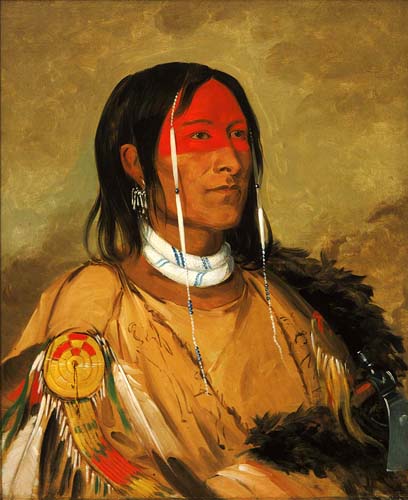
Eeh-tow-wees-ka-zeet,
He Who Has Eyes Behind Him: 1832
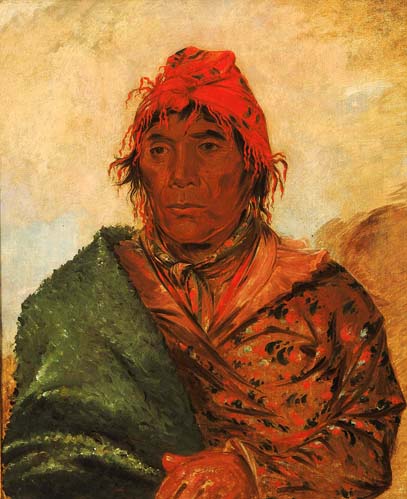
Ee-mat-la,
King Phillip, Second Chief: 1838
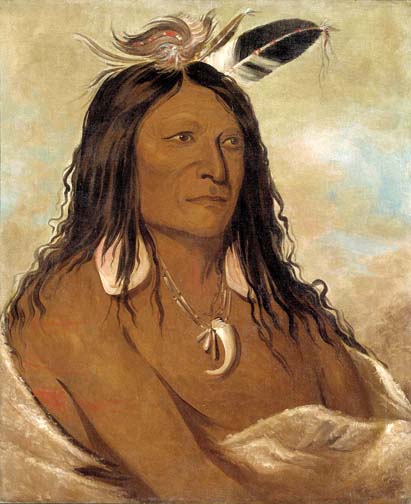
Eé-shah-kó-nee,
Bow and Quiver, First Chief of the Tribe: 1834
"A mild and pleasant looking gentleman, without anything striking or peculiar in his looks; dressed in a very humble manner, with very few ornaments upon him, and his hair carelessly falling about his face and over his shoulders. … The only ornaments to be seen about him were a couple of beautiful shells worn in his ears, and a boar's tusk attached to his neck, and worn on his breast" (Letters and Notes, vol. 2, pp. 66-67, pl. 168).
Painted at the Comanche village in 1834. The subject's right hand and forearm are included in the Gilcrease watercolor, but the handling of the facial features in the Smithsonian oil is more lively and vigorous, indicating its status as the life portrait (it also matches plate 168 in Letters and Notes). The Comanche series in the Gilcrease Institute is again based on the Smithsonian originals, and the dates Catlin used on this series (and on other Gilcrease watercolors) are no more reliable than those he arbitrarily assigned to the cartoon collection.
Bow and Quiver appears again in cartoon 43, with three Comanche warriors.
Quoted From: The Catlin Collection
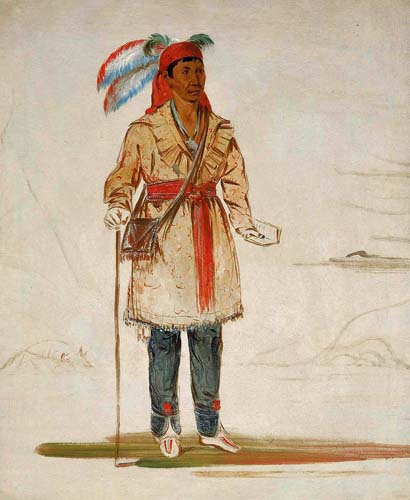
Ee-tów-o-kaum,
Both Sides of the River, Chief of the Tribe: 1836
"The chief of this tribe … which I have painted at full length, with a psalm-book in one hand, and a cane in the other, is a very shrewd and intelligent man, and a professed, and I think, sincere Christian" (Letters and Notes, vol. II).
Probably painted at Green Bay in 1836, where the Stockbridge had settled after leaving New York in 1833. Catlin records the Wisconsin location for the tribe in Letters and Notes, and the two portraits are clearly later works, resembling the Eastern Sioux and Ojibwa series. The faces and costumes are painted with thin, deft strokes that were beyond Catlin's range in 1830, the date suggested by Donaldson and others for Catlin's visit to the tribe.
The portraits are not listed in the 1837 catalogue, perhaps because they were not sufficiently finished at the time. The subject appears again in cartoon 57, with another civilized Mohegan, and in cartoon 64, which is apparently mislabeled.
Quoted From: The Catlin Collection
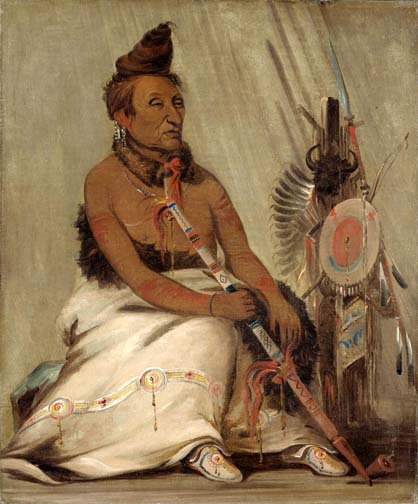
Eh-toh'k-pah-she-pee-shah,
Black Moccasin: 1832
"The chief sachem of this tribe is a very ancient and patriarchal looking man … and counts, undoubtedly, more than an hundred snows. I have been for some days an inmate of his hospitable lodge, where he sits tottering with age, and silently reigns sole monarch of his little community around him, who are continually dropping in to cheer his sinking energies, and render him their homage. His voice and his sight are nearly gone; but the gestures of his hands are yet energetic and youthful, and freely speak the language of his kind heart."
"I have … painted his portrait as he was seated on the floor of his wigwam, smoking his pipe, while he was recounting over to me some of the extraordinary feats of his life, with a beautiful Crow robe wrapped around him, and his hair wound up in a conical form upon his head, and fastened with a small wooden pin, to keep it in its place."
"This man has many distinct recollections of Lewis and Clark, who were the first explorers of this country, and who crossed the Rocky Mountains thirty years ago" (Letters and Notes, vol. 1, pp. 186-87, pl. 72).
Painted at the Hidatsa village in 1832. The sightless attention of Black Moccasin's ancient head, and the shriveled body that supports it, are portrayed by Catlin with a deep sympathy for the chief's age and position. Although the artist committed his usual anatomical indiscretions in the process, Matthews says that the portrait was easily recognized by Black Moccasin's descendants.
The Smithsonian and Gilcrease oils, and plate 72 in Letters and Notes, are almost identical; but the post on which the arms and ornaments hang has been left out of the Gilcrease watercolor, and the torso and blanket are badly drawn.
Quoted From: The Catlin Collection
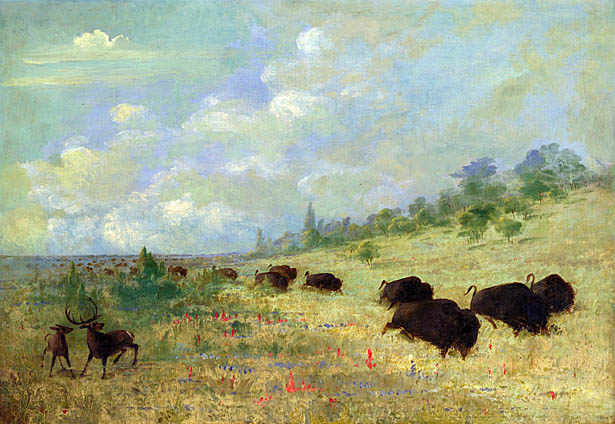
Elk and Buffalo Grazing among Prairie Flowers, Texas: 1847
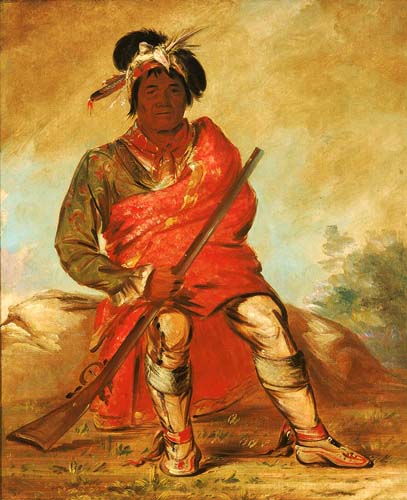
Eteh-ée-fix-e-co,
Deer Without a Heart, a Chief: 1883
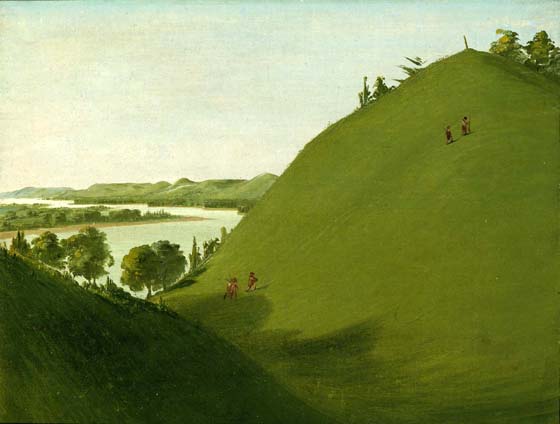
Floyd's Grave, Where Lewis and Clark
Buried Sergeant Floyd in 1804: 1832
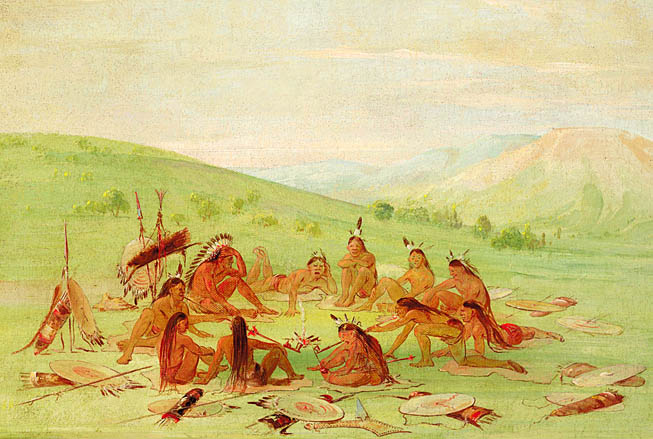
Foot War Party in Council, Mandan: 1836
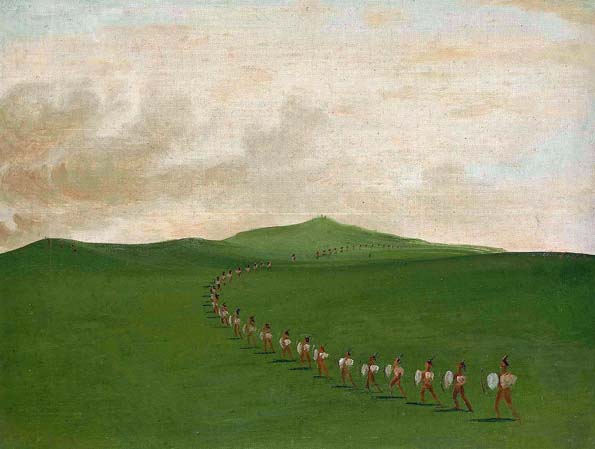
Foot War Party on the March,
Upper Missouri: 1832
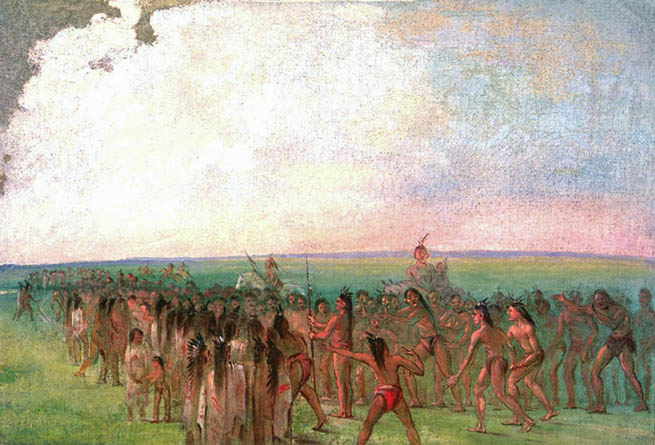
Footrace behind the Mandan Village: 1832
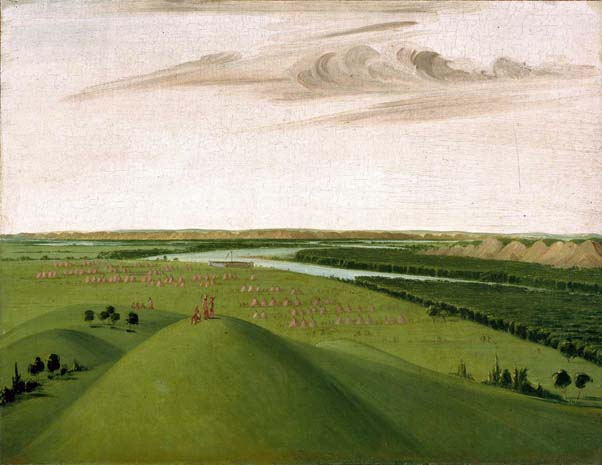
Fort Union, Mouth of the Yellowstone River,
2000 Miles above Saint Louis: 1832
Indians would lose their lands. "The mouth of the Platte is a beautiful scene, and no doubt will be the site of a large and flourishing town, soon after Indian titles shall have been extinguished to the lands in these regions, which will be done within a very few years. The Platte is a long and powerful stream, pouring in from the Rocky Mountains and joining with the Missouri at this place."
Source: Letters and Notes, Letter No. 32.
Quoted From: Campfire Stories with George Catlin
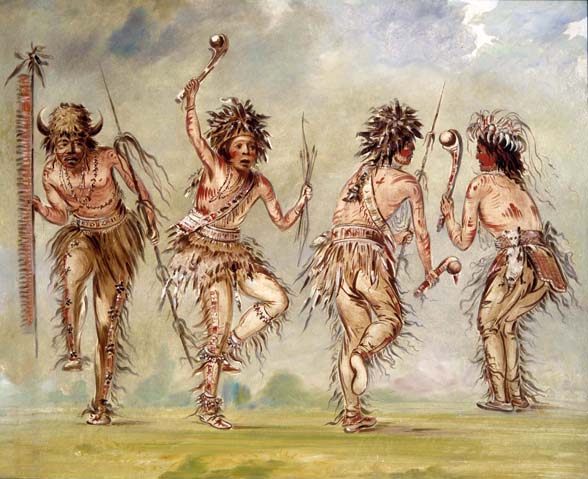
Four Dancers: 1843
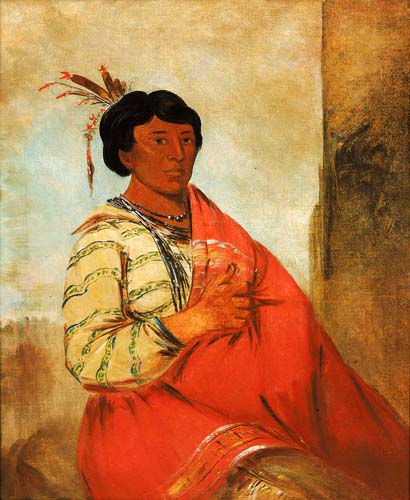
Gaw-zaw-que-dung,
He Who Halloes: 1836

Go-to-kow-pah-ah,
Stands by Himself, a Distinguished Brave: 1830
The subject is described by Catlin as having an "intelligent European head", and holding a hatchet in his hand (Letters and Notes, vol. II).
Probably painted at Fort Leavenworth in 1830 (records of the Bureau of Indian Affairs show that the subject was living west of the Mississippi by that year). Donaldson suggests the right location but wrong date. The broad sweeps of pigment are close to the technique Catlin used in the Potawatomi and Kickapoo portraits.
The subject is bust length in the Gilcrease watercolor, and his features have a somewhat different appearance than in the Smithsonian original, which matches plate 187 in Letters and Notes. He appears again, full length, in cartoon 66 , with a Wea warrior and a woman.
Quoted From: The Catlin Collection
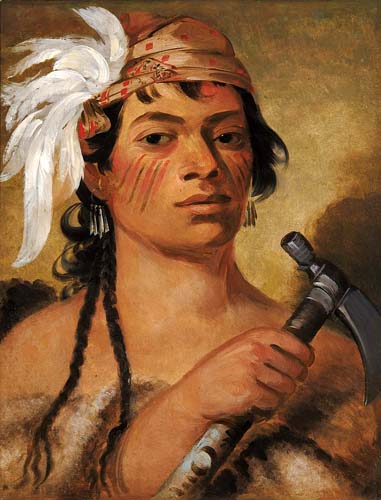
Good Hunter, a Warrior: 1831
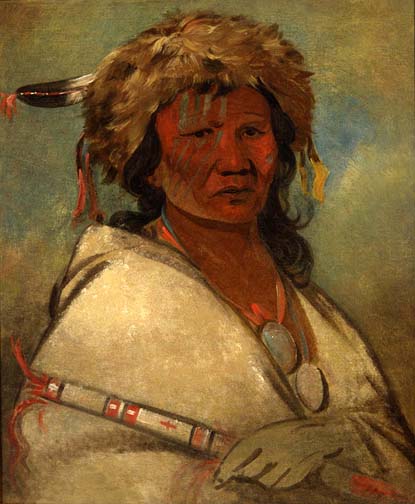
Great Hero, a Chief: 1845
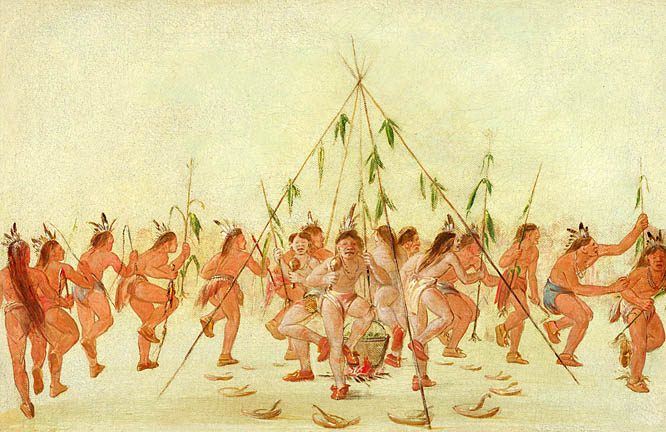
Green Corn Dance,
Hidatsa: 1836
"On the day appointed by the doctors, the villagers are all assembled, and in the midst of the group a kettle is hung over a fire and filled with the green corn, which is well boiled, to be given to the Great Spirit, as a sacrifice necessary to be made before anyone can indulge the cravings of his appetite. While this first kettleful is boiling, four medicine-men, with a stalk of the corn in one hand and a rattle … in the other, with their bodies painted with white clay, dance around the kettle, chanting a song of thanksgiving to the Great Spirit to whom the offering is to be made. At the same time a number of warriors are dancing around in a more extended circle, with stalks of the corn in their hands, and joining also in the song of thanksgiving, while the villagers are all assembled and looking on. During this scene there is an arrangement of wooden bowls laid upon the ground, in which the feast is to be dealt out, each one having in it a spoon made of the buffalo or mountain-sheep's horn."
"In this wise the dance continues until the doctors decide that the corn is sufficiently boiled; it then stops for a few moments, and again assumes a different form and a different song, while the doctors are placing the ears on a little scaffold of sticks, which they erect immediately over the fire where it is entirely consumed, as they join again in the dance around it" (Letters and Notes, vol. 1, p. 189, pl. 75).
A faint drawing of the dance, made during Catlin's visit to the Hidatsa village in 1832, appears in the SI sketchbook. The scene is repeated in cartoon 168.
Quoted From: The Catlin Collection

Grizzly Bears Attacking Indians on Horseback: 1832
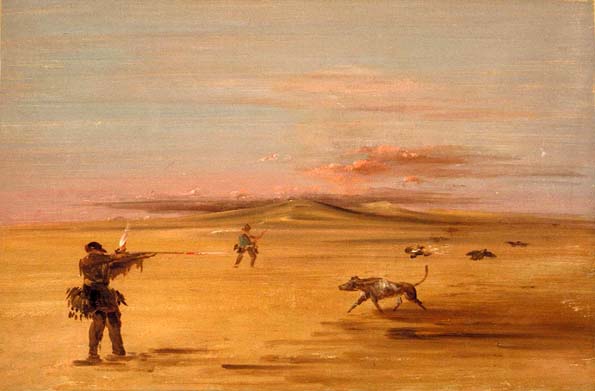
Grouse Shooting on the Missouri Prairies: 1838
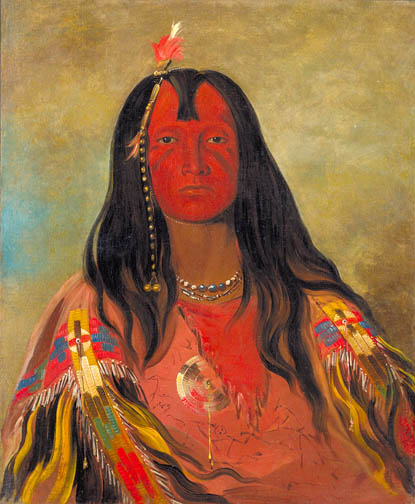
H'co-a-h'co-a-h'cotes-min,
No Horns on His Head, a Brave: 1832
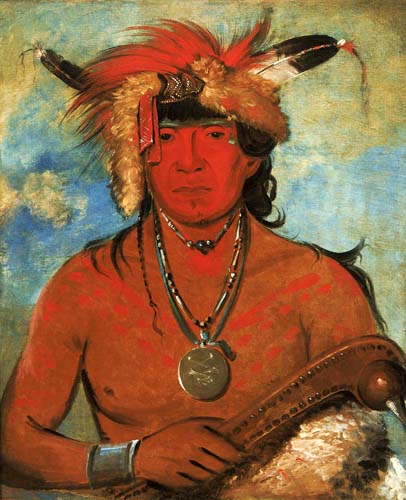
Hah-je-day-ah'-shee,
Meeting Birds, a Brave: 1835
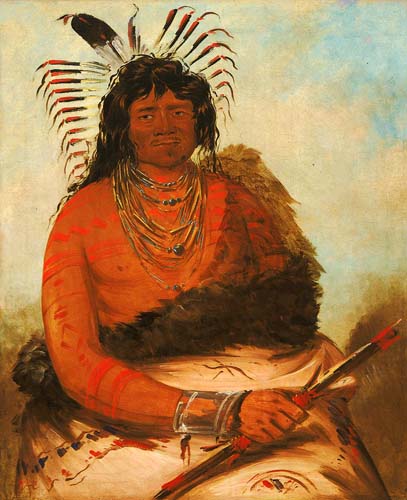
Háh-nee,
The Beaver, a Warrior: 1834
Catlin describes The Beaver as "a warrior of terrible aspect, and also of considerable distinction" (Letters and Notes, vol. 2, p. 68).
Painted at the Comanche village in 1834. The Beaver is shown bust length in the Gilcrease watercolor, and wears different jewelry and fewer feathers in his headdress. He appears again in cartoon 43, in a different pose and costume.
Quoted From: The Catlin Collection
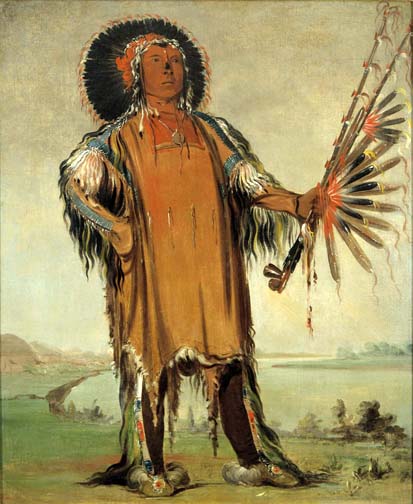
Ha-na-tá-nu-maúk,
Wolf Chief, Head Chief of the Tribe: 1832
"This man is head-chief of the nation, and familiarly known by the name of 'Chef de Loup' as the French Traders call him; a haughty, austere, and overbearing man, respected and feared by his people rather than loved. The tenure by which this man holds his of ice, is that by which head-chief s of most of the tribes claim, that of inheritance. The dress of the chief was one of great extravagance, and some beauty; manufactured of skins, and a great number of quills of the raven, forming his stylish head-dress". (Letters and Notes, vol. I).
Painted at the Mandan village in 1832. The Smithsonian portrait and plate 49 in Letters and Notes have in the background a Missouri River landscape, but two Mandan earth lodges are behind Wolf Chief in the Field Museum version.
The subject appears again in cartoon 33, with his wife and child. The cartoon is based on a watercolor (pl. 4) in the Gilcrease Souvenir album.
Quoted From: The Catlin Collection
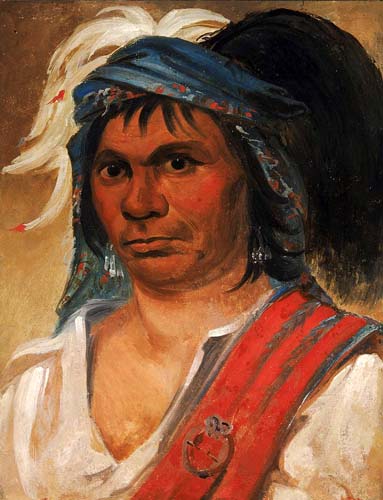
Hard Hickory, an Amiable Man: 1831

Há-tchoo-túc-knee,
Snapping Turtle, a Half-breed: 1834
Described by Catlin as "a distinguished and very gentlemanly man, who has been well-educated, and who gave me much curious and valuable information, of the history and traditions of his tribe" (Letters and Notes, vol. 2, p. 123, pl. 222).
Painted at Fort Gibson in 1834. The facial features in the Gilcrease watercolor appear too stiff and finished beside the Smithsonian original. Both portraits match plate 222 of Letters and Notes.
Charles Dickens, who had probably seen Catlin's Indian Gallery in London, recalls meeting Snapping Turtle in this country in 1842. The Indian praised Catlin's work and remarked to Dickens that his own portrait was in the collection. Snapping Turtle also appears, full length, in cartoon 65.
Quoted From: The Catlin Collection

Háw-che-ke-súg-ga,
He Who Kills the Osages, Chief of the Tribe: 1832
The subject is described as "an old man" with a "necklace of grisly bears' claws, and a handsome carved pipe in his hand" (1848 catalogue, p. 18).
Probably painted at Fort Leavenworth in 1832. The subject later sat to Charles Bird King in Washington, and he also appears, full length, in cartoon 22.
Quoted From: The Catlin Collection
![]()
Ha-wón-je-tah,
One Horn, Head Chief of the Miniconjou Tribe: 1832
"Among the Sioux encamped at Fort Pierre there were twenty or more of the different bands, each one with their chief at their head. One Horn was a middle-aged man, of middling stature, with a noble countenance, and a figure almost equaling the Apollo, and I painted his portrait. He has risen rapidly to the highest honors in the tribe, from his own extraordinary merits, even at so early an age. He told me he took the name of 'One Horn' (or shell) from a simple small shell that was hanging on his neck, which descended to him from his father, and which, he said, he valued more than anything he possessed; affording a striking instance of the living affection which these people often cherish for the dead. His costume was a very handsome one, and will have a place in my Indian Gallery by the side of his picture. It is made of elk skins beautifully dressed, and fringed with a profusion of porcupine quills and scalp-locks; and his hair, which is very long and profuse, divided into two parts, and lifted up and crossed, over the top of his head, with a simple tie, giving it somewhat the appearance of a Turkish turban."
"This extraordinary man, before he was raised to the dignity of chief, was the renowned of his tribe for his athletic achievements. In the chase he was foremost; he could run down a buffalo, which he often had done, on his own legs, and drive his arrow to the heart. He was the fleetest in the tribe; and in the races he had run, he had always taken the prize."
"It was proverbial in his tribe, that Ha-won-je-tah's bow never was drawn in vain, and his wigwam was abundantly furnished with scalps that he had taken from his enemies' heads in battle" (Letters and Notes, vol. I).
Among the first portraits painted by Catlin on his upriver voyage in 1832 were those of the Sioux encamped at Fort Pierre. This series and the others that followed on the Upper Missouri reveal an increasingly controlled brush and a bolder definition of contour than Catlin had attempted in 1830. The solid and imposing appearance of One Horn became, in essence, the formula for the great portraits of that summer and fall.
The Smithsonian and Field Museum portraits are much alike and both match plate 86 in Letters and Notes. Catlin perhaps took more pains with the version of One Horn than any of the others he painted for O'Fallon. Even so, the fine fringe detail of the triangular neck piece is missing, and the subject's right ear is attached at an awkward angle. A more conclusive indication of the original, however, can be seen in the superior modeling about the cheek and eyes of One Horn in the Smithsonian portrait.
The chief also appears, seated, in cartoon 9, with his wife and child, another Sioux chief, and a counselor.
Quoted From: The Catlin Collection
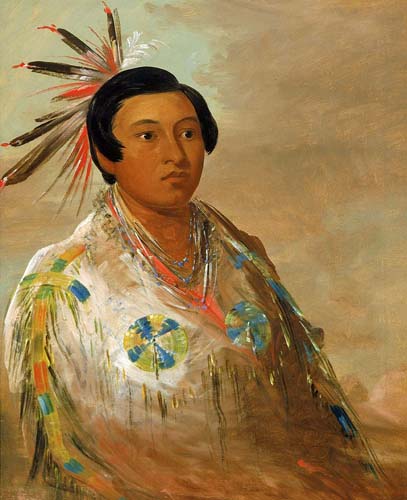
Hee-doh'ge-ats,
a Young Man: 1838
Described by Catlin as a "Chinook boy, of fifteen or eighteen years of age" whose head had never been flattened (Letters and Notes, vol. 2, p. 110, pl. 209).
The feather headdress has been omitted and the subject is wrapped in a blanket in both the Gilcrease portrait and plate 209 of Letters and Notes. He wears a Plains Indian shirt in the Smithsonian original, which Catlin may have later recognized as an inconsistency.
The subject appears full length in cartoon 92, again wrapped in a blanket. His true identity is probably anyone's guess, although a Chinook boy of similar appearance is illustrated in McKenney and Hall (vol. 2, p. 276). This boy (or young man), whose name was Stumanu, toured Atlantic Coast cities in 1838 and 1839 to help raise funds for an Oregon mission.
Quoted From: The Catlin Collection
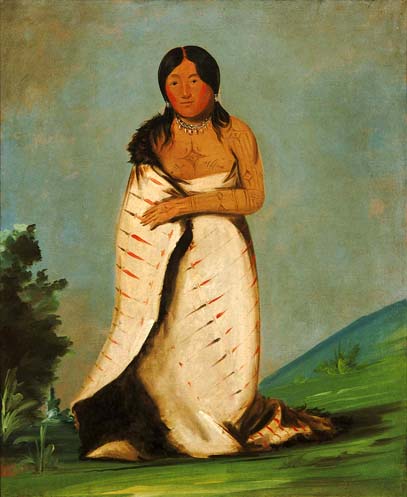
Hee-láh-dee,
Pure Fountain, Wife of The Smoke: 1832
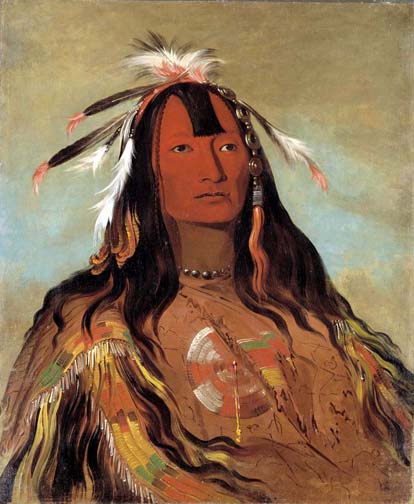
Hee-oh'ks-te-kin,
Rabbit's Skin Leggings: 1832
Catlin's wonderfully composed images of these Nez Perce braves were probably painted in Saint Louis, when a Native American delegation passed through that city. Catlin had befriended General William Clark, of Lewis and Clark Expedition fame, in Saint Louis. In addition to documenting his own extensive expeditions, Catlin sketched and painted Native Americans who visited Clark in his office. The dignified bearing of the young men and the attention to detail in the elaborately beaded tunics and beaded and feathered hair suggest that Catlin was impressed with his subjects. Native Americans, he wrote, were "the finest models in all Nature, unmasked and moving in all their grace and beauty."
The unfocussed gaze of these dignified braves rests at a point somewhere outside the canvas. Catlin's faithful effort to document the life of these peoples in the early nineteenth century captures those impressive cultures as they were before their world was shattered.
Quoted From: The Catlin Collection
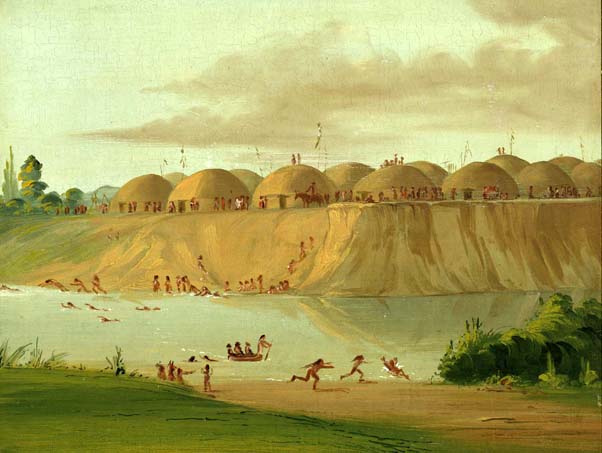
Hidatsa Village,
Earth-Covered Lodges, on the Knife River: 1832
"The principal village of the Minatarees (Hidatsa) which is built upon the bank of the Knife river, contains forty or fifty earth-covered wigwams, from forty to fifty feet in diameter, and being elevated, overlooks the other two, which are on lower ground and almost lost amidst their numerous corn fields and other profuse vegetation which cover the earth with their luxuriant growth."
"The scenery along the banks of this little river, from village to village, is quite peculiar and curious; rendered extremely so by the continual wild and garrulous groups of men, women, and children, who are wending their way along its winding shores, or dashing and plunging through its blue waves, enjoying the luxury of swimming, of which both sexes seem to be passionately fond. Others are paddling about in their tub-like canoes, made of the skins of buffaloes" (Letters and Notes, vol. 1, p. 186, pl. 70).
Painted in 1832 on Catlin's Missouri River voyage. The Gilcrease version and the Smithsonian original both match plate 70 in Letters and Notes. The scene is repeated in cartoon 136 (Collection of Mr. and Mrs. Paul Mellon).
Quoted From: The Catlin Collection
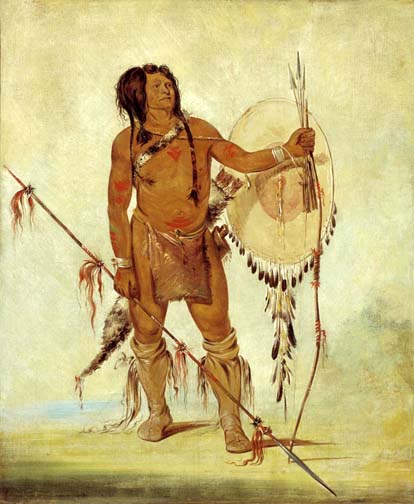
His-oo-sán-chees,
Little Spaniard, a Warrior
"A gallant little fellow … represented to us as one of the leading warriors of the tribe; and no doubt … one of the most extraordinary men at present living in these regions. He is half Spanish, and being a half-breed, for whom they generally have the most contemptuous feelings, he has been all his life thrown into the front of battle and danger; at which posts he has signalized himself, and commanded the highest admiration and respect of the tribe for his daring and adventurous career. This is the man of whom I have before spoken, who dashed out so boldly from the war-party, and came to us with the white flag raised on the point of his lance. … I have here represented him as he stood for me, with his shield on his arm, with his quiver slung, and his lance of fourteen feet in length in his right hand. This extraordinary little man, whose figure was light, seemed to be all bone and muscle, and exhibited immense power, by the curve of the bones in his legs and his arms. We had many exhibitions of his extraordinary strength, as well as agility; and of his gentlemanly politeness and friendship we had as frequent evidences" (Letters and Notes, vol. 2, pp. 67-68, pl. 172).
Painted at the Comanche village in 1834. Landscape details have been added to the Gilcrease watercolor; otherwise, it is identical to plate 172 of Letters and Notes and the Smithsonian portrait. The latter is one of Catlin's most skillfully articulated full-length figures, and the powerful curve of Little Spaniard's legs and torso does indeed suggest great physical energy.
The Yale painting is a weak version of the cartoon figure (see cartoon 42), which in turn is based on a watercolor (pl. 40) in the Gilcrease Souvenir album.
Quoted From: The Catlin Collection
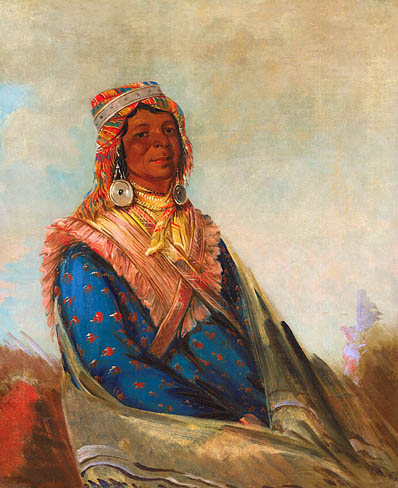
Hol-te-mal-te-tez-te-neek-ee,
Sam Perryman: 1834
Catlin also describes the subject as "a jolly companionable man" (1848 catalogue, p. 31).
Painted at Fort Gibson in 1834. Catlin records Sam Perryman's round and mellow features with an appealing insight.
Donaldson incorrectly labels the subject in plate 57. The Gilcrease watercolor is a careful version of the Smithsonian original, and Perryman supposedly appears again in cartoon 64, but instead the Smithsonian portrait matches a figure in an unidentified cartoon.
Quoted From: The Catlin Collection
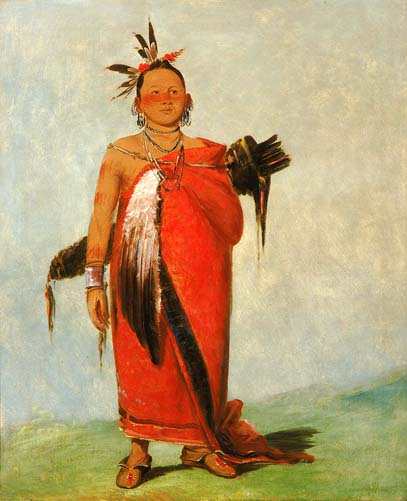
Hongs-káy-dee,
Great Chief, Son of The Smoke: 1832
Catlin describes Great Chief as “a youth of eighteen years … [who] distinguished himself in a singular manner the day before our steamer reached their village, by taking to him four wives in one day! This extraordinary and unprecedented freak of his, was just the thing to make him the greatest sort of medicine in the eyes of his people; and probably he may date much of his success and greatness through life, to this bold and original step, which suddenly raised him into notice and importance” (Letters and Notes, vol. 1, pp. 213–15, pl. 90).
Painted at the Ponca village in 1832. the quiver has been omitted in plate 90 of Letters and Notes.
The Peabody version is a repetition of the figure of Great Chief from cartoon 54, in which he appears with his mother and a wife. The cartoon is based on a watercolor (pl. 8) in the Gilcrease Souvenir album, and an oil-on-canvas version of the composition is in the Museum für Völkerkunde, Berlin.
Quoted From: The Catlin Collection
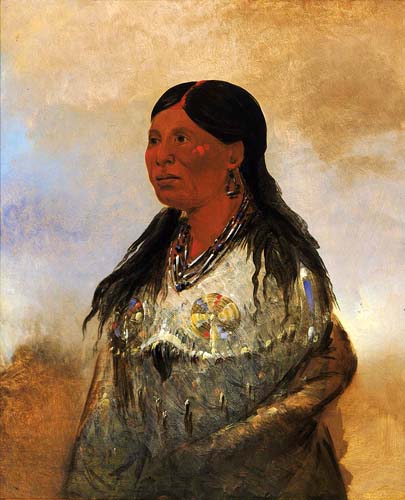
Hon-je-a-put-o,
Wife of Bear-Catcher: 1832
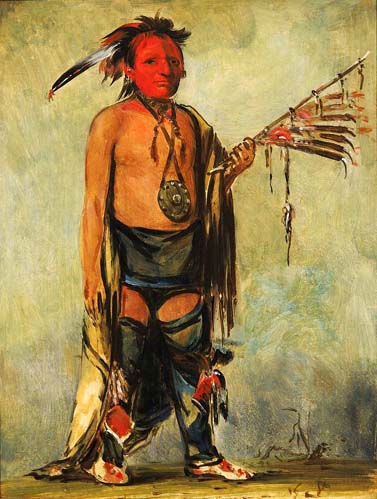
Hoo-w'a-ne-kaw,
Little Elk: 1828
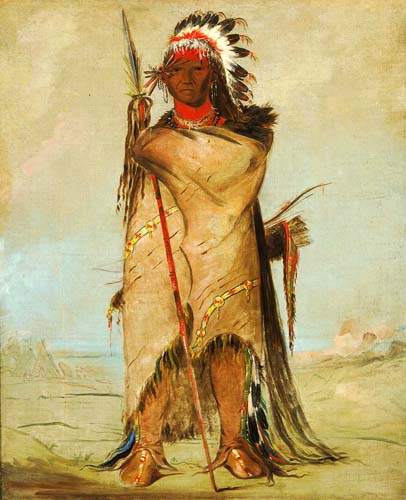
Hó-ra-tó-a,
a Brave: 1832
Described by Catlin as "a brave, wrapped in his robe, and his hair reaching to the ground; his spear in his hand, and bow and quiver slung" (1848 catalogue, p. 22).
Painted at Fort Union in 1832. The subject also appears in Cartoon 27 (NGA 1978) in a different costume.
Quoted From: The Catlin Collection
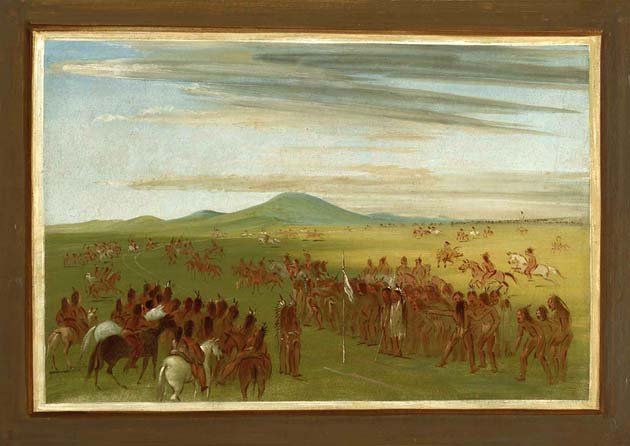
Horseracing on a Course Behind the Mandan Village: 1832
"Horse-racing here, as in all more enlightened communities, is one of the most exciting amusements, and one of the most extravagant modes of gambling."
"I have been this day a spectator … on a course which they have, just back of their village; and although I never had the least taste for this cruel amusement in my own country, yet, I must say, I have been not a little amused and pleased with the thrilling effect which these exciting scenes have produced among so wild and picturesque a group."
"I have made a sketch of the ground and the group, as near as I could; showing the manner of 'starting' and 'coming out,' which vary a little from the customs of the knowing world; but in other respects, I believe a horse-race is the same all the world over" (Letters and Notes, vol. I).
Sketched at the Mandan village in 1832. The scene is repeated in cartoon 179.
Quoted From: The Catlin Collection

Hose-put-o-káw-gee,
a Brave: 1834
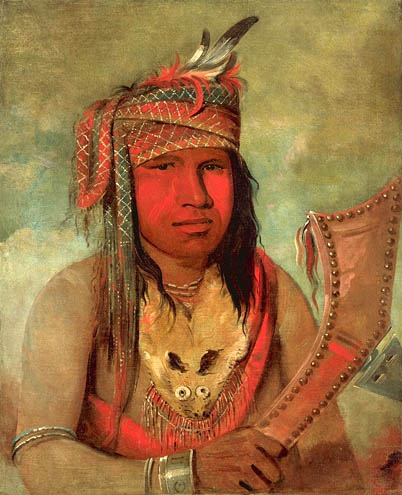
I-an-be-w'ah-dick,
Male Caribou, a Brave: 1836
_Dressing_Skins-Red_River_1847.jpg)
Indian Encampment, Comanche (or Kiowa)
Dressing Skins, Red River: 1847
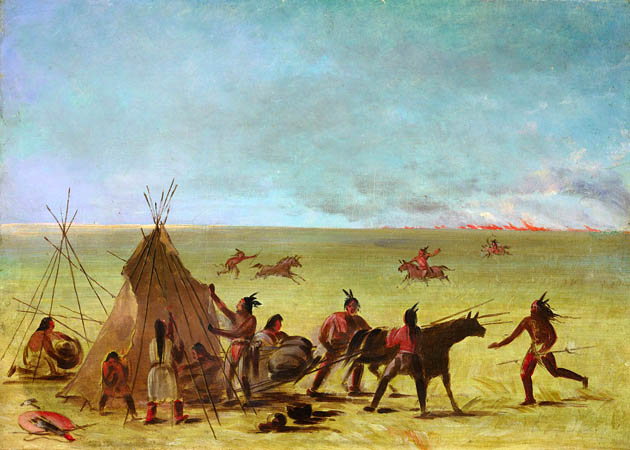
Indian Family Alarmed at the
Approach of a Prairie Fire: 1847
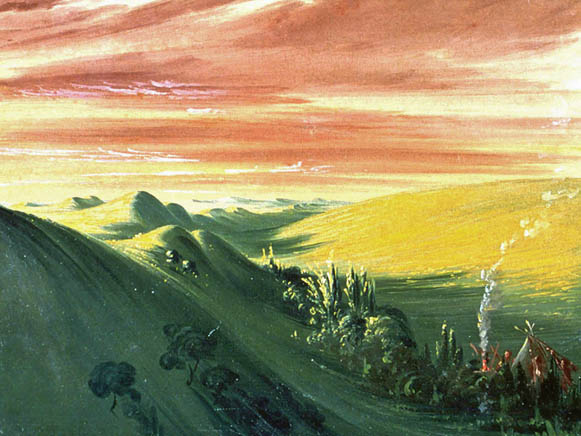
Indians Encamping at Sunset,
Upper Missouri: 1832

In-ne-ó-cose,
Buffalo's Child, a Warrior
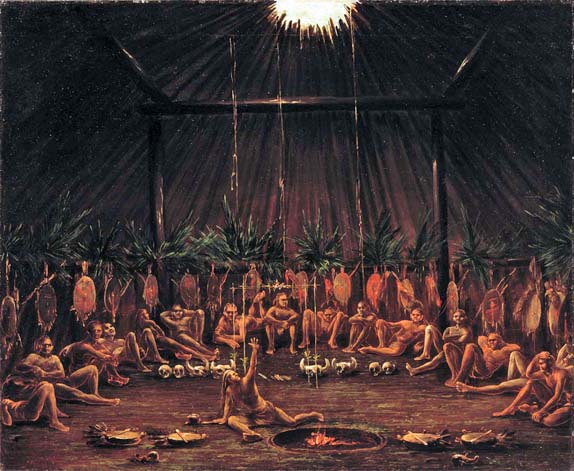
Interior View of the Medicine Lodge,
Mandan O-kee-pa Ceremony: 1832
"'Now we have it!' (exclaimed my host …) the grand ceremony has commenced. … I seized my sketch-book, and all hand of us were in an instant in front of the medicine-lodge, ready to see and hear all that was to take place. … There were on this occasion about fifty young men who entered the lists, and as they went into the sacred lodge, each one's body was chiefly naked, and covered with clay of different colors; some were red, others were yellow, and some were covered with white clay, giving them the appearance of white men. Each one of them carried in his right hand his medicine-bag-on his left arm, his shield of bull's hide-in his left hand, his bow and arrows, with his quiver slung on his back."
"When all had entered the lodge, they placed themselves in reclining postures around its sides, and each one had suspended over his head his respective weapons and medicine, presenting altogether, one of the most wild and picturesque scenes imaginable … the medicine or mystery-man … was left sole conductor and keeper; and according to those injunctions, it was his duty to lie by a small fire in the centre of the lodge, with his medicine-pipe in his hand, crying to the Great Spirit incessantly, watching the young men, and preventing entirely their escape from the lodge, and all communication whatever with people outside, for the space of four days and nights, during which time they were not allowed to eat, to drink, or to sleep, preparatory to the excruciating self-tortures which they were to endure on the fourth day."
"I mentioned that I had made four paintings of these strange scenes, and the first one exhibits the interior of the medicine-lodge at this moment, with the young men all reclining around its sides, and the conductor or mystery-man lying by the fire, crying to the Great Spirit. It was just at this juncture that I was ushered into this sacred temple of their worship, with my companions, which was undoubtedly, the first time that their devotions had ever been trespassed upon by the presence of pale faces … we returned every morning at sunrise, and remained until sun-down for four days, the whole time which these strange scenes occupied."
"In addition to the preparations and arrangements of the interior of this sanctuary, as above described, there was a curious, though a very strict arrangement of buffalo and human skulls placed on the floor of the lodge, and between them (which were divided into two parcels), and in front of the reclining group of young candidates was a small and very delicate scaffold."
"Immediately under the little frame or scaffold … on the floor of the lodge was placed a knife, and by the side of it a bundle of splints or skewers, which were kept in readiness for the infliction of the cruelties directly to be explained. There were seen also, in this stage of the affair, a number of cords of rawhide hanging down from the top of the lodge, and passing through its roof, with which the young men were to be suspended by the splints passed through their flesh, and drawn up by men placed on the top of the lodge for the purpose" (Letters and Notes, vol. I).
Catlin was not the first white man to witness this major religious ceremony of the Mandan, but he was the first to make a pictorial record of the annual event. Fortunately, it began about a week after his arrival at the Mandan village, and through his own "medicine" power as a portrait painter, he gained admission to the secret lodge. the O-kee-pa ceremony was toh a gruesome test of manhood and a fertility rite that was almost unknown to the public before Catlin's letter of August 5 to the New York Commercial Advertiser and the subsequent long chapter in Letters and Notes, published some nine years later. His voluminous notes on the Mandan and these four scenes from the O-kee-pa ceremony have proven to be his most valuable ethnological contribution, although during his lifetime several prominent scholars challenged their accuracy, who discusses the history of the ceremony and all aspects of the controversy). This led to the publication in 1867 of an illustrated book (O-Kee-Pa, a Religious Ceremony and other Customs of the Mandans), in which Catlin described the self-torture and dance scenes in even greater detail, and included an appendix with testimonials from others who had witnessed the event. Unhappily, however, the book was not widely distributed, and Catlin became convinced that the doubt cast upon his scholarship finally prevented the sale of his collection to the government.
Two sets of paintings of the ceremony are presently known, one of which was executed at the Mandan village in 1832, according to Catlin's account in Letters and Notes (vol. I).
"I took my sketch-book with me, and have made many and faithful drawings of what we saw, and full notes of everything as translated to me by the interpreter; and since the close of that horrid and frightful scene, which was a week ago or more, I have been closely ensconced in an earth-covered wigwam, with a fine sky-light over my head, with my palette and brushes, endeavoring faithfully to put the whole of what we saw upon canvass, which my companions all agree to be critically correct, and of the fidelity of which they have attached their certificates to the backs of the paintings. I have made four paintings of these strange scenes, containing several hundred figures, representing the transactions of each day; and if I live to get them home, they will be found to be exceedingly curious and interesting."
Catlin did get these four paintings home (if we can trust the above passage) and then to London, where they were claimed by Joseph Harrison, along with the rest of the original collection, in 1852. After Harrison's death, however, the four paintings and several other Catlin duplicates were separated from the Smithsonian gift, and sold to John Wanamaker in Philadelphia, who eventually gave them to the University Museum, where they remained until 1971. This set appears to have been painted under the conditions Catlin describes in Letters and Notes. The figures in the dance scenes are either unfinished or roughly sketched, and those in the medicine lodge are only slightly more composed. The same abrupt and incomplete treatment has been given the architectural details in the four scenes. Nevertheless, as the first set of paintings taken from the sketch-books, they are a more authentic representation of the ceremony than the O-kee-pa series belonging to the Smithsonian. One is missing from this latter series, but the others are carefully finished and dramatically staged versions which Catlin probably painted in the late 1830's.
None of the group is of great interest esthetically, and the medicine lodge scene perhaps least of all. The simple arrangement of figures in the original has become an unbroken semicircle of contrived poses in the Smithsonian version. The two front posts supporting the ceiling timbers have disappeared, and the rear posts have been conveniently tucked behind the figures, who bask in a ghoulish light cast from the opening above.
The Smithsonian version is repeated in plate 66 of Letters and Notes. Cartoon 417 (National Gallery of Art, 2045) is a mixture of both paintings, and the basis for plate 3 in the original edition of O-Kee-Pa.
Quoted From: The Catlin Collection
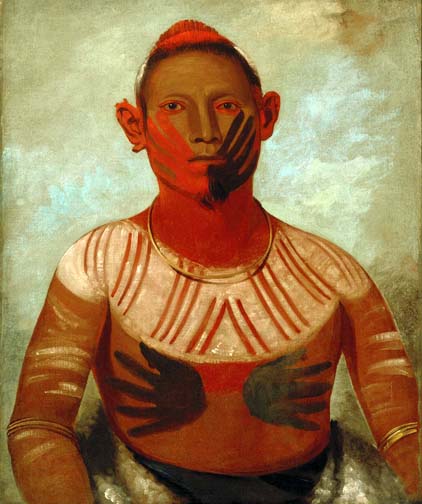
I-o-wáy,
One of Black Hawk's Principal Warriors
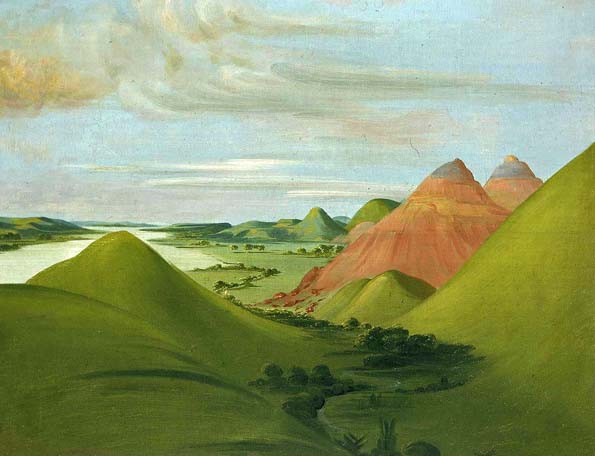
Iron Bluff, 1200 Miles above Saint Louis: 1832
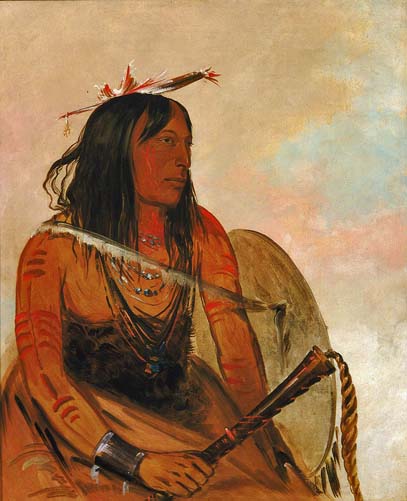
Ish-a-ró-yeh,
He Who Carries a Wolf, a Distinguished Brave: 1834
A man of some standing in the tribe who "piloted the dragoons to the Comanche village, and received a handsome rifle from Colonel Dodge for so doing." He was named "from the circumstance of his carrying a medicine-bag made of the skin of a wolf; he holds a whip in his hand" (1848 catalogue, PP. 10-12).
Painted at the Comanche village in 1834. The Smithsonian portrait and plate 170 in Letters and Notes are almost identical (the shield is missing in the plate), but the Gilcrease watercolor is only bust length.
The subject appears again, full length, in cartoon 43.
Quoted From: The Catlin Collection
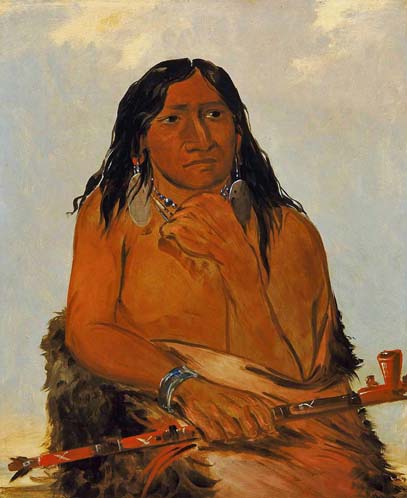
Is-sa-wáh-tám-ah,
Wolf Tied with Hair, a Chief: 1834
Catlin describes the subject as holding a "pipe in his hand" (1848 catalogue, p. 12).
Painted at the Comanche village in 1834. The Smithsonian portrait and plate 171 in Letters and Notes are identical, but the subject has no pipe in the Gilcrease watercolor, and he wears additional jewelry and a feather headdress.
Wolf Tied with Hair appears again in cartoon 43.
Quoted From: The Catlin Collection
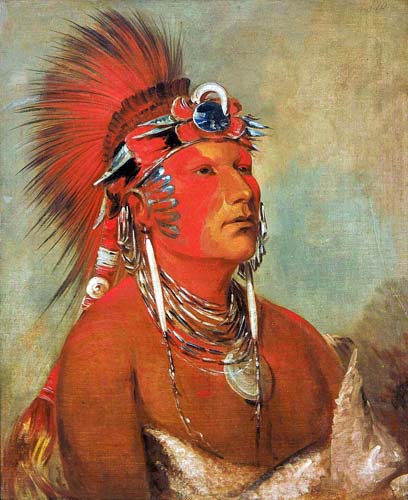
Jee-hé-o-hó-shah,
Cannot Be Thrown Down, a Warrior: 1832
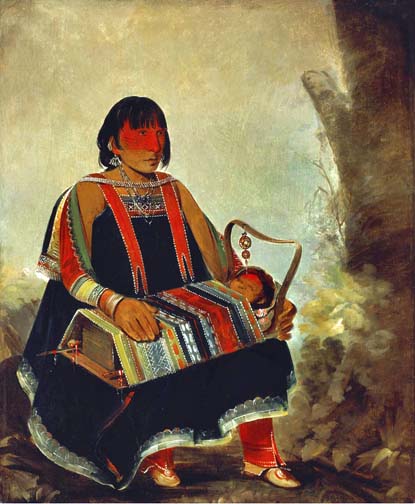
Jú-ah-kís-gaw,
Woman With Her Child in a Cradle
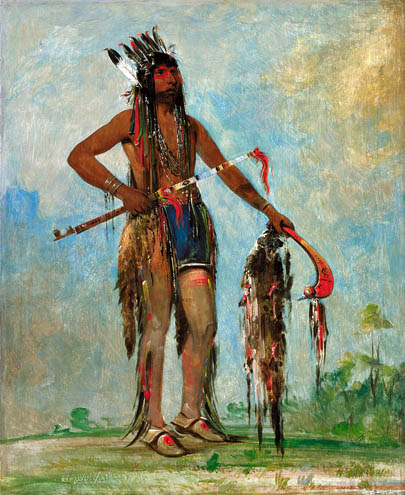
Ka-bés-hunk,
He Who Travels Everywhere, a Warrior: 1835

Kah-béck-a,
The Twin, Wife of Bloody Hand: 1832
Painted at the Mandan village in 1832. Note the richly detailed treatment of the trade bead necklaces worn by The Twin. When time permitted and his interest was aroused, Catlin could vary his technique with considerable facility.
The Twin also appears, full length, in cartoon 36, with her husband.
Quoted From: The Catlin Collection

Káh-kée-tsee,
Thighs, a Wichita Woman: 1834

Ka-pés-ka-da,
Shell Man, an Oglala Brave: 1832
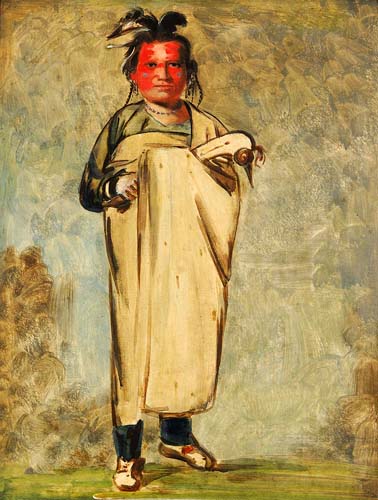
Káw-kaw-ne-chóo-a,
a Brave: 1828
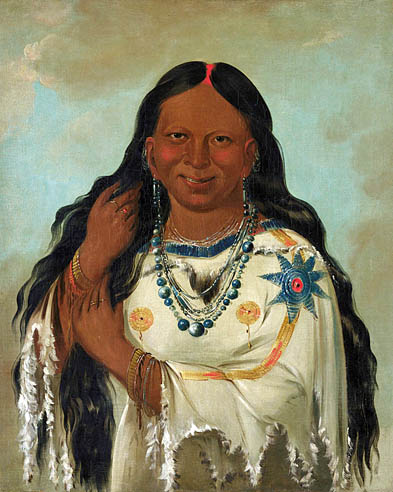
Kay-a-gís-gis,
a Young Woman: 1832
Described by Catlin as "a beautiful young woman pulling her hair out of braid" (1848 catalogue, p. 23).
Painted at Fort Union in 1832, and one of Catlin's first attempts at facial expression in an Indian portrait. The smile, somewhat forced, but engagingly shy and self-conscious, is an indication of the artist's growing perception of individual qualities among subjects whose appearance had not been critically examined before.
Quoted From: The Catlin Collection

Kay-ée-qua-da-kúm-ee-gísh-kum,
He Who Tries the Ground with His Foot
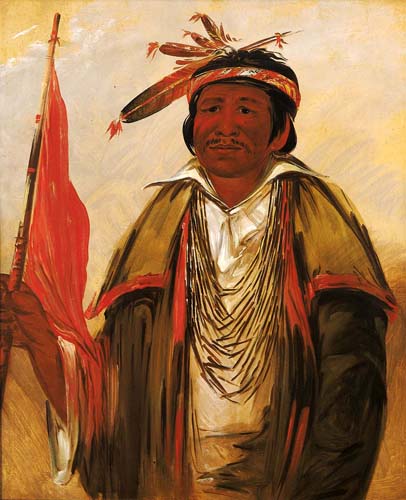
Ke-chím-qua,
Big Bear
Described by Catlin as :a Sub-Chief, in the act of prayer" (1848 catalogue, p. 27).
Probably painted at Fort Leavenworth in 1830. The Gilcrease watercolor again lacks the costume details of the Smithsonian original, and the date on the watercolor is not reliable.
Quoted From: The Catlin Collection
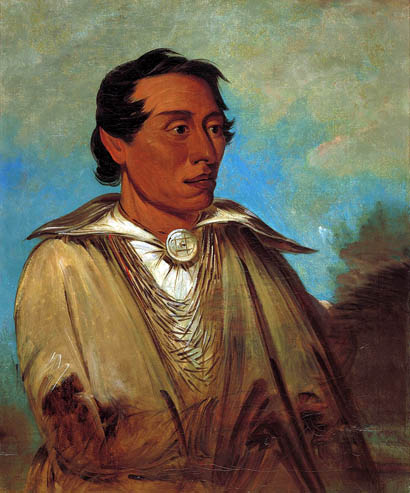
Kee-án-ne-kuk,
Foremost Man, Chief of the Tribe: 1830
"The present chief of this tribe … usually called the … Prophet, is a very shrewd and talented man. When he sat for his portrait, he took his attitude as seen in the picture, which was that of prayer. And I soon learned that he was a very devoted Christian. … It was told to me in the tribe by the Traders (though I am afraid to vouch for the whole truth of it), that while a Methodist preacher was soliciting him for permission to preach in his village, the Prophet refused him the privilege, but secretly took him aside and supported him until he learned from him his creed, and his system of teaching it to others; when he discharged him, and commenced preaching among his people himself; pretending to have had an interview with some … inspired personage; ingeniously resolving, that if there was any honor … or influence to be gained by the promulgation of it, he might as well have it as another person; and with this view he commenced preaching and instituted a prayer, which he ingeniously carved on a maple stick of an inch and a half in breadth, in characters somewhat resembling Chinese letters. These sticks, with the prayers on them, he has introduced into every family of the tribe, and into the hands of every individual; and as he has necessarily the manufacturing of them all, he sells them at his own price; and has thus added lucre to fame, and in two essential and effective ways, augmented his influence in his tribe" (Letters and Notes, vol. 2, pp. 90-99, pl. 185).
Probably painted at Fort Leavenworth in 1830. Catlin makes no mention of visiting the Kickapoo in Illinois.
Foremost Man must at first have been shown delivering a sermon, such as the one mentioned in Letters and Notes. The gesturing hands have been over-painted by the artist in the Smithsonian portrait, but they remain, ill-proportioned and awkwardly poised, in plate 185 of Letters and Notes and the Gilcrease watercolor. The Smithsonian portrait and plate 185 are otherwise identical, but the subject wears a feather headdress in the Gilcrease watercolor.
Foremost Man is incorrectly identified as Kee-mo-ra-nia (No English) in the Gilcrease catalogue and Haverstock. He appears again, full length and with gesturing hands, in cartoon 72, accompanied by his wife and a Kickapoo disciple.
Quoted From: The Catlin Collection
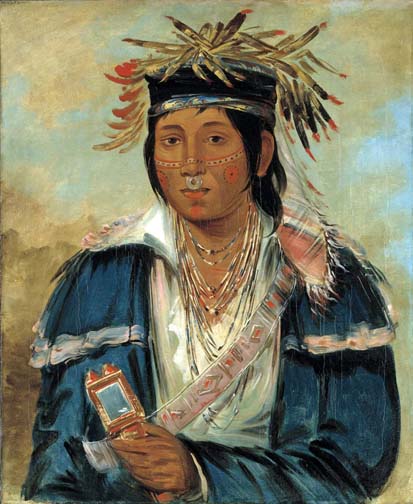
Kee-mo-rá-nia,
No English, a Dandy
Catlin further describes No English as "a beau; his face curiously painted, and looking-glass in his hand" (1848 catalogue, p. 27).
Probably painted at Fort Leavenworth in 1830. The subject is incorrectly identified as Kee-án-ne-kuk (Foremost Man) in the Gilcrease catalogue.
The Smithsonian and Gilcrease portraits are identical except for minor changes in the arrangement of the necklaces. The former matches plate 194 in Letters and Notes. No English appears again, full length, in cartoon 58.
Quoted From: The Catlin Collection

Kee-món-saw,
Little Chief, a Chief: 1830
Catlin describes the subject as "half-civilized, and, I should think, half-breed … This young man is chief of the tribe; and I was told by one of the Traders, that his mother and his son, were his only subjects" (Letters and Notes, vol. 2).
Probably painted at Fort Leavenworth in 1830. Donaldson suggests the right location but wrong date.
Catlin often used a more conventional pose in his portraits of civilized Indians. Little Chief is shown half-length in the Gilcrease watercolor, and he appears again, full length, in cartoon 50, with his mother and child.
Quoted From: The Catlin Collection
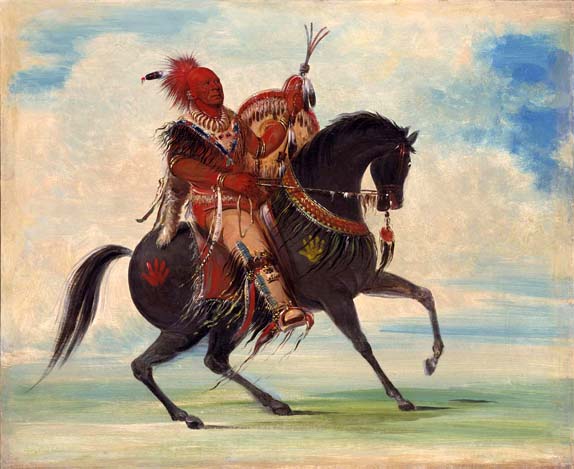
Kee-o-kúk,
The Watchful Fox, Chief of the Tribe, on Horseback: 1835
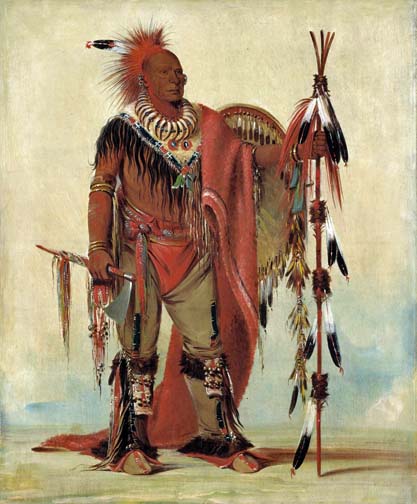
Kee-o-kúk,
The Watchful Fox, Chief of the Tribe: 1835
"Kee-o-kuk … is the present chief of the tribe, a dignified and proud man, with a good share of talent, and vanity enough to force into action all the wit and judgment he possesses, in order to command the attention and respect of the world. At the close of the 'Black Hawk War' in 1832 … Kee-o-kuk was acknowledged chief of the Sacs and Foxes by General Scott, who held a treaty with them at Rock Island. His appointment as chief was in consequence of the friendly position he had taken during the war, holding two-thirds of the warriors neutral, which was no doubt the cause of the sudden and successful termination of the war, and the means of saving much bloodshed. Black Hawk and his two sons, as well as his principal advisers and warriors, were brought into Saint Louis in chains, and Kee-o-kuk appointed chief with the assent of the tribe. In his portrait I have represented him in the costume precisely in which he was dressed when he stood for it, with his shield on his arm and his staff (insignia of office) in his left hand. There is no Indian chief on the frontier better known at this time, or more highly appreciated for his eloquence, as a public speaker, than Kee-o-kuk, as he has repeatedly visited Washington and others of our Atlantic towns, and made his speeches before thousands, when he has been contending for his people's rights, in their stipulations with the United States Government, for the sale of their lands."
"After I had painted the portrait of this … man at full length … he had the vanity to say to me, that he made a fine appearance on horseback, and that he wished me to paint him thus. So I prepared my canvass in the door of the hospital which I occupied, in the dragoon cantonment; and he flourished about for a considerable part of the day in front of me, until the picture was completed. The horse that he rode was the best animal on the frontier. He made a great display on this day, and hundreds of the dragoons and officers were about him, and looking on during the operation. His horse was beautifully caparisoned, and his scalps were carried attached to the bridle-bits" (Letters and Notes, vol. II).
Painted at the Sauk and Fox village in 1835, according to Letters and Notes. Donaldson gives the wrong date for Catlin's visit to the village, and Roehm is incorrect in assuming that the portrait was done at Jefferson Barracks. Kee-o-kuk was the most prominent chief on the frontier in the 1830's, an impressive, overbearing, portly man whom Catlin flattered in two of the most elaborately painted portraits of his western travels. A daguerreotype of Kee-o-kuk taken in 1847 makes one wonder if he could have cut such a fine figure twelve years earlier, although Catlin has given some indication of incipient corpulence in both examples.
The standing portrait is based on a classical pose that the artist used frequently for important subjects, and Keokuk's proportions are as firm and well-articulated as any of Catlin's full-length figures. The profusion of costume accessories is the most striking aspect of the portrait, however. They have been reproduced with unusual clarity, probably in deference to Kee-o-kuk's wishes, and with a decorative skill that Catlin did not attempt in his earlier work. Yet their lavish appearance somewhat dilutes the image of strength and independence that was literally proclaimed in the Upper Missouri portraits (where Catlin did edit costume details). He was admittedly biased toward frontier chiefs, who had the trappings, if not the substance, of political authority, and one senses that in the eyes of the artist, Kee-o-kuk had been compromised by civilized indulgence-the pride and freedom of the Upper Missouri had been exchanged for an image more Roman than savage.
The facial features and the technique of the two Smithsonian portraits are so close that one tends to believe they were painted on the same occasion, as Catlin maintains. In the Smithsonian version, Kee-o-kuk sits heavily astride a horse descended from a baroque monument, and wears the same elaborate costume. Why the equestrian portrait is included only in the 1837 catalogue, and as plate 290 in Letters and Notes, remains a mystery.
The draftsmanship of the unfinished University Museum version (a similar equestrian image) is unusually tight and accomplished for 1836, and Kee-o-kuk's furrowed face is in marked contrast to his impassive expression in the original portrait. In spite of the signature, the version more likely comes from the late 1840's or early 1850's, when Catlin was busily engaged in copying other paintings from his original collection. Prominent chiefs on the frontier sat to numerous artists, and McDermott mentions portraits of Keokuk by James Otto Lewis, Peter Rindisbacher, Charles Bird King, John Mix Stanley, and Ferdinand Pettrich, and the daguerreotype of 1847. Donaldson says that Charles Deas also had a chance to observe the chief. The standing portrait of Kee-o-kuk is repeated in cartoon 15, with his wife and another Sauk chief. The cartoon is based on a watercolor in the Gilcrease Souvenir album, and an oil-on-canvas version of the composition is in the Museum für Völkerkunde, Berlin. The equestrian portrait is repeated in cartoon 16.
Quoted From: The Catlin Collection

Kid-á-day,
a Distinguished Brave: 1834
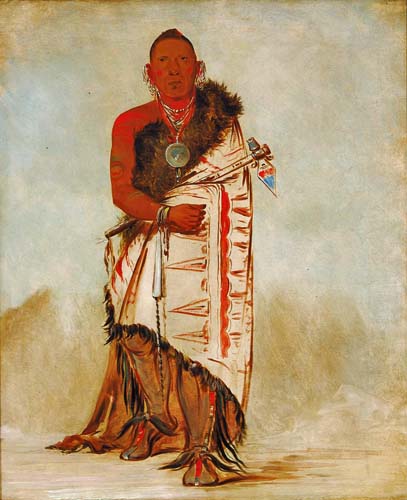
Ki-hó-go-waw-shú-shee,
Brave Chief, Chief of the Tribe: 1832
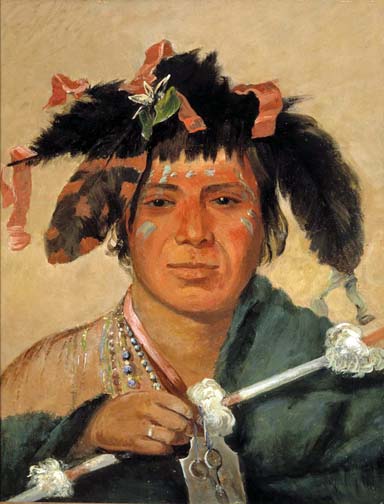
Ko-mán-i-kin-o-haw,
Little Whale, a Brave: 1831
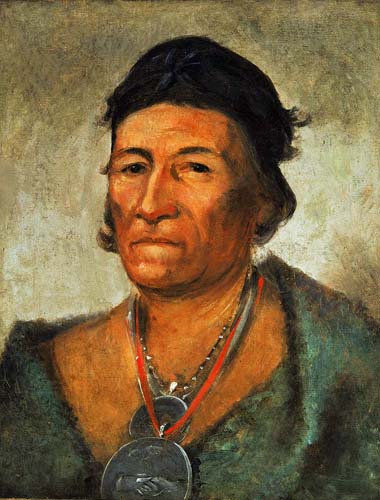
Ko-mán-i-kin,
Big Wave, an Old and Distinguished Chief: 1831

Koon-za-ya-me,
Female War Eagle

Kots-o-kó-ro-kó,
Hair of the Bull's Neck, a Chief: 1834
Painted at the Comanche village in 1834. The subject is half-length in the Gilcrease watercolor, he has no gun and shield, and his costume accessories differ noticeably from those in the Smithsonian portrait.
Quoted From: The Catlin Collection
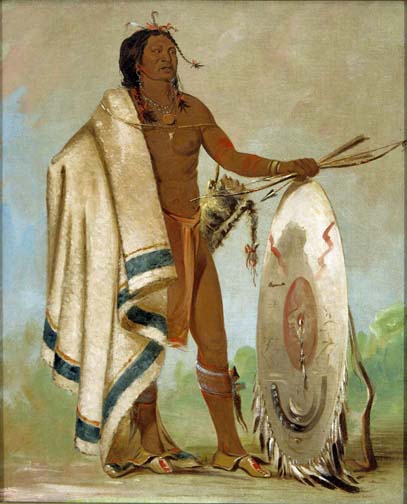
Kotz-a-tó-ah,
Smoked Shield, a Distinguished Warrior: 1834
Catlin describes Smoked Shield as "another of the extraordinary men of this tribe, near seven feet in stature, and distinguished, not only as one of the greatest warriors, but the swiftest on foot, in the nation. This man, it is said, runs down a buffalo on foot, and slays it with his knife or his lance, as he runs by its side" (Letters and Notes, vol. 2).
Painted at the Comanche village in 1834.
Quoted From: The Catlin Collection
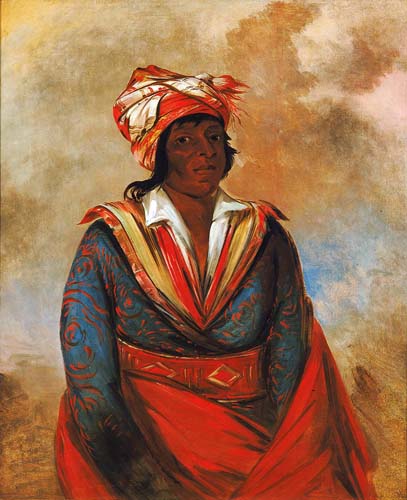
Kut-tee-o-tub-bee,
How Did He Kill, a Noted Brave: 1834
Painted at Fort Gibson in 1834. The subject is called Wa-pa-heo in the Gilcrease catalogue. He is shown half-length in the watercolor, and his garment is less elaborate than in the Smithsonian original.
Quoted From: The Catlin Collection
_Pawnee_1832.jpg)
L'har-e-tar-rúshe,
Ill-natured Man, a Skidi (Wolf) Pawnee: 1832
,_Near_the_Coteau_des_Prairies_1836.jpg)
Lac du Cygne (Swan Lake),
Near the Coteau des Prairies: 1836

La-dóo-ke-a,
Buffalo Bull, a Grand Pawnee Warrior: 1832
Described by Catlin "as a warrior of great distinction," Buffalo Bull appears "with his medicine or totem (the head of a buffalo) painted on his breast and his face, with bow and arrow in his hands" (Letters and Notes, vol. II).
Probably painted at Fort Leavenworth in 1832. Several unfinished portraits in the Pawnee series show the rapid oil strokes that Catlin used to block in figure and costume at the initial sitting, and what color and detail remained to be filled in after he returned to Saint Louis.
Buffalo Bull appears again in cartoon 23, with his wife and children, and two Pawnee warriors.
Quoted From: The Catlin Collection
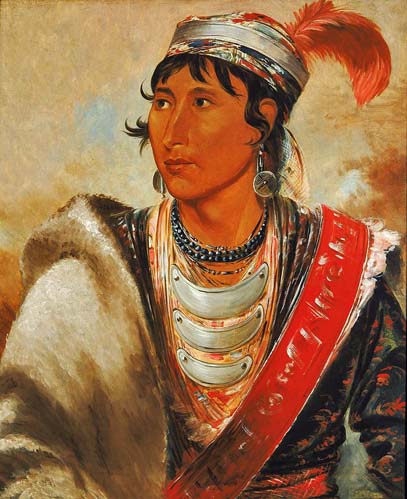
Láh-shee,
The Licker: 1838

La-kée-too-wi-rá-sha,
Little Chief, a Tapage Pawnee Warrior: 1832
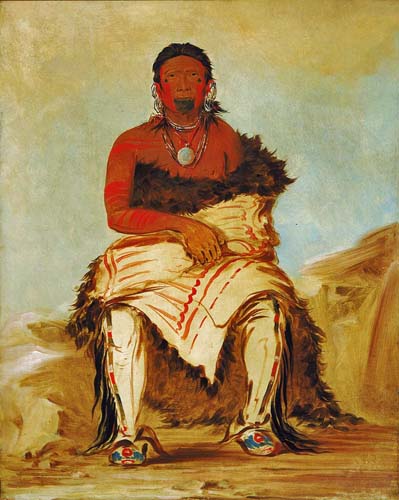
Lá-shah-le-stáw-hix,
Man Chief, a Republican Pawnee: 1832
_Pawnee_1832.jpg)
La-wáh-he-coots-la-sháw-no,
Brave Chief, a Skidi (Wolf) Pawnee: 1832

La-wée-re-coo-re-shaw-wee,
War Chief, a Republican Pawnee: 1832
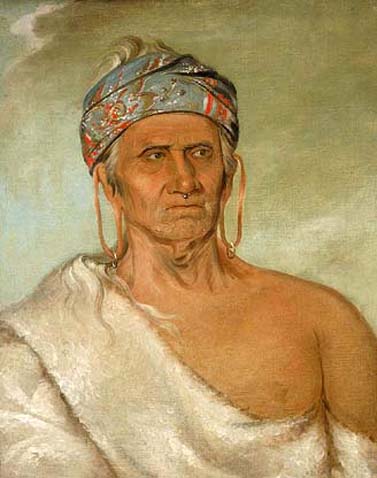
Lay-láw-she-kaw,
Goes Up the River, an Aged Chief: 1830
"The present chief of the tribe is a very aged, but extraordinary man, with a fine and intelligent head, and his ears slit and stretched down to his Shoulders, a custom highly valued in this tribe; which is done by severing the rim of the ear with a knife, and stretching it down by wearing heavy weights attached to it at times, to elongate it as much as possible, making a large orifice, through which, on parades. They often pass a bunch of arrows or quills, and wear them as ornaments" (Letters and Notes, vol. II).
Probably painted at Fort Leavenworth in 1830. The style of the Shawnee portraits again corresponds to the Potawatomi and Kickapoo series.
The subject also appears, full length, in cartoon 74, with his daughter and other members of the tribe.
Quoted From: The Catlin Collection
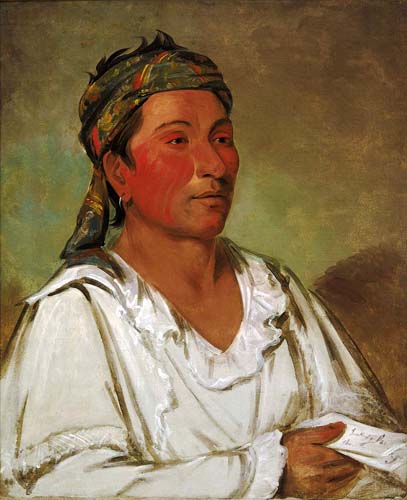
Lay-lóo-ah-pee-ái-shee-kaw,
Grass, Bush, and Blossom, Semicivilized: 1830
_Pawnee_1832.jpg)
Le-sháw-loo-láh-le-hoo,
Big Elk, Chief of the Skidi (Wolf) Pawnee: 1832
Probably painted at Fort Leavenworth in 1832. The feathers are missing from Big Elk's roach in plate 141 of Letters and Notes, and two lodges have been added to the landscape behind him. He later sat to Charles Bird King in Washington.
Big Elk supposedly appears again in cartoon 24, but the Smithsonian painting is so unlike the cartoon figure that the latter must be mislabeled. A figure that does resemble the Smithsonian painting stands beside Buffalo Bull in cartoon 23, but he is incorrectly identified in the 1871 catalogue as Bird that Goes to War.
Cartoon 24 is based on a watercolor in the Gilcrease Souvenir album, which also appears to be mislabeled.
Quoted From: The Catlin Collection

Little Bear,
Hunkpapa Brave: 1832
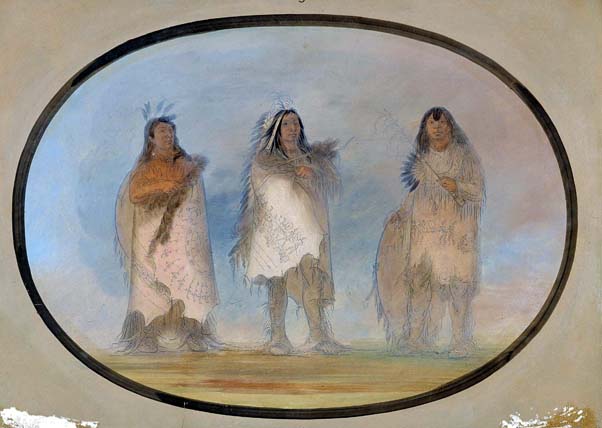
Little Bear, Steep Wind, The Dog: 1865
After traveling and painting in South America, Catlin settled in Brussels in 1860. There he brought about 300 new paintings and recreated many of the works from his Indian Gallery. Catlin called his second collection “cartoons” because he created the images from pencil outlines drawn on cardboard. In this composition, he combined three individual portraits from the Indian Gallery into a group portrait. Because Catlin made so many copies, it is difficult to identify pieces original to the two collections. This artwork was actually a copy of a work in the cartoon series.
In 1871, George Catlin finally returned to live in the United States for the first time in thirty-two years. A stunning testament to his determination and vision, he arrived in New York City with about 600 paintings, the cartoon version of his Indian Gallery.
Quoted From: Campfire Stories with George Catlin
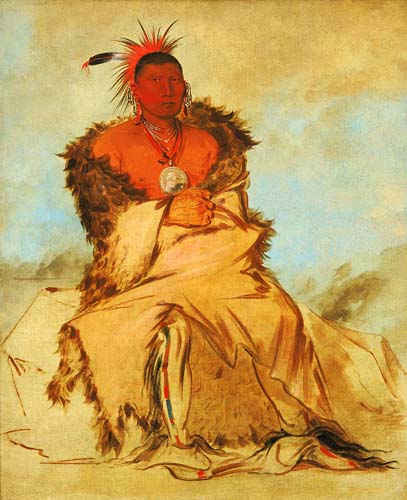
Loo-rá-wée-re-coo,
Bird that Goes to War, a Tapage Pawnee: 1832

Ma-shee-na,
Elk's Horns, a Subchief: 1830
Described by Catlin as "a Sub-Chief, in the act of prayer" (1848 catalogue, p. 27).
Probably painted at Fort Leavenworth in 1830. The Gilcrease watercolor again lacks the costume details of the Smithsonian original, and the date on the watercolor is not reliable.
Quoted From: The Catlin Collection
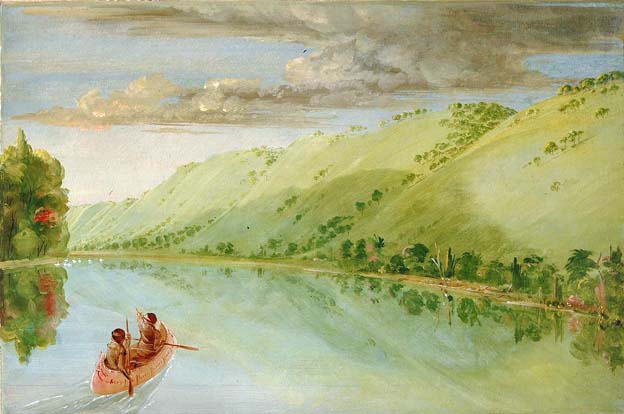
Madame Ferrebault's Prairie, above Prairie du Chien: 1835
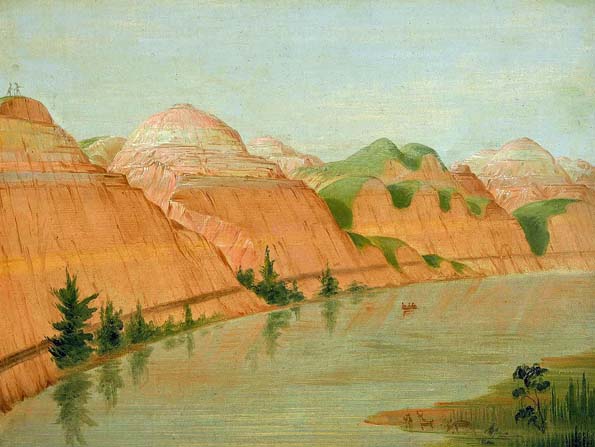
Magnificent Clay Bluffs, 1800 Miles above Saint Louis: 1832
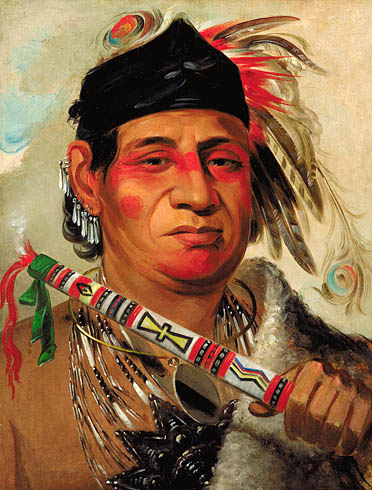
Mah-kée-mee-teuv,
Grizzly Bear, Chief of the Tribe: 1831
Described by Catlin as a dignified chief who, commanded great respect for his eloquence, and … deportment" Grizzly Bear was painted with "a handsome pipe in his hand, and wampum on his neck" (Letters and Notes, vol. II).
Probably painted in Washington in January 1831, when Grizzly Bear and thirteen members of his tribe visited the capital to negotiate the sale of a portion of their tribal lands. A treaty signed by the Menominee on February 8, 1831, includes the names of eleven of the twelve male subjects listed in the 1848 catalogue between numbers 218 and 231. Catlin's presence in Washington in January 1831 is certain, and the Menominee portraits are very different from the one Winnebago example, apparently painted at Prairie du Chien in the summer of 1830. They have more in common with the Fort Leavenworth series of the fall of that year, and their small size connects them with other groups that must have been painted in Washington.
The portrait of Grizzly Bear is painted with a flourish and fullness of expression that distinguishes it among the Menominee group. Were it not for its size (the uniform dimensions this series), and the schematic modeling of eyes and lips, one would be tempted to assign it to one of Catlin's later visits to Prairie du Chien. The succeeding portraits in this group, which Donaldson incorrectly dates 1835 or 1836, are modeled with heavier, less vigorous strokes, and costume details sometimes lack a sharp and careful definition. The unfortunate condition of several portraits further contributes to their uneven appearance.
Grizzly Bear appears again in cartoon 17, with his wife and son.
Quoted From: The Catlin Collection
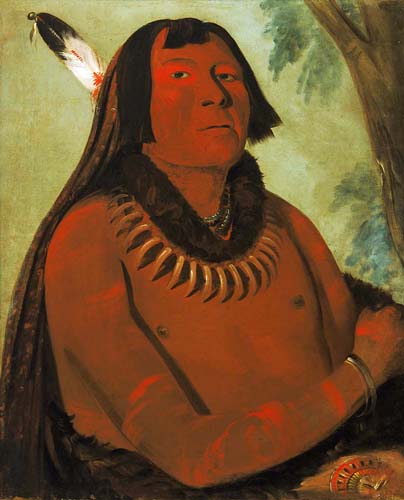
Mah-táhp-ta-a,
Rushes through the Middle, a Brave
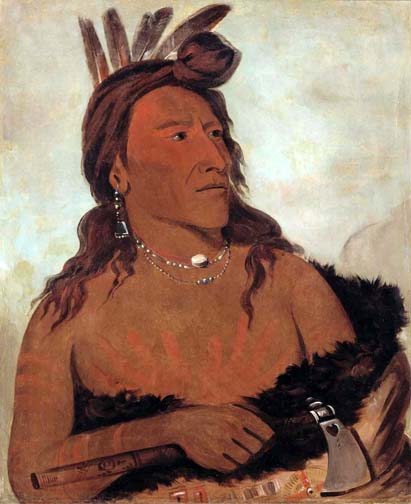
Mah-tó-che-ga,
Little Bear, a Hunkpapa Brave: 1832
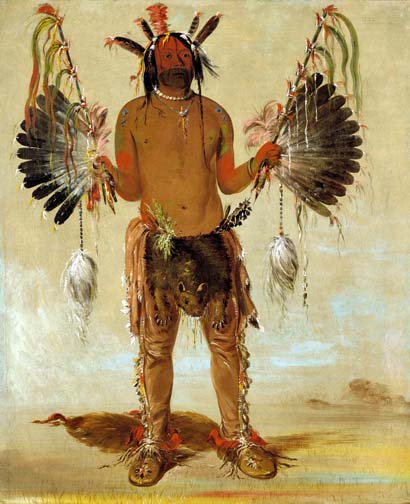
Mah-tó-he-ha,
Old Bear, a Medicine Man: 1832
At twelve o'clock, "having used the whole of the fore-part of the day at his toilette," Old Bear arrived at Catlin's lodge "bedaubed and streaked with paints of various colors, with bear's grease and charcoal, with medicine-pipes in his hands and foxes tails attached to his heels … (and) with a train of his own profession, who seated themselves around him. He took his position in the middle of the room, waving his eagle calumets in each hand, and singing his medicine song … looking me full in the face until I completed his picture, which I painted at full length" (Letters and Notes, vol. I).
Painted at the Mandan village in 1832. Old Bear, flanked by two arcs of feathers, is one, of Catlin's most successfully designed full-length figures.
The subject also appears in cartoon 184, practicing his medicine before a "crying and howling" crowd, and in plate 30 of the Gilcrease Souvenir album.
Quoted From: The Catlin Collection
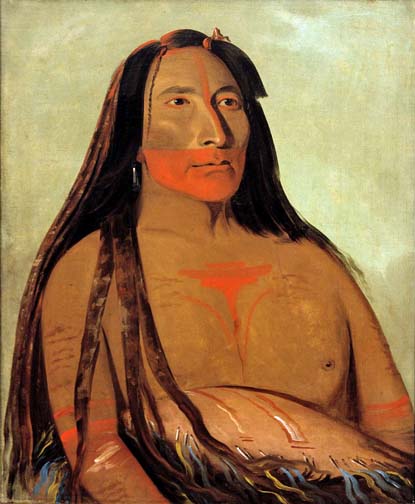
Máh-to-tóh-pa,
Four Bears, Second Chief in Mourning: 1832
Described by Catlin as Four Bears "in undress, being in mourning, with a few locks of hair cut off His hair put up in plaits or slabs, with glue and red paint, a custom of the tribe".
"The scars on his breast, arms, and legs, show that he has several times in his life submitted to the propitiatory tortures represented in four paintings" (1848 catalogue, p. 19).
Painted at the Mandan village in 1832. The Mandan portraits, like those of the Sioux, are brushed with strong, even strokes that form solid and distinctive facial characteristics.
The Smithsonian and Gilcrease portraits are identical, but the former is clearly the life study. Catlin also painted Four Bears full length.
Quoted From: The Catlin Collection
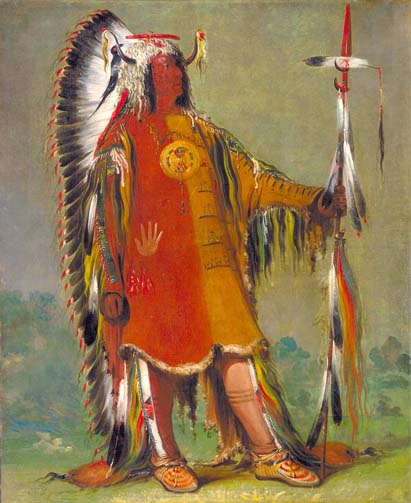
Máh-to-tóh-pa,
Four Bears, Second Chief, in Full Dress: 1832
"This extraordinary man, though second in office is undoubtedly the first and most popular man in the nation. Free, generous, elegant and gentlemanly in his deportment-handsome, brave and valiant; wearing a robe on his back, with the history of his battles emblazoned on it; which would fill a book of themselves, if properly translated. This, readers, is the most extraordinary man, perhaps, who lives at this day, in the atmosphere of Nature's noblemen."
"The dress of Mah-to-toh-pa … the greater part of which I have represented in his full-length portrait, and which I shall now describe, was purchased of him after I had painted his picture; and every article of it can be seen in my Indian Gallery by the side of the portrait, provided I succeed in getting them home to the civilized world without injury."
"Mah-to-toh-pa had agreed to stand before me for his portrait at an early hour of the next morning, and on that day I sat with my palette of colors prepared, and waited till twelve o'clock, before he could leave his toilette with feelings of satisfaction as to the propriety of his looks and the arrangement of his equipments; and at that time it was announced, that 'Mah-to-toh-pa was coming in full dress!' I looked out of the door of the wigwam, and saw him approaching with a firm and elastic step, accompanied by a great crowd of women and children, who were gazing on him with admiration, and escorting him to my room. No tragedian ever trod the stage, nor gladiator ever entered the Roman Forum, with more grace and manly dignity than did Mah-to-toh-pa enter the wigwam, where I was in readiness to receive him. He took his attitude before me, and with the sternness of a Brutus and the stillness of a statue, he stood until the darkness of night broke upon the solitary stillness. His dress, which was a very splendid one, was complete in all its parts, and consisted of a shirt or tunic, leggings, moccasins, head-dress, necklace, shield, bow and quiver, lance, tobacco-sack, and pipe; robe, belt, and knife; medicine-bag, tomahawk, and war-club, or po-ko-mo-kon."
"The shirt, of which I have spoken, was made of two skins of the mountain-sheep, beautifully dressed, and sewed together by seams which rested upon the arms; one skin hanging in front, upon the breast, and the other falling down upon the back; the head being passed between them, and they falling over and resting on the shoulders. Across each shoulder, and somewhat in the form of an epaulette, was a beautiful band; and down each arm from the neck to the hand was a similar one, of two inches in width (and crossing the other at right angles on the shoulder) beautifully embroidered with porcupine quills worked on the dress, and covering the seams. To the lower edge of these bands the whole way, at intervals of half an inch, were attached long locks of black hair, which he had taken with his own hand from the heads of his enemies whom he had slain in battle, and which he thus wore as a trophy, and also as an ornament to his dress. The front and back of the shirt were curiously garnished in several parts with porcupine quills and paintings of the battles he had fought, and also with representations of the victims that had fallen by his hand. The bottom of the dress was bound or hemmed with ermine skins, and tassels of ermines' tails were suspended from the arms and the shoulders."
"The Leggings, which were made of deer skins, beautifully dressed, and fitting tight to the leg, extended from the feet to the hips, and were fastened to a belt which was passed around the waist. These, like the shirt, had a similar band, worked with porcupine quills of richest dyes, passing down the seam on the outer part of the leg, and fringed also the whole length of the leg, with the scalp-locks taken from his enemies' heads."
"The Head-dress, which was superb and truly cent, consisted of a crest of war-eagles gracefully falling back from the forehead e back part of the head, and extending quite down to his feet; set the whole way in a profusion of ermine, and surmounted on the top of the head, with the horns of the buffalo, shaved thin and highly polished."
"Such was the dress of Mah-to-toh-pa when he entered my wigwam to stand for his picture; but such I have not entirely represented it in his portrait; having rejected such trappings and ornaments as interfered with the grace and simplicity of the figure. He was beautifully and extravagantly dressed; and in this he was not alone, for hundreds of others are equally elegant. In plumes, and arms, and ornaments, he is not singular; but in laurels and wreaths he stands unparalleled. His breast has been bared and scarred in defense of his country, and his brows crowned with honors that elevate him conspicuous above all of his nation. There is no man among the Mandans so generally loved, nor anyone who wears a robe so justly famed and honorable as that of Mah-to-toh-pa" (Letters and Notes, vol. I).
Painted at the Mandan village in 1832. Four Bears (Máh-to-tóh-pa) was the most publicized Indian of the Upper Missouri in the 1830's, and the subject among all of Catlin's portraits whom the artist most favored. The two communicated often and at length during Catlin's stay at Mandan village, and the full-length portrait of Four Bears is one of the finest, and certainly the most widely known, in the collection. Calm, dignified, splendidly costumed (and stripped of certain encumbering "ornaments and trappings"), the chief is presented by Catlin with all the pomp of an imperial portrait, and Ewers (1968) points out how that image of Four Bears became over the years a symbol of the North American Indian. Ewers (1956) also comments on the accuracy of the portrait by comparing the features to those of Four Bears' son, and the costume details to the original costume, which is in the Smithsonian anthropology collections.
The Gilcrease watercolor incorporates most of the detail of the original, and the half-length portrait of Four Bears in the Smithsonian is a less imposing, but more sympathetic and descriptive record of his features. Catlin also lists a painting of the subject among those commissioned by Louis Philippe (see Travels in Europe). Four Bears appears again, full length, in plate 28 of the North American Indian Portfolio, first published in 1844, and in several cartoons that Catlin reproduced with some frequency. The most popular are those in which the chief poses with his family (cartoon 30), and before the astonished members of his tribe as the artist paints his portrait (cartoon 191). A superior version of the former is in the Museum für Völkerkunde, Berlin, and the cartoon itself is based on a watercolor (pl. 2) in the Gilcrease Souvenir album. Another cartoon (133), which was taken from plate 62 in Letters and Notes, shows Catlin feasting in Four Bears' lodge, and a fourth (cartoon 194) illustrates the buffalo robe upon which the chief, who was also an artist, depicted his triumphs in battle.
Quoted From: The Catlin Collection
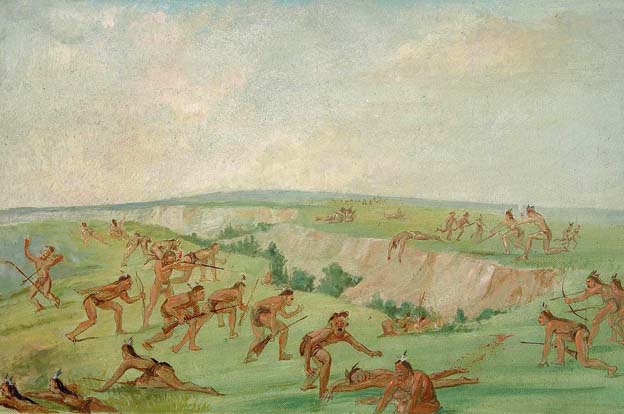
Mandan Attacking a Party of Arikara: 1832
Catlin describes the location of the attack as "a ravine, near the Mandan village" (1837 catalogue, p. 43).
Catlin may have observed an Indian skirmish during his visit to the Mandan village in 1832, but the painting is most likely a studio fabrication. The scene is repeated in cartoon 339.
Quoted From: The Catlin Collection
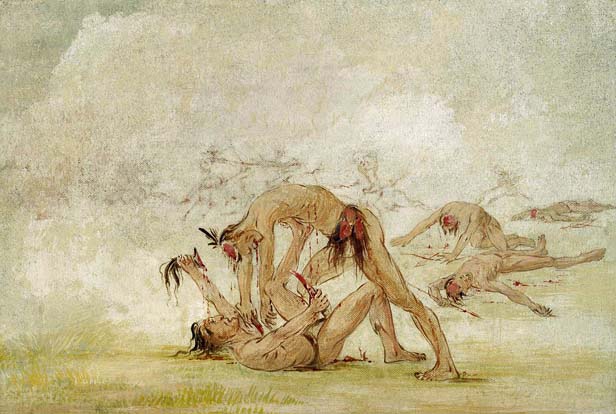
Mandan Scalping an Enemy: 1836

Mash-kee-wet,
a Great Dandy: 1831
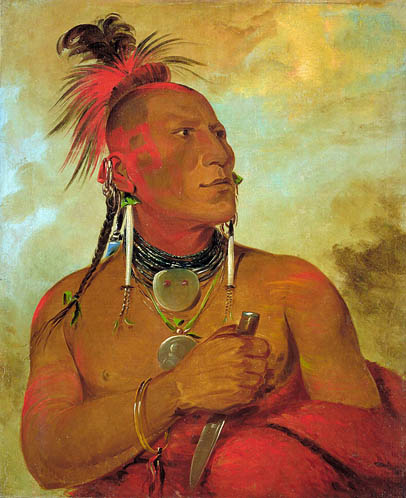
Meach-o-shín-gaw,
Little White Bear, a Distinguished Brave: 1832
Catlin describes the subject's head as having a "bold and Roman outline" (Letters and Notes, vol. 2).
Probably painted at Fort Leavenworth in 1832. The Smithsonian oil and the Gilcrease watercolor are identical in detail, but the face of the former is more forcefully modeled, indicating its status as the life portrait.
Little White Bear also appears, full length, in cartoon 1.
Quoted From: The Catlin Collection
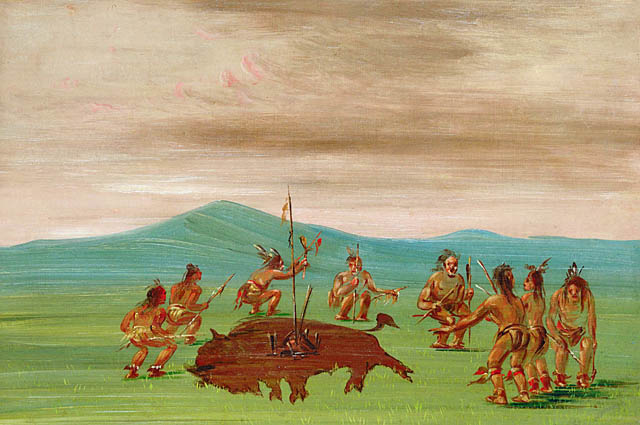
Medicine Buffalo of the Sioux: 1838
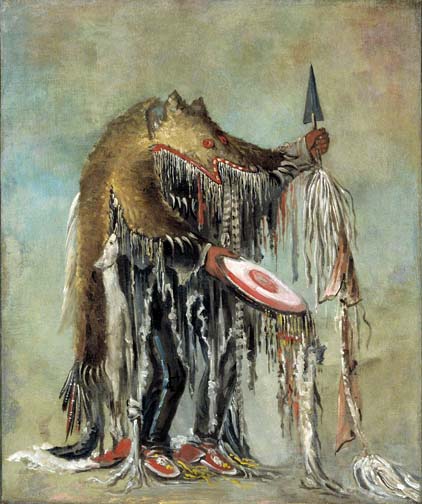
Medicine Man,
Performing His Mysteries over a Dying Man: 1832
"(The medicine man) approached the ring (of spectators) with his body in a crouching position, with a slow and tilting step-his body and head were entirely covered with the skin of a yellow bear, the head of which (his own head being inside of it) served as a mask; the huge claws of which also, were dangling on his wrists and ankles; in one hand he shook a frightful rattle, and in the other brandished his medicine-spear or magic wand; to the rattling din and discord of all of which, he added the wild and startling jumps and yelps of the Indian, and horrid and appalling grunts, and snarls, and growls of the grizzly bear, in ejaculatory and guttural incantations to the Good and Bad Spirits, in behalf of his patient; who was rolling and groaning in the agonies of death, while he was dancing around him, jumping over him, and pawing him about, and rolling him in every direction" (Letters and Notes, vol. 1, pp. 30-41, pl. 19).
Painted at Fort Union in 1832. The medicine man also appears in a watercolor (pl. 30, labeled White Buffalo) in the Gilcrease Souvenir album, and in cartoon 185, practicing his ritual before a crowd of Indians. The scene must have inspired a somewhat similar painting at Beaver House in London by the British artist C. P. Manley.
Quoted From: The Catlin Collection
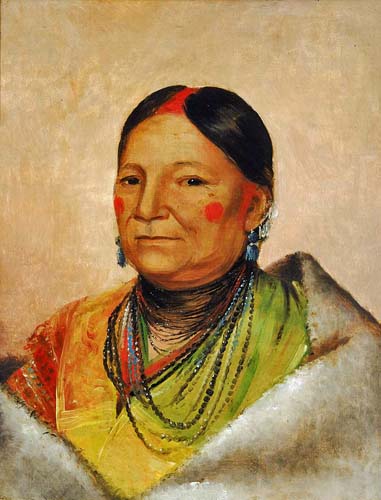
Mee-cheet-e-neuh,
Wounded Bear's Shoulder, Wife of the Chief: 1831
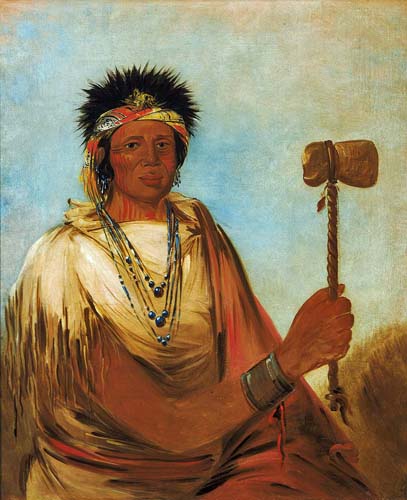
Men-son-se-ah, Left Hand, a Warrior: 1830
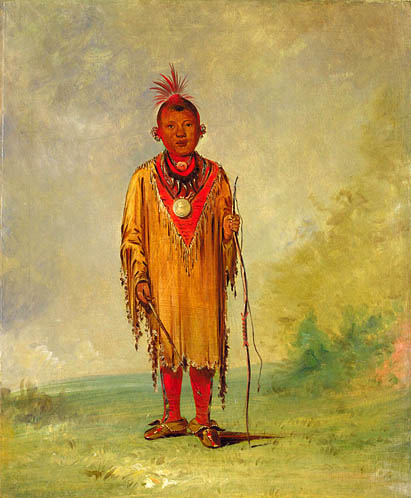
Me-sou-wahk, Deer's Hair, Favorite Son of Kee-o-kuk: 1835
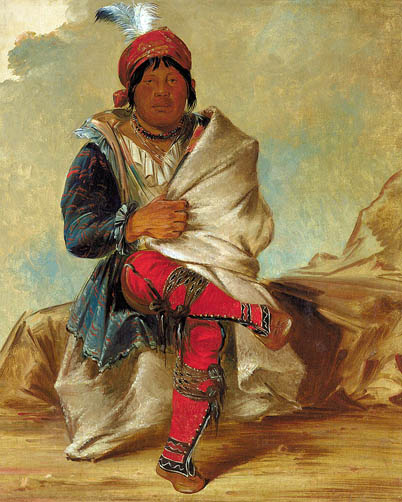
Mick-e-no-pah,
Chief of the Tribe: 1838
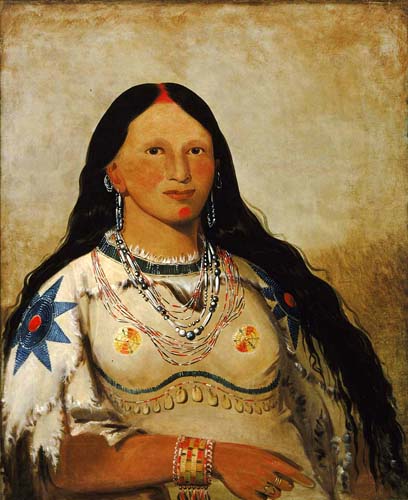
Mi-néek-ee-súnk-te-ka,
Mink, a Beautiful Girl: 1832
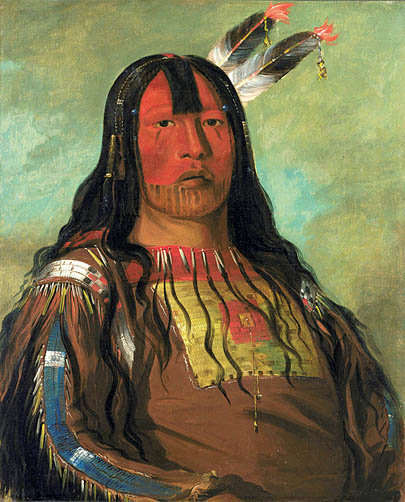
Mix-ke-móte-skin-na,
Iron Horn, a Warrior: 1832
Catlin describes Iron Horn as a "warrior, in a splendid dress" (1848 catalogue, p. 20)
Painted at Fort Union in 1832. Certain Blackfoot portraits are closely related to the Sioux series. Catlin apparently confused the names of Iron Horn and Buffalo's Child when identifying plate 16 in Letters and Notes. Iron Horn also appears, full length, in cartoon 38, in a different pose and costume.
Quoted From: The Catlin Collection
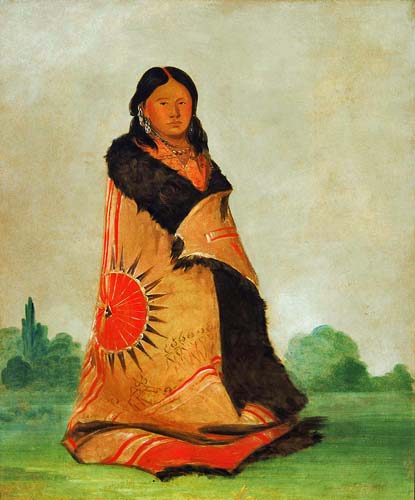
Mong-shóng-sha,
Bending Willow, Wife of Great Chief: 1832
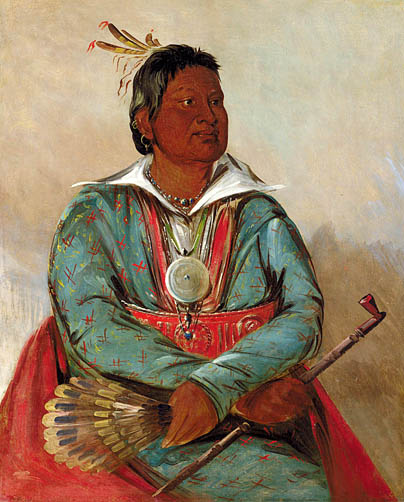
Mo-sho-la-tub-bee,
He Who Puts Out and Kills, Chief of the Tribe: 1834
Described by Catlin as a "famous and excellent chief" (Letters and Notes, vol. 2, p. 123, pl. 221).
Painted at Fort Gibson in 1834, and similar in style to the Cherokee and Creek portraits. Catlin developed a fuller and more subtle range of expression in the Fort Gibson series. Donaldson's date for Catlin's visit to the fort is incorrect.
The subject has a strangely bloated face in the Gilcrease watercolor, and his arms are more awkwardly arranged than in the Smithsonian original. The fan and pipe are not included in the watercolor or plate 221 of Letters and Notes. The subject appears again, full length, in cartoon 65, with another Choctaw.
Quoted From: The Catlin Collection
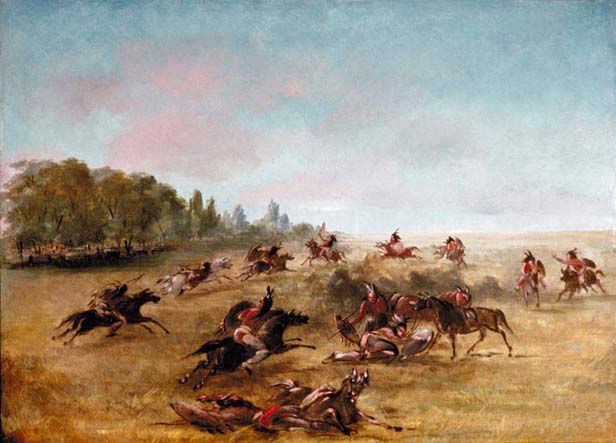
Mounted War Party Scouring a Thicket: 1847

Mouth of the Platte River, 900 Miles above Saint Louis: 1832
Indians would lose their lands. "The mouth of the Platte is a beautiful scene, and no doubt will be the site of a large and flourishing town, soon after Indian titles shall have been extinguished to the lands in these regions, which will be done within a very few years. The Platte is a long and powerful stream, pouring in from the Rocky Mountains and joining with the Missouri at this place."
Source: Letters and Notes, Letter No. 32.
Quoted From: Campfire Stories with George Catlin

Muk-a-tah-mish-o-kah-kaik,
Black Hawk, Prominent Sac Chief: 1832
"The Black Hawk is the man to whom I have alluded, as the leader of the 'Black Hawk War' who was defeated by General Atkinson, and held a prisoner of war, and sent through Washington and other Eastern cities, with a number of others, to be gazed at."
"This man, whose name has carried a sort of terror through the country where it has been sounded, has been distinguished as a speaker or counselor rather than as a warrior; and I believe it has been pretty generally admitted that 'Nahpope' and the 'Prophet' were, in fact, the instigators of the war, and either of them with much higher claims for the name of warrior than Black Hawk ever had."
"When I painted this chief, he was dressed in a plain suit of buckskin, with a string of wampum in his ears and on his neck, and held in his hand his medicine-bag, which was the skin of a black hawk, from which he had taken his name, and the tail of which made him a fan, which he was almost constantly using" (Letters and Notes, vol II).
Catlin painted Black Hawk and his warriors when they were prisoners at Jefferson Barracks near Saint Louis in October 1832. They were described at the time in the following unidentified passage from Donaldson:
"We were immediately struck with admiration at the gigantic and symmetrical figures of most of these warriors, who seemed, as they reclined in native ease and gracefulness, with their half naked bodies exposed to view, rather like statues from some master hand than like beings of a race whom we had heard characterized as degenerate and debased. They were clad in leggings and moccasins of buckskin, and wore blankets, which were thrown around them in the manner of the Roman toga, so as to leave their right arm bare. The youngest among them were painted on their necks with a bright vermilion color, and had their faces transversely streaked with alternate red and black stripes. From their bodies and from their faces and eyebrows they pluck out the hair with the most assiduous care. They also shave or pull it out from their heads, with the exception of a tuft of about three fingers width, extending from between the forehead and crown to the back of the head. This they sometimes plait into a queue on the crown, and cut the edges of it down to an inch in length, and plaster it with vermilion, which keeps it erect and gives it the appearance of a cock's comb" (Donaldson, p. 25).
Catlin's visit to Jefferson Barracks must have taken place shortly after he returned from the Upper Missouri. With the experience of his most productive summer behind him, he turned to the Sauk prisoners, painting them with a sure economy that emphasizes the oval geometry of their features and their shaven skulls. In the portraits of Black Hawk and Sturgeon's Head, perhaps the best of the group, an astonishing dimension is achieved with relatively simple brushwork, and the facial contours form an unusually bold and effective design.
The Smithsonian portrait, plate 283 in Letters and Notes, and the Gilcrease watercolor are almost identical in detail, although the latter may be the sketch that in an 1833 Philadelphia newspaper Audubon challenged as a bad likeness. A deer-hair crest has been added to Black Hawk's roach and minor changes have been made in the arrangement of the beaded necklaces in the University Museum portrait, suggesting that it is a later version. The Field Museum portrait incorporates these same changes, but the roach and facial features have been over-painted with crude, flat strokes that obscure the original likeness.
Black Hawk also appears, full length, in cartoon 14 with his fellow prisoners at Jefferson Barracks, and in cartoon 232, exhorting Kee-o-kuk to join forces with him against the whites. Black Hawk toured the East after his imprisonment and was painted by John Wesley Jarvis, Robert Sully, and Charles Bird King. Catlin's portrait compares favorably to all three likenesses.
Quoted From: The Catlin Collection
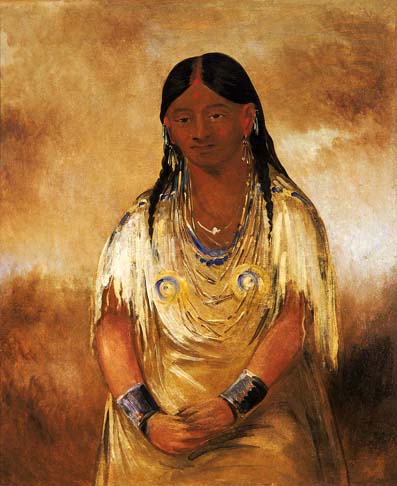
Mun-ne-o-ye,
a Woman: 1832

Na-pow-sa,
Bear Traveling at Night, a Chief: 1830
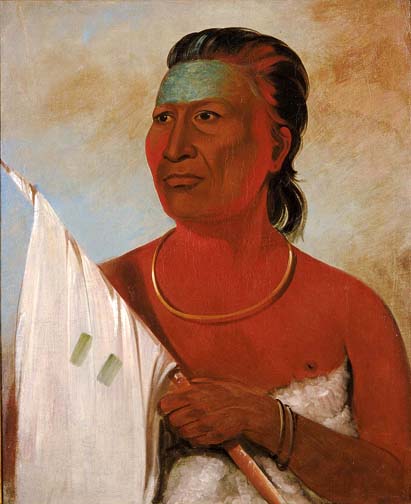
Náh-pope,
Soup, Adviser to Black Hawk: 1832
Donaldson quotes the following passage in describing the portrait: "When Mr. Catlin, the artist, was about taking the portrait of Soup, he seized the ball and chain that were fastened to his leg, and, raising them on high, exclaimed, with a look of scorn, 'Make me so, and show me to the Great Father'. On Mr. Catlin's refusing to paint him as he wished, he kept varying his countenance with grimaces to prevent him from catching a likeness" (Samuel G. Drake, Book of the Indians of North America, part 4 (Boston, 1832), p. 163).
Soup was second in command to Black Hawk during the war and brother of The Prophet, with whom he conspired to bring about the conflict.
Painted at Jefferson Barracks in October 1832. The Smithsonian and Field Museum portraits are similar in detail, but the modeling of the facial structure is stronger in the former. Soup also appears, full length, in cartoon 14, as a prisoner at Jefferson Barracks.
Quoted From: The Catlin Collection
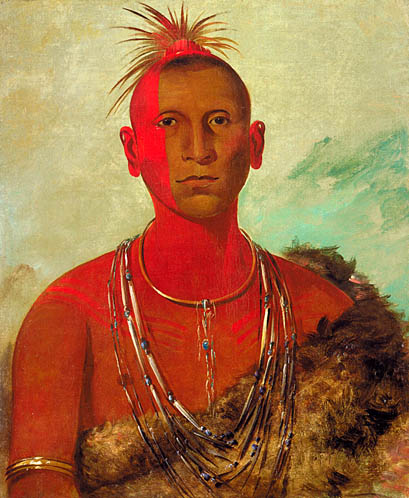
Náh-se-ús-kuk,
Whirling Thunder, Eldest Son of Black Hawk: 1832
"A very handsome young warrior, and one of the finest-looking Indians I ever saw. There is a strong party in the tribe that is anxious to put this young man up; and I think it more than likely that Kee-o-kuk as chief may fall ere long by his hand, or by some of the tribe who are anxious to reinstate the family of Black Hawk" (Letters and Notes, vol. II).
Whirling Thunder had distinguished himself in the Black Hawk War, but Catlin's prophecy did not come true.
Painted at Jefferson Barracks in October 1832. The Smithsonian portrait and plate 284 in Letters and Notes are identical except for the deer-hair crest worn by Whirling Thunder in the former. The crest does not appear in the Field Museum portrait, but that version differs from the others in that only a single metal loop is about Whirling Thunder's neck, and his features have not the definition or finish of the Smithsonian portrait. Except where noted, the remaining portraits in the O'Fallon collection at the Field Museum of Natural History follow this same pattern-they lack the detail and conviction of life portraits, and they are best accepted as versions painted by the artist a year or two after the originals. Catlin was a frequent guest at the Saint Louis home of Major Benjamin O'Fallon, nephew of William Clark and principal of the American Fur Company, who commissioned a group of Indian paintings from the artist in the early 1830's. The O'Fallon collection was sold to Chicago's Field Museum in 1894.
Whirling Thunder appears again, full length, in cartoon 14, with other Sauk and Fox prisoners at Jefferson Barracks, and he was later painted with his father by Charles Bird King and John Wesley Jarvis.
Quoted From: The Catlin Collection
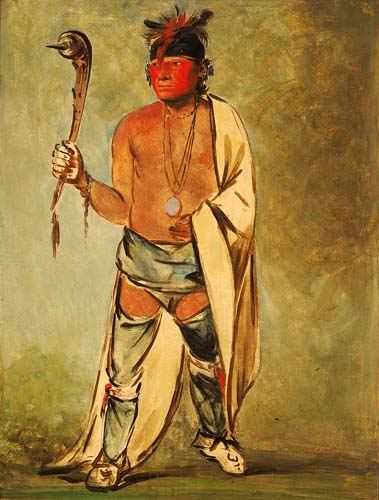
Naugh-haigh-hee-kaw,
He Who Moistens the Wood: 1828
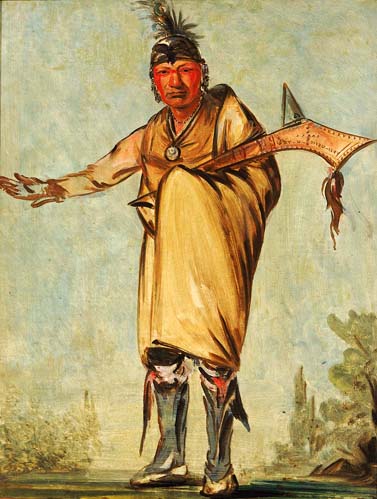
Náw-káw,
Wood, Former Chief of the Tribe: 1828

Naw-naw-pay-ee,
The Soldier: 1828
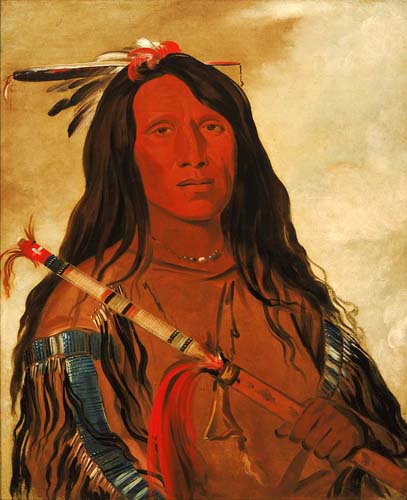
Né-hee-ó-ee-wóo-tis,
Wolf on the Hill, Chief of the Tribe: 1832
"The chief … was clothed in a handsome dress of deer skins, very neatly garnished with broad bands of porcupine quill-work down the sleeves of his shirt and his leggings, and all the way fringed with scalp-locks. His hair was very profuse, and flowing over his shoulders; and in his hand he held a beautiful Sioux pipe, which had just been presented to him by Mr. M'Kenzie, the Trader. This was one of the finest looking and most dignified men that I have met in the Indian country; and from the account given of him by the Traders a man of honor and strictest integrity" (Letters and Notes, vol. 2, p. 2, pl. 115).
Painted at Fort Pierre in 1832, as Catlin clearly indicates in Letters and Notes. Donaldson's date is incorrect. The basic modeling for such boldly painted Upper Missouri portraits must have been completed in a remarkably short time.
Wolf on the Hill appears again, full length, in cartoon 48 , with his wife and another Cheyenne.
Quoted From: The Catlin Collection
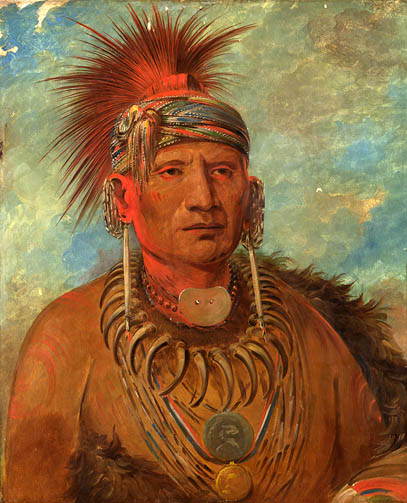
Neu-mon-ya,
Walking Rain, War Chief: 1844
Catlin describes Walking Rain as "54 years of age, and nearly six feet and a half in height," and claims that his earlier portrait of the war chief was then hanging in Egyptian Hall (Travels in Europe, vol. 2, pp. 2-3, 14, pl. 9.
Probably painted in London in 1844. Walking Rain's appearance in this second portrait only distantly corresponds to the first, but he clearly resembles the Iowa chief Neomanni in Charles Bird King's 1837 portrait. The technique of numbers 518 (Walking Rain, War Chief) and 519 (Fast Dancer, a Warrior) shows less studio restraint than the other examples in the Iowa series.
Walking Rain appears again in cartoon 60 (National Gallery of Art 2069).
Quoted From: The Catlin Collection
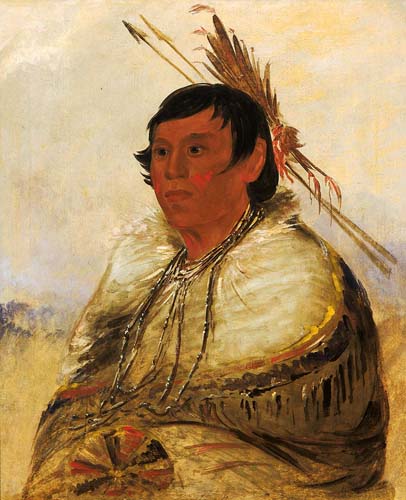
Ni-a-có-mo,
Fix With the Foot, a Brave: 1830
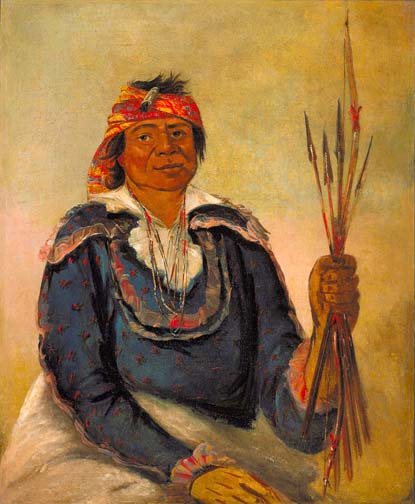
Ni-có-man,
The Answer, a Second Chief: 1830
Catlin further describes the subject as having "his bow and arrows in his hand" (Letters and Notes, vol. 2, pp. 100-3, pl. 197).
Probably painted at Fort Leavenworth in 1830. Note the similar garments of tufted material in numbers 241 and 245.
The Gilcrease portrait is half-length, and costume details are different in the Smithsonian original, which matches plate 197 of Letters and Notes.
Quoted From: The Catlin Collection
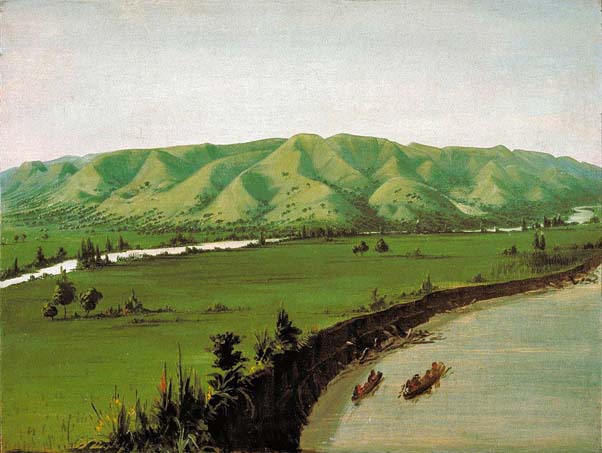
Nishnabottana Bluffs, 1070 Miles above Saint Louis: 1832

Nishnabottana Bluffs, Upper Missouri: 1832
Though Catlin usually described a life of adventure and excitement, he admitted that travel on the Plains could be exhausting and wearisome. "For two or three of the first days, the scenery was monotonous, and became exceedingly painful from the fact, that we were (to use a phrase of the country) 'out of sight of land', i.e. out of sight of anything rising above the horizon, which was a perfect straight line around us, like that of the blue and boundless ocean. The pedestrian over such a discouraging sea of green, without a landmark before or behind him; without a beacon to lead him on, or define his progress, feels weak and overcome when night falls; and he stretches his exhausted limbs, apparently on the same spot where he has slept the night before, with the same prospect before and behind him; the same grass, and the same wild flowers beneath and about him; the same canopy over his head, and the same cheerless sea of green to start upon in the morning" (Letters and Notes, Letter No. 27).
Catlin also notes that the constantly waving grasses can cause nausea akin to seasickness, a complaint that settlers traveling in their "prairie schooners" would later repeat.
Quoted From: Campfire Stories with George Catlin

No-ak-chóo-she-kaw,
He Who Breaks the Bushes: 1828
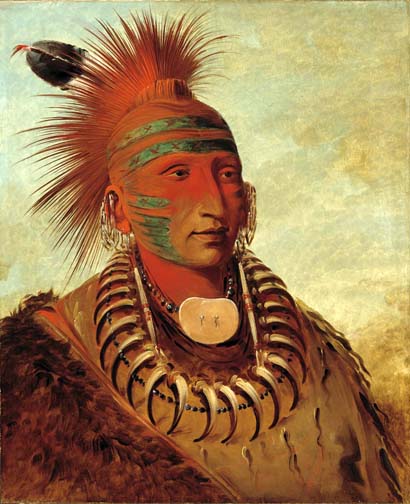
No-ho-mun-ya,
One Who Gives No Attention: 1844
Described by Catlin as "the finest looking man of the party," having "elegant" limbs and a "Herculean" frame. The subject was also called "Roman Nose," and he died in Liverpool before the Iowa delegation departed for Paris (Travels in Europe, vol. 2).
Probably painted in London in 1844. The portrait was previously catalogued as number 27, but the headdress is identical to those worn by the Iowa delegation, and the name Roman Nose seems particularly appropriate for the sitter. The style is similar to numbers 517 through 519.
The subject appears again in cartoon 60.
Quoted From: The Catlin Collection
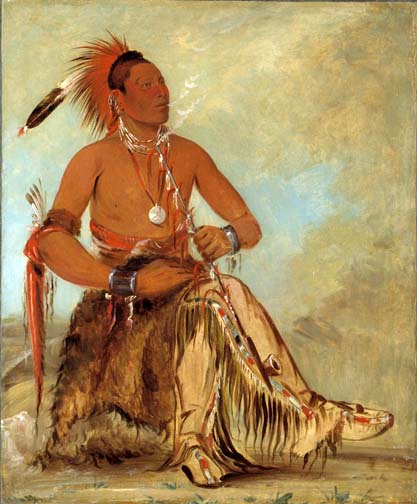
Nom-ba-mon-nee,
Double Walker, a Brave: 1832
Probably painted at Fort Leavenworth in 1832. Double Walker is supposed to appear again in cartoon 20, but the Smithsonian painting is so unlike the cartoon figure that the latter must be mislabeled, as is the watercolor in the Gilcrease Souvenir album, which is the original study for the cartoon.
The painting at Yale, another version of the cartoon figure, is identified as Double Walker in an inscription on the back by the artist, but the costume is so different from the other Omaha portraits that one is reluctant to accept even such direct evidence. Catlin's mistakes in naming the characters of the cartoon collection are legion.
Quoted From: The Catlin Collection
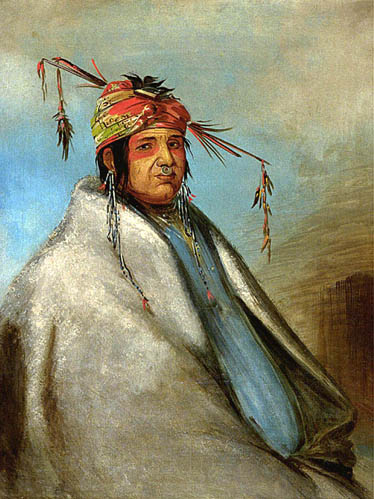
Non-on-dá-gon,
a Chief: 1830
"Non-on-da-gon was a leader of the Delaware tribe, also known as the Lenape tribes. After two centuries of forced relocations the Delaware had lost nearly ninety percent of its population by the 17th century. Catlin wrote a sympathetic account of the Delaware, who had been driven from their native lands of Eastern Pennsylvania, New Jersey, and Delaware; to the Ohio River; then to the Illinois River; and finally across the Missouri River to Fort Leavenworth, in present-day Kansas. "In every move the poor fellows have made, they have been thrust against their wills from the graves of their fathers and their children; and planted as they now are, on the borders of new enemies, where their first occupation has been to take up their weapons in self-defense, and fight for the ground they have been planted on."
SOURCE: George Catlin, Letters and Notes, vol. II
Quoted From: Campfire Stories with George Catlin
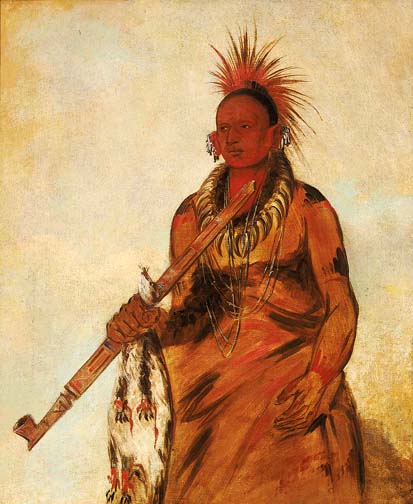
No-o-mún-nee,
Walks in the Rain, a Warrior: 1832
_1832.jpg)
Notch-ee-níng-a,
No Heart, (called White Cloud): 1832
No Heart (or White Cloud II) was the son of a distinguished chief of the same name, according to Catlin, but Frederick W. Hodge (McKenney and Hall, Vol. 1, p. 294) thinks that No Heart may have been the brother of White Cloud I, and therefore uncle of White Cloud II, principal chief of the fourteen Iowa Indians who visited England and France in 1844 and 1845. Hodge also speculates that No Heart and White Cloud II were brothers. Unfortunately, Charles Bird King's portraits of White Cloud I and No Heart (Notchimine) only add to the confusion, as neither appears to resemble this subject.
Catlin describes No Heart as "tastefully dressed with a buffalo robe wrapped around him, with a necklace of grizzly bear's claws on his neck; with shield, bow, and quiver on, and a profusion of wampum strings on his neck" (Letters and Notes, Vol. 2, p. 22, pl. 129).
Probably painted at Fort Leavenworth in 1832. Catlin's portraits of the civilized tribes settled near Leavenworth (Delaware, Shawnee) were apparently painted before those of the more primitive tribes living some distance beyond the fort (Iowa, Kansas, Missouri, Omaha Oto, and Pawnee). Although the Iowa portraits do not have the robust dimension of the Upper Missouri series, anatomy and costume details are more clearly articulated than in the loosely painted portraits of the civilized tribes. Under the circumstances, it seems best to assign the Iowa group to 1832, when Catlin encountered numerous members of the tribe encamped about Leavenworth.
The Gilcrease watercolor is an elaborately detailed version of the Smithsonian original. No Heart holds an arrow in his right hand in the watercolor and plate 129 of Letters and Notes. He appears again, full length, in cartoon 2, with his son and an Iowa brave.
Quoted From: The Catlin Collection
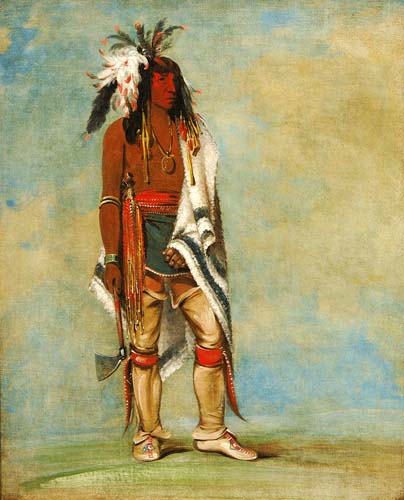
Nót-to-way,
a Chief: 1835
"Of this tribe I have painted but one. … This was an excellent man, and was handsomely dressed for his picture. … He seemed to be quite ignorant of the early history of his tribe, as well as of the position and condition of its few scattered remnants, who are yet in existence. … though he was an Iroquois, which he was proud to acknowledge to me … he wished it to be generally thought, that he was a Chippewa" (Letters and Notes, vol. 2, p. 107, pl. 206).
Probably painted at Fort Snelling in 1835, or near Sault Ste. Marie in 1836, as Catlin seems to imply that the subject was living with the Ojibwa. Furthermore, the relaxed stance and costume of the figure are similar to several portraits in the Ojibwa series, and the painting follows that series in numerical sequence in both the 1837 and 1848 catalogues. Donaldson's date of 1831 must again be based on Catlin's fictitious itinerary.
Nót-to-way also appears as An Iroquois in plate 1 of Catlin's North American Indian Portfolio, first published in 1844, and in cartoon 3 , with his wife and an Iroquois warrior, although Catlin said he painted only one member of the tribe. The original version of the cartoon figure is in the Gilcrease Souvenir album (pl. 32).
Quoted From: The Catlin Collection
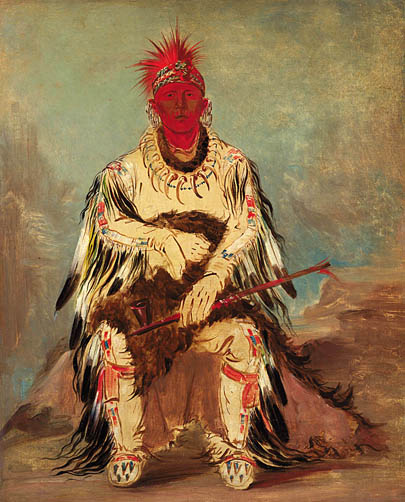
No-wáy-ke-súg-gah,
He Who Strikes Two at Once, a Brave: 1832
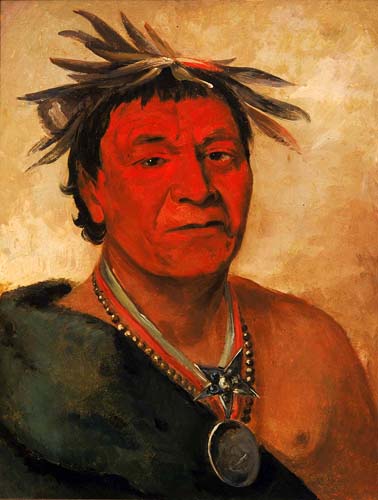
O-ho-páh-sha,
Small Whoop, a Distinguished Warrior: 1831

Ojibwa Portaging Around the Falls of Saint Anthony: 1835
"The Chippewa … were swiftly propelled by paddles to the Fall of Saint Anthony, where we had repaired to witness their mode of passing the cataract, by 'making (as it is called) the portage,' which we found to be a very curious scene; and was done by running all their canoes into an eddy below the Fall, and as near as they could get by paddling; when all were landed, and everything taken out of the canoes, and with them carried by the women, around the Fall, and half a mile or so above, where the canoes were put into the water again; and goods and chattels being loaded in, and all hands seated, the paddles were again put to work, and the light and bounding crafts upon their voyage" (Letters and Notes, vol. II).
Sketched at the Falls of Saint Anthony in 1835. The scene is repeated in cartoon 340.
Quoted From: The Catlin Collection
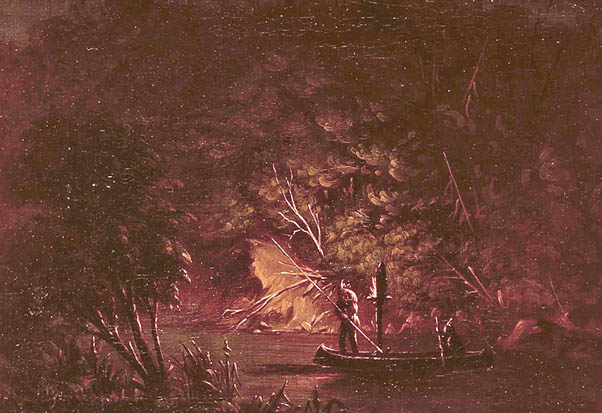
Ojibwe Spearing Salmon by Torchlight: 1846
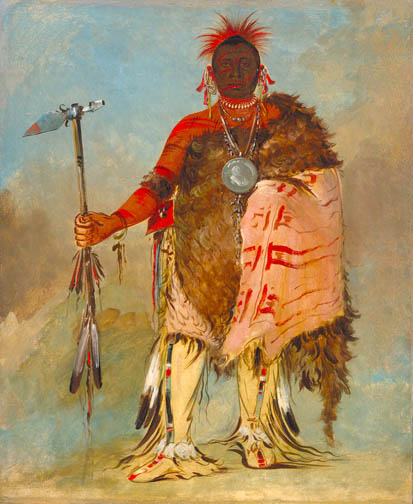
Om-pah-tón-ga,
Big Elk, a Famous Warrior: 1832
Big Elk sat for his portrait, according to Catlin, "with his tomahawk in his hand, and face painted black, for war" (Letters and Notes, vol. II).
Probably painted at Fort Leavenworth in 1832. Plate 146 in Letters and Notes is a duplicate of the Smithsonian painting, but the figure of Big Elk in cartoon 20 is so unlike the latter that the cartoon must be mislabeled. The Smithsonian painting actually resembles a figure at the extreme right of cartoon 23, who is identified in the 1871 catalogue as Mole in the Forehead.
Big Elk sat for Charles Bird King some years earlier in Washington.
Quoted From: The Catlin Collection

On-sáw-kie,
The Sauk, in the Act of Praying: 1830
Catlin describes The Sauk as "in the act of praying; his prayer written in characters on a maple stick" (1848 catalogue, p. 26).
Probably painted at Fort Leavenworth in 1830. No mention is made of Catlin visiting the Potawatomi in Illinois or Indiana. As the tribe was in the process of removing to lands near the fort, one would assume that numbers 237 through 239 were painted there, although neither Haberly nor more recent scholars (Ewers, McCracken, and Roehm) offer evidence to support their claim that Catlin and General Clark traveled together through Kansas in 1830. The artist was in the Saint Louis area that summer and fall, however, and it is possible that he could have made the trip to Leavenworth without attracting local attention. Records of the Bureau of Indian Affairs show that at least two subjects Catlin painted among these Great Lakes tribes were already living west of the Mississippi in 1830.
The technique of the Potawatomi portraits is much superior to the Winnebago series, but less assured than the vigorous Upper Missouri portraits of 1832. Thus, a date of 1830 seems reasonable for Catlin's visit to this tribe, and other Great Lakes tribes who were then settling near Fort Leavenworth. It must be acknowledged, however, that the artist made a well documented stop at the fort on his voyage down the Missouri in 1832, and he later claimed that he visited the Kansa villages, beyond Leavenworth, in the spring of 1831, although his travel recollections are notoriously inaccurate. Catlin's rapid improvement over these years is manifest in annual styles that may be a more dependable guide to the dates and locations of his paintings than any previously proposed schedule of his travels.
The Sauk's right hand and his necklaces have been omitted from the Gilcrease portrait, but feathers and braids have been added to his hair. The Smithsonian original is identical to plate 189 in Letters and Notes, and is a more vital and convincing likeness than the Gilcrease watercolor. The Sauk also appears, full length, in cartoon 73.
Quoted From: The Catlin Collection
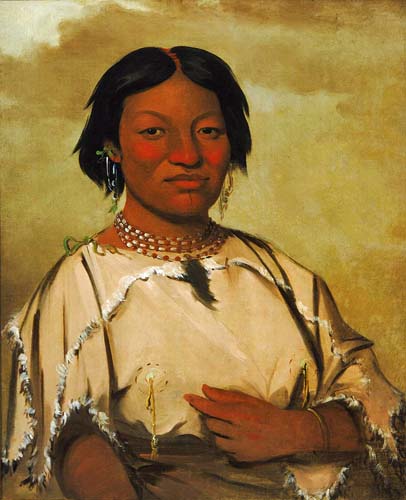
Oó-je-en-á-he-a,
Woman Who Lives in a Bear's Den: 1832
Catlin describes the subject as having her hair cut off in mourning (1848 catalogue, p. 22).
Painted at Fort Union in 1832. The full, strong features and direct gaze indicate a surprising rapport between subject and artist. The woman appears again, full length, in cartoon 27, with a blanket wrapped around her.
Quoted From: The Catlin Collection
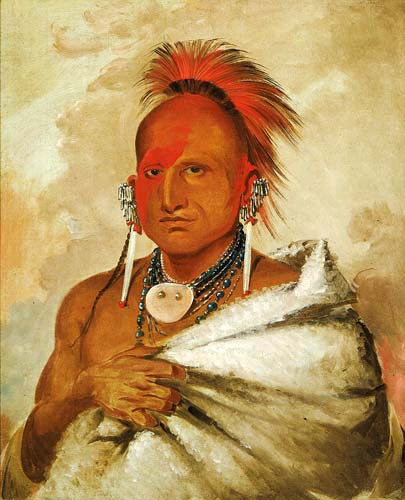
O-ron-gas-see,
Bear-catcher a Celebrated Warrior: 1832
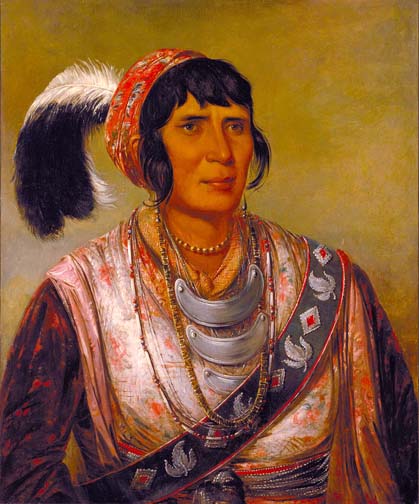
Os-ce-o-lá,
The Black Drink, a Warrior of Great Distinction: 1838
"Os-ce-o-la, commonly called Powell … is generally supposed to be a half-breed, the son (grandson) of a white man … and a Creek woman."
"I have painted him precisely in the costume, in which he stood for his picture, even to a string and a trinket. He wore three ostrich feathers in his head, and a turban made of a varicolored cotton shawl-and his dress was chiefly of calicos, with a handsome bead sash or belt around his waist, and his rifle in his hand."
"This young man is, no doubt, an extraordinary character, as he has been for some years reputed, and doubtless looked upon by the Seminoles as the master spirit and leader of the tribe, although he is not a chief. From his boyhood, he had led an energetic and desperate sort of life, which had secured for him a conspicuous position in society; and when the desperate circumstances of war were agitating his country, he at once took a conspicuous and decided part; and acquired an influence and a name that soon sounded to the remotest parts of the United States, and among the Indian tribes, to the Rocky Mountains."
"This gallant fellow, who was, undoubtedly, captured a few months since, with several of his chiefs and warriors, was at first brought in to Fort Mellon in Florida, and afterwards sent to this place (Fort Moultrie) for safe-keeping, where he is grieving with a broken spirit, and ready to die, cursing white man, no doubt, to the end of his breath."
"In stature he is about at mediocrity, with an elastic and graceful movement; in his face he is good looking, with rather an effeminate smile; but of so peculiar a character, that the world may be ransacked over without finding another just like it. In his manners, and all his movements in company, he is polite and gentlemanly, though all his conversation is entirely in his own tongue; and his general appearance and actions, those of a full-blooded and wild Indian" (Letters and Notes, vol. II).
Catlin believed that the tragic conclusion of the Seminole war, and the subsequent death of Osceola, were glaring examples of the government's misguided and inhuman Indian removal policy. The portraits of Osceola became one of the artist's major efforts to dramatize the effects of that policy, when one or both were exhibited at the Stuyvesant Institute February 6, 1838 (see New York Evening Star).
Osceola's fair skin and refined, almost delicate features came from his paternal grandfather, a Scotsman who had married a Creek woman. Catlin has noted and adjusted these characteristics in such a way as to cast the Seminole warrior as a model of studio perfection, even if the likeness is somewhat in contrast to a bust after a death mask of Osceola illustrated in Matthews. With flawless, even-textured strokes, Catlin builds the head to a full, sculptural dimension that resembles neoclassical portraits of a generation earlier. The artist occasionally reverts to the broader brushwork of the other Seminole portraits in Osceola's costume, but textures and details stand out with an elegance and precision rarely matched in the series.
Catlin says little about the abrupt change of style in the Osceola portrait. Clearly he wished to achieve a work of solid academic merit, in contrast to the rapidly brushed studies that he had done in the West. But he must have also wished to present Osceola as something more acceptable to the public than an Upper Missouri savage. Catlin's solution was to convert the Seminole into a character who might have stepped from the pages of a Chateaubriand novel-a true Chactas, the prince of an exotic Indian nation. By so doing he hoped to create an image that would evoke sympathy from the public and from those responsible for a national policy that would eventually destroy such a distinctive culture.
Goggin reviews McCarthy's findings and discusses the portraits of Osceola by Catlin, J. R. Vinton, R. J. Curtis, and others. Catlin's work is accepted as a reasonably accurate description of the Subject and his costume. Catlin says in the letter to C. A. Harris, Commissioner of Indian Affairs, that he intends to make copies of the Seminole portraits for the "Indian Department," but none are known today. The Gilcrease painting is a roughly executed copy by an unknown artist after the Smithsonian original.
Quoted From: The Catlin Collection
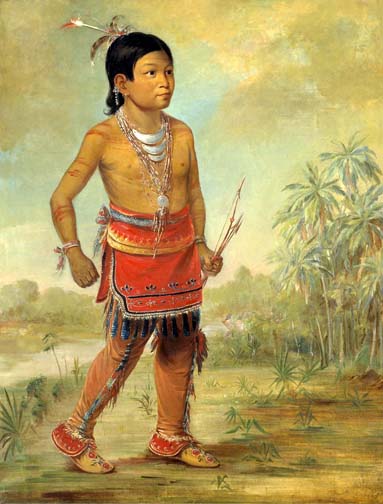
Osceola Nick-a-no-chee, a Boy: 1840

O-ta-wah,
The Ottaway, a Warrior: 1835
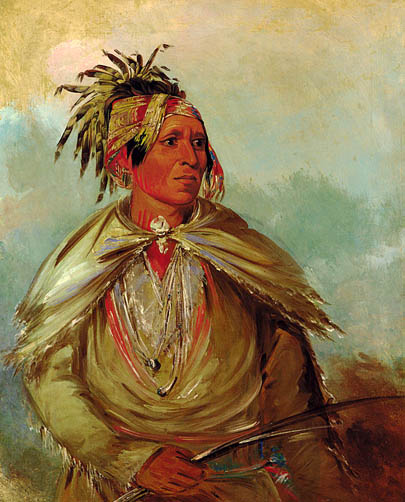
Pah-mee-ców-ee-tah,
Man Who Tracks, a Chief: 1830
"Of this tribe I painted the portraits of … (Man Who Tracks and No English). These are said to be the most influential men in the tribe, and both were very curiously and well dressed, in articles of civilized manufacture" (Letters and Notes, vol. II).
Catlin further describes the subject as having a "remarkably fine head" (1848 catalogue, p. 27).
Probably painted at Fort Leavenworth in 1830. The broad sweeps of pigment are again close to the technique used by Catlin in the Potawatomi and Kickapoo portraits.
"Although the subject is only half-length and costume details are somewhat different, the Gilcrease watercolor is a close interpretation of the Smithsonian original. The latter matches plate 193 in Letters and Notes. Man Who Tracks appears again, full length, in cartoon 58, with his wife and a Peoria "dandy."
Quoted From: The Catlin Collection
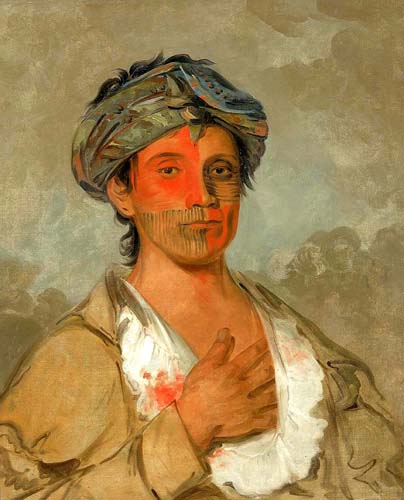
Pah-te-coo-saw,
Straight Man, Semicivilized: 1830
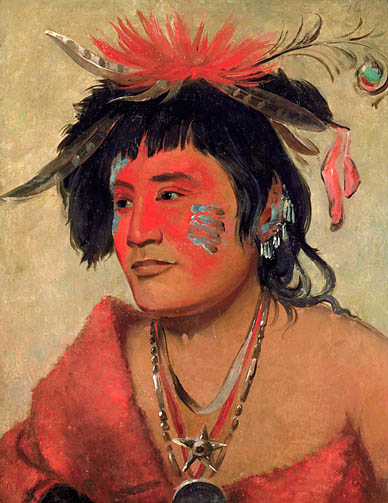
Pah-shee-náu-shaw,
a Warrior: 1831
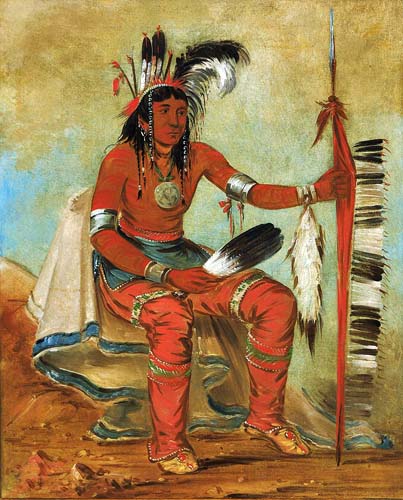
Pah-ta-cóo-chee,
Shooting Cedar, a Brave: 1832
"(Shooting Cedar and Busy Man) are also distinguished warriors of the tribe; tastefully dressed and equipped, the one with his war-club on his arm, the other with bow and arrows in his hand; both wore around their waists beautiful buffalo robes, and both had turbans made of varicolored cotton shawls, purchased of the Fur Traders. Around their necks were necklaces of the bears' claws, and a profusion of beads and wampum. Their ears were profusely strung with beads; and their naked shoulders curiously streaked and daubed with red paint" (Letters and Notes, vol. 2).
Probably painted at Fort Leavenworth in 1832. The Gilcrease and Smithsonian portraits are similar in appearance, but the former is a weak version of the latter. The subject is incorrectly identified as Wos-cóm-mun (Busy Man) in the Gilcrease catalogue.
Shooting Cedar appears again, full length, in cartoon 2.
Quoted From: The Catlin Collection
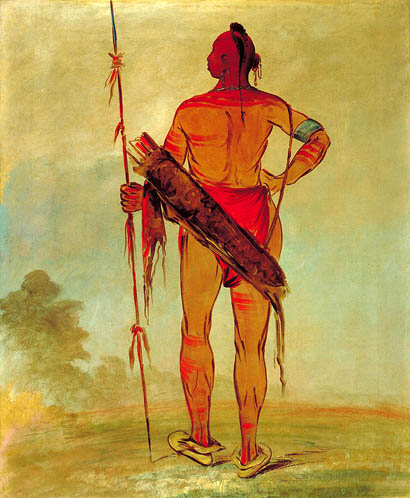
Pa-hu-sha,
White Hair, the Younger, a Band Chief: 1834
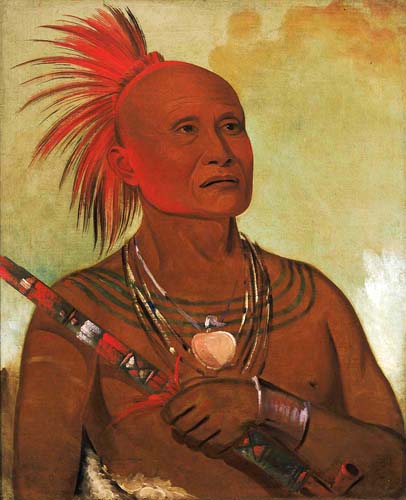
Pam-a-hó,
The Swimmer, One of Black Hawk's Warriors: 1832
Donaldson quotes the following description of the subject: "Fast-Swimming Fish is a short, thick-set, good-natured old brave, who bears his misfortunes with a philosophy worthy of the ancients" (Samuel G. Drake, Book of the Indians of North America, part 4 (Boston, 1832), p. 164).
Painted at Jefferson Barracks in October 1832. The Swimmer wears no necklaces or bracelet in the Field Museum portrait. He appears again, full length, in cartoon 14, with other prisoners from Jefferson Barracks, and by himself in cartoon 121, which may be an oil-on-canvas version of the original portrait.
Quoted From: The Catlin Collection

Pa-rís-ka-róo-pa,
Two Crows, a Chief: 1832

Pa-rís-ka-roo-pa,
Two Crows, a Band Chief: 1832
"I have also secured portraits of (the two subjects) … fine and fair specimens of this tribe, in both of which are exhibited the extraordinary instances of the natural hair reaching to the ground, peculiarities belonging almost exclusively to this tribe. … The Crows are generally handsome, and comfortably clad; every man in the nation oils his hair with a profusion of bear's grease, and promotes its growth to the utmost of his ability.…
"In a former letter I gave some account of the head peculiar to this tribe, which may well be recorded as a national characteristic. … This striking peculiarity is quite conspicuous in the two portraits of which I have just spoken, exhibiting fairly, as they are both in profile, the semi-lunar outline of the face. … The greater part of the men are thus strongly marked with a bold and prominent anti-angular nose, with a clear and rounded arch, and a low and receding forehead" (Letters and Notes, vol. 1, p. 193, p1s. 77, 78).
Painted at the Hidatsa village in 1832. These two portraits, among the finest of the Upper Missouri series, represent the sum of Catlin's admiration for the tall and elegant Crow warriors.
In the Field Museum version, the robe of the subject lacks certain decorative details and his profile is a hasty caricature of the Smithsonian original. Otherwise, the two oils and the Gilcrease watercolor closely resemble one another and plate 77 in Letters and Notes. Cartoon 122 may be another oil-on-canvas version of number 163.
Catlin must have inadvertently reversed the plate numbers for the two subjects in his text. He describes Two Crows correctly in the 1848 catalogue as wearing a "head-dress made of the eagle's skin entire" and holding "his lance and two medicine-bags."
Two Crows appears again in cartoon 27, with his wife and several Crow warriors. He Who Ties His Hair Before is shown in cartoon 25, which is based on a watercolor (pl. 24) in the Gilcrease Souvenir album.
Quoted From: The Catlin Collection
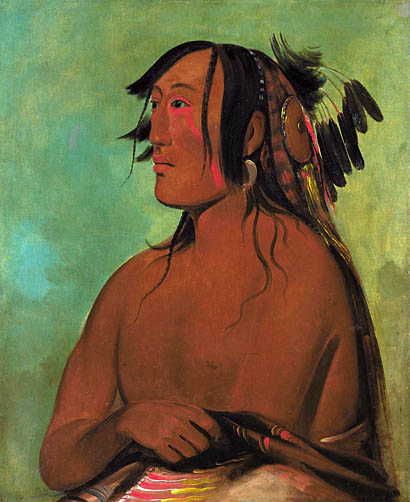
Pa-ris-ka-roo-pa,
Two Crows, the Younger: 1832

Pash-ee-pa-hó,
Little Stabbing Chief, a Venerable Sauk Chief: 1835
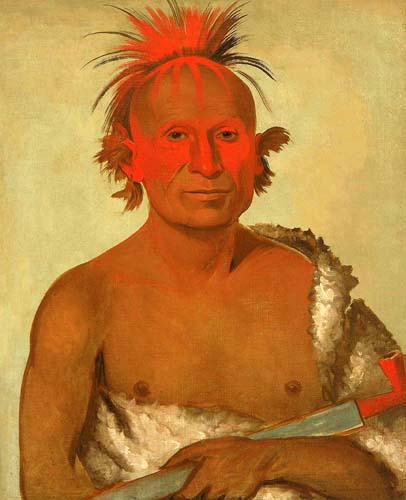
Pash-ee-pa-hó,
Little Stabbing Chief, the Younger, One of Black Hawk's Braves: 1832
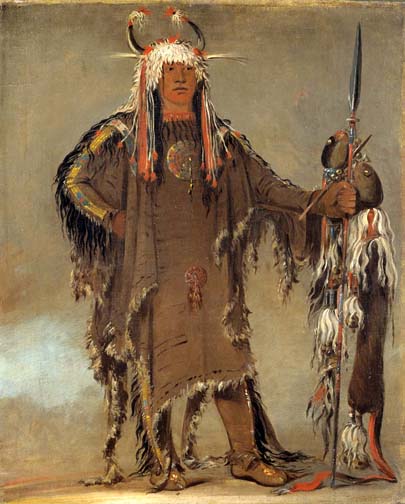
Peh-tó-pe-kiss,
Eagle's Ribs, a Piegan Chief: 1832
"This man is one of the extraordinary men of the Blackfoot tribe; though not a chief, he stands here in the Fort, and deliberately boasts of eight scalps, which he says he has taken from the heads of trappers and traders with his own hand. His dress is really superb, almost literally covered with scalp locks, of savage and civil.
"I have painted him at full length, with a headdress made entirely of ermine skins and horns of the buffalo. This custom of wearing horns beautifully polished and surmounting the head-dress, is a very curious one, being worn only by the bravest of the brave; by the most extraordinary men in the nation. … When he stood for his picture, he also held a lance and two 'medicine-bags' in his hand" (Letters and Notes, vol. 1, pp. 30, 34, pl. 14).
Painted from life at Fort Union in 1832, according to a certificate signed by John Sanford, Indian agent, that survives in Smithsonian files. The certificate also states that Catlin accurately reproduced the costume worn by the sitter.
Quoted From: The Catlin Collection
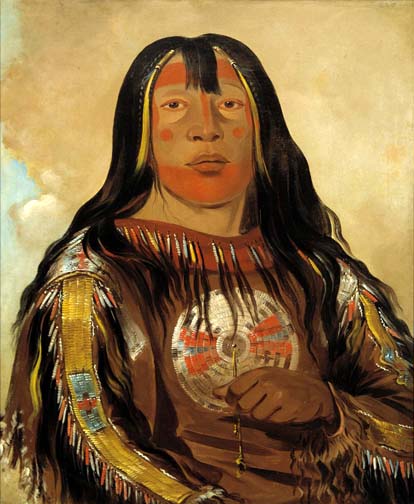
Peh-tó-pe-kiss,
Eagle's Ribs, a Piegan Chief: 1832
Painted at Fort Union in 1832. Eagle's Ribs is also the subject of a more elaborate full-length portrait by Catlin.
Quoted From: The Catlin Collection

Picturesque Bluffs above Prairie du Chien: 1835
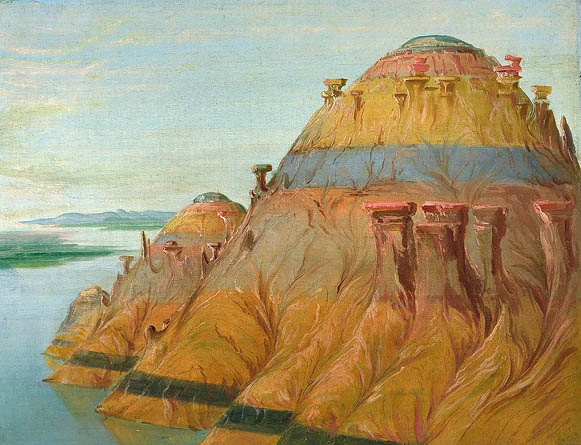
Picturesque Clay Bluff, 1700 Miles above Saint Louis: 1832
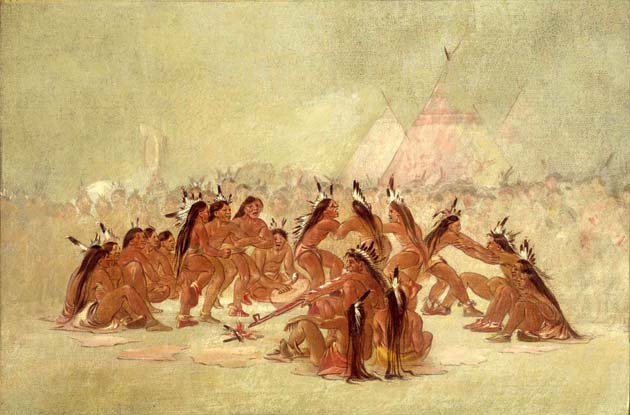
Pipe Dance, Assiniboine: 1835
"One of these scenes … appeared to me to be peculiar to this tribe, and exceedingly picturesque in its effect. … On a half-trodden pavement in front of their village … the young men, who were to compose the dance, had gathered themselves around a small fire, and each one seated on a buffalo-robe spread upon the ground. In the center and by the fire, was seated a dignitary, who seemed to be a chief … with a long pipe in his hand, which he lighted at the fire and smoked incessantly, grunting forth at the same time, in half-strangled gutturals, a sort of song. … While this was going on, another grim-painted fellow in another part of the group, commenced beating on a drum or tambourine, accompanied by his voice; when one of the young men seated, sprang instantly on his feet, and commenced singing in time with the taps of the drum, and leaping about on one foot and the other in the most violent manner imaginable. In this way he went several times around the circle, bowing and brandishing his fists in the faces of each one who was seated, until at length he grasped one of them by the hands, and jerked him forcibly up upon his feet; who joined in the dance for a moment, leaving the one who had pulled him up, to continue his steps and his song in the centre of the ring; while he danced around in a similar manner, jerking up another … and so on … until all were upon their feet" (Letters and Notes, vol. 1, p. 55, pl. 32).
Sketched at Fort Union in 1832. The scene is repeated in cartoon 159.
Quoted From: The Catlin Collection
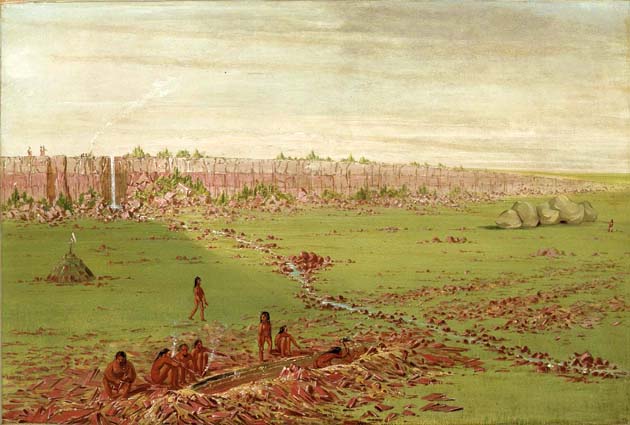
Pipestone Quarry on the Coteau des Prairies
"You see (holding a red pipe to the side of his naked arm) that this pipe is a part of our flesh. The red men are a part of the red stone. ('How, how!') "If the white men take away a piece of the red pipe stone, it is a hole made in our flesh, and the blood will always run. We cannot stop the blood from running" (Letters and Notes, Letter No. 54).
The land and the buffalo were not only home and livelihood to the Plains Indians, they were sacred. In religious ceremonies, they danced to the buffalo to supplicate for success in hunting and spilled their blood on the ground to prove their worthiness as warriors and hunters. They had particular reverence for the quarry at Coteau des Prairies, where plains tribes obtained the red stone to make ceremonial pipes. Catlin remarked, "The Indians have an idea that this red stone is a part of their flesh, that they were created from it and that it would be sacrilegious and impious, to convert it to any other use than the pipe, which is used for peace-making and conciliating to the Great Spirit."
Many Indian friends told Catlin that visiting this site near the headwaters of the Mississippi would violate "religious privileges". Catlin nonetheless concluded that his need to satisfy his scientific curiosity outweighed Indian opposition. He made the trip and brought back a sample of the pipestone for chemical analysis, with the following results: " Chemical Analysis of the Red Pipe Stone, brought by George Catlin, from the Couteau des Prairies, in 1836: Water 8.4, Silica 48.2, Alumina 28.2, Magnesia 6.0, Peroxide of iron 5.0, Oxide of manganese .06, 99.0, Loss (probably magnesia) 1.0. Total 100.0" (Letters and Notes, Letter No. 55). Scientists christened the stone "catlinite" in his honor.
Quoted From: Campfire Stories with George Catlin
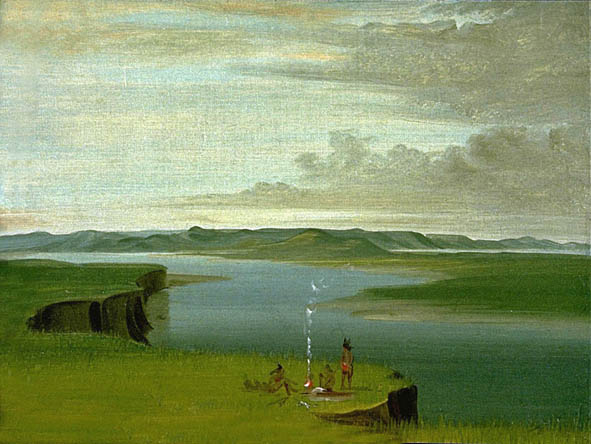
Prairie Bluffs at Sunrise, near the Mouth of the Yellowstone River: 1832
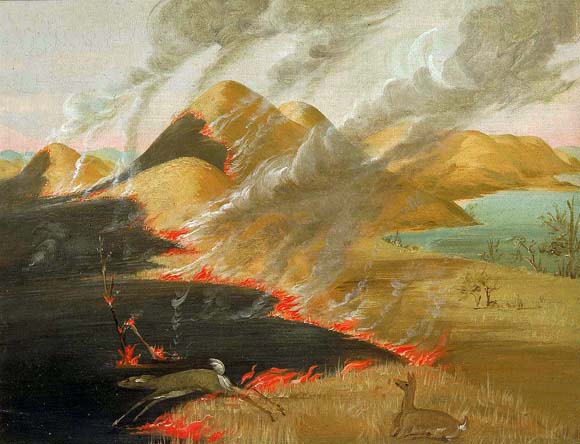
Prairie Bluffs Burning: 1832
Grassland both invites and depends on fire to sustain the ecosystem. After the perennial grasses dry during the late summer and fall, they could ignite with a mere spark; the leaves burned and the roots remained, holding the soil safe from erosion. Catlin observed, "The prairies burning form some of the most beautiful scenes that are to be witnessed in this country, and also some of the most sublime. Every acre of these vast prairies . . . burns over during the fall or early in the spring, leaving the ground of a black and doleful colour" (Letters and Notes, Letter No. 33).
Catlin also distinguished between fires in a tall grass prairie and the drier short grass prairies further south and west. The most dramatic fires occurred in the tall grass, where prairie grasses grew as tall as men. Catlin described such a conflagration as a "raging tempest . . . rolling over the land its swelling waves of liquid fire." Prairie fires were a quick way of clearing last year's dead grass, while returning nutrients to the soil to nourish the new growth. Sometimes natural and sometimes set by Indians, the blazes maintained prairie environments by clearing out saplings, shrubs, and dead brush.
Quoted From: Campfire Stories with George Catlin
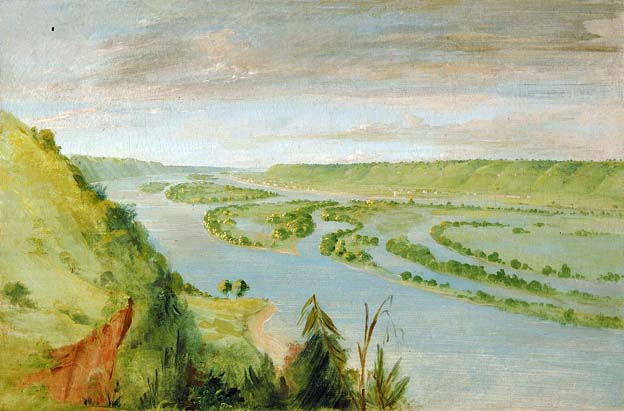
Prairie du Chien,
United States Garrison: 1835
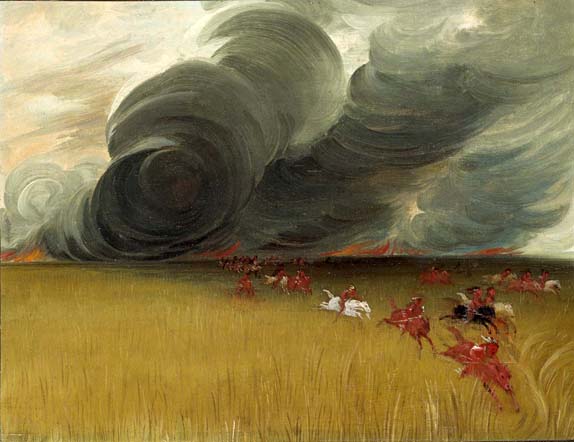
Prairie Meadows Burning: 1832
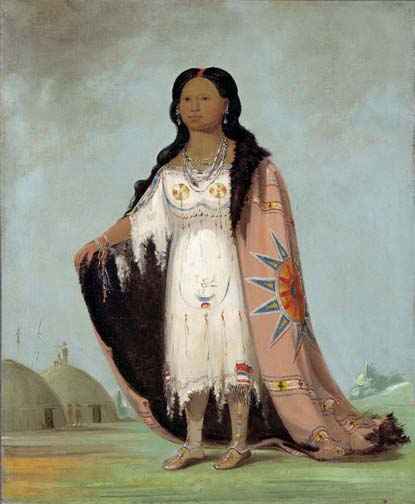
Pshán-shaw,
Sweet-Scented Grass, Twelve-year-old Daughter of Bloody Hand: 1832
This portrait, according to Catlin, gives "a very pretty specimen of the dress and fashion of the women in this tribe. The inner garment, which is like a slip or frock, is entire in one piece, and beautifully ornamented with embroidery and beads, with a row of elks' teeth passing across the breast, and a robe of the young buffalo's skin, tastefully and elaborately embroidered, gracefully thrown over her shoulders, and hanging down to the ground behind her" (Letters and Notes, vol. 1, p. 204, pl. 84).
Painted at the Arikara village in 1832. The Smithsonian and Gilcrease portraits are identical, except for two earth lodges in the background of the former that are also included in plate 84 of Letters and Notes. The Gilcrease oils were done by Catlin for Sir Thomas Phillips in the late 1840's and early 1850's, and they are clearly acknowledged as later versions of his original paintings. Sweet-scented Grass appears again in cartoon 37.
Quoted From: The Catlin Collection
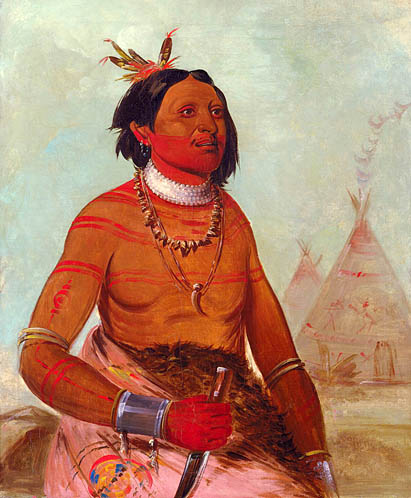
Quáy-hám-kay,
Stone Shell, a Brave: 1834
Stone Shell "is another fair specimen of the warriors of this tribe," Catlin writes, "and … somewhat allied to the mysteries and arcana of the healing art, from the close company he keeps with my friend Dr. Findley, who is surgeon to the regiment, and by whom I have been employed to make a copy of my portrait of this distinguished personage" (Letters and Notes, vol. 2).
Painted at the Comanche village in 1834. Stone Shell lacks his knife in the Gilcrease watercolor, no skin lodges appear behind him, and his headdress and jewelry are greatly changed.
Quoted From: The Catlin Collection
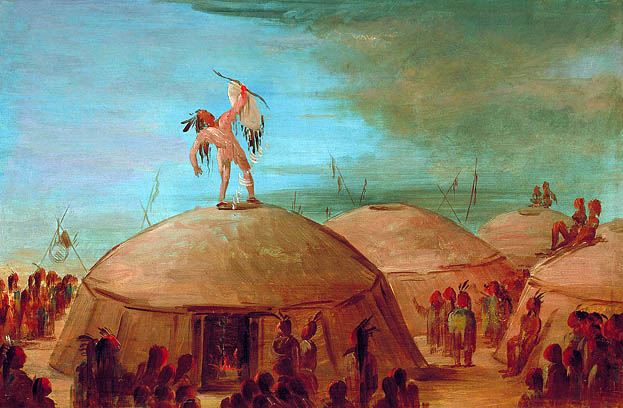
Rainmaking among the Mandan: 1837
"Medicine-men performing their mysteries inside of the lodge, and young men volunteer to stand upon the lodge from sunrise until dawn, in turn, commanding it to rain."
"Each one has to hazard the disgrace which attaches (when he descends at sundown) to a fruitless attempt; and he who succeeds acquires a lasting reputation as a Mystery or Medicine man" (1848 catalogue, p. 44).
Catlin describes the ritual at great length in Letters and Notes (vol. I).
A rough drawing of the scene, presumably made at the Mandan village in 1832, appears in the SI sketchbook, but the painting is not listed in the 1837 catalogue.
The scene is repeated in cartoon 186 (Collection of Mr. and Mrs. Paul Mellon) with additional figures and earth lodges.
Quoted From: The Catlin Collection
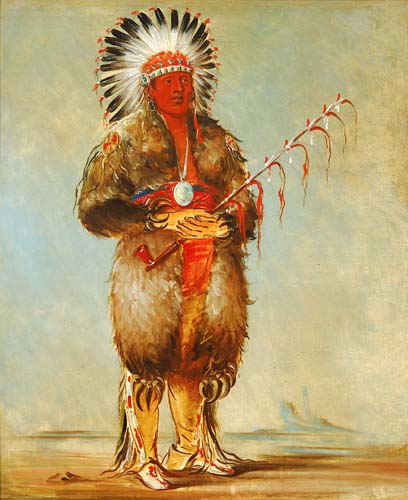
Ráw-no-way-wóh-krah,
Loose Pipestem, a Brave: 1832
Catlin describes the subject as "full length … in a tunic made of the entire skin of a grizzly bear, with a head-dress of war-eagle's quills" (Letters and Notes, vol. II).
Probably painted at Fort Leavenworth in 1832. Plate 33 in Donaldson represents Loose Pipestem, and he appears again in cartoon 19, which is based on a watercolor in the Gilcrease Souvenir album.
Quoted From: The Catlin Collection
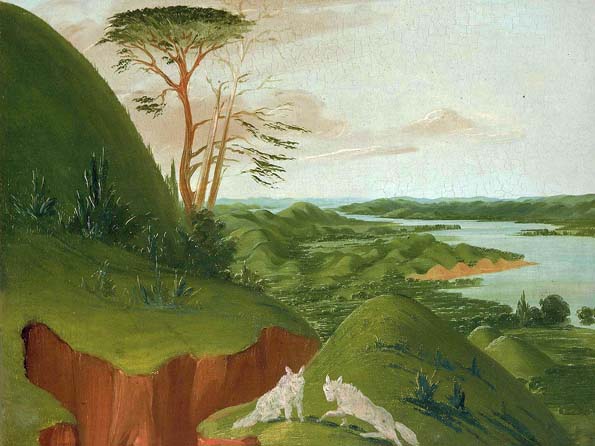
River Bluffs with White Wolves in the Foreground,
Upper Missouri: 1832
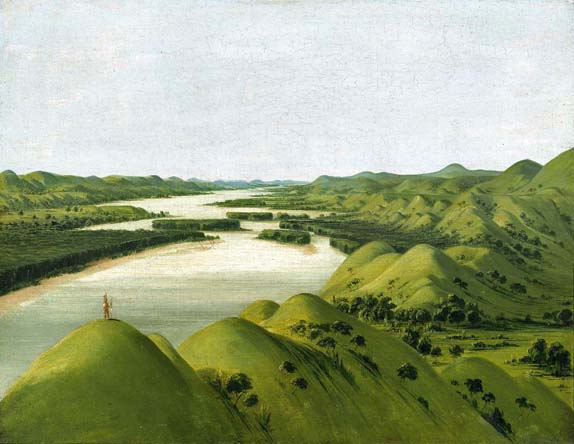
River Bluffs,
1320 Miles Above St. Louis: 1832
The figure of the lone Indian on the top of the sunlit bluff had nostalgic overtones even in Catlin's time. This dreamy view of the Upper Missouri gives us a glimpse of a now-lost world. Indians had shaped this landscape by setting fires that curbed tree growth; when the Indians left the area, the "beautiful clear-cut outlines of these billowy slopes" were gone, too.
Quoted From: Campfire Stories with George Catlin

Round Island, a Warrior: 1831
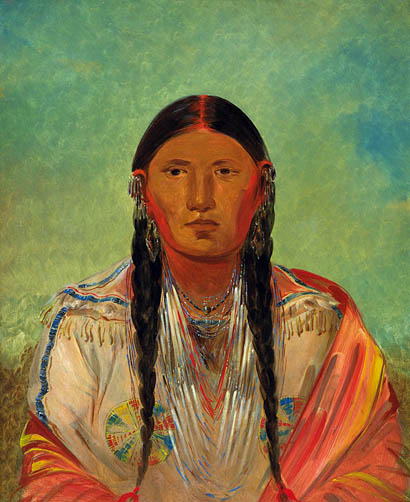
Ru-ton-wee-me,
Pigeon on the Wing: 1844

Ru-ton-ye-wee-ma,
Strutting Pigeon, Wife of White Cloud: 1844
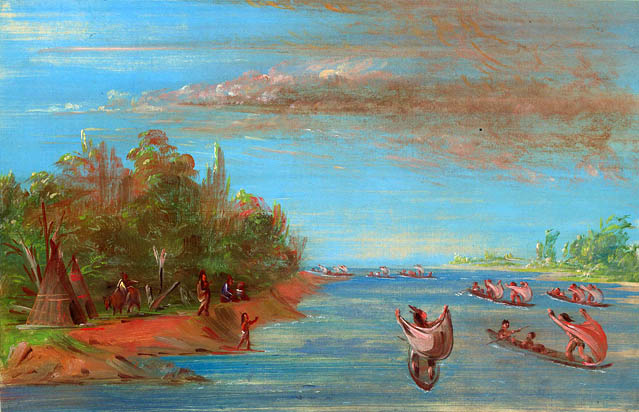
Sac and Fox Sailing in Canoes: 1837
"I was often amused at their freaks in their canoes, while travelling; and I was induced to make a sketch of one which I frequently witnessed, that of sailing with the aid of their blankets, which the men carry; and when the wind is fair, stand in the bow of the canoe and hold by two corners, with the other two under the foot or tied to the leg; while the women sit in the other end of the canoe, and steer it with their paddles" (Letters and Notes, vol. II).
Sketched in 1835 near the Sauk and Fox village, but the painting is not included in the 1837 catalogue. The abbreviated technique is similar to number 477.
The scene is repeated in cartoon 199 (Collection of Mr. and Mrs. Paul Mellon).
Quoted From: The Catlin Collection
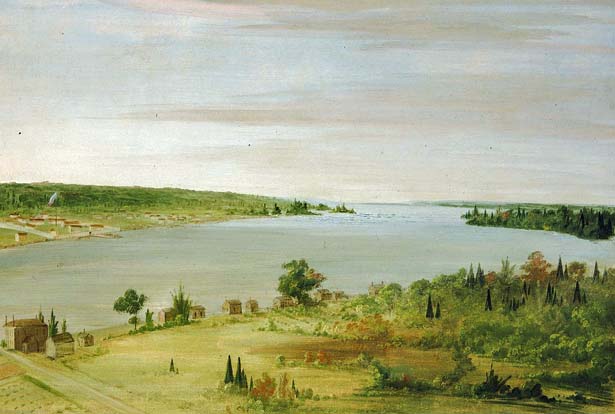
Sault Ste. Marie,
Showing the United States Garrison in the Distance: 1836
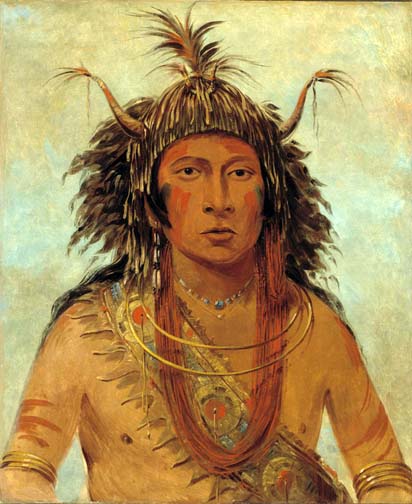
Say-say-gon,
Hail Storm, War Chief: 1845
Described by Catlin in Travels in Europe as "a fine and intelligent Indian," thirty-one years old.
The eleven Canadian Ojibwa (subsequently increased to twelve by the birth of a papoose) arrived in Paris in the late summer of 1845, having heard of the Iowa's successful engagement, and they soon replaced the latter on the stage of the Salle Valentino. In early October the Ojibwa entertained Louis Philippe and the royal family at Saint-Coud with ball games and dances, and the king reciprocated by asking Catlin to display the Indian Gallery in the Salle de Séance at the Louvre. After moving the collection to the palace, Catlin took the Ojibwa to Belgium for a series of appearances, but several contracted smallpox in Brussels, and the remainder of the tour was canceled. Catlin parted from the group in Antwerp in January 1846.
Painted in Paris in 1845. This series of Ojibwa portraits seems to have been executed with haste and some indifference. They have neither the finish nor the vigorous appearance of the Iowa group, and Catlin has not always probed the bland features of the subjects for an individual interpretation.
The Gilcrease version is taken from a slightly different angle than the Smithsonian portrait, costume details vary between the two, and the former is more carefully painted. If both portraits are life studies, the Gilcrease version must have been painted some years before the other examples that Catlin supplied to Sir Thomas Phillips. Catlin lists another portrait of Hail Storm among those commissioned by Louis Philippe in 1845.
The subject is incorrectly listed under the Osage tribe in the Gilcrease catalogue. He appears again in cartoon 61, with the entire Ojibwa delegation.
Quoted From: The Catlin Collection
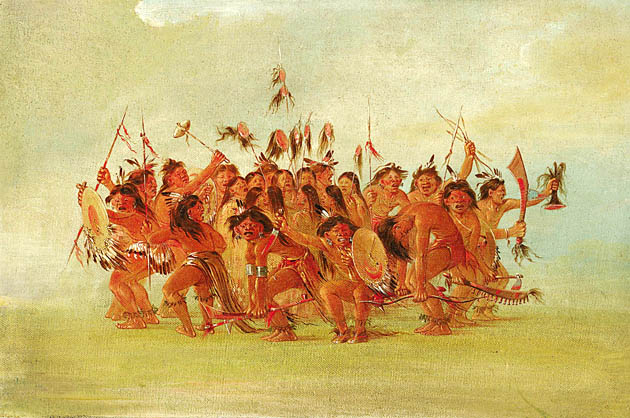
Scalp Dance,
Mouth of the Teton River: 1835
"The Scalp-dance is given as a celebration of a victory; and among this tribe, as I learned while residing with them, danced in the night, by the light of their torches, and just before retiring to bed. When a war party returns from a war excursion, bringing home with them the scalps of their enemies, they generally 'dance them' for fifteen nights in succession, vaunting forth the most extravagant boasts of their wonderful prowess in war, while they brandish their war weapons in their hands. A number of young women are selected to aid (though they do not actually join in the dance), by stepping into the center of the ring, and holding up the scalps that have been recently taken, while the warriors dance (or rather jump), around in a circle, brandishing their weapons, and barking and yelping in the most frightful manner, all jumping on both feet at a time, with a simultaneous stamp, and blow, and thrust of their weapons; with which it would seem as if they were actually cutting and carving each other to pieces. During these frantic leaps, and yelps, and thrusts, every man distorts his face to the utmost of his muscles, darting about his glaring eye-balls and snapping his teeth, as if he were in the heat (and actually breathing through his inflated nostrils the very hissing death) of battle! No description that can be written, could ever convey more than a feeble outline of the frightful effects of these scenes enacted in the dead and darkness of night, under the glaring light of their blazing flambeaux" (Letters and Notes, vol. I).
Sketched near Fort Pierre in 1832. The Smithsonian version, which in size and finish closely resembles the paintings commissioned by Louis Philippe, appears to be the night scene described by Catlin in the above passage. A moon and torches illuminate the circle of dancers, who are surrounded by other members of the tribe. Skin lodges and trees loom in the background. The dramatic setting was meant to appeal to European audiences, who may have found the Smithsonian original, with its absence of stage props, a bit too anthropological. The latter matches plate 104 in Letters and Notes.
Quoted From: The Catlin Collection
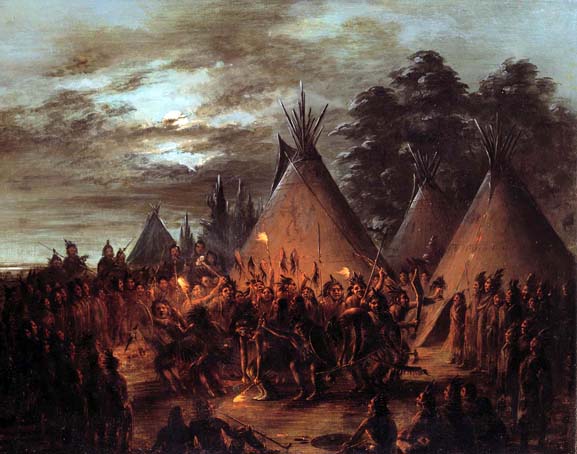
Scalp Dance, Sioux: 1845
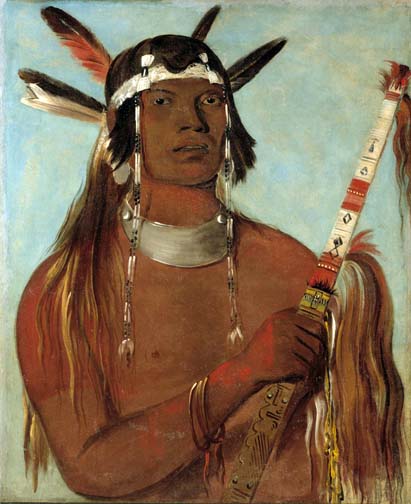
Seehk-hée-da,
Mouse-colored Feather, a Noted Brave: 1832
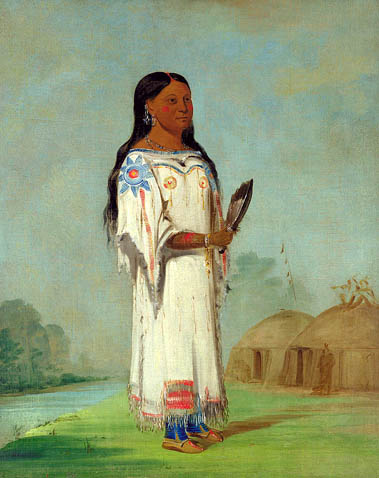
Seet-sé-be-a,
Midday Sun, a Pretty Girl: 1832
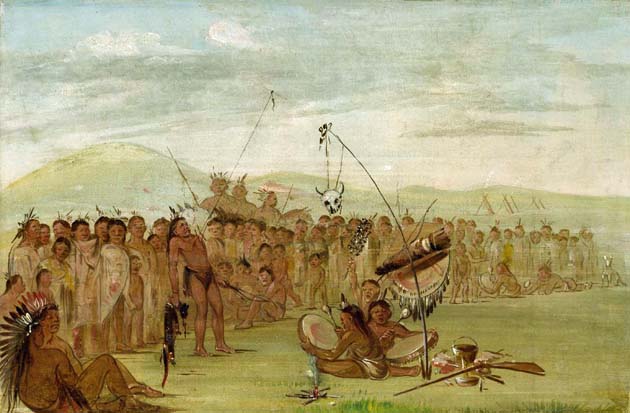
Self-Torture in a Sioux Religious Ceremony: 1835
"I was called upon by one of the clerks at Fort Pierre … to ride up a mile or so, near the banks of the Teton River … to see a man (as they said) 'looking at the sun'! We found him naked, except his breech-cloth, with splints or skewers run through the flesh on both breasts, leaning back and hanging with the weight of his body to the top of a pole which was fastened in the ground, and to the upper end of which he was fastened by a cord which was tied to the splints. In this position he was leaning back, with nearly the whole weight of his body hanging to the pole, the top of which was bent forward, allowing his body to sink about half-way to the ground. In this condition, with the blood trickling down over his body, which was covered with white and yellow clay, and amidst a great crowd who were looking on, sympathizing with and encouraging him, he was to stand and look at the sun, from its rising in the morning 'till its setting at night; at which time, if his heart and his strength have not failed him, he is 'cut down', receives the liberal donation of presents and also the name and the style of a doctor, or medicine-man, which lasts him, and ensures him respect, through life" (Letters and Notes, vol. I).
A rough drawing of the scene, presumably made near Fort Pierre in 1832, appears in the SI sketchbook, but the technique of the painting is similar to that of the dance groups. Note the linear design of the seated Indians at lower left.
Quoted From: The Catlin Collection
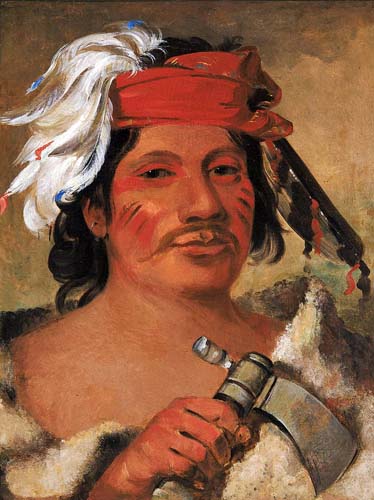
Seneca Steele, a Great Libertine: 1831
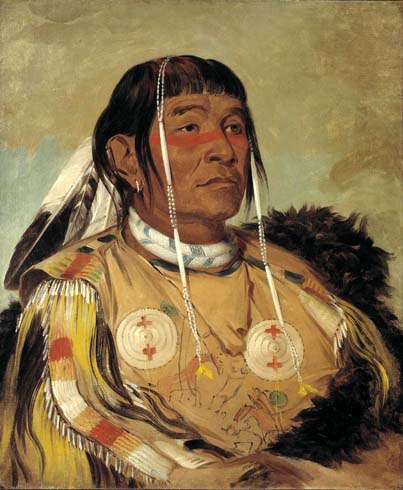
Sha-có-pay,
The Six, Chief of the Plains Ojibwa: 1832
"The chief of that part of the Ojibwa tribe who inhabit these northern regions … is a man of huge size; with dignity of manner, and pride and vanity, just about in proportion to his bulk. He sat for his portrait in a most beautiful dress, fringed with scalp locks in profusion; which he had snatched, in his early life from his enemies' heads, and now wears as proud trophies and proofs of what his arm has accomplished in battles with his enemies. His shirt of buckskin is beautifully embroidered and painted in curious hieroglyphics, the history of his battles and charts of his life" (Letters and Notes, vol. I).
The Six wears a pair of "hair pipes" over his temples.
Painted at Fort Union in 1832. The strongly modeled features of The Six remind one of the portraits of Horse Chief and The Surrounder, other outstanding examples from the Upper Missouri series. The Six's expression in the Field Museum version is bland by comparison, although his costume seems to have been reproduced with comparable detail.
An inscription by the artist on the stretcher of the Field Museum version names the sitter as He Who Walks on the Sea, but all of Catlin's publications confirm the present identification. The inscription does suggest, however, that Catlin was still delivering portraits to O'Fallon in 1835, the year in which he is supposed to have painted number 190.
The Six also appears, full length, in cartoon 12, with his wife and children.
Quoted From: The Catlin Collection
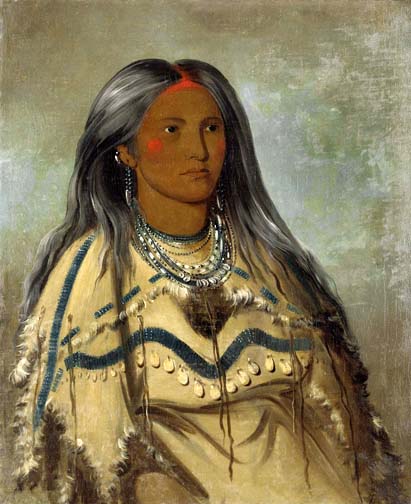
Sha-kó-ka,
Mint, a Pretty Girl: 1832
"A very pretty and modest girl, twelve years of age, with grey hair! Peculiar to the Mandans … about one in twelve, of both sexes and of all ages, have … hair of a bright silvery grey, and exceedingly coarse and harsh" (1848 catalogue).
Painted at the Mandan village in 1832. The Smithsonian and Gilcrease portraits are similar to plate 52 in Letters and Notes, but the Field Museum version shows Mint with dark hair and a slightly different variety of necklaces. The hair color in this last portrait does not agree with Catlin's description of Mint in the 1848 catalogue, and the date of the Gilcrease watercolor cannot be taken seriously. Another portrait of Mandan children with gray hair is illustrated but the female figure does not resemble Mint.
Catlin's technique has a considerable range in the Smithsonian portrait, from the broad strokes of the flowing gray hair to the delicate touches of highlight on the costume accessories.
Quoted From: The Catlin Collection
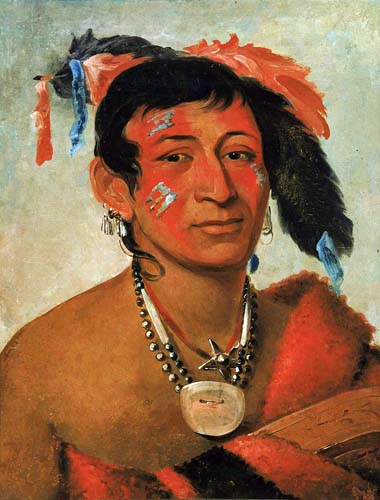
Sha-wá-no,
The South, a Noted Warrior: 1831
According to an original certificate in Smithsonian files, The South (Sha-wá-no) was painted at Prairie du Chien. No date is given, but one would have to assume 1830, rather than 1835, on the basis of style. Equally strong evidence points to January 1831 in Washington as the time and place of the portrait. Changing the date of one example in this series would make it necessary to change the date of others, but more reliable evidence is needed before this can be done. At least one of Catlin's "original" certificates is incorrect, and he confused the identity of other sitters.
Quoted From: The Catlin Collection
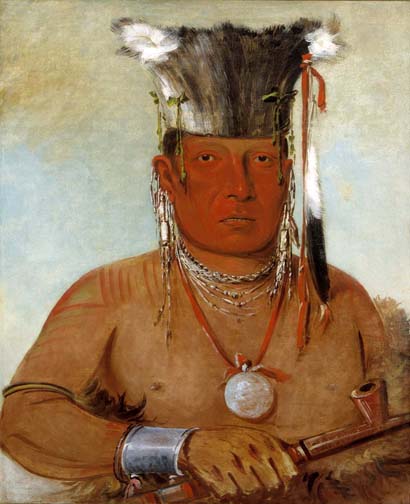
Sháw-da-mon-nee,
There He Goes, a Brave: 1832
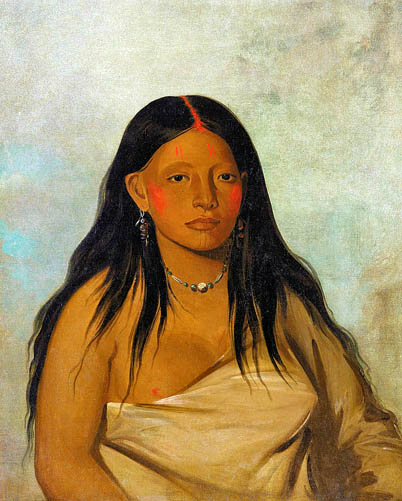
Shé-de-ah,
Wild Sage, a Wichita Woman: 1834

Shee-náh-wee: 1830
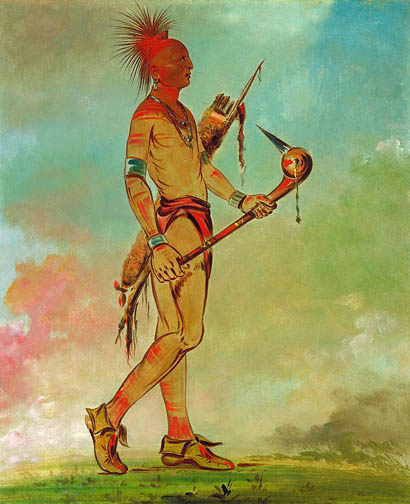
Shin-ga-wás-sa,
Handsome Bird: 1834
Catlin describes Handsome Bird as "a splendid looking fellow, six feet eight inches high; with war club and quiver" (1848 catalogue, p. 11).
Painted at Fort Gibson in 1834. The subject of the Gilcrease watercolor is incorrectly identified as Wa-chésh-uk (War) in the Gilcrease catalogue. The Smithsonian painting and the watercolor are alike in detail, but the figure is badly drawn in the latter.
Quoted From: The Catlin Collection
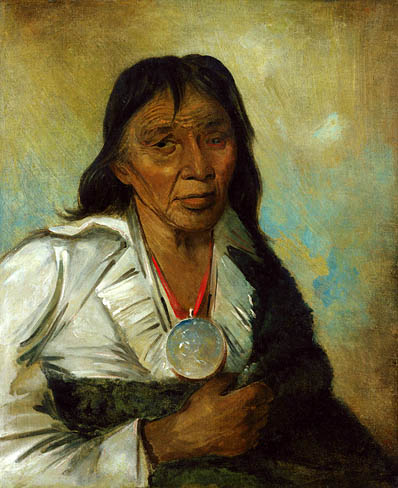
Shin-gós-se-moon,
Big Sail, a Chief: 1836
Catlin describes Big Sail as "blind in one eye. The effects of whiskey and civilization are plainly discernible in this instance" (1848 catalogue, p. 24).
Donaldson and Ewers maintain that the portrait was painted during a visit to Niagara Falls. The former thinks the visit occurred in 1831, and the latter, in the winter of 1829-30; but Catlin's circuit of 1831 was apparently limited to Saint Louis, Philadelphia, Albany, and Great Bend, Pennsylvania, and during the winter of 1829-30 he stayed in Washington and Richmond. In the absence of other evidence, it seems safer to assume that the portrait was painted at Mackinac in 1836, where a remnant of the Ottawa tribe remained, interspersed among the Ojibwa. It is more likely, too, that such a perceptive and sympathetic response to Indian dissipation would have come at the end of Catlin's travels. In 1830 and 1831, his sustaining ambition was to paint those tribes untouched by the effects of civilization.
Quoted From: The Catlin Collection
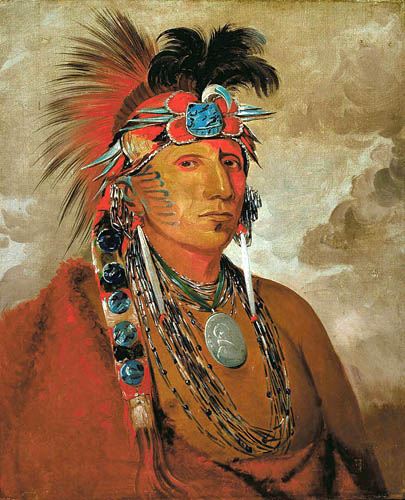
Shó-me-kós-see,
The Wolf, a Chief: 1832
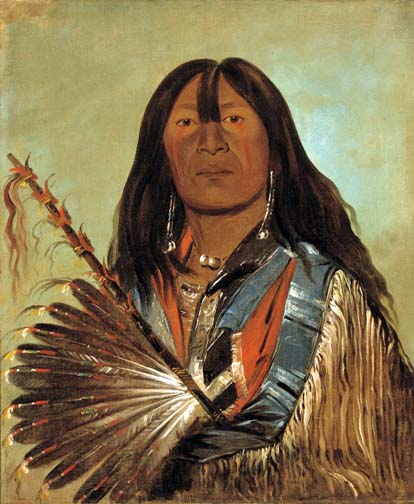
Shón-ka,
The Dog, Chief of the Bad Arrow Points Band: 1832
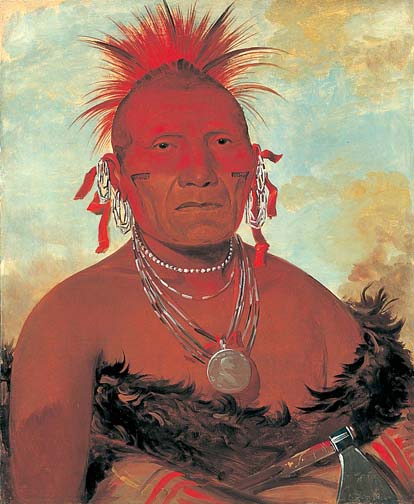
Shón-ka-ki-he-ga,
Horse Chief, Grand Pawnee Head Chief: 1832
Haberly, followed by Ewers and McCracken, maintains that Catlin accompanied Major John Dougherty up the Missouri and Platte rivers in the spring of 1831 to visit the Pawnee, Omaha, Ottawa, and Missouri tribes, but Dale Morgan thinks the paintings were done in 1832 at Fort Leavenworth. Donaldson's dates for the Pawnee series are based on Catlin's improbable recollections.
The portrait of Horse Chief has a compelling dimension and presence, probably indicating that it came shortly after Catlin's painting experience on the Upper Missouri. Although the remaining portraits in the Pawnee series are less ambitious, they also appear to have more in common with Upper Missouri examples than with the portraits painted near Fort Leavenworth in 1830.
Horse Chief appears again, full length, in cartoon 22, with a Missouri chief.
Quoted From: The Catlin Collection
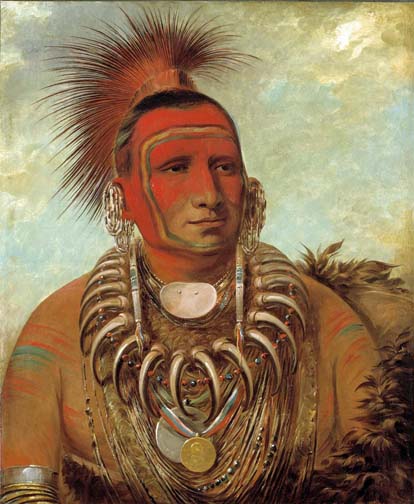
Shon-ta-yi-ga,
Little Wolf, a Famous Warrior: 1844
Probably painted in London in 1844, but further retouching may have taken place in Paris. The portrait is one of two Catlin entered in the Salon of 1846 and it is surely the masterpiece of his European career. The balanced strength of the modeling and brushwork, which surpasses that of many of his American achievements, must represent an effort by the artist to conform, if only temporarily, to the academic standards of the Salon jury. Even the jewelry is more sharply finished than usual, and more skillfully designed as a setting for the imposing head of Little Wolf. The remote and thoughtful presence of the Indian might also reflect the civilized restrictions of London and Paris, rather than the primitive world of the Upper Missouri.
Catlin lists another portrait of Little Wolf among those commissioned by Louis Philippe in 1845, and the subject appears again in cartoon 60.
Quoted From: The Catlin Collection

Shoo-de-gá-cha,
The Smoke, Chief of the Tribe: 1832
"The chief, who was wrapped in a buffalo robe, is a noble specimen of native dignity and philosophy. I conversed much with him; and from his dignified manners, as well as from the soundness of his reasoning, I became fully convinced that he deserved to be the sachem of a more numerous and prosperous tribe. He related to me with great coolness and frankness, the poverty and distress of his nation; and with the method of a philosopher, predicted the certain and rapid extinction of his tribe, which he had not the power to avert. He sat upon the deck of the steamer, overlooking the little cluster of his wigwams mingled among the trees; and, like Caius Marius, weeping over the ruins of Carthage, shed tears as he was descanting on the poverty of his ill-fated little community" (Letters and Notes, vol. I).
Painted at the Ponca village in 1832, apparently on the upriver voyage. The landscape in the background differs between the Smithsonian and Field Museum portraits, and a skin lodge has been added to plate 87 in Letters and Notes.
Quoted From: The Catlin Collection
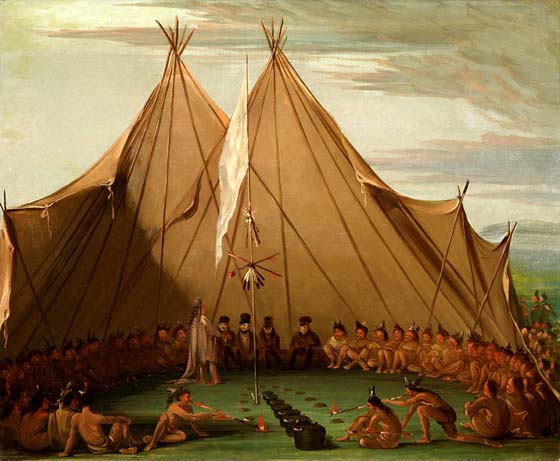
Sioux Dog Feast: 1832
"Some few days after the steamer had arrived, it was announced that a grand feast was to be given to the great white chiefs, who were visitors among them; and preparations were made accordingly for it. The two chiefs … brought their … tents together, forming the two into a semi-circle, enclosing a space sufficiently large to accommodate 150 men; and sat down with that number of the principal chiefs and warriors of the Sioux nation; with Mr. Chouteau, Major Sanford, the Indian agent, Mr. M'Kenzie, and myself, whom they had invited in due time, and placed on elevated seats in the centre of the crescent; while the rest of the company all sat upon the ground, and mostly cross-legged, preparatory to the feast being dealt out."
"In the center of the semi-circle was erected a flag-staff, on which was waving a white flag, and to which also was tied the calumet, both expressive of their friendly feelings towards us. Near the foot of the flag-staff were placed in a row on the ground, six or eight kettles, with iron covers on them, shutting them tight, in which were prepared the viands for our voluptuous feast. Near the kettles, and on the ground also, bottom side upwards, were a number of wooden bowls, in which the meat was to be served out. And in front, two or three men, who were there placed as waiters, to light the pipes for smoking, and also to deal out the food" (Letters and Notes, vol. I).
Catlin continues with a lengthy account of the ritual - speeches, presents and feasting and concludes that it is a "religious ceremony, wherein the poor Indian sees fit to sacrifice his faithful companion to bear testimony to the sacredness of his vows of friendship."
Probably sketched at Fort Pierre in 1832, but the clarity of space and figure relationships, and the flexible brushwork, indicate a later date for the painting. Catlin notes in the SI sketchbook that the feast took place May 7.
The subject is repeated in cartoon 189.
Quoted From: The Catlin Collection
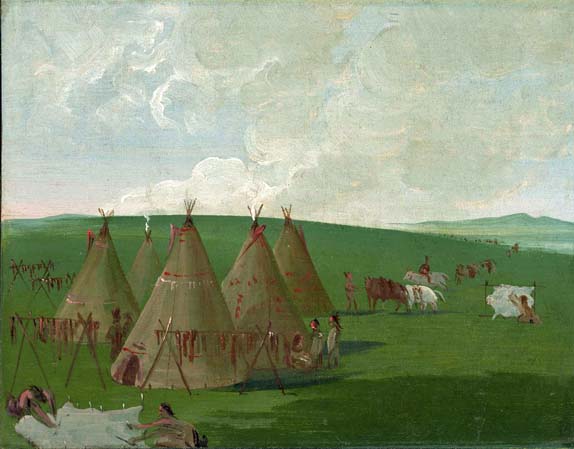
Sioux Encamped on the Upper Missouri,
Dressing Buffalo Meat and Robes: 1832
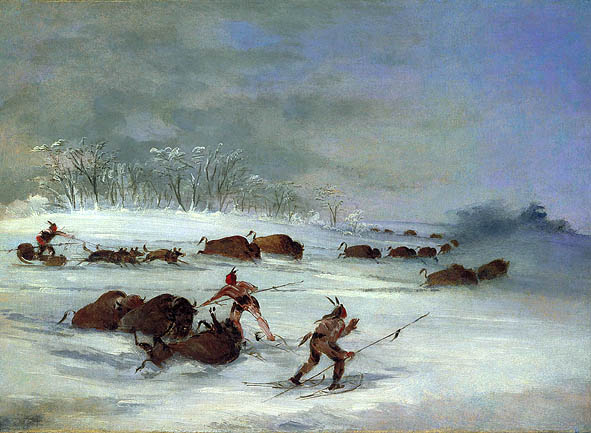
Sioux Indians on Snowshoes Lancing Buffalo: 1846
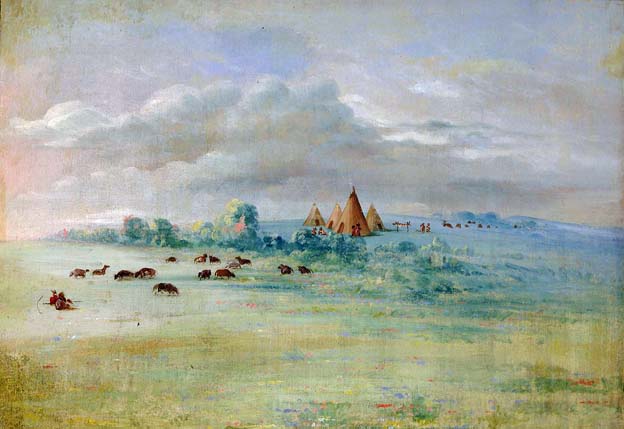
Sioux Village, Lake Calhoun,
near Fort Snelling: 1835

Sioux Worshiping at the Red Boulders: 1837
"A large boulder and two small ones, bearing some resemblance to a buffalo cow and two calves, painted red by the Indians, and regarded by them with superstitious reverence, near the 'Coteau des Prairies' " (1848 catalogue, p. 43).
Probably sketched on Catlin's journey to the Pipestone, Quarry in 1836, but the painting is not included in the 1837 catalogue. The scene is repeated in cartoon 342.
Quoted From: The Catlin Collection
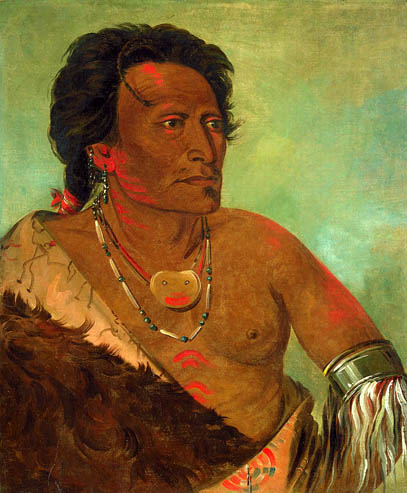
Sky-se-ró-ka,
Second Chief of the Tribe: 1834
Catlin describes the subject as "a fine-looking and remarkably shrewd and intelligent man" (1848) catalogue, p. 12).
Painted at the Comanche village in 1834. The sensitive modeling of Sky-se-ró-ka's features compares favorably to Catlin's best work on the dragoon expedition.
Landscape details have been added to the Gilcrease watercolor, and the subject is three-quarter length with a pipe in his left hand. The Smithsonian portrait and plate 175 in Letters and Notes are almost identical. Sky-se-ró-ka also appears, full length, in cartoon 45.
Quoted From: The Catlin Collection
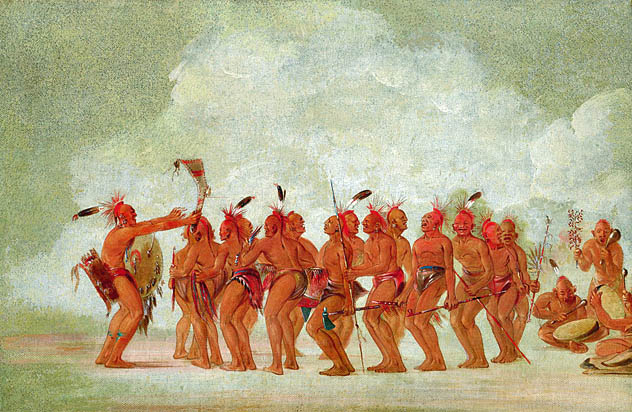
Slave Dance, Sac and Fox: 1835
"The slave-dance is a picturesque scene, and the custom in which it is founded a very curious one. This tribe has a society which they call the 'slaves' composed of a number of the young men of the best families in the tribe, who volunteer to be slaves for the term of two years, and subject to perform any menial service that the chief may order, no matter how humiliating or how degrading it may be; by which, after serving their two years, they are exempt for the rest of their lives, on war parties or other excursions, or wherever they may be-from all labor or degrading occupations, such as cooking, making fires."
"These young men elect one from their numbers to be their master, and all agree to obey his command whatever it may be, and which is given to him by one of the chiefs of the tribe. On a certain day or season of the year, they have to themselves a great feast, and preparatory to it the abovementioned dance" (Letters and Notes, vol. II).
Sketched at the Sauk and Fox village in 1835. The scene is repeated in cartoon 158.
Quoted From: The Catlin Collection

Smoking the Shield: 1837
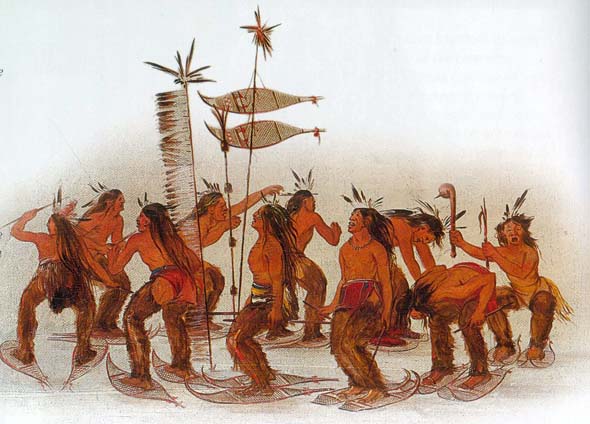
Snowshoe Dance at the First Snowfall: 1835–37
"The snow-shoe dance … is exceedingly picturesque, being danced with the snow shoes under the feet, at the falling of the first snow in the beginning of winter, when they sing a song of thanksgiving to the Great Spirit for sending them a return of snow, when they can run on their snow shoes in their valued hunts, and easily take the game for their food" (Letters and Notes, vol. II).
Details were probably sketched at Fort Snelling in 1835, but Catlin never saw the dance performed in winter. The scene is repeated in plate 14 of Catlin's North American Indian Portfolio, first published in 1844; in plate 74 of the Gilcrease Souvenir album; and in cartoon 169.
Quoted From: The Catlin Collection

South Side of Buffalo Island: 1832
While Catlin was certainly struck by the majestic scale of the Missouri River and its surrounding hills, he was also drawn to the details of the scene before him. He remarked on the fertility of the soil along the Missouri and repeatedly listed plants, flowers, and fruits in his daily notes, remarking on their abundance and variety.
"The scenery of this day's travel, as I have before said, was exceedingly beautiful; and our canoe was often run to the shore, upon which we stepped to admire the endless variety of wild flowers, wasting their sweetness on the desert air, and the abundance of delicious fruits that were about us. While wandering through the high grass, the wild sun-flowers and voluptuous lilies were constantly taunting us by striking our faces; while here and there, in every direction, there were little copses and clusters of plum trees and gooseberries, and wild currants, loaded down with their fruit; and among these, to sweeten the atmosphere and add a charm to the effect, the wild rose bushes seemed planted in beds and in hedges, and everywhere were decked out in all the glory of their delicate tints, and shedding sweet aroma to every breath of the air that passed over them." (Letters and Notes, Letter No. 10)
Describing hedges of thickly clustered buffalo bushes miles in length, so laden with fruit that their branches were bent to the ground, Catlin speculated that their berries, which he thought tasted like currants or grapes, would make excellent wine.
Quoted From: Campfire Stories with George Catlin
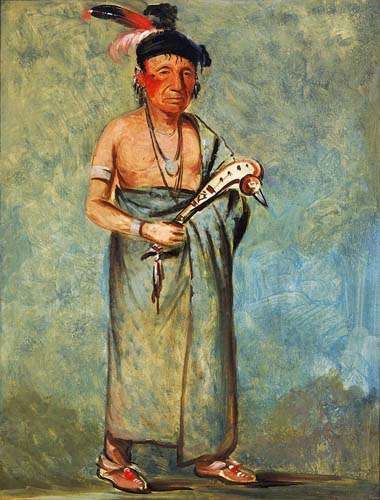
Span-e-o-née-kaw,
The Spaniard: 1828
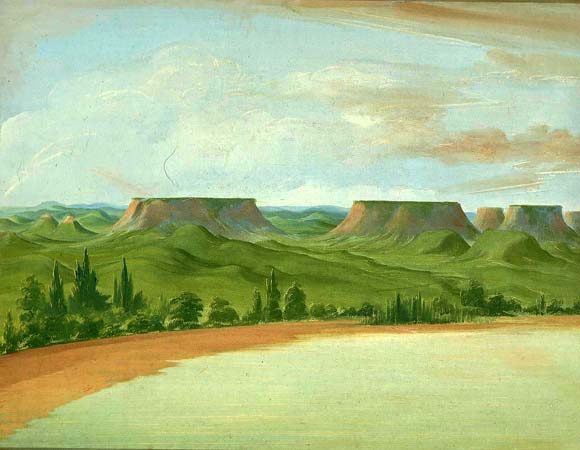
Square Hills,
1200 Miles above Saint Louis: 1832
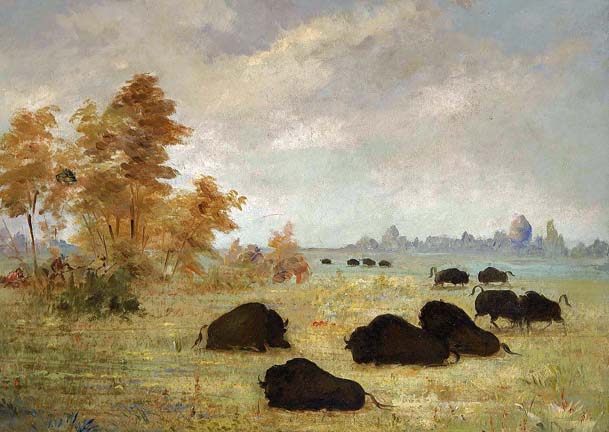
Stalking Buffalo, Arkansas: 1846

Stán-au-pat,
Bloody Hand, Chief of the Tribe: 1832
Bloody Hand is described as having "his face painted with red vermilion, scalping-knife in his hand," and "wearing a beautiful dress" (1848 catalogue, p. 18).
Painted at the Arikara village in 1832. The broad modeling and strong features are typical of the Upper Missouri portraits. Bloody Hand also appears, full length, in cartoon 36, with his wife.
Quoted From: The Catlin Collection

Steeh-tcha-kó-me-co,
Great King: 1834
Numbers 288 and 289, Catlin writes, are "portraits of two distinguished men, and I believe, both chiefs. … These two men are brothers, and are fair specimens of the tribe, who are mostly clad in calicoes, and other cloths of civilized manufacture ; tasseled and fringed off by themselves in the most fantastic way, and sometimes with much true and picturesque taste" (Letters and Notes, Vol. 2, p. 122, pl. 219).
Painted at Fort Gibson in 1834. Catlin shows a suavity and control in the Creek series that almost equals the technical accomplishment of the Cherokee portraits. Ewers points out the range of Catlin's subjects on the dragoon expedition, from the civilized Ben Perryman to Little Spaniard, a Comanche warrior.
The gun has been left out of the Gilcrease watercolor, and the subject's expression is a schematic version of the Smithsonian original. The latter matches plate 219 in Letters and Notes. Ben Perryman supposedly appears again in cartoon 64, but the figures bear no relation to the Smithsonian portrait. Instead the portrait matches a figure in a cartoon labeled A/225 that formerly belonged to the American Museum of Natural History. This cartoon does not seem to correspond to an entry in the 1871 catalogue.
Quoted From: The Catlin Collection
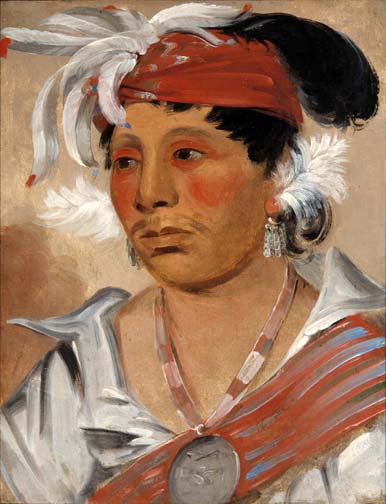
String, a Renowned Warrior: 1831

Stu-mick-o-súcks,
Buffalo Bull's Back Fat, Head Chief, Blood Tribe: 1832
"I have this day been painting a portrait of the head chief of the (Blood tribe) … he is a good-looking and dignified Indian, about fifty years of age, and superbly dressed; while sitting for his picture he has been surrounded by his own braves and warriors and also gazed at by his enemies, the Crows and the Knisteneaux, Assinneboins and Ojibbeways; a number of distinguished personages of each of which tribes have laid all day around the sides of my room; reciting to each other the battles they have fought, and pointing to the scalp-locks, worn as proofs of their victories, and attached to the seams of their shirts and leggings.…
"The name of this dignitary of whom I have just spoken is S tu-mick-o-sucks (the buffalo's back fat), i.e., the 'hump' or 'fleece' the most delicious part of the buffalo's flesh. … The dress … of the chief … consists of a shirt or tunic, made of two deerskins finely dressed, and so placed together with the necks of the skins downwards, and the skins of the hind legs stitched together, the seams running down on each arm, from the neck to the knuckles of the hand; this seam is covered with a band of two inches in width, of very beautiful embroidery of porcupine quills, and suspended from the under edge of this, from the shoulders to the hands, is a fringe of the locks of black hair, which he has taken from the heads of victims slain by his own hand in battle. … In his hand he holds a very beautiful pipe, the stem of which is four or five feet long, and two inches wide, curiously wound with braids of the porcupine quills of various colors; and the bowl of the pipe ingeniously carved by himself from a piece of red steatite of an interesting character, and which they all tell me is procured somewhere between this place and the Falls of St. Anthony, on the head waters of the Mississippi" (Letters and Notes, vol. 1, pp. 29-31, pl. 11).
Painted at Fort Union in 1832. Catlin believed that in the Blackfoot and Crow tribes he had at last found the perfection of aboriginal life, and his month-long visit to the mouth of the Yellowstone was perhaps the most satisfying and productive time of his western travels. In full command of his craft, and inspired by the rich costumes and splendid physical appearance of his subjects, he painted some of his finest portraits, and one that may well rank as his masterpiece, Buffalo Bull's Back Fat. Broadly yet firmly modeled, with incisive detail and bold color, the portrait is as accomplished as any painted on the Missouri River voyage. But more compelling is Catlin's measure of the impassive, brooding stare of the chief, who seems perplexed and challenged, in spite of his imposing appearance, by the unfamiliar circumstances in which he finds himself.
Catlin must also have recognized the importance of the work, as it was one of two he entered in the Salon of 1846, perhaps after some additional finishing. Both paintings made a lasting impression on Baudelaire, who praised the noble and spirited character of the Indians, and the primitive strength of Catlin's reds and greens.
Buffalo Bull's Back Fat becomes a full-length seated figure in plate 11 of Letters and Notes and cartoon 39. He is accompanied by his wife and a Blackfoot medicine man in the latter.
Quoted From: The Catlin Collection
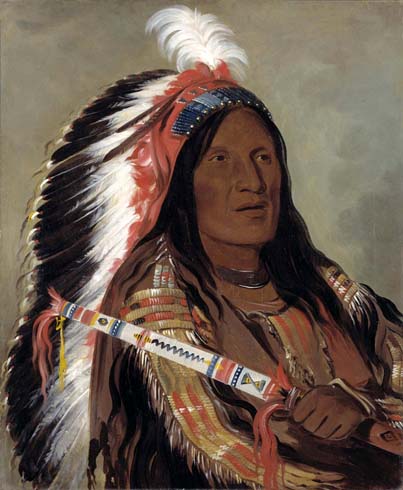
Táh-téck-a-da-háir,
Steep Wind, a Brave of the Bad Arrow Points Band: 1832
"These three distinguished men were all killed in a private quarrel (while I was in the country), occasioned by my painting only one-half of the face of the first; ridicule followed, and resort to fire-arms, in which that side of the face which I had left out was blown off in a few moments after I had finished the portrait; and sudden and violent revenge for the offense soon laid the other two in the dust, and imminently endangered my own life" (1848 catalogue, p. 15).
Painted at Fort Pierre in 1832. Catlin's energetic brushwork was remarkably effective in recording the details of Indian costume. Steep Wind also appears, full length, in cartoon 7.
Quoted From: The Catlin Collection
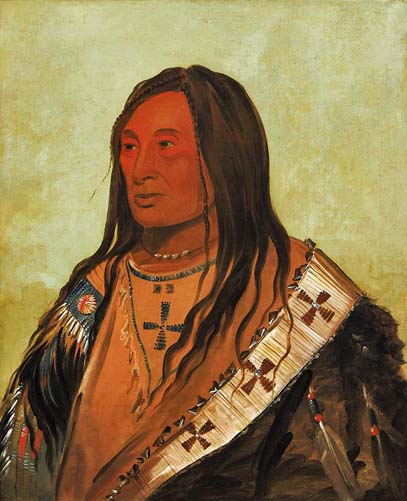
Táh-zee-keh-dá-cha,
Torn Belly, a Distinguished Brave: 1832
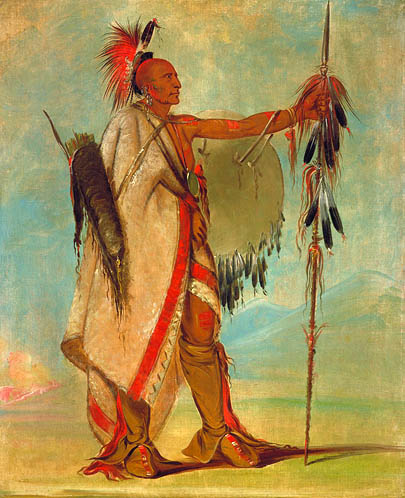
Tál-lee,
a Warrior of Distinction: 1834
"Among the many brave and distinguished warriors of the tribe, one of the most noted and respected is Tal-lee, painted at full length, with his lance in his hand-his shield on his arm, and his bow and quiver slung upon his back."
"In this portrait, there is a fair specimen of the Osage figure and dress, as well as of the facial outline, and shape and character of the head, and mode of dressing and ornamenting it with helmet crest, and the eagle's quill" (Letters and Notes, vol. II).
Painted at Fort Gibson in 1834. Tál-lee also appears as An Osage Warrior in plate 1 of Catlin's North American Indian Portfolio, first published in 1844, and in cartoon 51.
Quoted From: The Catlin Collection
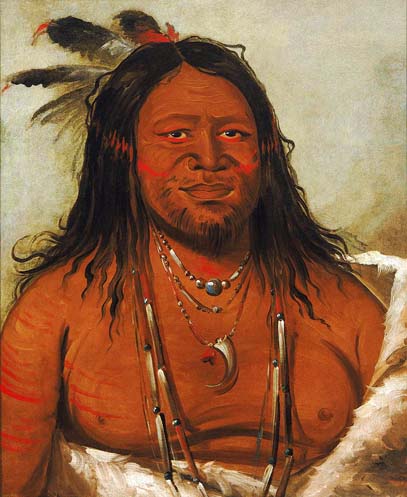
Ta-wáh-que-nah,
Mountain of Rocks, Second Chief of the Tribe: 1834
"This man received the United States Regiment of Dragoons with great kindness at his village, which was beautifully situated at the base … of the (Wichita Mountains)" (1848 catalogue, p. 11).
Catlin described Mountain of Rocks as "the largest and fattest Indian I ever saw. … A perfect personification of Jack Falstaff, in size and in figure, with an African face, and a beard on his chin of two or three inches in length. His name … he got from having conducted a large party of Comanche through a secret and subterraneous passage, entirely through the mountain of granite rocks, which lies back of their village; thereby saving their lives" (Letters and Notes, vol. 2, p. 67, pl. 169).
Painted at the Comanche village in 1834. Mountain of Rocks is seated with his hands visible in the Gilcrease watercolor, but the Smithsonian oil differs from plate 169 in Letters and Notes only in the addition of a feather headdress. Catlin matches the full, sensuous appeal of the sitter with brushwork as bold as any used in the dragoon expedition portraits.
The subject appears again, full length, in cartoon 42, with a Comanche warrior and a woman and child. The cartoon is based on a watercolor (pl. 40) in the Gilcrease Souvenir album.
Quoted From: The Catlin Collection
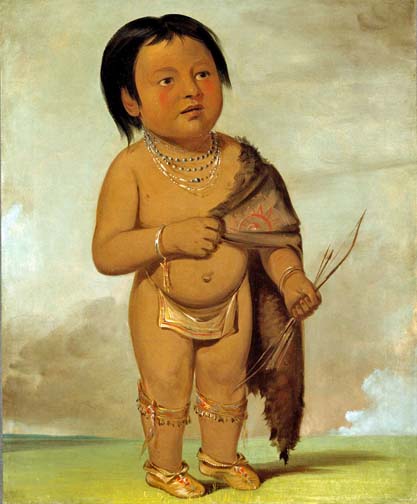
Tcha-aés-ka-ding,
Grandson of Buffalo Bull's Back Fat: 1832
"The grandson also of this sachem, a boy of six years of age, and too young as yet to have acquired a name, has stood forth like a tried warrior; and I have painted him at full length, with his bow and quiver slung, and his robe made of a raccoon skin. The history of this child is somewhat curious and interesting; his father is dead, and in case of the death of the chief … he becomes hereditary chief of the tribe. This boy has been twice stolen away by the Crows by ingenious stratagems, and twice re-captured by the Blackfeet, at considerable sacrifice of life, and at present he is lodged with Mr. M'Kenzie, for safekeeping and protection, until he shall arrive at the proper age to take the office to which he is to succeed" (Letters and Notes, vol. 1, p. 30, pl. 12).
Painted at Fort Union in 1832. The true proportions of such a diminutive figure were still beyond Catlin's reach, but the appealing roundness of the little boy effectively conveys his age. The face and figure in the Gilcrease portrait are only a stylized approximation of the original.
Quoted From: The Catlin Collection
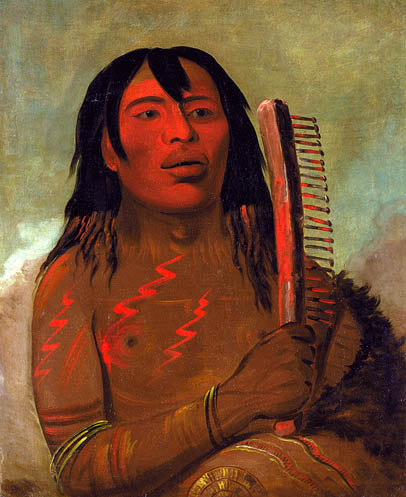
Tcha-dés-sa-ko-máh-pee,
Bear's Child: 1832

Tcha-káuk-o-ko-máugh,
Great Chief, a Boy: 1831
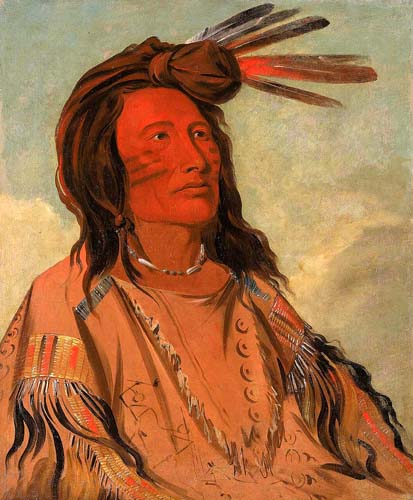
Tchán-dee,
Tobacco, an Oglala Chief: 1832
Western Sioux/Lakota. Painted at Fort Pierre in 1832.
The Oglala "scatter their own" tribe, a deviation of the Western Sioux, Lakota, originated as a farming community located around the Great Lakes. As French and English settlements began to encroach on their land, the tribe was forced westward to the Plains region, near the Black Hills and Powder River, where they gradually acquired horses, started hunting buffalo, and eventually stopped farming. This change, occurring between 1700 and 1850, greatly affected the Oglala religion and way of life.
Catlin described Tchan-dee as "a desperate warrior, and represented to me by the traders, as one of the most respectable and famous chiefs of the tribe."
SOURCE: George Catlin, Letters and Notes, vol. I.
Quoted From: Campfire Stories with George Catlin

Tcha-tó-ga,
Mad Buffalo, Murderer of Two White Men: 1834
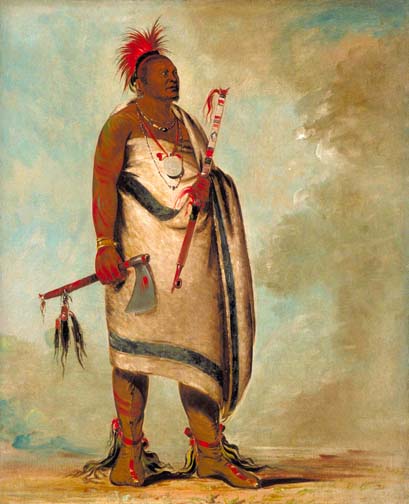
Tchong-tas-sáb-bee,
Black Dog, Second Chief: 1834
"Among the chiefs of the Osages, and probably the next in authority and respect in the tribe, is … the black dog, whom I painted also at full length, and with his pipe in one hand, and his tomahawk in the other; his head shaved, and ornamented with a beautiful crest of deer's hair, and his body wrapped in a huge mackinaw blanket."
"This dignitary, who is blind in the left eye, is one of the most conspicuous characters in all this country, rendered so by his large size (standing in height and girth above all of his tribe), as well as by his extraordinary life. His height, I think, is seven feet, and his limbs full and rather fat, making his bulk formidable, and weighing, perhaps, some 250 or 300 pounds" (Letters and Notes, vol. II).
John Mix Stanley, who painted Black Dog in 1843, recorded his height as six feet six inches.
Landscape additions have been made to the Gilcrease watercolor, but Black Dog has no tomahawk. With few exceptions, the modeling of the Osage portraits at the Gilcrease lacks the strength and detail of the Smithsonian originals.
Painted from life in the presence of General Leavenworth at Fort Gibson in 1834, according to an original certificate in Smithsonian files. Donaldson's date of 1836 for this portrait must be based on Catlin's mistaken recollection of when the dragoon expedition took place (see 1871 catalogue, pp. 17, 90). Black Dog also appears in cartoon 51, which is based on a watercolor in the Gilcrease Souvenir album. The best of several versions of this cartoon is in the Museum für Völkerkunde, Berlin.
Quoted From: The Catlin Collection
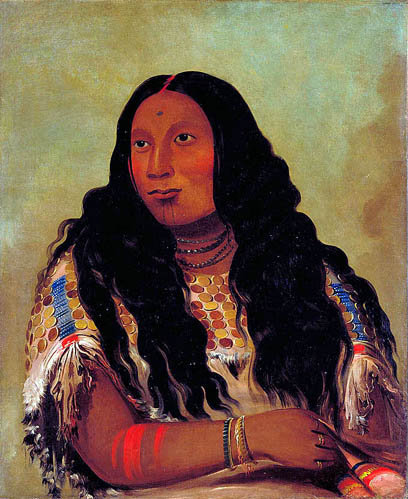
Tchón-su-móns-ka,
Sand Bar, Wife of the Trader François Chardon: 1832
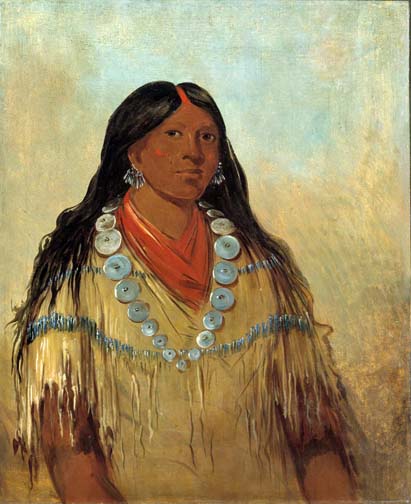
Tchow-ee-pút-o-kaw,
a Woman: 1834
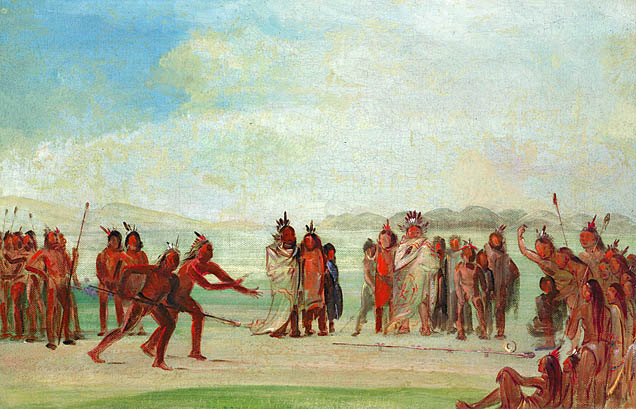
Tchung-kee,
a Mandan Game Played with a Ring and Pole: 1832
"The game of Tchung-kee is a beautiful athletic exercise, which they seem to be almost unceasingly practicing while the weather is fair, and they have nothing else of moment to demand their attention. This game is decidedly their favorite amusement, and is played near to the village on a pavement of clay, which has been used for that purpose until it has become as smooth and hard as a floor. The play commences with two (one from each party), who start off upon a trot, abreast of each other, and one of them rolls in advance of them, on the pavement, a little ring of two or three inches in diameter, cut out of a stone; and each one follows it up with his 'tchung-kee' (a stick of six feet in length, with little bits of leather projecting from its sides of an inch or more in length), which he throws before him as he runs, sliding it along upon the ground after the ring, endeavoring to place it in such a position when it stops, that the ring may fall upon it, and receive one of the little projections of leather through it" (Letters and Notes, vol. I).
Sketched at the Mandan village in 1832. Catlin often set the principal figures in motion with a few hasty strokes, and then left the remainder of the painting almost unfinished. Matthews says that many Indians he has known have been favorably impressed by Catlin's representation of the game.
The scene is repeated in cartoon 173.
Quoted From: The Catlin Collection
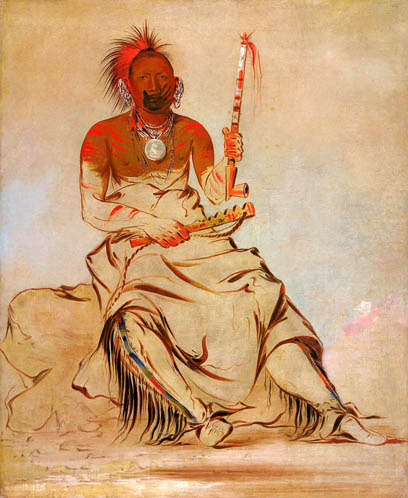
Te-ah'-ke-ra-lée-re-coo,
The Cheyenne, a Republican Pawnee: 1832
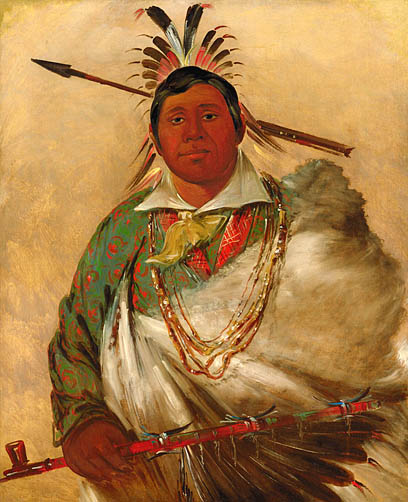
Téh-ke-néh-kee,
Black Coat, a Chief: 1834
,_First_Chief_1834.jpg)
Téh-tóot-sah
(better known as Tohausen, Little Bluff), First Chief: 1834
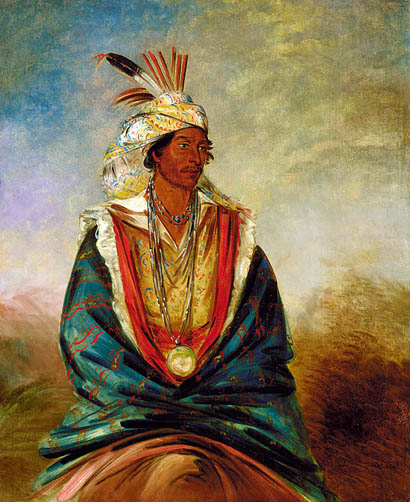
Tel-maz-há-za,
a Warrior of Distinction: 1834
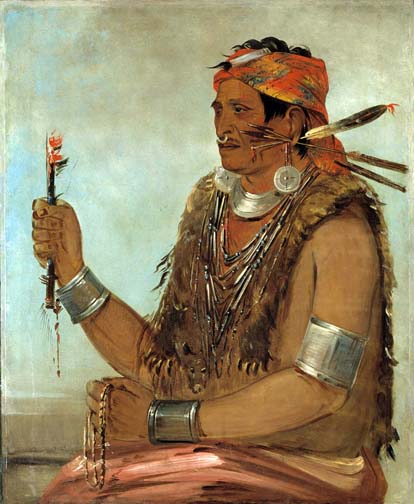
Ten-sqúat-a-way,
The Open Door, Known as The Prophet, Brother of Tecumseh: 1830
"The 'Shawnee Prophet', is perhaps one of the most remarkable men, who has flourished on these frontiers for some time past. This man is brother of the famous Tecumseh, and quite equal in his medicines or mysteries, to what his brother was in arms; he was blind in his left eye, and in his right hand he was holding his 'medicine fire', and his 'sacred string of beads' in the other. With these mysteries he made his way through most of the North Western tribes, enlisting warriors wherever he went, to assist Tecumseh in effecting his great scheme, of forming a confederacy of all the Indians on the frontier, to drive back the whites and defend the Indians' rights; which he told them could never in any other way be protected. He had actually enlisted some eight or ten thousand, who were sworn to follow him home; and in a few days would have been on their way with him, had not a couple of his political enemies from his own tribe defeated his plans, by pronouncing him an imposter."
"This, no doubt, has been a very shrewd and influential man, but circumstances have destroyed him and he now lives respected, but silent and melancholy in his tribe" (Letters and Notes, vol. II).
Probably painted at Fort Leavenworth in 1830 (records of the Bureau of Indian Affairs show that The Prophet was living west of the Mississippi by that year). Catlin was undoubtedly moved by The Prophet's desperate and tragic experience; the portrait is one of the artist's best efforts during his first years west of the Mississippi.
The subject is bust length in the Gilcrease watercolor, and he lacks many of the costume accessories that he wears in the Smithsonian original. The latter matches plate 214 in Letters and Notes. Charles Bird King also painted The Prophet, and he appears again, full length, in cartoon 74.
Quoted From: The Catlin Collection
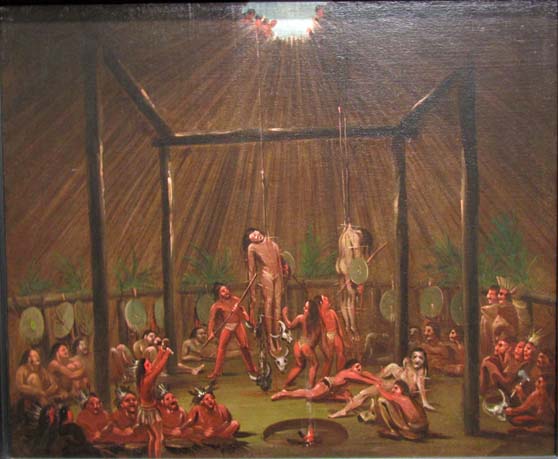
The Cutting Scene,
Mandan O-kee-pa Ceremony: 1832
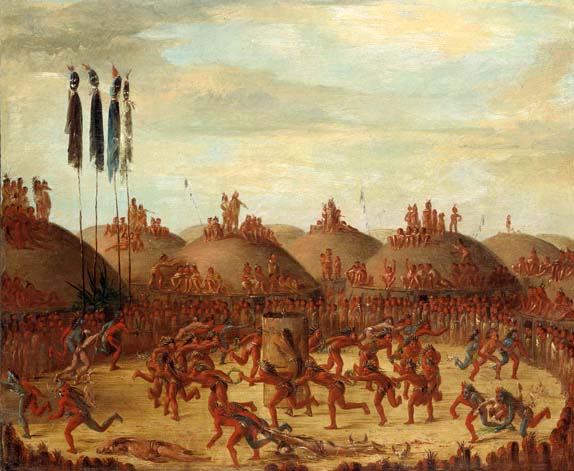
The Last Race, Mandan O-kee-pa Ceremony: 1832
"The signal for the commencement of this part of the cruelties was given by the old master of ceremonies, who again ran out as in the buffalo-dance, and leaning against the big canoe, with his medicine-pipe in his hand, began to cry. This was done several times in the afternoon, as often as there were six or eight who had passed the ordeal just described within the lodge, who were then taken out in the open area, in the presence of the whole village, with the buffalo skulls and other weights attached to their flesh, and dragging on the ground! There were then in readiness, and prepared for the purpose, about twenty young men, selected of equal height and equal age, with their bodies chiefly naked, with beautiful (and similar) head-dresses of war eagles' quills, on their hands, and a wreath made of willow boughs held in the hands between them, connecting them in a chain or circle in which they ran around the big canoe, with all possible speed, raising their voices in screams and yelps to the highest pitch that was possible, and keeping the curb or big canoe in the centre, as their nucleus."
"Then were led forward the young men who were further to suffer, and being placed at equal distances apart, and outside of the ring just described, each one was taken in charge of two athletic young men, fresh and strong, who stepped up to him, one on each side, and by wrapping a broad leather strap around his wrists, without tying it, grasped it firm underneath the hand, and stood prepared for what they call the last race."
"In this condition they stand, pale and ghastly, from abstinence and loss of blood, until all are prepared and the word is given, when all start and run around, outside of the other ring; and each poor fellow, with his weights dragging on the ground, and his furious conductors by his side, who hurry him forward by the wrists, struggles in the desperate emulation to run longer without 'dying' (as they call it) than his comrades, who are fainting around him and sinking down, like himself, where their bodies are dragged with all possible speed, and often with their faces in the dirt. In the commencement of this dance or race they all start at a moderate pace, and their speed being gradually increased, the pain becomes so excruciating that their languid and exhausted frames give out, and they are dragged by their wrists until they are disengaged from the weights that were attached to their flesh, and this must be done by such violent force as to tear the flesh out with the splint, which (as they say) can never be pulled out, without greatly offending the Great Spirit and defeating the object for which they have thus far suffered. … when they were freed from the last of the buffalo skulls and other weights, (which was often done by some of the bystanders throwing he weight of their bodies on to them as they were drifting on the ground) they were in every instance dropped by the persons who dragged them and their bodies were left, appearing like nothing but a mangled and loathsome corpse" (Letters and Notes, vol. I).
Some minutes later the battered candidates would rise from the dust and stagger to their respective lodges, where their family and friends were prepared to receive them.
Painted at the Mandan village in 1832. The Smithsonian version is again a close visual account of the passage in Letters and Notes, and a more detailed and finished painting than the original. The crude little figures in the latter, however, are less contrived and more expressive of the primitive drama of the scene. The Schweitzer copy lacks Catlin's animated touch.
The Smithsonian version matches plate 60 in Letters and Notes, and is repeated in cartoon 420 (collection of Mr. and Mrs. Paul Mellon), although the latter is lacking foreground spectators. The cartoon, in turn, is the basis for plate 12 in O-Kee-Pa.
Quoted From: The Catlin Collection
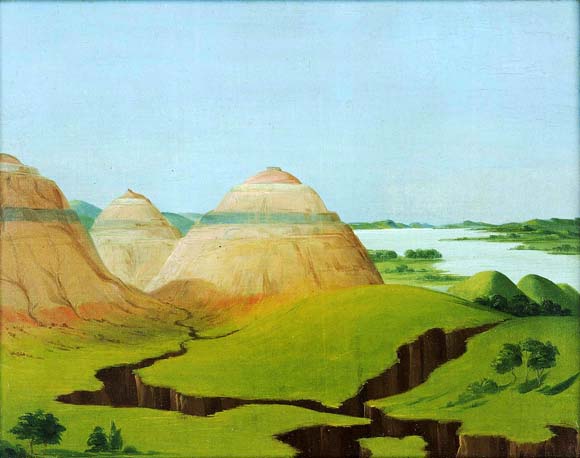
The Three Domes, Clay Bluffs 15 Miles above the Mandan Village: 1832
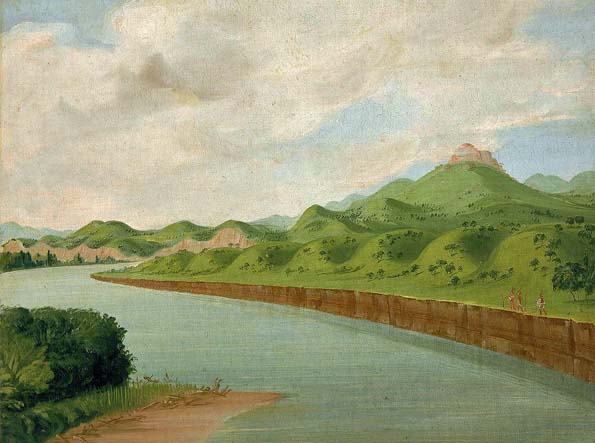
The Tower, 1100 Miles above Saint Louis: 1832
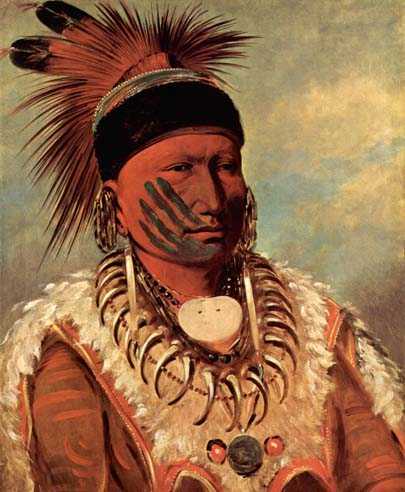
The White Cloud,
Head Chief of the Iowas: Date Unknown
Financial success eluded Catlin in the United States, so he hoped that his gallery and pro-Indian views would find greater support in Europe. In November 1839 he sailed for England with nephew Theodore Burr Catlin, more than 500 paintings and artifacts, and two grizzly bears in tow. When his show opened in London in 1840, the press was enthusiastic. When his wife and children joined him in September of that year, however, he admitted that his exhibition was not raising enough money to cover its expenses. To increase attendance, Catlin hired local whites to dress in his Indian artifacts and reenact war scenes and domestic traditions, a feature he called "tableaux vivants." For two years, Catlin toured this production, which some historians call the first "Wild West" show, in several cities in England, Scotland, and Ireland.
Quoted From: Campfire Stories with George Catlin

Theodore Burr Catlin, in Indian Costume: 1840
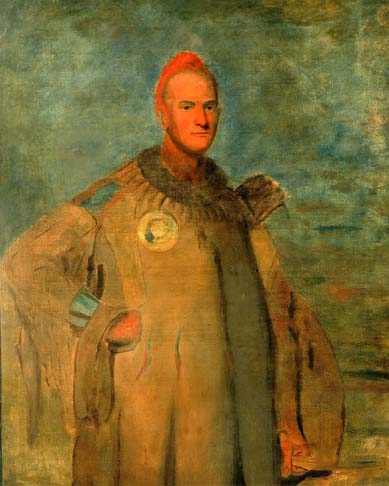
George Catlin finished his travels through the American West in 1836, and by December 1839 had set sail for England. He planned to exhibit the Indian Gallery in hopes of attracting a wealthy buyer for his collection, and his works appeared in London's Egyptian Hall in 1840. Over time, he expanded the gallery to include actors, who wore costumes from Catlin's own collection and performed tableaux vivants---staged reenactments of Indian songs, dances, and war scenes. This portrait shows Catlin's nephew Theodore Burr Catlin dressed for a performance.
Quoted From: Luce Foundation Center for American Art
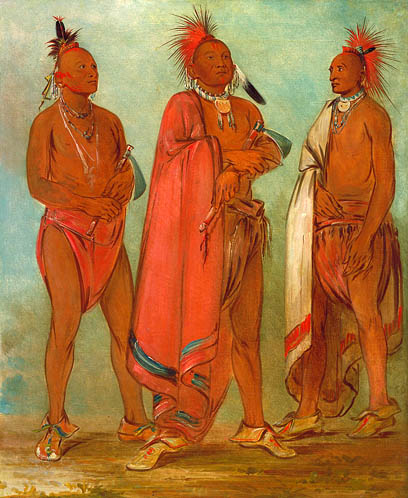
Three Distinguished Young Men: 1834
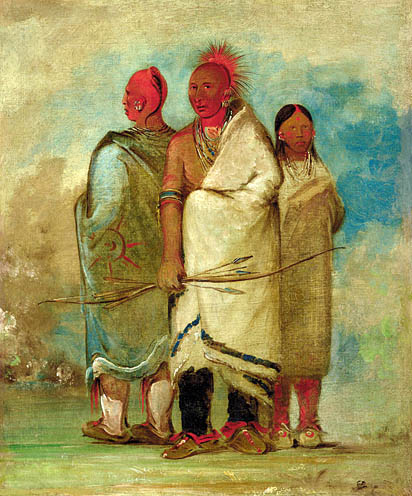
Three Fox Indians: 1837
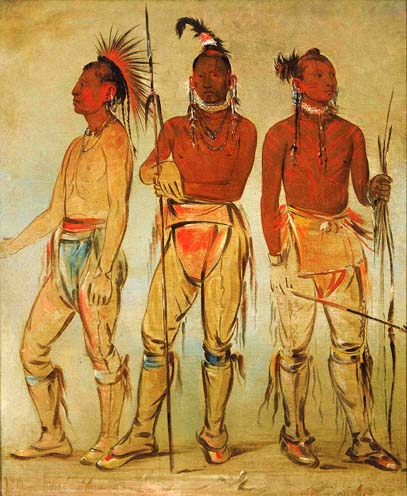
Three Young Warriors: 1834
"These three distinguished and ambitious young men were of the best families in the Osage Nation; and, as they explained to me, having formed a peculiar attachment to each other-they desired me to paint them all on one canvas, in which wish I indulged them" (Letters and Notes, vol. II).
The three also served as guides on the dragoon expedition of 1834.
Quoted From: The Catlin Collection
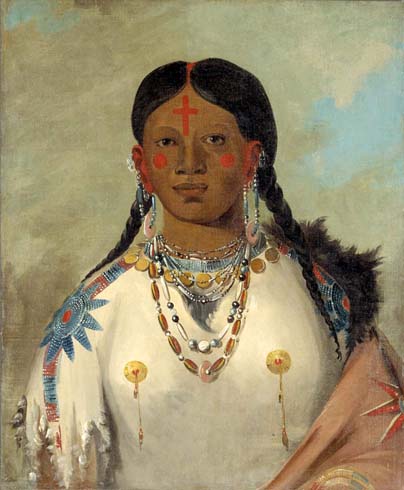
Tís-se-wóona-tis,
She Who Bathes Her Knees, Wife of the Chief: 1832
"The woman was comely, and beautifully dressed; her dress of the mountain-sheep skins, tastefully ornamented with quills and beads, and her hair plaited in large braids, that hung down on her breast" (Letters and Notes, vol. II).
Painted at Fort Pierre in 1832. Judging from Catlin's itinerary that summer, the bead and jewelry detail were probably later additions.
Quoted From: The Catlin Collection
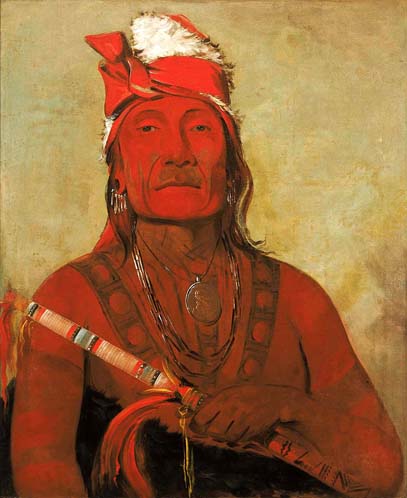
Toh-kí-e-to,
Stone With Horns, a Chief: 1832
The subject was reputed to be, according to Catlin, "the principal and most eloquent orator of the nation. The neck, and breast, and shoulders of this man, were curiously tattooed, by pricking in gunpowder and vermillion, which in this extraordinary instance, was put on in such elaborate profusion as to appear at a little distance like a beautifully embroidered dress. In his hand he held a handsome pipe, the stem of which was several feet long, and all the way wound with ornamented braids of the porcupine quills. Around his body was wrapped a valued robe, made of the skin of the grizzly bear, and on his neck several strings of wampum. … I was much amused with the excessive vanity and egotism of this notorious man, who, while sitting for his picture, took occasion to have the interpreter constantly explaining to me the wonderful effects which his oratory had at different times produced on the minds of the chiefs and people of his tribe." (Letters and Notes, vol I).
Painted at Fort Pierre in 1832.
Quoted From: The Catlin Collection
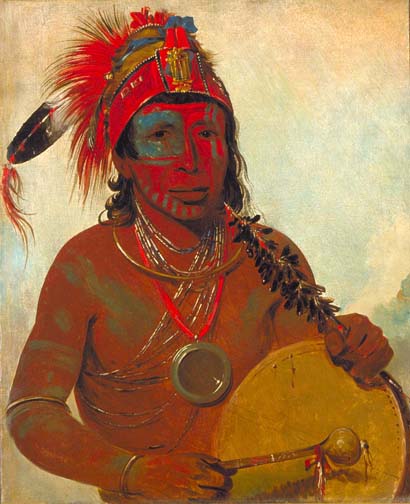
Tóh-to-wah-kón-da-pee,
Blue Medicine, a Medicine Man of the Ting-ta-to-ah Band: 1835
Described by Catlin as a noted doctor or medicine man, "with his medicine or mystery drum and rattle in his hands, his looking-glass on his breast, his rattle of antelope's hoofs, and drum of deer-skins" (1848 catalogue, p. 14).
Painted at Fort Snelling in 1835.
Quoted From: The Catlin Collection
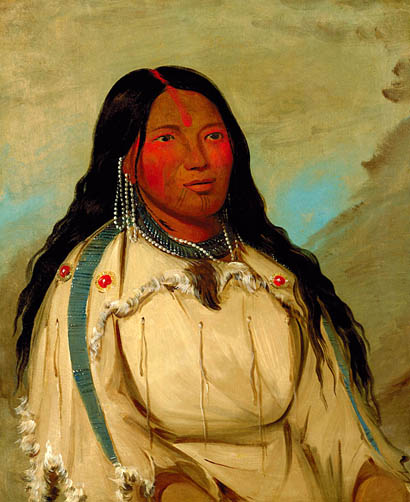
Tow-ée-ka-wet,
a Cree Woman: 1832
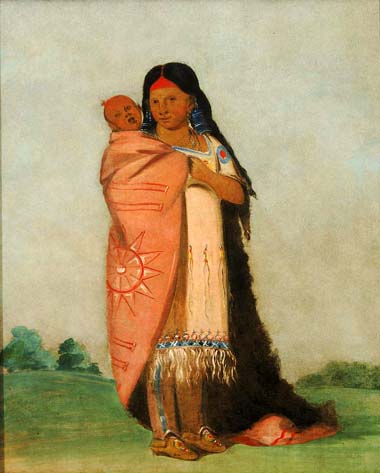
Tsee-moúnt,
Great Wonder, Carrying Her Baby in Her Robe: 1832
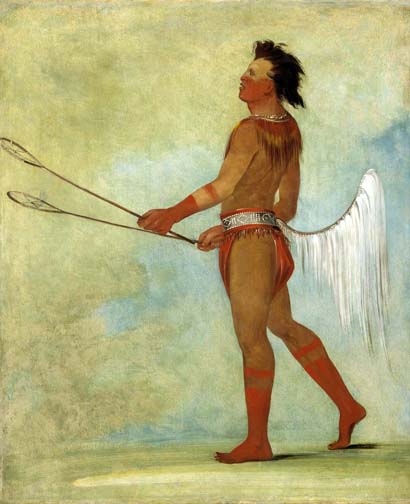
Tul-lock-chísh-ko,
Drinks the Juice of the Stone, in Ball-player's Dress: 1834
"The most distinguished ball-player of the Choctaw nation, represented in his ball-play dress, with his ball-sticks in his hands. In every ball-play of these people, it is a rule of the play, that no man shall wear moccasins on his feet, or any other dress than his breech-cloth around his waist, with a beautiful bead belt, and a 'tail' made of white horsehair or quills, and a 'mane' on the neck, of horsehair dyed of various colors" (Letters and Notes, vol. 2, pp. 120- 25, pl. 223).
Painted at Fort Gibson in 1834. Catlin produces an effective design from the profile of the ballplayer and his equipment.
Quoted From: The Catlin Collection
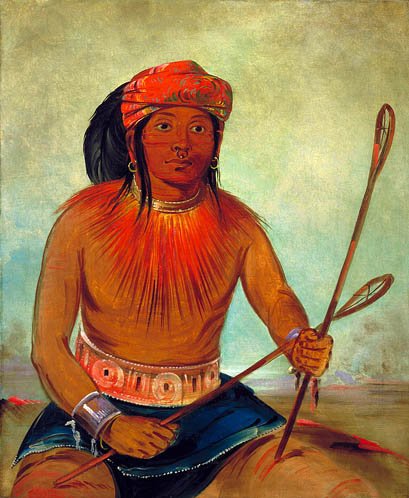
Tul-lock-chísh-ko,
Drinks the Juice of the Stone: 1834
Painted at Fort Gibson in 1834. Costume details vary between the Gilcrease watercolor and the Smithsonian original. The subject appears to be standing in the former, and seated in the latter.
Quoted From: The Catlin Collection
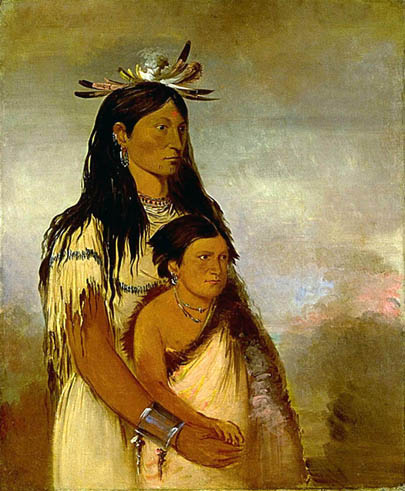
Tunk-aht-oh-ye,
Thunderer, a Boy, and Wun-pan-to-mee, White Weasel, a Girl: 1834
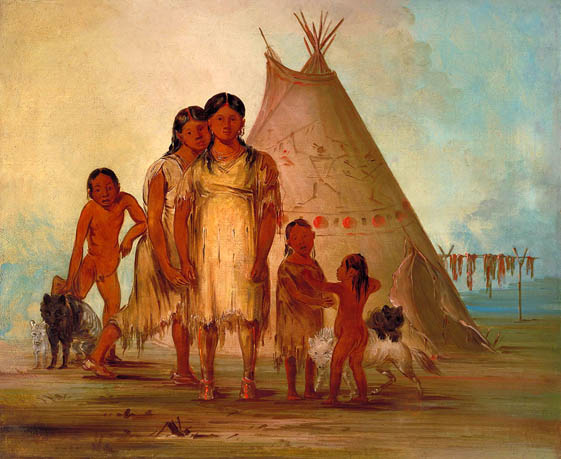
Two Comanche Girls: 1834
The scene consists of "the wigwam of the Chief, his dogs, and his five children" (1848 catalogue, p. 12).
Painted at the Comanche village in 1834. An almost identical scene is repeated in cartoon 44, which in turn is based on a watercolor (pl. 42) in the Gilcrease Souvenir album.
Quoted From: The Catlin Collection

Two Young Men: 1835
Described by Catlin as "two Menominee youths at full length, in beautiful dresses … one with his war-club in his hand, and the other blowing on his 'courting flute' " (Letters and Notes, vol. II).
Probably painted at Prairie du Chien or Green Bay in 1835 or 1836. The two figures appear again in cartoon 18, although Catlin has mislabeled them.
Quoted From: The Catlin Collection
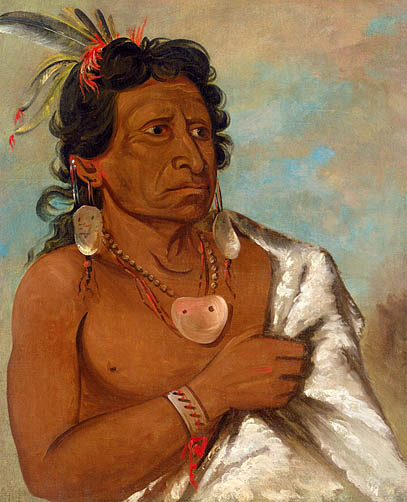
U'sh-ee-kitz,
He Who Fights with a Feather, Chief of the Tribe: 1934
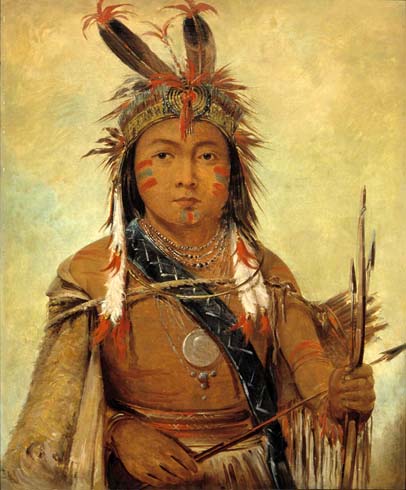
Ud-je-jock,
Pelican, a Boy: 1845
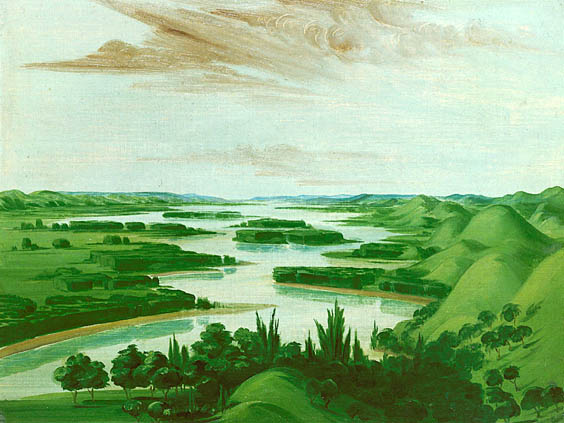
View from Floyd's Grave,
1300 Miles above Saint Louis: 1832
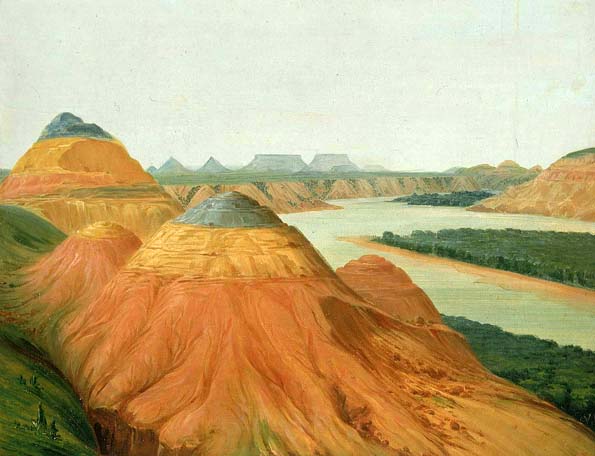
View in the Big Bend of the Upper Missouri: 1832
Catlin was compelled to record the novel land forms before him, which were on a scale beyond the imagination of easterners accustomed to the Appalachian Mountains. "Among these groups may be seen tens and hundreds of thousands of different forms and figures, of the sublime and the picturesque; in many places for miles together, as the boat glides along, there is one continued appearance, before and behind us, of some ancient and boundless city in ruins - ramparts, terraces, domes, towers, citadels and castles may be seen - cupolas, and magnificent porticoes, and here and there a solitary column and crumbling pedestal, and even spires of clay which stand alone - and glistening in distance, as the sun's rays are refracted back by the thousand crystals of gypsum which are imbedded in the clay of which they are formed" (Letters and Notes, Letter No. 3).
Catlin predicted that this pristine land would be settled, farmed and plowed, and forever changed.
Quoted From: Campfire Stories with George Catlin

View in the Cross Timbers, Texas: 1832
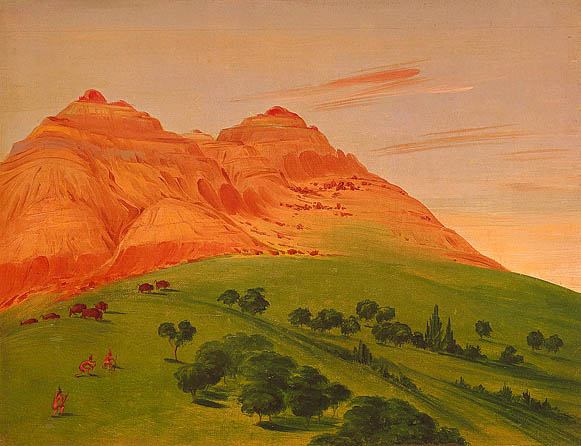
View in the Grand Detour,
1900 Miles above Saint Louis: 1832
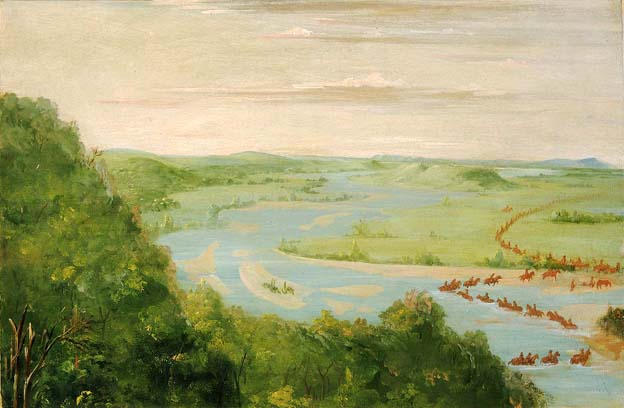
View of the Canadian River, Dragoons Crossing: 1834
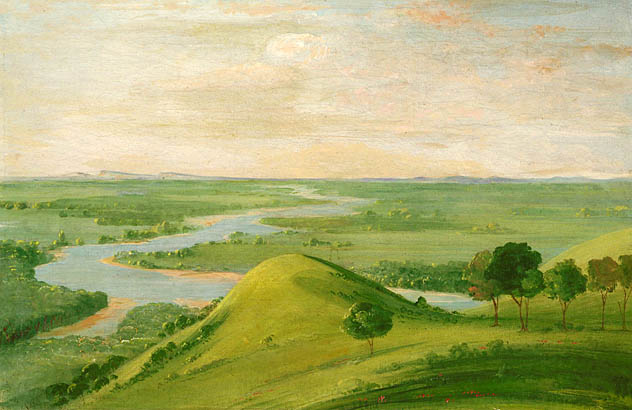
View of the Junction of the Red River and the False Washita, in Texas: 1834
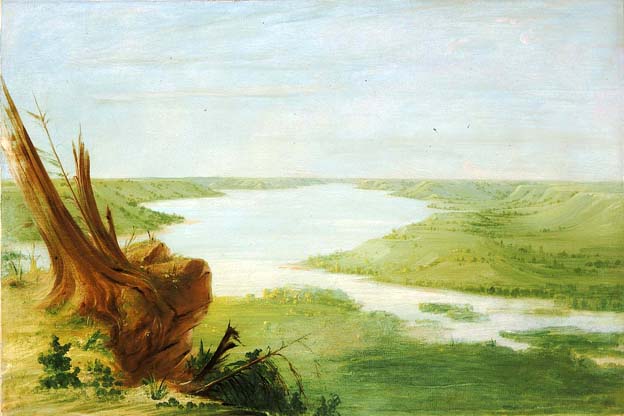
View on Lake Saint Croix, Upper Mississippi: 1835
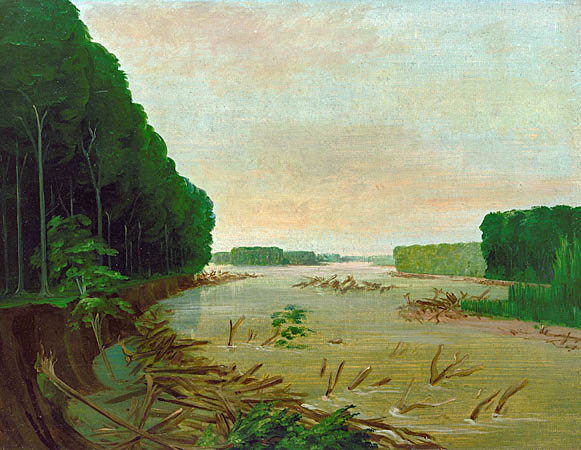
View on the Missouri, Alluvial Banks Falling in,
600 Miles above Saint Louis: 1832
While most of Catlin's images and words describe beauty and abundance, he occasionally admitted that travel in the West was not without obstacles or hardship. For several of his journeys, the Missouri River was his highway, whether he was traveling by steamer or by canoe. The river determined where he went and what he saw and experienced. Of his first journeys he wrote, "For the distance of 1000 miles above St. Louis, the shores of this river . . . are filled with snags and rafts, formed of trees of the largest size, which have been undermined by the falling banks and cast into the stream; their roots becoming fastened in the bottom of the river, with their tops floating on the surface of the water, and pointing down the stream, forming the most frightful and discouraging prospect for the adventurous voyageur." (Letters and Notes, Letter No. 3) When he painted this view in 1832, he was aboard the steamer Yellowstone as it penetrated far into the wilderness, making its second journey up the Missouri as far as the mouth of the Yellowstone River.
Quoted From: Campfire Stories with George Catlin
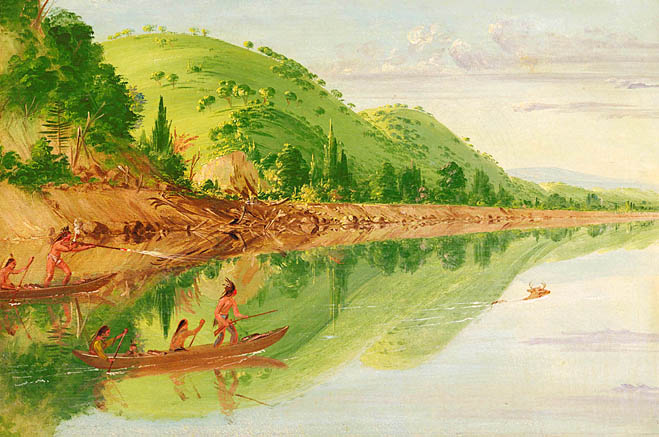
View on the Saint Peter's River, Sioux Indians Pursuing a Stag in their Canoes: 1836
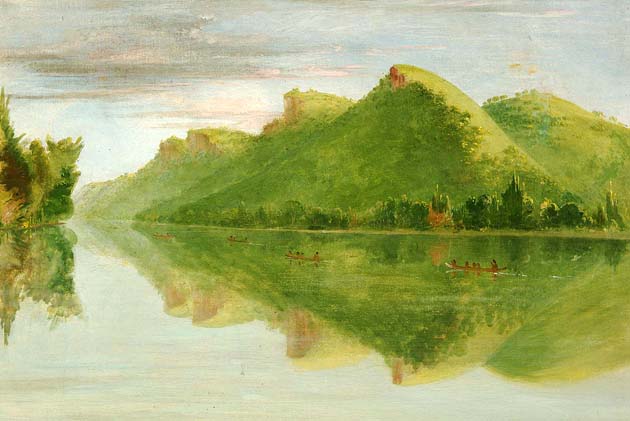
View on the Upper Mississippi,
Beautiful Prairie Bluffs: 1835
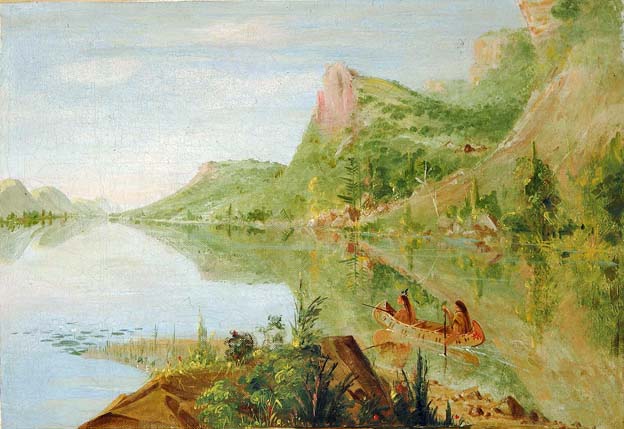
View on the Wisconsin River, Winnebago Shooting Ducks: 1836
"We are, at this place, on the banks of the Red River, having Texas under our eye on the opposite bank. Our encampment is on the point of land between the Red and False Washita rivers, at their junction; and the country about us is a panorama of prairie and timber, alternating in the most delightful shapes and proportions that the eye of a connoisseur could desire. The verdure is everywhere of the deepest green" (Letters and Notes, vol. II).
Presumably, this was the closest Catlin came on the dragoon expedition to the present boundaries of Texas.
Sketched in 1834 on the dragoon expedition. Although Catlin took his "canvass and painting apparatus" on the expedition (see Letters and Notes, vol. II), he seems to have reserved them for portraits rather than landscapes. The bland contours of this scene hardly indicate that it was painted on location.
Quoted From: The Catlin Collection
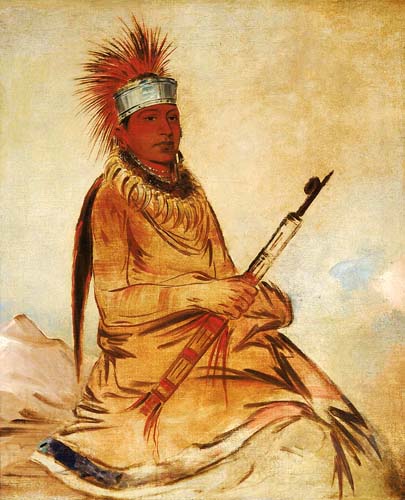
W'y-ee-yogh,
Man of Sense, a Brave: 1832
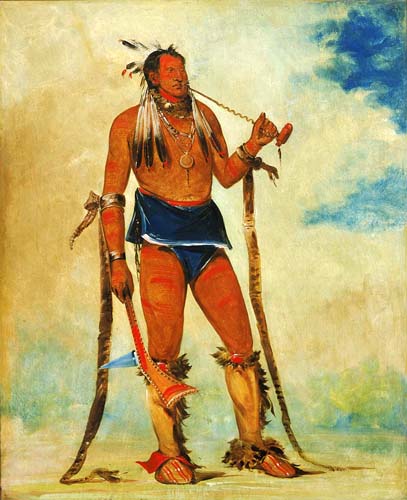
Wah-chee-háhs-ka,
Man Who Puts All Out of Doors: 1835
Described by Catlin as "the largest man of the tribe, with rattle-snakes' skins on his arms, and his war-club in his hand" (Letters and Notes, vol. II).
Probably painted at Prairie du Chien in 1835, as the figure seems more closely related to the Eastern Sioux and Ojibwa series than to the previous portrait. The solid anatomy and stance of the subject, along with the more skillfully rendered costume details show Catlin making a marked improvement in the years that separate this painting from numbers 209 through 217 in the Winnebago series.
The subject also appears in cartoon 4.
Quoted From: The Catlin Collection
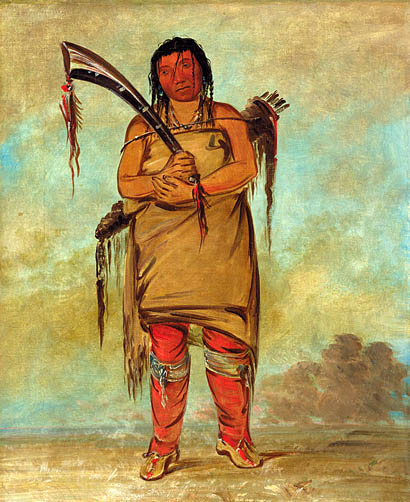
Wah-chees,
a Brave: 1835
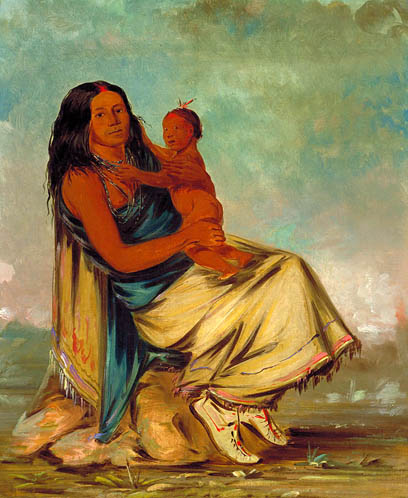
Wáh-chee-te,
Wife of Cler-mónt, and Child: 1834
"She (Clermont's wife) was richly dressed in costly cloths of civilized manufacture, which is almost a solitary instance among the Osages, who so studiously reject every luxury and every custom of civilized people" (Letters and Notes, vol. II).
Painted at Fort Gibson in 1834. Donaldson's date must be based on Catlin's faulty itinerary. The Smithsonian and Gilcrease portraits are almost identical, and the subject appears again in cartoon 52.
Quoted From: The Catlin Collection
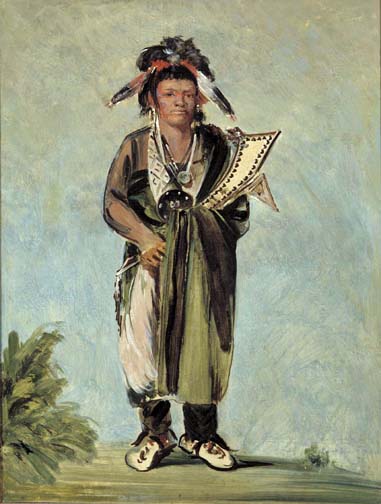
Wah-kón-ze-kaw,
The Snake: 1828
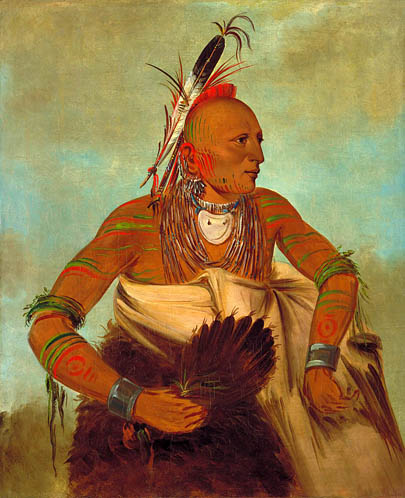
Wa-ho-béck-ee,
a Handsome Brave: 1834
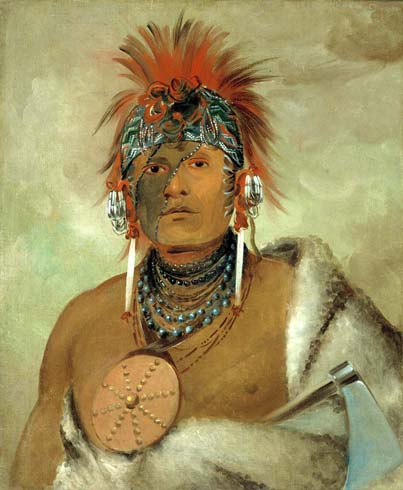
Wá-hón-ga-shee,
No Fool, a Great Fop: 1832
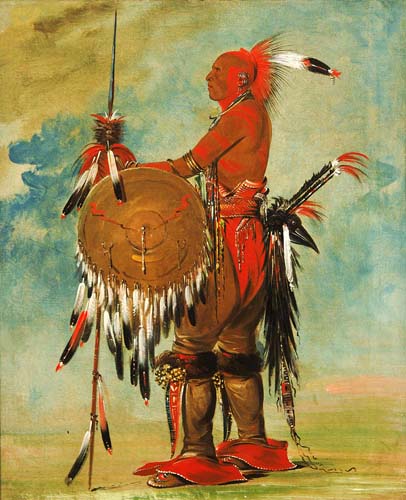
Wáh-pa-ko-lás-kuk,
Bear's Track: 1835
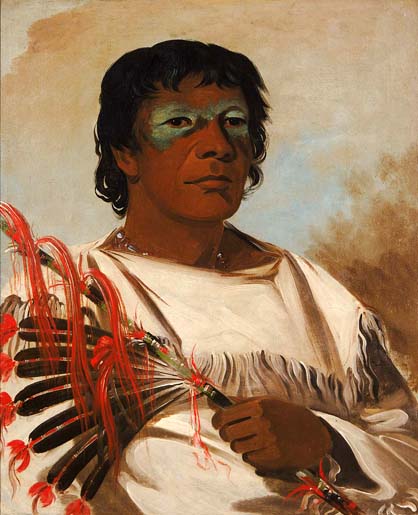
Wah-pe-kée-suck,
White Cloud, Adviser to Black Hawk: 1832

Wáh-pe-say,
The White: 1830
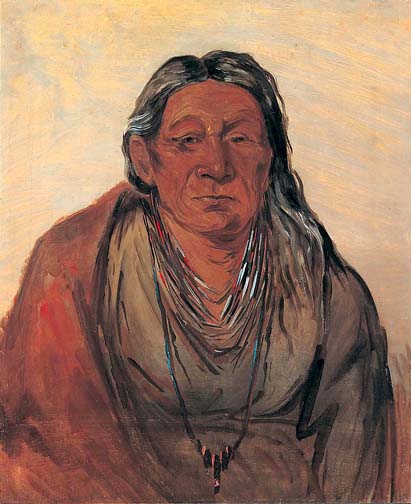
Wah-pe-séh-see,
Mother of the Chief: 1830
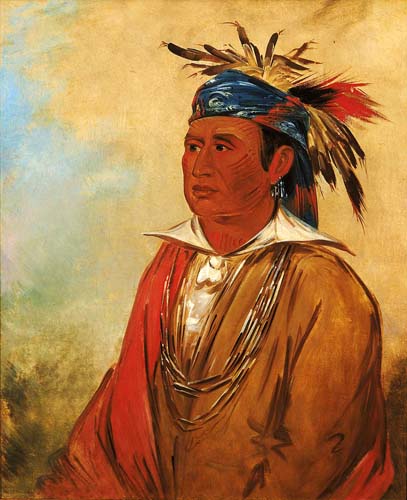
Wah-pón-jee-a,
The Swan, a Warrior: 1830
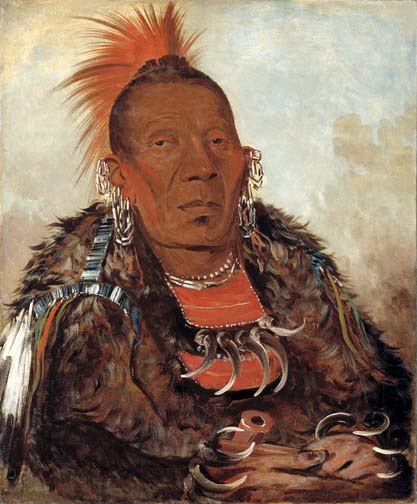
Wah-ro-née-sah,
The Surrounder, Chief of the Tribe: 1832
Described by Catlin as "quite an old man; his shirt made of the skin of a grizzly bear, with the claws on" (1848 catalogue, p. 17).
Probably painted at Fort Leavenworth in 1832. The Oto portraits generally follow the style of the Pawnee and Omaha series. Plate 33 in Donaldson is mistakenly identified as The Surrounder.
The Gilcrease and Smithsonian portraits are identical in detail, but the roughly brushed visage of the latter is clearly the life study. The Surrounder ranks with Horse Chief, whom he somewhat resembles, as one of Catlin's most powerfully modeled portraits, again indicating that the best date for the Oto series is probably 1832.
The Surrounder supposedly appears again in the center of cartoon 19, but the figure does not resemble the Smithsonian portrait. Charles Bird King's portrait of the subject is no longer extant.
Quoted From: The Catlin Collection
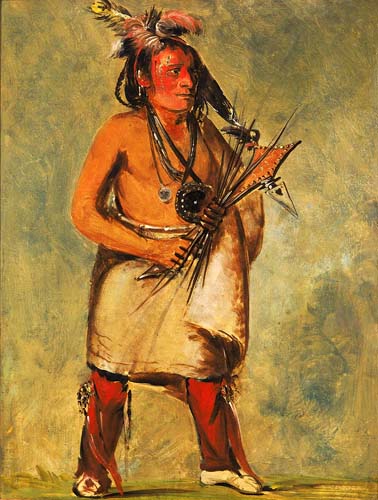
Wa-kon-chásh-kaw,
He Who Comes on the Thunder: 1828
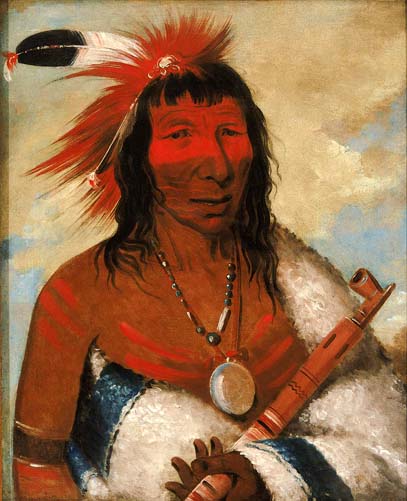
Wá-nah-de-túnk-ah,
Big Eagle, Chief of the O-hah-kas-ka-toh-y-an-te Band: 1835
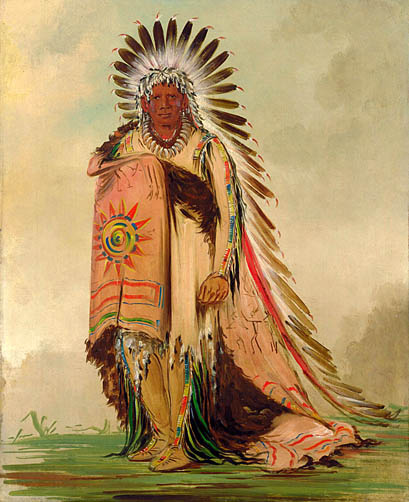
Wán-ee-ton,
Chief of the Tribe: 1832
Donaldson quotes the following passage in his description of Wán-ee-ton:
"He was dressed in the full habit of an Indian chief. We have never seen a more dignified person, or a more becoming dress. The most prominent part of his apparel was a splendid cloak or mantle of buffalo skin, dressed so as to be of a fine white color; it was decorated with small tufts of owl's feathers and others of various hues. A splendid necklace, formed of about sixty claws of the grizzly bear, imparted a manly character to his whole appearance. His leggins, jacket, and moccasins were in the real Dakota fashion, being made of white skins, profusely decorated with human hair! His moccasins were variegated with the plumage of several birds" (W.H. Keating, Narrative of an Expedition to the Source of the St. Peter's River, vol. I).
Painted at Fort Pierre in 1832. Donaldson's date is incorrect. The Peabody version is a repetition of the figure of Wán-ee-ton from cartoon 8, in which the chief appears with his daughter and a Sioux warrior. The cartoon is based on a watercolor (pl. 14) in the Gilcrease Souvenir album.
King had painted a somewhat similar standing portrait of Wán-ee-ton in 1826, and Catlin lists the subject among those paintings commissioned by Louis Philippe in 1845.
Quoted From: The Catlin Collection
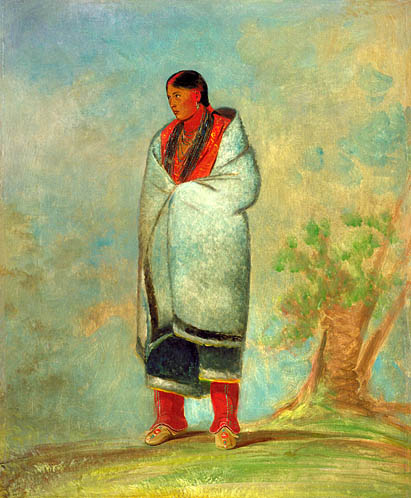
Wa-quóth-e-qua,
The Buck's Wife, Wife of the Whale: 1835
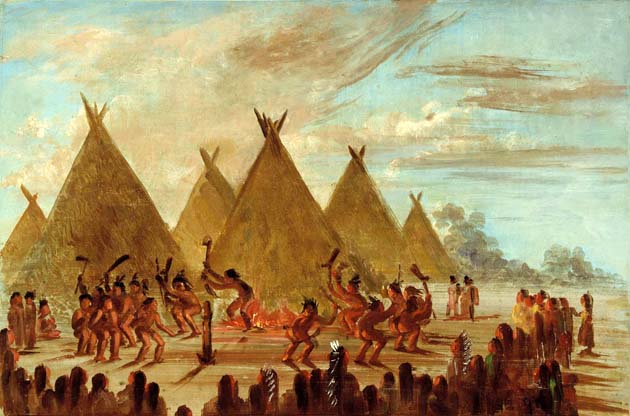
War Dance, Sioux: 1845
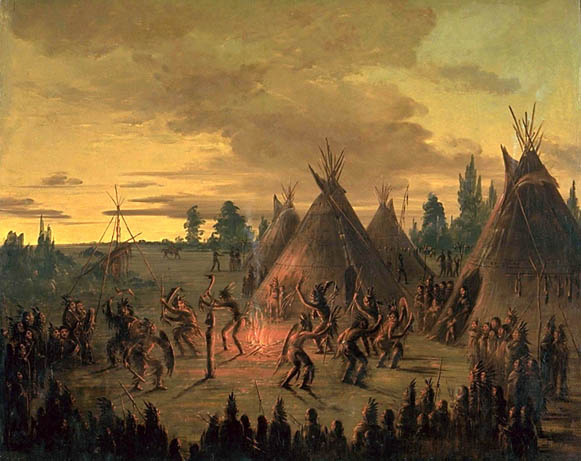
War Dance, Sioux: 1845
"Each warrior, in turn, jumps through the fire, and then advances shouting and boasting, and taking his oath, as he 'strikes the reddened post' " (1848 catalogue, p. 42).
Probably sketched near Fort Pierre in 1832. The subject is not included in the 1837 catalogue, but does appear in the Egyptian Hall catalogue of January 1840, indicating that it was painted in the interval. Catlin transformed the Smithsonian original an abrupt and hasty oil sketch, into an elaborately finished night scene. This final version has much in common with the paintings intended for Louis Philippe, but does not appear on the Travels in Europe list.
Although the title is similar, plate 29 in Catlin's North American Indian Portfolio represents another dancing group.
Quoted From: The Catlin Collection
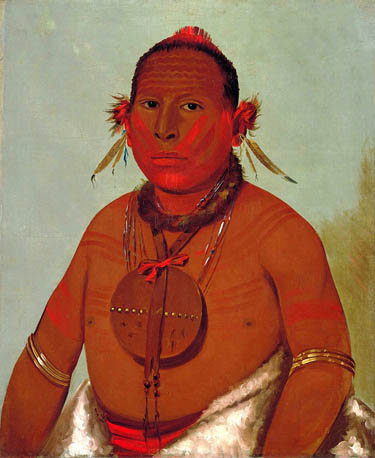
Wa-sáw-me-saw,
Roaring Thunder, Youngest Son of Black Hawk: 1832
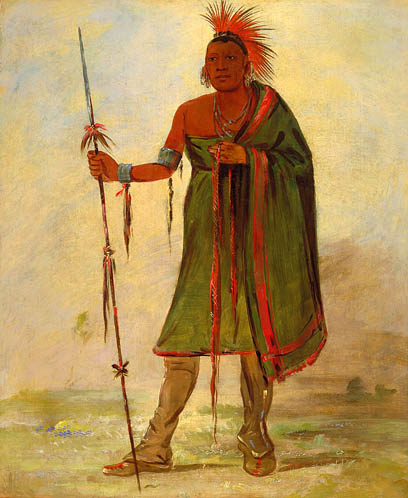
Wash-ím-pe-shee,
Madman, a Distinguished Warrior: 1834

Wash-ka-mon-ya,
Fast Dancer, a Warrior: 1844
This portrait was previously catalogued as number 513, but the headdress and style more closely resemble the portraits of the Iowa delegation, which were probably painted in London in 1844. The subject might also be Foremost Man (no. 523).
Catlin claims that he painted an earlier portrait of Fast Dancer at the Iowa village (see Travels in Europe), but none is listed in the 1837 or 1848 catalogues. The subject appears again in cartoon 60.
Quoted From: The Catlin Collection
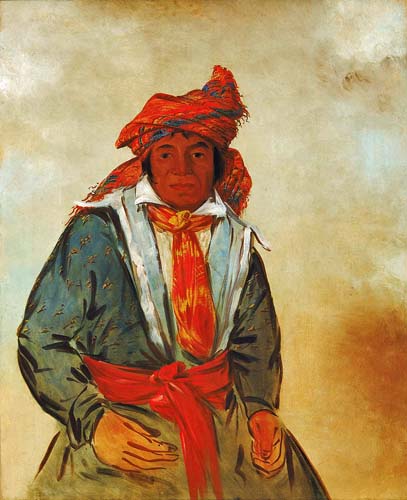
Wat-ál-le-go,
a Brave: 1834
,_a_Missionary_Preacher_1836.jpg)
Waun-naw-con,
The Dish (John W. Quinney), a Missionary Preacher: 1836
"John W. Quinney, in civilized dress, is a civilized Indian, well-educated-speaking good English-is a Baptist missionary preacher, and a very plausible and eloquent speaker" (Letters and Notes, vol. II).
Probably painted at Green Bay in 1836. Ewers says that Catlin saw Quinney at Niagara Falls in the winter of 1820-30, but no evidence is given to support the claim.
The rapidly brushed outlines of Quinney's frock coat suggest the beginnings of a well-articulated figure. The subject was also painted by Charles Bird King in Washington, and he appears again in cartoons 57 and 64. The latter is apparently mislabeled.
Quoted From: The Catlin Collection
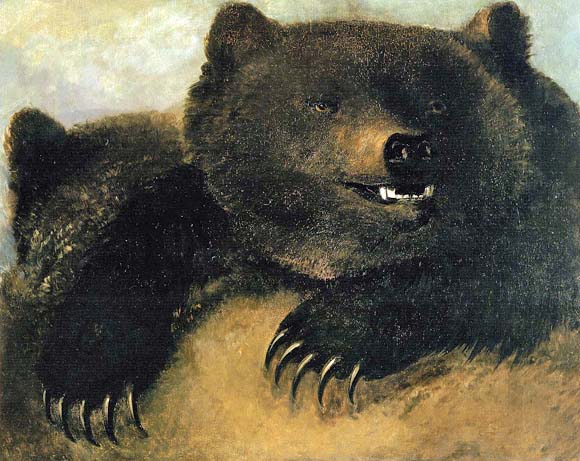
Weapons and Physiognomy of the Grizzly Bear: 1846
The prairies of the 1830's were a paradise for non-human predators as well. Eagles, wolves, mountain lions, and grizzly bears were among the beasts hunting the abundant antelope, elk, and buffalo. In 1832 and 1833, Catlin described numerous encounters with both prey and predators, including the grizzly bear, but for obvious reasons didn't complete paintings of them in the field. This scene was painted when he was already in Europe. Catlin frowned on white settlers' encroaching on Indian lands, yet he continued to describe and paint scenes that were calculated appeals to Euro-American sportsmen, enticing them westward for the thrilling hunts he described.
Quoted From: Campfire Stories with George Catlin

We-chúsh-ta-dóo-ta,
Red Man, a Distinguished Ball Player: 1835
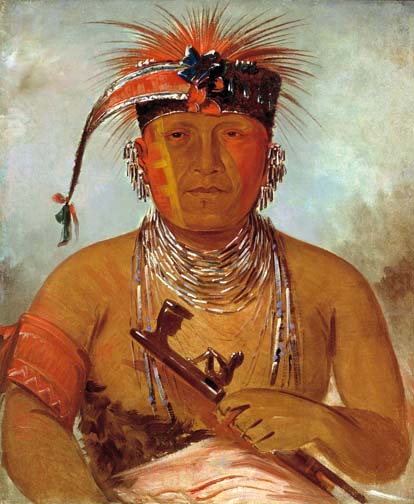
Wée-ke-rú-law,
He Who Exchanges: 1832
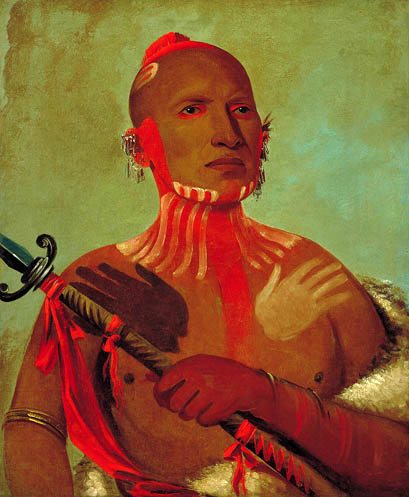
Wée-sheet,
Sturgeon's Head, a Fox Warrior: 1832
"This man held a spear in his hand when he was being painted, with which he assured me he killed four white men during the war; though I have some doubts of the fact" (Letters and Notes, vol. II).
Sturgeon's Head was one of Black Hawk's principal warriors.
Painted at Jefferson Barracks in October 1832. The carefully described ear pendants in the Smithsonian portrait, which match those in plate 286 of Letters and Notes, are repeated only in cursory form in the Chicago version. The original portrait is also distinguished by simplified oval contours, which Catlin has transformed into a striking classical bust.
Quoted From: The Catlin Collection
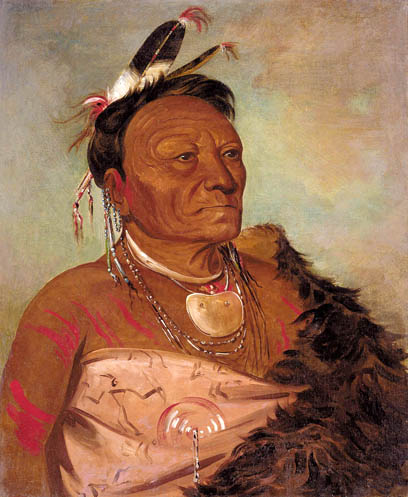
Wee-tá-ra-shá-ro,
Head Chief of the Tribe: 1834
"This man embraced Colonel Dodge and others of the dragoon officers in council, in his village, and otherwise treated them with great kindness, theirs being the first visit ever made to them by white people" (1848 catalogue, p. 12).
The subject was over ninety years old, according to Catlin.
Painted at the Comanche village in 1834, according to Letters and Notes. Catlin's illness prevented him from accompanying the dragoons to the Wichita village.
The Smithsonian portrait and plate 174 in Letters and Notes are identical, but the subject has fewer necklaces and no fur robe in the Gilcrease watercolor. The Smithsonian portrait is a carefully brushed, moving study of the old chief's wrinkled features, and a suggestion of this image remains in the more fussy Gilcrease version. The latter is clearly taken from the original oil, however, as are the other Wichita portraits in the Gilcrease series.
The subject also appears, full length, in cartoon 45, with two Wichita women and a warrior.
Quoted From: The Catlin Collection

White Sand Bluffs,
on Santa Rosa Island, Near Pensacola: 1834
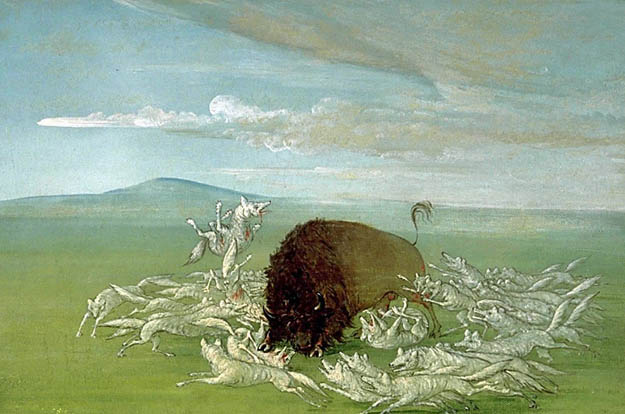
White Wolves Attacking a Buffalo Bull: 1832
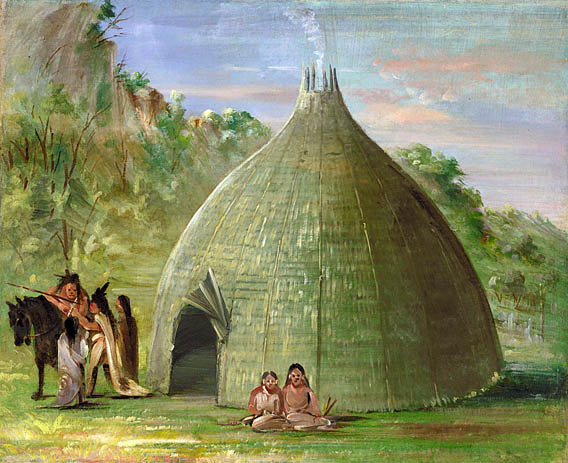
Wichita Lodge,
Thatched with Prairie Grass: 1834
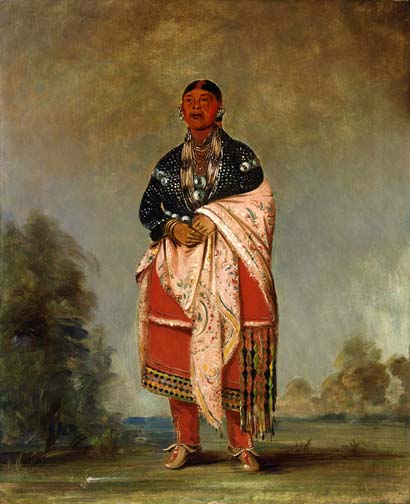
Wife of Kee-o-kúk: 1835
"Plate 281 is a portrait of the wife of Kee-o-kuk, and plate 282 of his favorite son, whom he intends to be his successor. These portraits are both painted … in the costumes precisely in which they were dressed. This woman was the favorite one (I think) of seven whom he had living (apparently quite comfortably and peaceably) in his wigwam, where General Street and I visited him in his village on the Des Moines River. And, although she was the oldest of the 'lot', she seemed to be the favorite one on this occasion-the only one that could be painted-on account, I believe, of her being the mother of his favorite son. Her dress, which was of civilized stuffs, was fashioned and ornamented by herself, and was truly a most splendid affair, the upper part of it being almost literally covered with silver brooches" (Letters and Notes, vol. II).
Painted at the Sauk and Fox village in 1835. Kee-o-kuk's wife also appears in cartoon 15, wearing a somewhat different costume. The cartoon figure is based on a watercolor in the Gilcrease Souvenir album.
Quoted From: The Catlin Collection
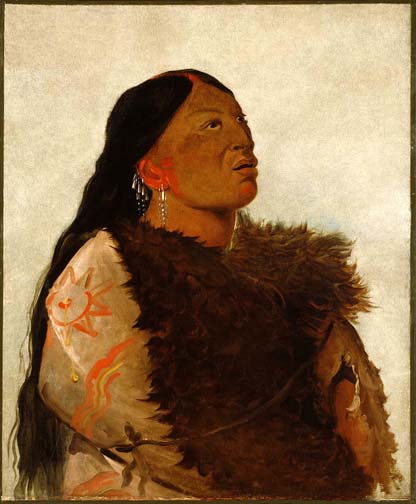
Wife of The Six: 1832
"Not the most agreeable" of The Six's several wives, according to Catlin (Letters and Notes, vol. I).
Painted at Fort Union in 1832. Donaldson must not have realized that the subject was the wife of a Plains Ojibwa. Catlin made few compromises in representing the blunt, heavy features and powerful contours of this woman's superbly aboriginal head. Such studies among the more civilized eastern tribes, whom he painted three or four years later, are rare.
The subject appears again, full length, in cartoon 12, with her husband.
Quoted From: The Catlin Collection

Wife of Two Crows: 1832
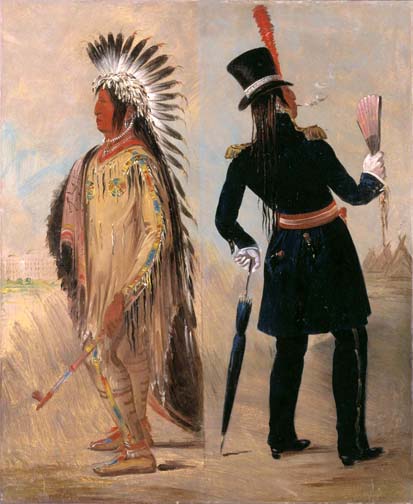
Wi-jún-jon,
Pigeon's Egg Head Going To and Returning From Washington: 1837
"On his way home from Saint Louis to this place, a distance of 2000 miles, I travelled with this gentleman, on the steamer Yellow-Stone; and saw him step ashore (on a beautiful prairie, where several thousands of his people were encamped), with a complete suit en militaire, a colonel's uniform of blue, presented to him by the President of the United States, with a beaver hat and feather, with epaulettes of gold -with sash and belt, and broad sword; with high-heeled boots - with a keg of whiskey under his arm, and a blue umbrella in his hand" (Letters and Notes, vol. 1, p. 56; vol. 2, pl. 271-72).
Catlin first painted 'The Light in Saint Louis', when the latter was en route to Washington in the fall of 1831, as an official guest of the Secretary of War. The two met again next spring on the upriver voyage of the Yellowstone, and Catlin watched 'The Light' debark from the steamboat at Fort Union, where he was scarcely recognized by the members of his own tribe. Astonishment and disbelief gradually turned into fear and hostility as 'The Light' recounted his travel experiences, and in time he was killed by a young Indian who could not comprehend what was probably an accurate description of a building in Washington.
As far as Catlin was concerned, the episode illustrated the tragic gulf between Indian culture and white civilization, and he traced the steps of The Light's downfall through many pages of Letters and Notes (vol. 1, pp. 55-57; vol. 2, pp. 194-200).
The subject is not included in the 1837 catalogue, but does appear in the Egyptian Hall catalogue of January 1840, indicating that it was painted in the interval. Catlin has finished both figures with unusual care, and 'The Light' in uniform, whose swagger and vanity are an amusing change from a long line of stoic chiefs, is one of the artist's most successful characters.
The subject is repeated in plate 25 of Catlin's North American Indian Portfolio, first published in 1844; in plate 52 of the Gilcrease Souvenir album; and in cartoon 83.
Quoted From: The Catlin Collection
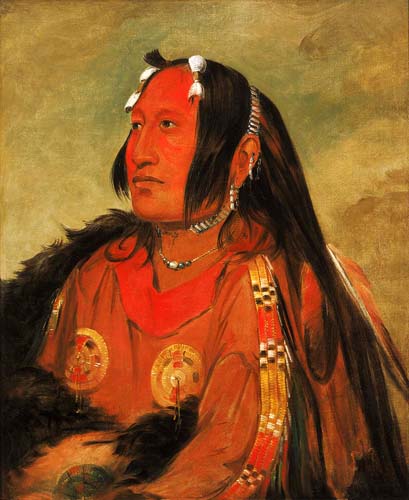
Wi-jún-jon,
Pigeon's Egg Head, a Distinguished Young Warrior: 1831
"Wi-jun-jon (The Light) … appeared as sullen as death in my painting-room-with eyes fixed like those of a statue, upon me, though his pride had plumed and tinted him in all the freshness and brilliancy of an Indian's toilet. In his nature's uncowering pride he stood a perfect model; but superstition had hung a lingering curve upon his lip, and pride had stiffened it into contempt.…
"He was dressed in his native costume, which was classic and exceedingly beautiful; his leggings and shirt were of the mountain-goat skin, richly garnished with quills of the porcupine, and fringed with locks of scalps, taken from his enemies' heads. Over these floated his long hair in plaits, that fell nearly to the ground" (Letters and Notes, vol. 1, pp. 50-57, pl. 28; vol. 2, p. 196).
Quoted From: The Catlin Collection
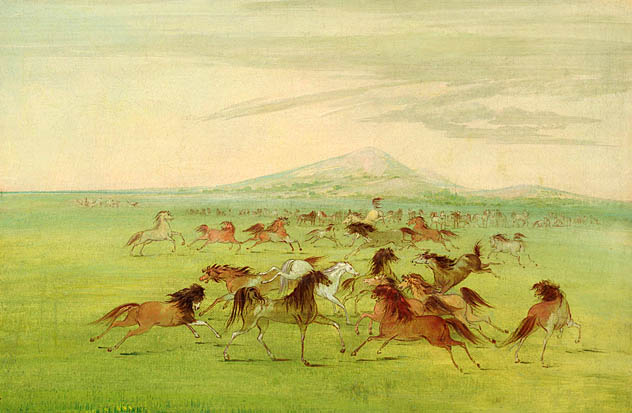
Wild Horses at Play: 1834
For centuries Plains Indian culture revolved around the buffalo. Although the horse once roamed these grasslands, the relationship between man and buffalo evolved long after the horse's disappearance.
Later, Spanish settlers introduced horses that populated North America and partnered with Native Americans. In the 1830's, Catlin described the horse as one of the wild denizens of the plains: "There is no other animal on the prairies so wild and so sagacious as the horse . . . . In this herd we saw all the colors, nearly, that can be seen in a kennel of English hounds. Some were milk white, some jet black-others were sorrel, and bay, and cream colour-many were of an iron grey; and others were pied, containing a variety of colors on the same animal. Their manes were very profuse, and hanging in the wildest confusion over their necks and faces-and their long tails swept the ground" (Letters and Notes, Letter No. 41)
Catlin wrote of the rider and horse as partners both in war and in the hunt. "These horses are so trained, that the Indian has little use for the rein, which hangs on the neck, while the horse approaches the animal on the right side, giving his rider the chance to throw his arrow to the left; which he does at the instant when the horse is passing-bringing him opposite to the heart, which receives the deadly weapon 'to the feather'" (Letters and Notes, Letter No. 31)
Quoted From: Campfire Stories with George Catlin
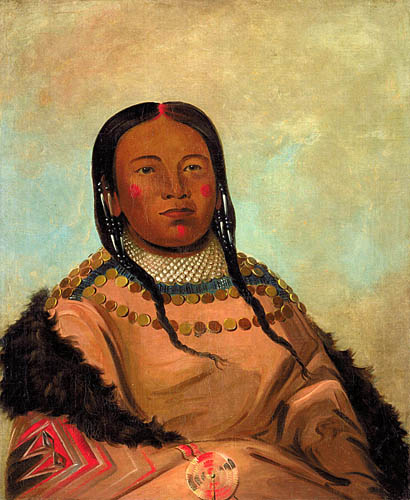
Wi-lóoh-tah-eeh-tcháh-ta-máh-nee,
Red Thing That Touches in Marching, Daughter of Black Rock: 1832
"She is an unmarried girl, and much esteemed by the whole tribe, for her modesty, as well as beauty. She was beautifully dressed in skins, ornamented profusely with brass buttons and beads. Her hair was plaited, her ears supported a great profusion of curious beads and over her other dress she wore a handsomely garnished buffalo robe" (Letters and Notes, vol. I).
Painted at Fort Pierre in 1832. The subject appears again, full length, in cartoon 5.
Quoted From: The Catlin Collection
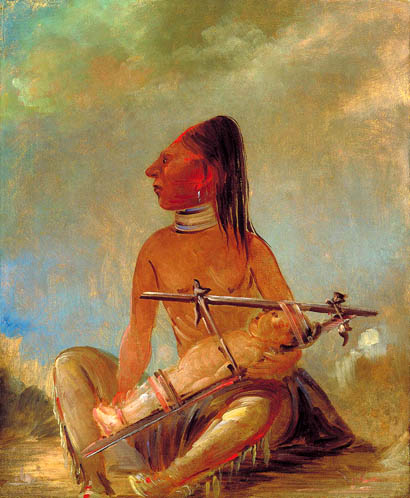
Woman and Child,
Showing How the Heads of Children are Flattened: 1837
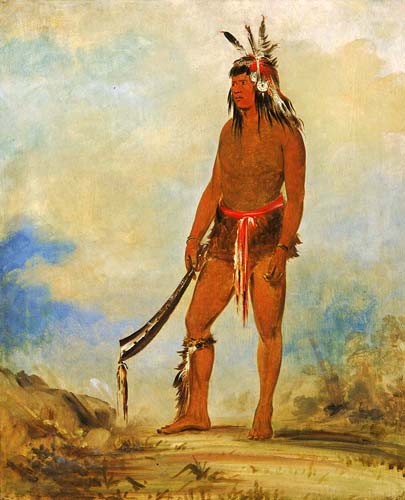
Won-de-tów-a,
The Wonder: 1835

Wos-cóm-mun,
Busy Man, a Brave: 1832
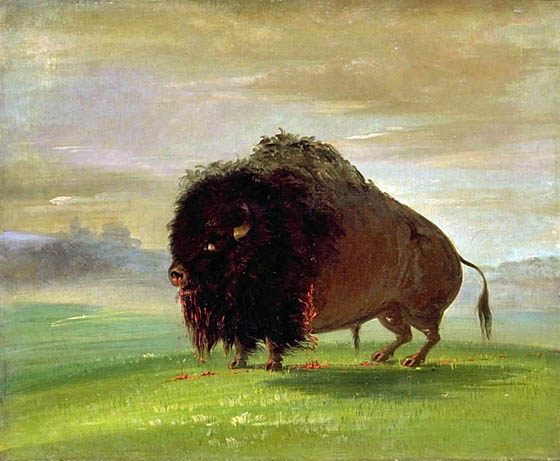
Wounded Buffalo,
Strewing His Blood over the Prairies: 1832
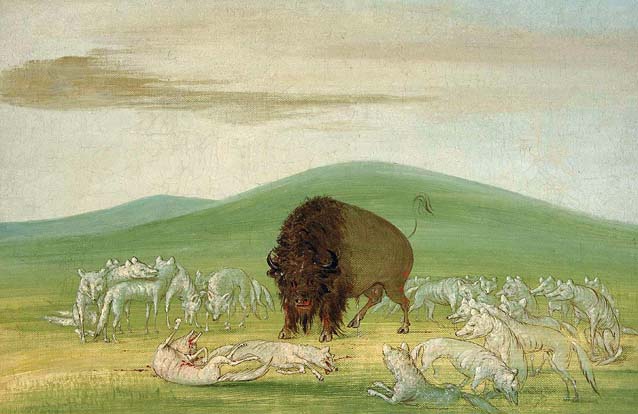
Wounded Buffalo Bull Surrounded by White Wolves: 1832
![]()
Wúk-mi-ser,
Corn, a Miniconjou Warrior: 1832
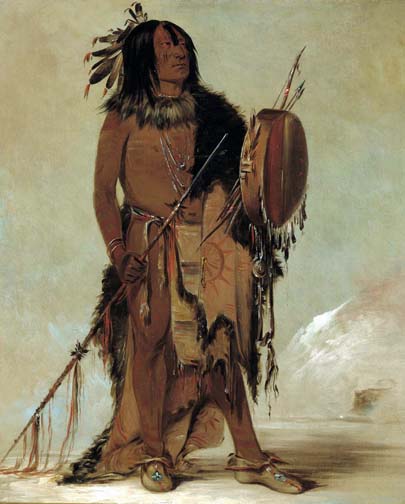
Wún-nes-tou,
White Buffalo, an Aged Medicine Man: 1832
"I have also transferred to my canvass the 'looks and very resemblance' of an aged chief, who combines with his high office, the envied title of mystery or medicine-man, i.e. doctor -magician-prophet -soothsayer -jongleur- and high priest, all combined in one person, who necessarily is looked upon as 'Sir Oracle' of the nation. … on his left arm he presents his mystery-drum or tambour, in which are concealed the hidden and sacred mysteries of his healing art" (Letters and Notes, Vol. 1, P. 34, pl. 15).
Painted at Fort Union in 1832. White Buffalo also appears in cartoon 39.
Quoted From: The Catlin Collection
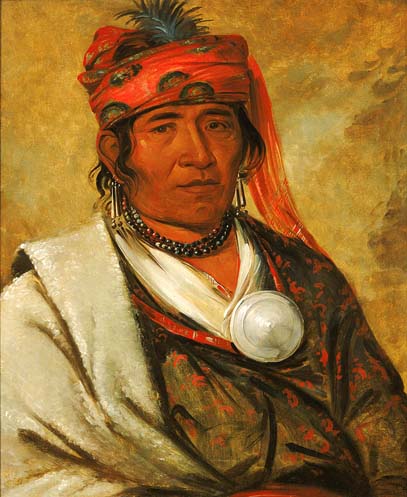
Ye-hów-lo-gee,
The Cloud, a Chief: 1838
I don't know what to say about George Catlin without revealing my total ignorance of art and especially a singular period of 19th Century Western American Art. His art and writing leaves to us in the 21st Century a record and reflection of Native Americans and their culture which, I am not sure, we are able to completely appreciate his importance. My parents grew up in Minnesota and I was born in Minneapolis though I became an expatriate from Minnesota at the age of six months old without having, possessing, or gaining an understanding of the significance this area would have as the ante bellum American Frontier. As many have said before I wrote a single word about George Catlin, I was drawn to him by his 'Portrait Painting' of individual Native Americans. His use of color enhances the vividness of an important period in our history and a people /race /culture which is still too often denigrated by what became the majority of American Society. Much has been written about primitivism and modernism which places moral judgments on why one cultural society must evidently give way to the other. I am not so sure that this doesn't have more to say about the 'predator nature' of our species than what should be considered innate in human behavior. It is the old argument between what is inherent or learned behavior which brings us face to face with 'The Sins of Our Fathers'. Whether he intended it or not, I believe that the 'Art of George Catlin' forces us to face this dilemma or contradiction within the context of the egalitarian nature of America. Are we taught 'one ideal' about who and what we are as a people and government while we actually live 'another ideal'? I hope such an indictment of America is untrue.
~ Senex Magister
Return to Pagina Artis
Return to Bruce and Bobbie's Main Page.